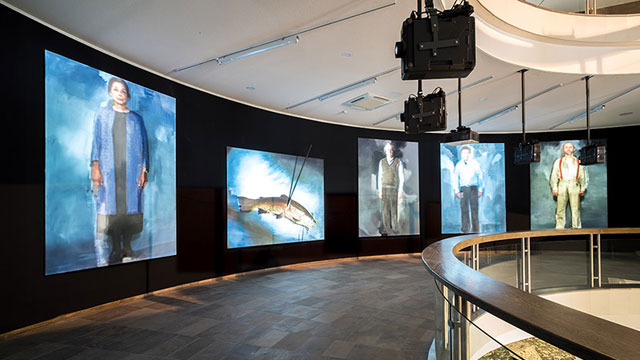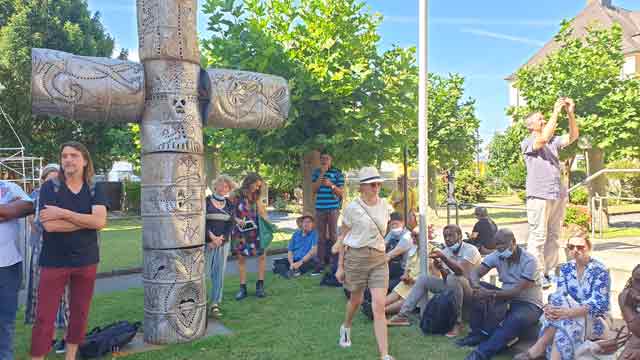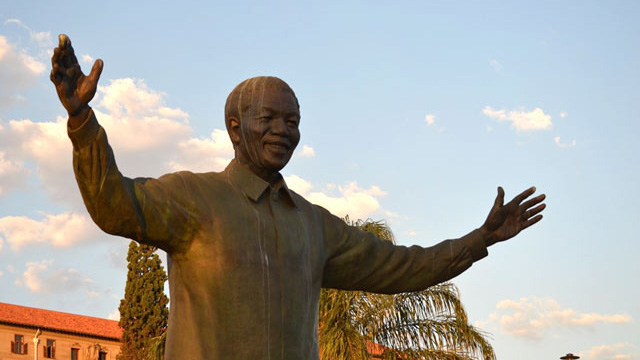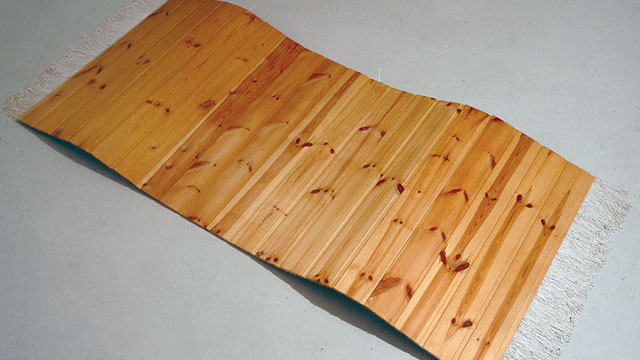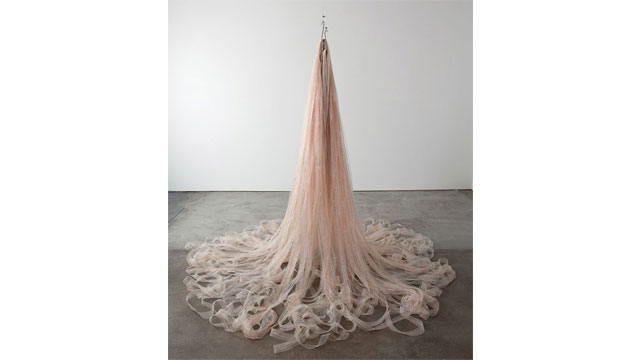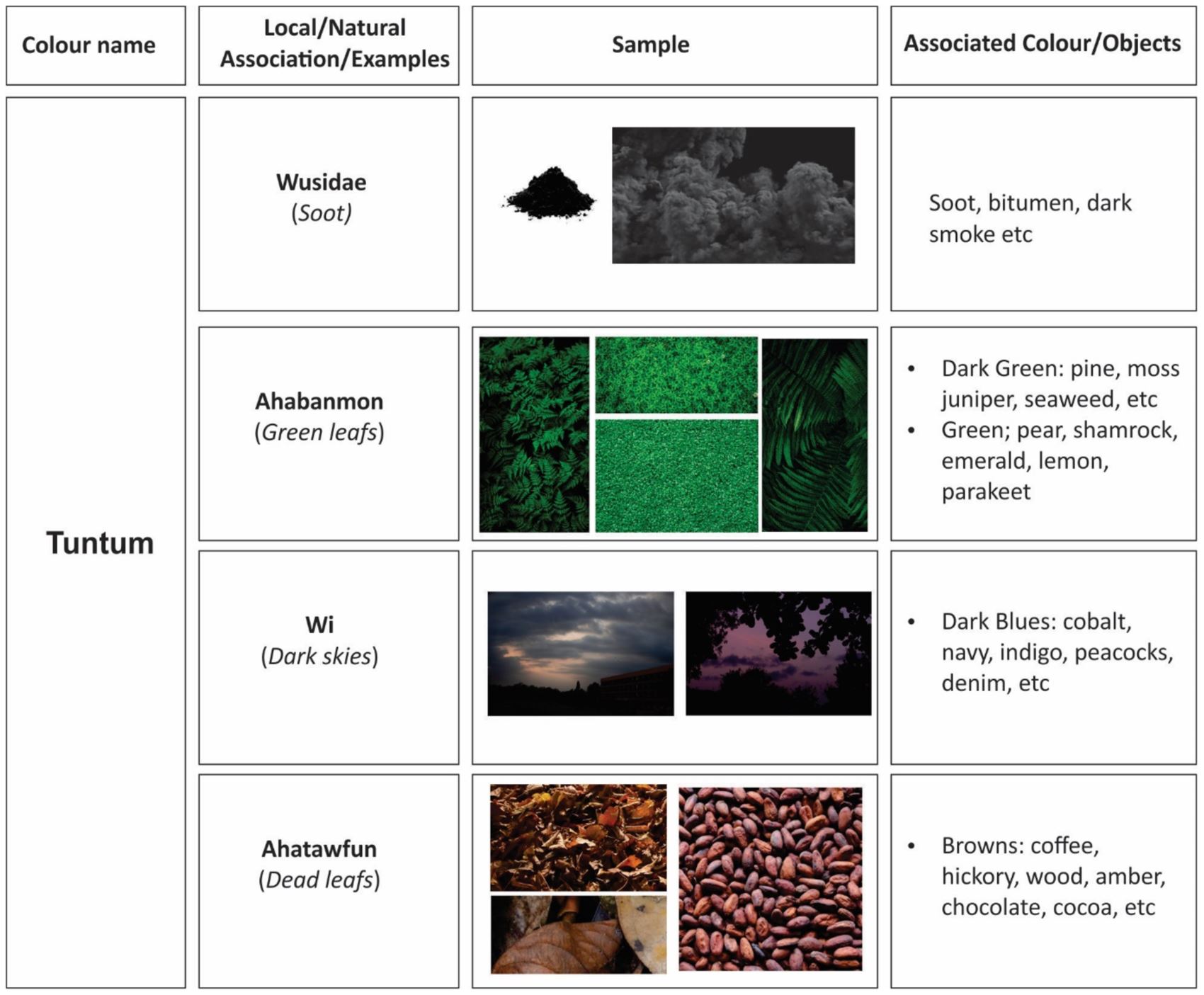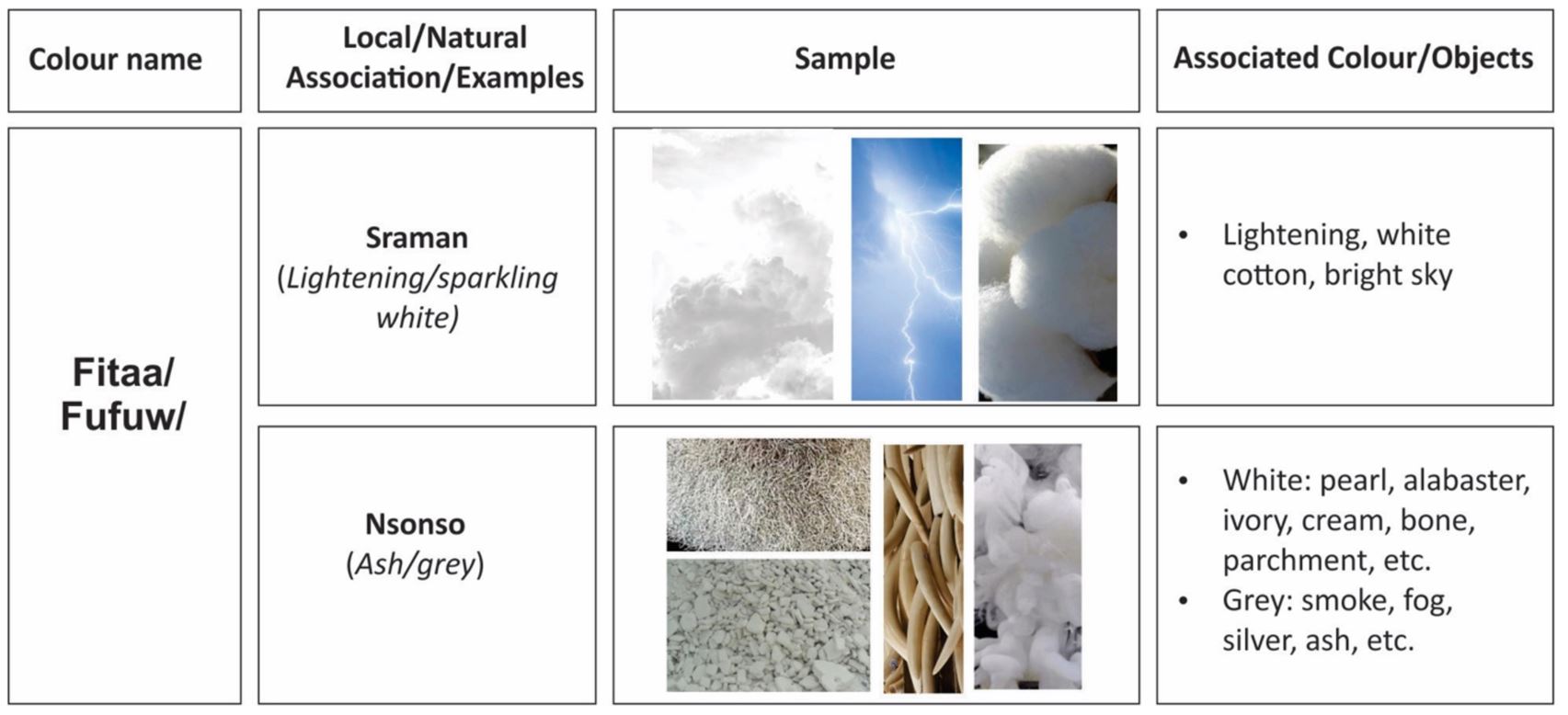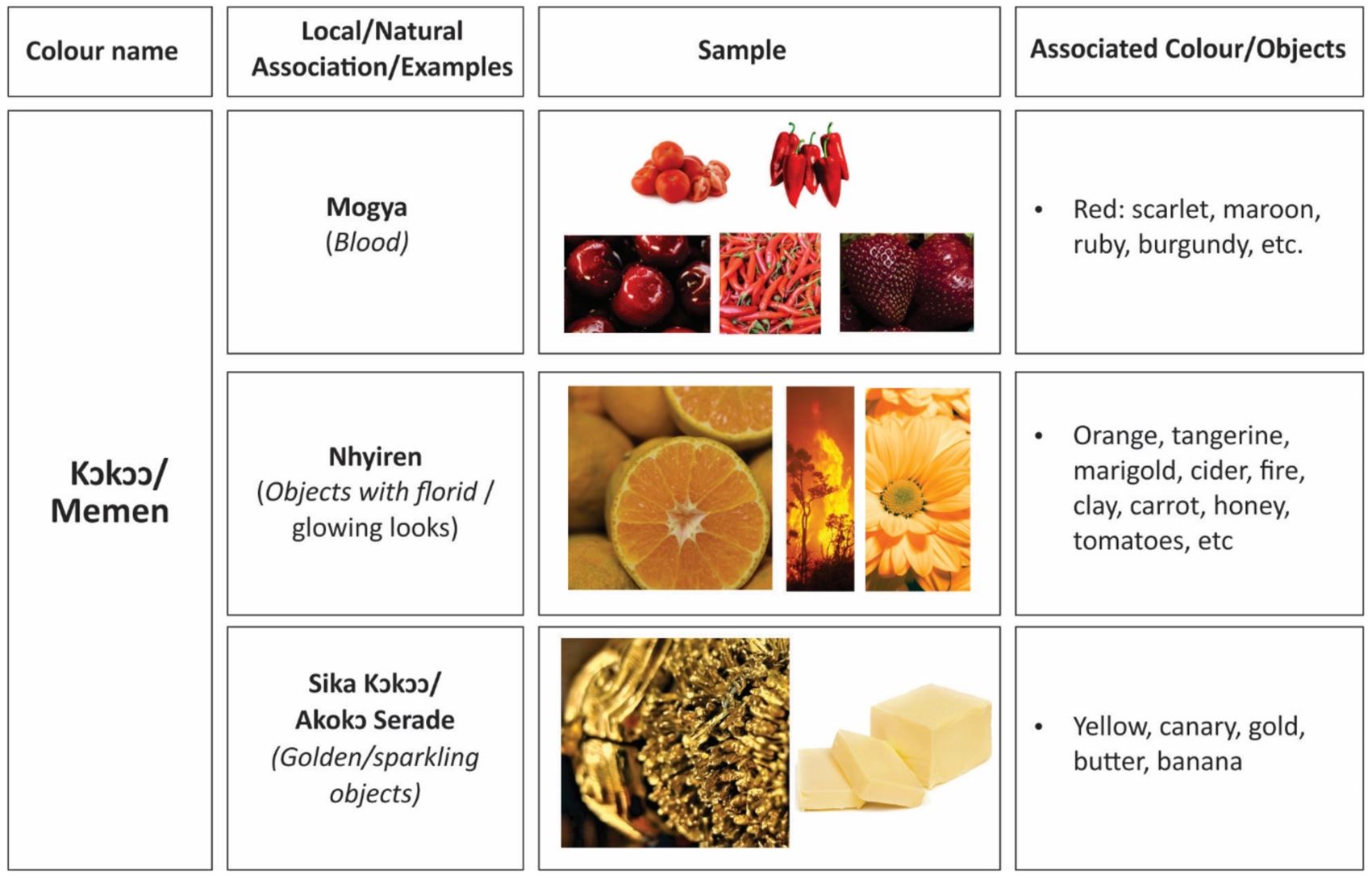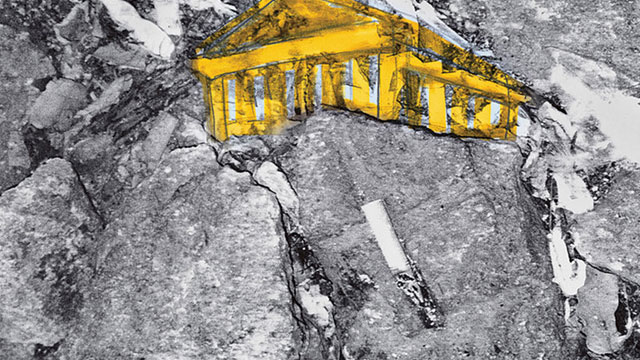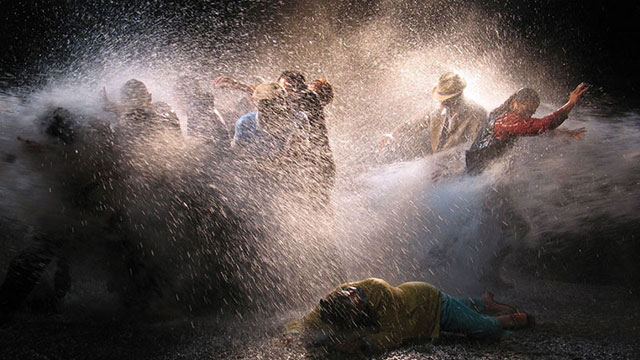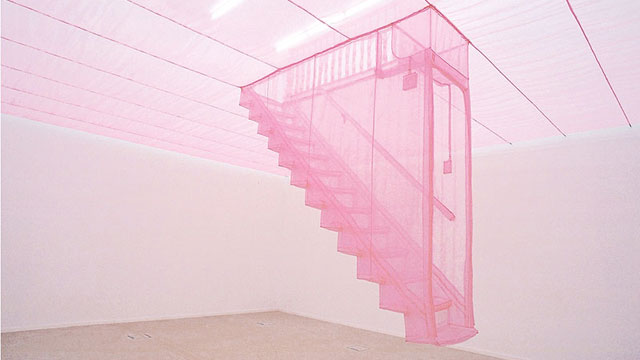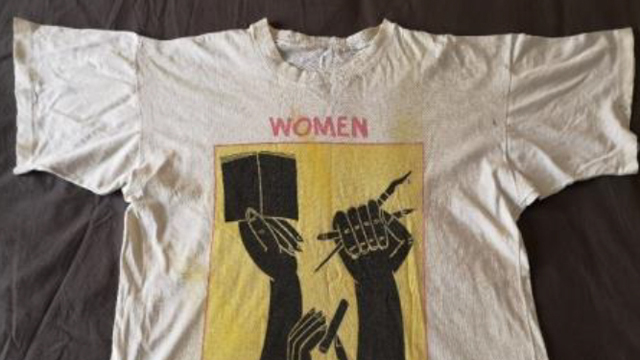Dear user,
This section of our website forms the heart of the EVC project. Here you find a collection of images of objects from different ‘visual cultures’. Our contributors selected and interpreted them in their respective contexts believing that these objects are particularly important for intercultural understanding across boundaries. Each time a user opens this page, the order in which the objects appear changes. In this way we hope to avoid a hierarchical understanding of the collected objects as their entries continue to be accessed in the long run. The constant changing face of the page also reflects the continuous expansion of the collection. As there are already over more than a hundred entries, users may want to form an overview, or to navigate through the growing collection according to their interests. For this purpose, we offer the following search options:

Filter: This enables you to search for objects according to time, place, keywords, etc. / Free title search: If you know the title of an object, you can find it in the free search field. / Lab: In the lab section, objects from the database are grouped under overarching themes. This is an ongoing project and about to be expanded extensively.
Enjoy exploring our database!
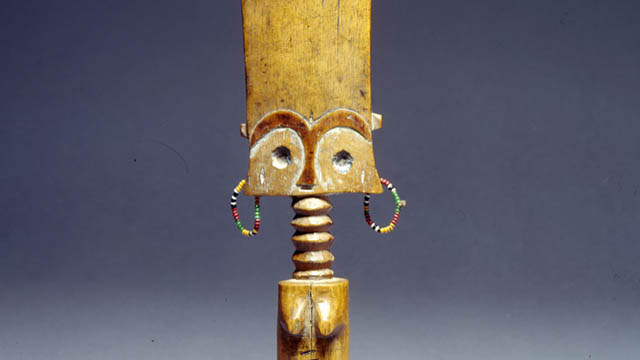
-
 Gertrude Nkrumah
Gertrude NkrumahInversion of Hegemony with Ideas of Femininity
Scholarly works abound on factors and causes of gender inequality in the Ghanaian society and many of these writings address gender inequality solely in terms of women as the victims and thus reinforcing the gender stereotype of female passivity. Although this is true in most cases, such studies do not necessarily address the question of how women have responded to and addressed issues of gender expectations and gender-related roles in African societies. By using the ‘Akuaba’ doll (fertility figurine), this research seeks to explore how the concept of womanhood has been portrayed and represented through time in the Ghanaian society among the Akan ethnic group. It seeks to extend an argument for the interpretation of these images beyond the depiction of women as sexual objects to that of creating an inversion of female hegemony in the society. I argue that instead of considering gender stereotypes as an all-pervasive oppressive tool, we must begin to think of the finer nuances and conceptualize how women have shaped, redefined, and negotiated socio-cultural construction of gender.
The object is widely referred to as the fertility figure, also known as the Akuaba doll among the Akans of Ghana. My reasons for selecting this object are two-fold. Firstly, it speaks to my childhood experiences as a girl growing up in an Akan society and secondly, as someone who is very passionate about gender-related issues either from an intellectual and personal perspectives, I was motivated to choose for this project an object that I can easily relate to, both from a personal and intellectual perspectives.
The object in question is the depiction of a female body, an exhibition of the Akan concept of an ideal woman. The features include a flat forehead with an elongated “ring-like neck shape”1 which reflects Akan standard of beauty. The understanding is that a woman with this type of neck is well-fed, healthy, and strong, a paragon of beauty and affluence. The flat broad forehead also is an embodiment of wisdom, while the accentuated breasts and hips with beads worn arounds the waist is the Akan ideal of womanhood, a depiction of woman as the giver of life. The beads worn around the waist has both aesthetic and symbolical meanings. In terms of beauty, beads were worn as an ornament for beautification, just as portrayed by the wearing of the jewels around her ears. It was also believed that wearing of beads around the waist is sexually appealing, while beads were also worn to broaden the hips and shape the waist for reproductive purposes. It is important to note that in the Akan society, and indeed in most Ghanaian culture, an ideal woman is one that carries and bears children. Clearly, ideas of beauty, sexuality and reproduction were the very essence of womanhood or femininity in the Akan society.
According to a very popular Akan oral tradition, the Akuaba doll is deeply rooted in one’s woman’s quest to overcome her inability in meeting societal ideas and expectation of womanhood.2 Akua, a childless woman, consulted a ritual specialist for a child. She was instructed to go to a woodcarver and make a doll of her choice for a child. Some rituals were then performed on the doll and given back to her to take home and treat and care for as her child. Later she became pregnant and gave birth to a daughter, just as she desired. The Akuaba doll then became symbolic for female reproduction. Amenumey explains that the Akuaba dolls were “…supposed to induce fertility and pregnancy….”.3 Among the Akan, like most precolonial Ghanaian societies, the concept of womanhood was largely defined and shaped by a woman’s ability to give birth to as many children as possible. Childbearing was a blessing from the gods and was usually celebrated with pomp and merrymaking. For instance, the custom was to reward a man whose wife has given birth to ten children with a sheep. The Akan refer to this as “badudwan”4 literally, a sheep for the tenth child. This was usually provided by the wife’s family to the husband to show their appreciation for the replenishing and sustainability of their family.5 In the quest to attain such feat, women worked hard to give birth to at least this number of children as prove of her worth to her husband and the society. This undoubtedly made women who were childless in the society feel undervalued and highly marginalized.
Such ideas and concepts of womanhood and inadvertent marginalisation of women still resonate in contemporary Ghanaian society and indeed in most contemporary societies. A woman’s value and worth continue to be tied with her sexual and reproductive abilities. Although women at present now have access to spaces and engage in works that go beyond the traditionally assigned roles of wife and motherhood (sexual and reproductive values), a woman is still expected to neatly fit in with socio-cultural construct of gender. This underscores the value place on women’s sexuality and reproduction to the detriment of other roles beyond these norms, thus leading to the marginalization of women. It is for these reasons that scholars such as Lerner and Allman have often called for the need to question entrenched patriarchal norms that undermine women’s oppression while it reinforces male- superiority.6
The understanding that women have continually been passive and largely detached from the making of their own history and are mere tools in the hands of a patriarchal society is neatly contested by the history behind the Akuaba doll. While it is true that it was Akua’s desperation to fit into societal expectation of ideals of motherhood that forced her to consult a diviner to help her conceive a child, the knowledge that Akua chose to actively engaged with the process of making the doll; how the doll is carved out, the shape, the physical features, and the aesthetic nature is significant. Additionally, the fact that she chose to carve out a girl child clearly indicates the active role she played in redefining and negotiating power with the matrilineal, yet patriarchal society, thus creating and inverting power in an all-pervasive patriarchal institution. It is also an indication that she did not consider the female as of little value in her society.
Paradoxically then, the history and philosophical ideologies that underpin the concept of the Akuaba doll is a clear exhibition of the nuances and complexities of societal construction of gender roles and status. In a society with a deeply entrenched gender expectations and assigned gender roles, it is remarkable that Akua sought to circumvent, manipulate, and yet conversely acquiesce with existing status quo to her advantage, an inversion of hegemony amidst patriarchal privilege. Therein lies the ambiguities and contradictions of performing gender.
References
- Addo-Fening, R (1973). Asante refugees in Akyem Abuakwa 1875-1912. Transactions of the Historical Society of Ghana. 14, 1. 39-64.
- Akyeampong, E & Obeng, P. (1995). Spirituality, Gender, and Power in Asante History. The International Journal of African Historical Studies. 28, 3. 481-508.
- Allman, Jean. (1996). “Rounding up Spinsters: Gender Chaos and Unmarried Women in Colonial Asante.” Journal of African History, 37, 2, 195-214.
- Amenumey, D. E. K. (2008). Ghana: A concise history from pre-colonial times to the 20th Century. Accra: Woeli Publishing.
- Appiah Anthony K. (1991) “Is the Post- in Postmodernism the Post- in Postcolonial? Critical Inquiry. Vol. 17, No. 2. 336-357.
- Lerner, G. (1994). The creation of feminist consciousness: From the Middle Ages to 1870. Oxford: Oxford University Press.
- Lerner, G. (1986). The creation of patriarchy. New York: Oxford University Press.
Footnotes
1) It is quite common today to hear songs in the Ghanaian society eulogising a woman’s beauty by referring to her ring-shaped neck, together with other physical features. This is an indication that the Akan standard of beauty in the past as enshrined in the Akuaba doll continue to resonate with contemporary Ghanaian societies.
2) This is a popular story among the Akans and was often recounted to young girls especially by an older woman in the family or society. I grew up listening to these stories from my mother and grandmother, among others.
3) D. E K. Amenumey. (2008). Ghana: A concise history from pre-colonial times to the 20th Century. Accra: Woeli Publishing. P. 90. From a spiritual and philosophical perspectives, the use of the Akuaba went beyond just fulfilling the desires of childless women. In most of these Akan societies, when a woman gives birth to twins but in an unlikely situation where one of them dies, she is expected to make a replica of an Akuaba doll in replacing the dead child. Some would also bury the dead child with the Akuaba doll as a way of warding off evil spirit from killing the living child.
4) “Badu” is an Akan name for the tenth born child. ‘Ba’ or ‘ɛba’ is the Twi word for child, while ‘ɛdu’ or ‘du ‘means the number ten in the Akan language. Therefore, the name Badu in Akan usually refers to a tenth born child.
5) It is significant to point out that Akan society, unlike most ethnic groups such as the Mole-Dagbani, Ewe, Ga-Adangbe and Guan, is mostly a matrilineal society. Lineage, inheritance, and chieftaincy succession have always been through the female line. Although precolonial Akan society was not completely immune from patriarchal ideals, women played important roles and and had significant status in society especially in areas of religion, politics and economy. For further details on this, see for example the articles Addo-Fening, R (1973). Asante refugees in Akyem Abuakwa 1875-1912. Transactions of the Historical Society of Ghana. 14, 1. 39-64 & Akyeampong, E & Obeng, P. (1995). Spirituality, Gender, and Power in Asante History. The International Journal of African Historical Studies. 28, 3. 481-508.
6) See for example, Allman, J. (1996). “Rounding up Spinsters: Gender Chaos and Unmarried Women in Colonial Asante.” Journal of African History, 37, 2, 195-214, Lerner, G. (1994). The creation of feminist consciousness: From the Middle Ages to 1870. Oxford: Oxford University Press., & Lerner, G. (1986). The creation of patriarchy. New York: Oxford University Press.
This article is part of a gallery: Perspectives from Ghana on Museum Objects in Germany
published January 2021
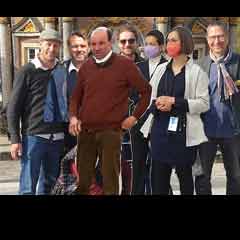 ISB_Team
ISB_TeamA German Perspective on the Akuaba Doll in the Museum Fünf Kontinente Munich
Akuaba Dolls are wooden figures that were and apparently still are in use mainly in rural areas in southern Ghana. Young women hoping for pregnancy or - if they are already pregnant - for the health and beauty of their child, wear these figures on their bodies like real babies and take care of them. That is why they are called 'dolls'.
Akuaba or better Akua-Bà literally means 'child of Akua'. The story tells of "a woman named >Akua< who could not get pregnant and went to a local diviner or priest and commissioned the carving of a small wooden doll. She carried and cared for the doll as if it were her own child, feeding it, bathing it and so on. Soon the people in the village started calling it >Akua< >ba< - meaning >Akuaba's child<, since >ba< means child. She soon became pregnant and her daughter grew up with the doll." (Annor et al., p. 308)
This story also forms the basis for the function of the widespread dolls as aids in a desire for pregnancy. An Akuaba Doll expresses this desire for a child, so the figure is 'cared for' by a girl from puberty onwards. This happens within the family. Outside the family, Akuaba Dolls can be found in shrines under the care of a ritual specialist, where they can be borrowed for their purpose.
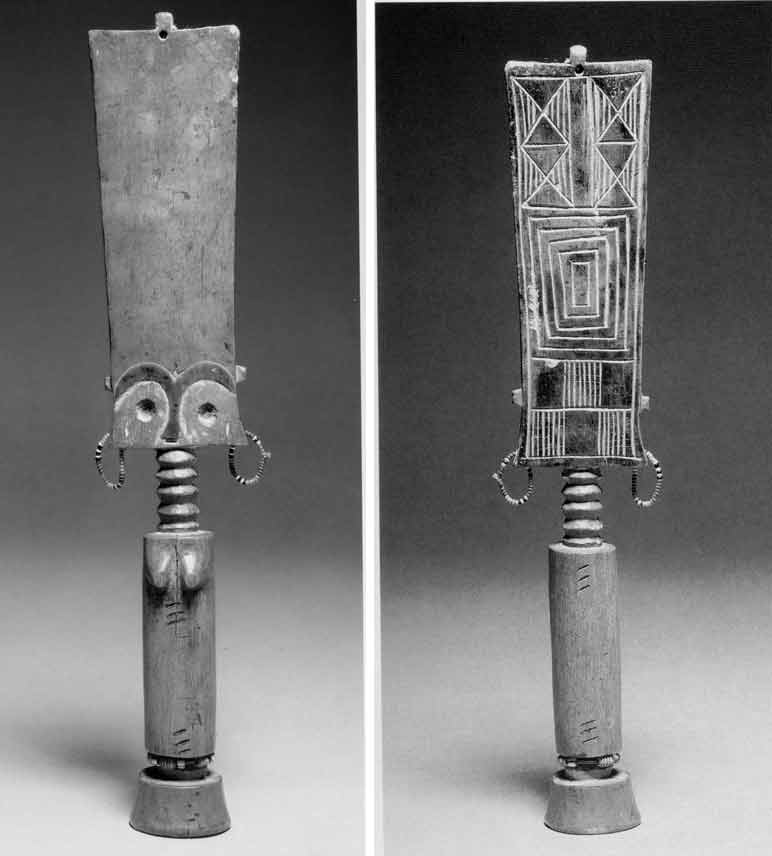
Fig. 1 & Fig. 2 Views of the Akuaba Doll in the Munich Museum Fünf Kontinente
Anonymous artist. Fante Fertility Figure. Early 20th century, Wood. 27,5 cm. Museum Fünf Kontinente. Presentation at Museum Fünf Kontinente.
© Museum Fünf Kontinente
Description
The doll in Munich's Museum Fünf Kontinente (Fig.1) comes from the Fante area. It shows a female figure. The very strongly abstracted forms and proportions symbolise various aspects:
The rectangular shape of the very flat head becomes - seen from the front - somewhat broader in an elegant curve towards the top. A strikingly high forehead, with eyes, eyebrows and nose only indicated, while mouth and ears are missing. The accentuated arch segments of the eyebrows flow together and then form the nose. On the back, the head has geometric patterns (Fig. 2). Added earrings of glass beads give the figure a colourful accent. For Kecskési (p. 38), their daintiness is a sign that the doll has been lovingly treated. At the very top there is another small moulding with a hole where hair was originally attached (compare Fig. 3a).
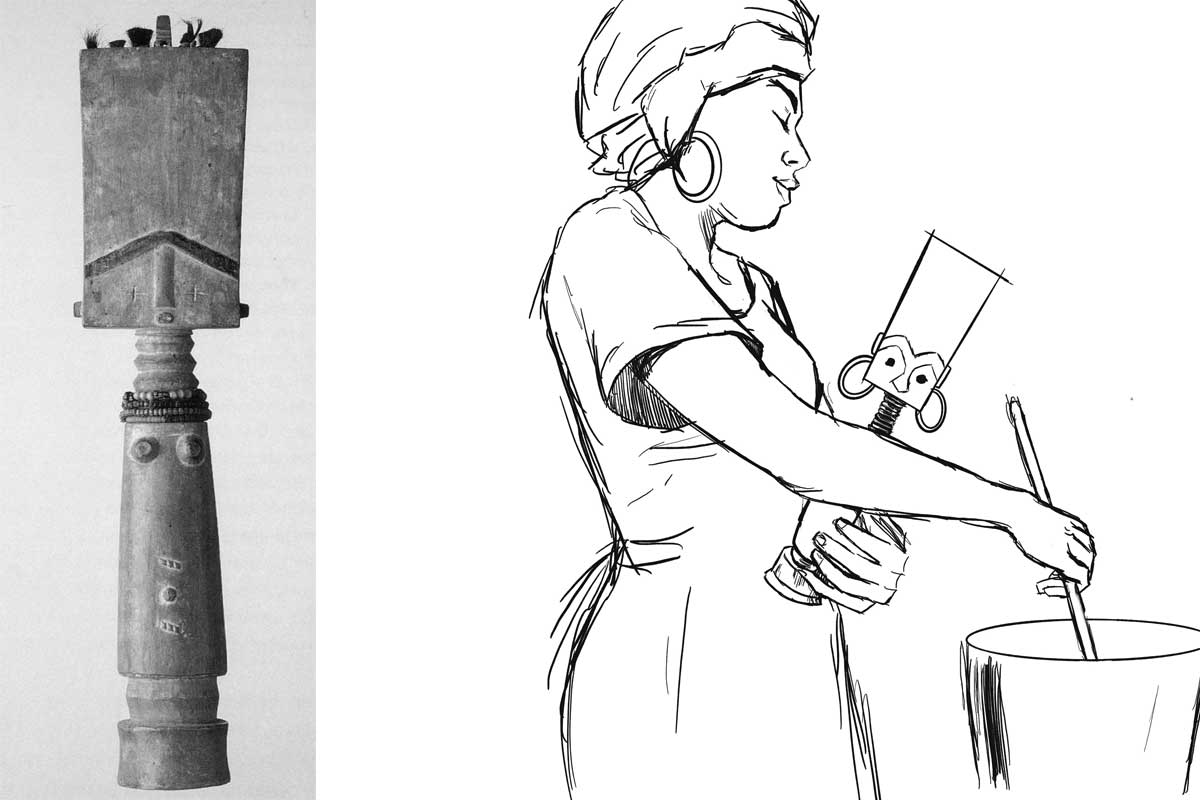
Fig. 3a: Akuaba Doll from the Linden Museum Stuttgart (Forkl p. 94). Fig. 3b: Use of the doll (drawing by Vanessa Rast - courtesy the artist)
The neck has five rings. It sits on a very slender, round trunk, which in turn stands on a delicate base. Striking are two groups of three diagonal embrasures each, which are repeated on the back. The figure has no arms, the legs are short stumps. The protruding forms in the chest area mark the figure as female. Its strict symmetry is softened by small deviations. One can well imagine taking the cylindrical figure in one's hand.
Material and technique
A ritual specialist to whom a woman who wishes to have a child goes makes the decision about the choice of doll at the respective shrine. If no suitable figures are available there, he instructs the woman to order a new Akuaba Doll from the woodcarver. The craftsmen then visit the tree to obtain the wood and ask the tree's spirits for permission to do so (oral information from the Ghanaian colleagues 2022 in Bayreuth [Link]). The Akuaba Doll in the Munich Museum was carved from softwood. (There are also darker examples made of hardwood, for example among the Ashanti, also an Akan group, as the presentation in the Ghana National Museum in Accra shows - see Fig. 4.) In the example in Munich, eyebrows and nose are darker.
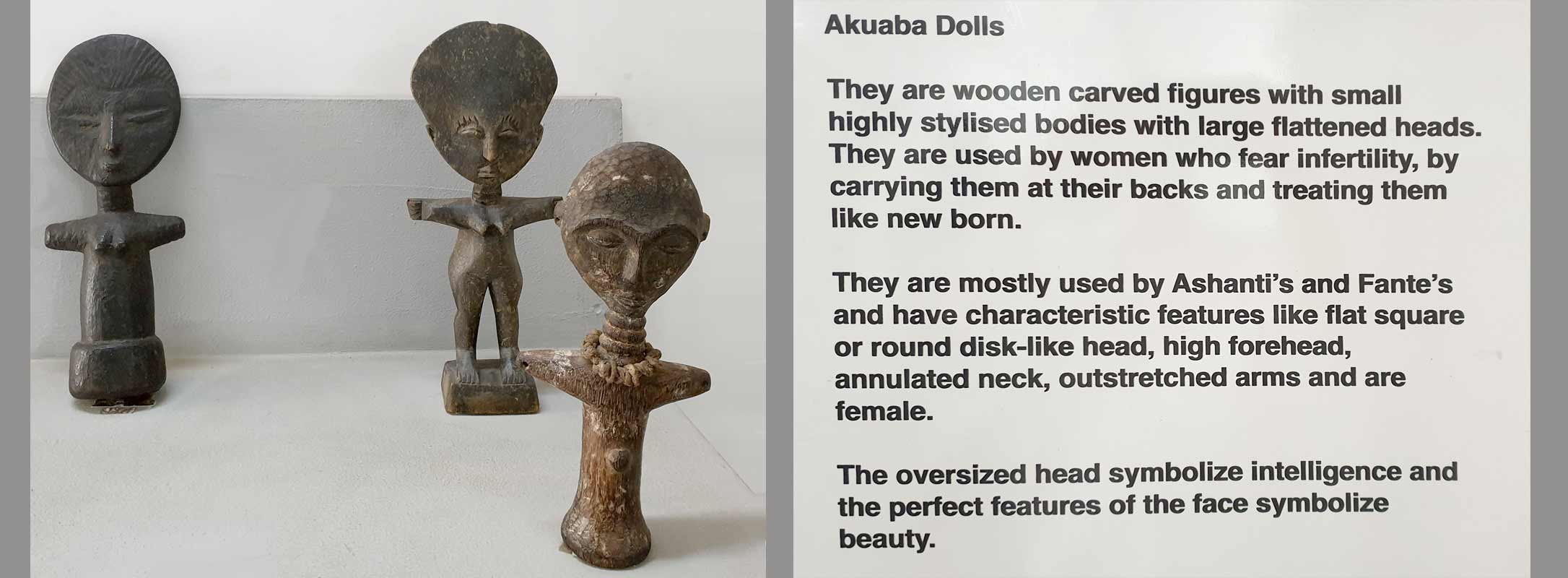
Fig. 4: Presentation of Akuaba Dolls at the Ghana National Museum in Accra (March 2023. Photo: the author)
Interpretation of the Munich figure within the original Ghanaian context
(1) Utility function: The figure is made for the family context. It is meant to lead to fertility, sometimes also to the beauty of a child. The size (height 28 cm), the pleasant material and the weight allow the figure to be carried and cared for like a baby. When an Akuaba Doll has fulfilled its task, it is often returned to the ritual specialist who accompanies the process.
The breasts indicate a female figure, which does not necessarily have to do with a corresponding desire for the sex of the child desired. Forkl (p. 94) assumes, however, that "women desire daughters, on the one hand as progenitors in a matrilineality oriented society, and on the other hand as support in household work." (There are also Akuaba figures with the characteristics of both sexes and probably male specimens; furthermore, breastfeeding examples and those who in turn carry other Akuaba Dolls.)
(2) Body shape: T The conspicuous and disproportionately large rectangular head symbolises the head as the seat of intellect and wisdom in local imagery. Akuaba figures among the Ashanti show round heads (see fig. 4), but they are also proportionally very large. High foreheads and flat faces correspond to the ideal of beauty. Luxuriant bulges on the necks tell that the figure is well-fed and thus refer to happiness and prosperity. There are Akuaba Dolls that show more feminine body shapes, wider hips, possibly emphasised by strings of pearls.
(3) The spiritual context: As Nkrumah writes in her contribution, an Akuaba figure serves as a dwelling place for a soul being, a being that is in a transitional area between the earthly and the spiritual world. Carrying and caring for it is a prerequisite for the entrance of such a soul being, which then sets out to appear on earth as a living being, i.e. to enter the family of the young woman through birth. A ritual specialist is involved in the selection, consecration and regulations for use. After a birth, the figure is returned to the ritual specialist.[1]
(4) The social and cultural context: The figure can also be seen as a sign of the traditional expectation for a woman to bring children into the world. In recent times, where traditional societal expectations of women collide with other worldviews, the ritual use of Akuaba Dolls obviously decreases .

Fig. 5: Souvenir shop at Accra Airport (March 2023. Photo: the author)
In the last decades, an interesting production for tourism has been established - apparently the dolls are seen as 'typical for Ghana'. However, these are not Akuaba Dolls in the traditional sense, but rather 'quotes'.
How can one relate Akuaba Dolls to European visual traditions and experiences?
As familiar as the image of an Akuaba figure may seem in Europe - as a 'typical' example of traditional African art - its traditional meaning is unknown in Europe. Nevertheless, it obviously seems to be attractive to tourists, e.g. as 'airport art' (see Fig. 5), perhaps because its shape somehow corresponds to the cliché idea of 'typically African', the size fits well into the suitcase, or the large head (by means of the Bambi effect) makes it appear 'cute'.
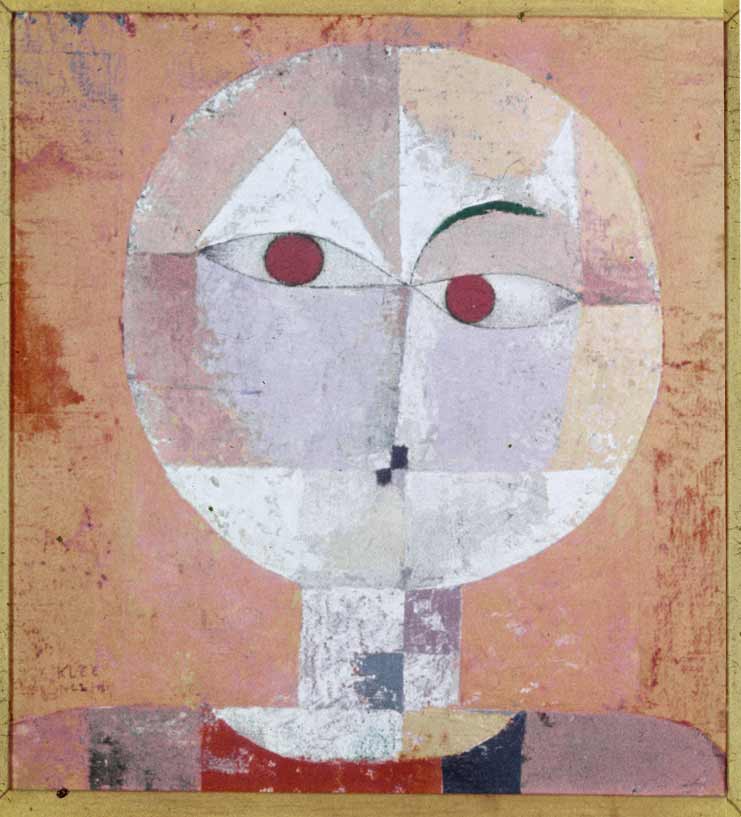
Fig. 6: Paul Klee. Senecio. 1922. Oil on chalk base on gauze on cardboard. 40.3 × 37.4 cm. Kunstmuseum Basel (Wiki Commons)
In the context of art history, the influence of Akuaba Dolls (and many other carved representations from West Africa) on European art of the early 20th century (see Fig. 6) is of interest. [2] The formal similarity to Klee's painting (fig. 6) is striking at first glance, but whether this is a direct reference must first be verified. In the context of art history, it would then be of interest in a next step which aesthetics were of interest to the artists at the time and which they blanked out, i.e. which "image of Africa" they wanted to have and also communicate.
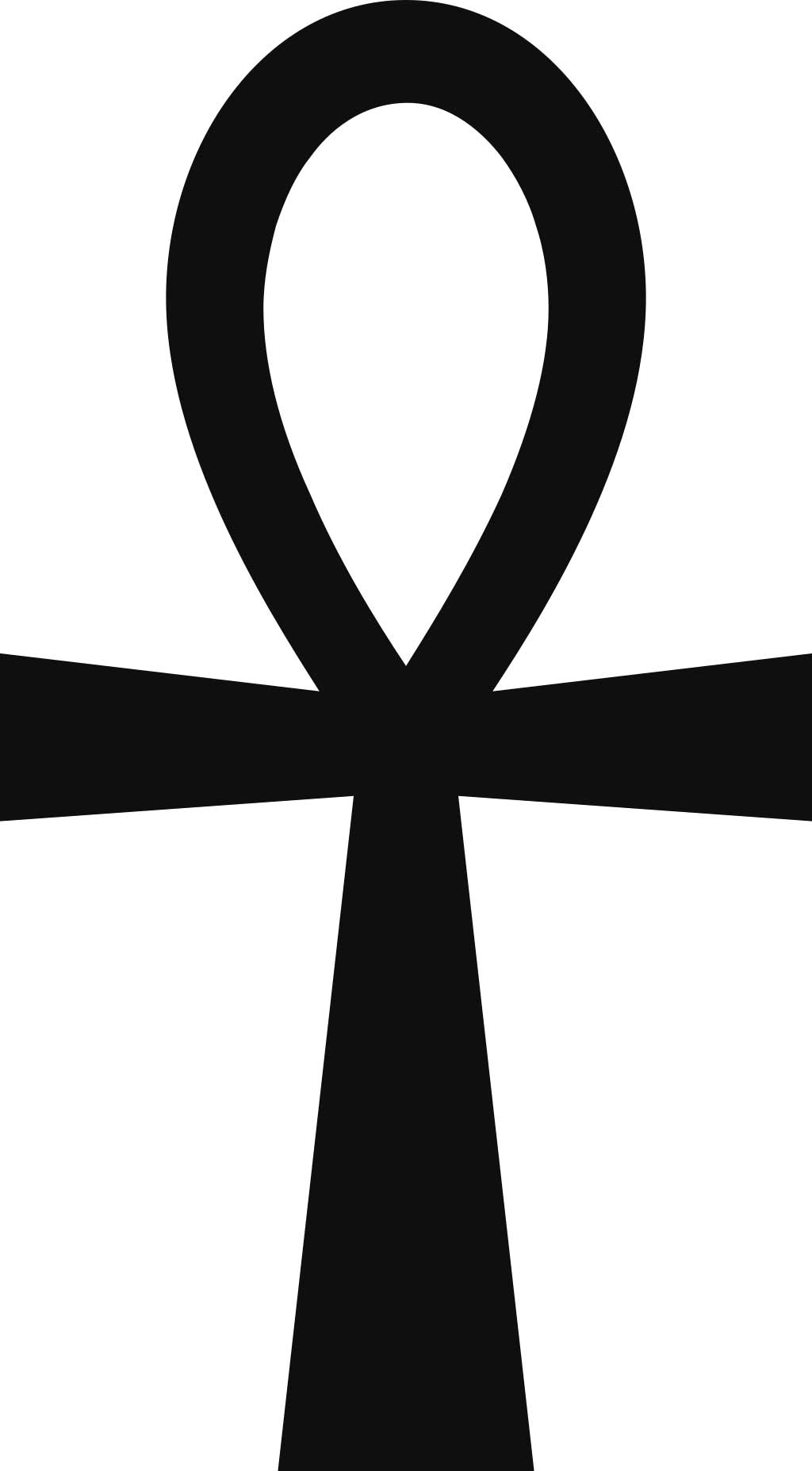
Fig. 7: Hieroglyph Anch
(Photo: https://anthrowiki.at/Anch)
The authors also considered whether the formal similarity of the Akuaba Dolls with the ancient Egyptian hieroglyph ‘Anch’ (the "loop of life" or the "key of life" - see Fig. 7) could have come about through a historical relationship between Egypt and Ghana. This would also correspond to the accentuation of content in Nkrumah's text with regard to the "representation of the woman as the giver of life" (see her chapter). Nevertheless, this association would also have to be examined more closely. To assume a universal archetype in the sense of C. G. Jung appears to be pedagogically misleading in its levelling effect.
In the German educational context, on the other hand, it seems important to link the figure - beyond clarifying its function - to Akua's story and thus include the role of narratives. This prevents another comparison that is also too quick and reductive when it comes to social practices (and not the isolated object), as dolls are also cared for and nurtured in traditional European contexts, but mostly by young children before puberty. So, in Europe, it does not belong to a fertility ritual, even if the child puts itself in the role of a ‘little mother’ or ‘little father’. (Another interesting question, whether Ghanaian women also go to a doctor when they are not pregnant, and whether there are comparable ritualised practices in Central Europe - for example among alternative practitioners or in esoteric circles - would have to be addressed in interdisciplinary approaches.)
Such comparisons appear to be useful, as they can show both similarities and differences, with the aim of better recognising one's own perceptual conventions or stereotypes and thus putting them into perspective. All this still leaves the question of the status of this doll in Munich when it is displayed in a showcase in a European museum (see Lab entry: What is an object? Link). Such a presentation contradicts its ritual and spiritual use. An Akuaba is then no longer an Akuaba. But what is it then?
Sources
This text is based on:
- Contribution by Gertrude Nkrumah: https://explore-vc.org/en/objects/the-akuaba-doll.html
- Talks with the Ghanaian EVC partners in Bayreuth in 2022: https://explore-vc.org/en/activities/archive/april-22-25-2022-joint-workshop-uew-team-and-isb-team.html
- The presentation at the National Museum in Accra, seen in March 2023: Fig. 4.
- Reading: see list of references
References
- Akyeampong, E & Obeng, P. (1995). Spirituality, Gender, and Power in Asante History. The International Journal of African Historical Studies. 28, 3. pp 481-508
- Anderson, Elizabeth L. (1989): The Levels of Meaning of an Ashanti Akua'ba. In: Michigan Academican. 21 205-219
- Annor, I., Dickson, A & Dzidzornu, A. G. (2011): General Knowledge in Art. Accra (Aki-Ola Publications)
- Forkl H. (1997): Healing and body art in Africa. Stuttgart (Lindenmuseum)
- Kecskési, M. (1999): Kunst aus Afrika - Museum für Völkerkunde München. Munich (Prestel)
Footnotes
[1] The number of five neck bulges here (there are also specimens with 3, 8 or 9 bulges) may also be a reference to the sacred number of "Odumankoma", the Akan creator deity, in this context.
[2] On the relationship of the European avant-garde to the aesthetics of West African carvings, see also the discussion of the Blue Rider post on this website (link 1 and 2).
 Christin Winter
Christin WinterMy Encounter with Black Feminism and Womanhood Inspired by the Akuaba Doll
I first came in contact with the Akuaba Doll while reading Bernardine Evaristo’s award winning book Girl, Woman, Other. In the book, the character Nazinga was described as “at least six foot tall with ornamented dreadlocks, large wooden Akuaba fertility doll earrings, red trousers, a cream embroidered caftan and strappy Roman sandals“ (Evarsito 2020, p. 81). I searched for Akuaba fertility doll earrings on the internet, but did not delve further into the topic at this time. A few weeks later, attending a seminar with Dr. Wagner at Friedrich-Alexander University in Erlangen, I stumbled upon the Akuaba Doll again. I knew, I had to take this opportunity to get to know her better. The comment from Gertrude Nkrumah is to be considered my first source of information about the history of origin and the tradition into which the Akuaba Doll is woven.
Through Nkrumah's feminist perspective on the Akuaba Doll, I wanted to dive deeper into the topic of Black Feminism to extend my knowledge in feminist theory. With the Akuaba Doll as my point of departure, I decided to focus on the ability to bear children and the social significance of abortions for Black women.[1]
At this point I move past the Akuaba Doll and her cultural context. Other works of art could have led me to a similar path. I have chosen to look at the Akuaba Doll with categories, which are not directly related to the Akuaba Doll and her cultural context as I questioned whether I have the right to write about the Akuaba Doll considering the colonial past of my own country, Germany. I am a white, European woman, a feminist, who is aware of intersectionality and racist structures within the society I have been socialised in and its way of thinking, but with no cultural connection to the Akuaba Doll other than the colonial impact on African art and culture (cf. Kushinator, Rahman and Dompreh, 2020[2]). Therefore, I chose a topic to which I have access via my role as a student of pedagogy and focus on Black Feminism and Womanhood of Black women living in white-dominated countries.
In white-dominated societies, Black women were excluded from a feminist movement for decades (cf. hooks, p. 216f.). White women systematically utilised the racist hierarchy within women to gain power and thereby forced a specific Black feminist movement to form and uncover the oppression Black women had and still have to face. The prefix “Black” emphases the specific oppression Black women face in white-dominated countries, although, of course, there has been feminist movements in Black-dominated countries before (cf. Roig quoted from Berlin Biennale 2022, 48:00 – 49:50).
In American history, Black women have always had to fight to be seen as women. As bell hooks gets to the heart of it: “the black female was a creature unworthy of the title woman; she was mere chattel, a thing, an animal” (hooks 2015, p. 214). Sojourner Truth[3] had to bare her breasts to prove that she was a woman indeed. Being yelled at “I don’t believe you really are a woman” by a white man represents the contempt and disrespect for Black womanhood (cf. hooks 2015, p. 214). In her famous speech “Ain’ I a Woman” (1851), she argues, that she – as her white women audience too – is indeed a woman. Here she argues with characteristics, that can also be found in the Akuaba Doll. The most important argument is the carrying and bearing of children and the “mother’s grief” (Truth 1851 quoted from hooks 2015, p. 215) she cried out, when her children were sold into slavery.
The ability to bear children has always played an important role in the history of womanhood and was – and still is – utilised to oppress and exploit Black women. In times of slavery, Black women were forced to procreate and bear children, who were worth a lot of money in a perfidious system of human trafficking (cf. Federici 2020, p. 23f.). In the late 20th century, Black men in the U.S. reasserted what they called their “rightful positions as patriarchs” (Taylor 2022) and denounced birth control and abortions as genocide that compromised the future and freedom of Black families by limiting the Black population (cf. Federici, p. 25f.). With the overturn of Roe v. Wade[4] – Black women are specifically affected, as Kwajelyn Jackson, Executive Director of the Feminist Women’s Health Center in Atlanta, Georgia puts it into a nutshell: "Abortion bans are inherently racist because they do not consider the lived experiences of Black people and other communities of colour. Many state policymakers would rather criminalize and endanger Black birthing people than supply them with all of the resources they actually need" (Jackson quoted from Long 2022). Even before the abortion laws were restricted, Black (and other BIPoc) women in the U.S were two to three times more likely to die from pregnancy-related causes than white women (cf. CDC 2019). Being allowed to decide whether you want children or not and furthermore, having access to certain facilities to end a pregnancy or not is still a bound to privileges. It is not only tied to the health care system, but also to cultural beliefs and practices, to the financial and educational background, as well as to class, race and many other factors.
In a world imprinted by patriarchy and privilege, it is important to unravel power structures that dominate our world, uncover where they come from and how different groups are affected differently. As patriarchal patterns of thought are inscribed in nearly all societies of our world, it is a tough task to uncover them in every aspect of our lives and hence require lifelong learning and feminist thought. Nevertheless, it is indispensable in order to build an anti-racist gender-equal society in which every woman can decide herself, if she wants to get children without fearing financial or social consequences.
In this context the Akuaba Doll can be interpreted as an early moment of feminism, where women disrupt the patriarchal system that marginalizes them. As Nkrumah states, by deciding about the gender of her child in a binary system, she chose to bear a girl rather than a boy, which – in the matrilineal line – effects the lineage, inheritance, and chieftaincy succession (cf. Nkrumah 2020). In my eyes, Akua used the power she had to influence her life to her advantage. Yet the worth of women was still tied to her sexual and reproductive abilities, but nevertheless she made a first step by empowering women to stand up for themselves and for their own lives.
References
Berlin Biennale (2022). Panel: Afrofeminism. Bridging the Gap. <https://12.berlinbiennale.de/media/panel-afrofeminisms-bridging-the-gap/> (09/30/2022).
Center for Reproductive Rights (2022). The World’s Abortion Laws. <https://reproductiverights.org/maps/worlds-abortion-laws/> (09/30/2022)
Evaristo, B. (2020). Girl, Woman, Other. UK: Penguin Books.
Federici, S. (2020). Jenseits unserer Haut. Körper als umkämpfter Ort im Kapitalismus. Münster: Unrast.
hooks, b. (2015). Ain’t I a Woman. Black Women and Feminism. New York: Routledge.
Kushiator, G., Rahman, A. and Dompreh, H.-O. (2020). The Influence of Western Culture on Traditional Art Forms and Cultural Practices: ‘Akuaba’ doll among Akan Women in Africa. ADRRI Journal of Arts and Social Sciences, Ghana: Vol. 17, No.6 (5), S.59 – 71.<https://www.researchgate.net/publication/344438737_The_Influence_of_Western_Culture_on_Traditional_Art_Forms_and_Cultural_Practices_%27Akuaba%27_Doll_Among_Akan_Women_in_Africa> (09/30/2022).
Long, S. (2022). Abortion Bans pose a Danger to all Mothers. For Black Women, they’re especially damaging. <https://www.refinery29.com/en-us/2020/10/10015405/abortion-ban-racism-black-women-effects> (09/30/2022).
Nkrumah, G. (2021). Inversion of Hegemony with Ideas of Feminity. <https://www.explore-vc.org/en/objects/the-akuaba-doll.html> (09/30/2022).
Taylor, K.-Y. (2022). How Black Feminists defined Abortion Rights. <https://www.newyorker.com/news/essay/how-black-feminists-defined-abortion-rights> (09/30/2022).
Footnotes
[1] In this context, I will delve into the topic of reproductive abilities and use the term "woman" throughout my text. However, I want to clarify that the ability to bear children is not a defining characteristic of womanhood. Not all women have a uterus, and not all women are able to bear children. Furthermore, one's physical appearance is not a determining factor of one's gender identity. Despite this, the reproductive ability is instrumentalised in our society and can lead to harmful stereotypes, which many women are confronted with at some point in their lives.
[2] In addition to exploring the different forms and cultural backgrounds of Akuaba Dolls, this article delves into the ways in which culture, religion, and artistic expression are intertwined in African cultures. The article points out how the colonization by white, western, and Christian men and women caused a change in function and values of the Akuaba Doll.
[3] Sojourner Truth lived from 1797 to 1883. She was an American abolitionist of New York Dutch heritage and a women’s rights activist. She was born into slavery, but escaped to freedom in 1826. In 1851 she joined George Thompson, an abolitionist and speaker, on a lecture tour through central and western New York State. At the Ohio Women’s Rights Convention in Akron, Ohio, she gave her speech with later became famous as “Ain’t I a Woman?”
[4] Roe v. Wade is a legal case in which the U.S Supreme Court ruled that unduly restrictive state regulation of abortion is unconstitutional and that the Constitution of the United States generally protects a pregnant woman's liberty to choose to have an abortion. This decision from 1973 was overturned by the U.S. Supreme Court in 2022.
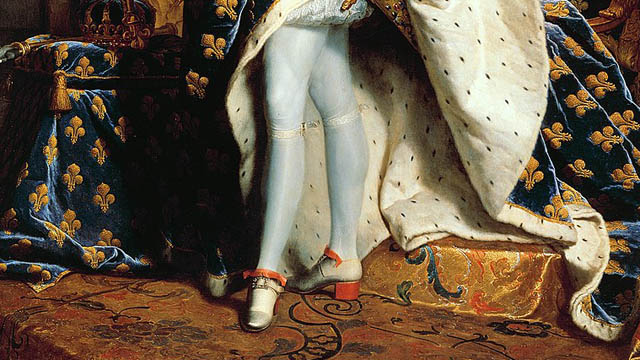
-
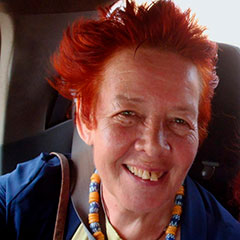 Bea Lundt
Bea LundtLouis XIV (1638-1715), King of France, was painted by Hyacinthe Rigaud (1659-1743) in his palace in Versailles near Paris in 1701. The oil painting was larger than life: 277 cm in height and 194 cm in width. The official title reads: Portrait de Louis XIV en costume de sacre. The painting is exhibited at the Louvre in Paris (INV 7492, open access), and a copy is in the Bavarian State Painting Collection in Munich.
In this portrait, the king is shown dressed in the official royal robes of the monarch, posing magnificently in front of his throne, which is placed in the background. In the painting are gathered together all of the traditional symbols of a ruler: the crown, the sword, and the ermine cloak, which uses the fur of this most precious animal.
Hyacinthe Rigaud was a famous and experienced court painter and had many assistants in his big atelier, so we do not know which parts of the picture are actually done by him. Since photography was not yet established at the beginning of the 18th century, every court employed artists specialising in portraiture to show people what their ruler looked like, or rather how he was expected to look or wanted to be seen in order to legitimise a political programme of monarchy. Specific iconographic symbols and accoutrements were used to demonstrate the tradition of rulership, which was thought to be bestowed by divine right. Rigaud fulfilled the wishes and orders of his patrons, but he also showed subtle characteristics of the people he painted.
‘Absolutism’: Paradigm of a ruling structure that today is considered a myth
Nowadays, the portrait is often used for educational purposes to visually substantialise Louis XIV as the most important representative of ‘Absolutism’ in Europe, the regime of direct rule with no control by a parliament or council: ‘L’etat c’est moi’ (‘I am the state’), he is said to have described his understanding of his place in the world. Research has discovered that he never really defined his role in this way (first in Bernier, 1988, p. 110). However, it is true that he was attributed with the image of being the central part of nature and the cosmos: as the ‘Sun King’, he was staged as the genesis and focus of all energy whence all life originates.
Scholars of the early modern era (Henshall, Wrede, Reinhard) consider ‘Absolutism’ to be a myth constructed in the 19th century. Since Gerhard Oestreich observed the ‘non-absolutistic elements in absolutism’ in 1969, many studies have pointed out that the king depended on an influential elite as well as a number of committees. A complex and effective network of groups existed as the executive authority controlling the political system, as Althoff and Stollberg-Rilinger have shown in their groundbreaking books on the political organisation of the late medieval and early modern states in Europe. In their publications, they describe the ritualised methods used in communication between the influential groups in order to find a consensus. As result of that scholarly discussion of the topos of ‘Absolutism’, Wolfgang Reinhard, like other scholars, recommends, ‘that one should abandon the term’ (p. 40). But, as it is rooted quite deeply in the historical consciousness, this does not seem so simple. Martin Wrede complains in his article ‘Absolutismus’ in the handbook Enzyklopädie der Neuzeit of the continuation of the topos, namely ‘the cliché, still firmly anchored in popular views of history as well as in textbooks, of the all-dominant, all-regulating, arbitrary state built on princely power and with a splendid façade’ [‘das in populärem Geschichtsbild wie Schulbuch nach wie vor fest verankerte Klischee des alles beherrschenden, alles reglementierenden, auf fürstliche Macht gebauten Willkürstaates mit prachtvoller Fassade’] (p. 33).
The portraits of Louis XIV and other kings are used to prove the existence of this colourful glory, whilst in reality, the monarchs were representative figures and personal symbols. During Louis’s lifetime, France expanded its territory in Europe and overseas, which brought extreme losses and financial burdens to the people. Because of that disaster, it was necessary to produce a reputation of honour for the king.
Interpreting the portrait
The portrait shows Louis XIV at the age of 63, at the height of his success. But he does not appear as a strong and resolute ruler who travels around in his country, nor an active fighter who leads battles to defend his people. Pupils today always miss a specific physical ‘masculinity’ that they expect from a king They fault this person for not being able to move, run, or ride in his heavy clothes, high heels and white tights. He is forced to stay indoors, surrounded with sumptuousness. They perceive him as ‘feminine’, as the only part of his body he is presenting is his legs, much like a young woman in a miniskirt, and the grandiose wig with its long hair hinders many activities. The entire image seems ridiculous to today’s pupils. What we see here is an old, ill, vain man who is dressing up to fulfil representative duties. What pupils remark is not just some disrespectful observation but is in line with what we know about reality. Rigaud is a superb artist to show the man in his demonstration of the ritualised courtly pageant of luxury.
There are more paintings showing Louis at different phases of his life. As all royal children, he was kept in the same pretty clothes as girls during the first six years of his life. Portraits show him even at the age of ten with facial features and accessories we perceive as feminine and fanciful, not suited to preparing for the life of a strong ruler. The official regent for Louis until he turned 22 was his mother, Anna of Austria. Louis strengthened the Catholic church but did not follow her order of monogamy: besides his six legal children, he had eleven illegitimate ones, all of whom he cared for (Bernier, Tischer, Wrede).
The ideal of masculinity during this time was the mixed one of early modern times, when gender was more hybrid than in the 19th/20th centuries, and life concepts were not sharply polarised between men and women in different spaces, placing men in the public sphere (Dinges, Lundt). Also, the central symbolic figure for the state was not necessarily masculine; there were very influential wives, concubines, and even female rulers.
Conclusion
In the educational process, it is important to dismantle prejudices about past ideals for masculinity as being strong, powerful and heroic. The historic examples of individual men’s glorious performances on European thrones need to be questioned. Pictures like the one of Louis XIV can help to construct a different understanding of courtly life. If it is understood against the background of a plurality of life concepts for ruling men and women, it can help us to see the limitations of their power.
References
- Gerd Althoff: Rules and Rituals in Medieval Power Games, Brill Academic Publ. 2019.
- Olivier Bernier: Ludwig XIV Die Biographie, Albatros Verlag 1988. English edition: Louis XIV, New Word City 2018.
- Ida Blom, Catherine Hall, Karen Hagemann: Gendered Nations. Nationalisms and Gender Order in the Long Nineteenth Century, Bloomsbury 2000.
- Martin Dinges (ed.): Männer-Macht-Körper. Hegemoniale Männlichkeiten vom Mittelalter bis heute, Frankfurt am Main 2005.
- Karen Hagemann: Gender, War, and Politics: Transatlantic Perspectives 1775-1830, Palgrave Macmillan 2020.
- Nicholas Henshall: The Myth of Absolutism. Change and Continuity in Early Modern European Monarchy, London 1993 (first published in 1992).
- Bea Lundt: Die Grenzen des Heros. Vielfältige Männlichkeiten in Mittelalter und Früher Neuzeit. In: Martin Lücke (ed.): Helden in der Krise. Didaktische Blicke auf die Geschichte der Männlichkeiten, Berlin 2013, pp. 67-102.
- Gerhard Oestreich: Geist und Gestalt des Frühmodernen Staates, Duncker & Humblot-Verlag 1969.
- Wolfgang Reinhard: Geschichte des Modernen Staates, München 2007 (and elsewhere).
- Barbara Stollberg-Rilinger: Des Kaisers alte Kleider. Verfassungsgeschichte und Symbolsprache des Alten Reiches, C.H. Beck Verlag 2nd edition 2013.
- Anuschka Tischer: Ludwig XIV, Stuttgart 2016.
- Martin Wrede: Absolutismus. In: Enzyklopädie der Neuzeit vol. 1, Stuttgart 2005, cols. 24 -34.
- Martin Wrede: Ludwig XIV. Der Kriegsherr aus Versailles, Darmstadt 2015.
Translated from German by Kelly Thompson.
published September 2020
 Bea Lundt
Bea Lundt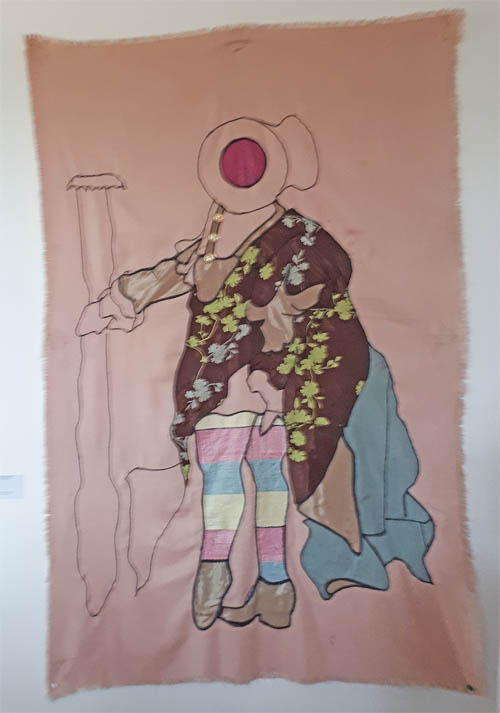 Prince Osei Owusu Bempah, from the exhibition "Orderly Disorderly" - End of Year Exhibition, KNUST (Kwame Nkrumah University of Science and Technology) in Kumasi, Ghana, Museum of Science and Technology in Accra, 2017, © Prince Osei Owusu Bempah
Prince Osei Owusu Bempah, from the exhibition "Orderly Disorderly" - End of Year Exhibition, KNUST (Kwame Nkrumah University of Science and Technology) in Kumasi, Ghana, Museum of Science and Technology in Accra, 2017, © Prince Osei Owusu BempahThe artist Prince Osei Owusu Bempah from Ghana artistically examines in two art works the portraits of Louis XIV (and below a typical European equestrian portrait of a ruler, like e.g. Charles V, painted by Titian 1548, today at the Prado Museum in Madrid). "Bempah appropriates historical images in the form of painting, sculpture and photography. Considering images as a multiplicity, he is now drawn to news from social media, television, radio and newspaper. Information is crucial to the making of his works which extends beyond the visual representations. He reinterprets them in tapestry, embroidery, banners and uses plastic sacks, curtain accessories, second hand table cloths and silk in different configurations. He substitutes certain elements of the original images with mortars and pestles" (leaflet of the exhibition).
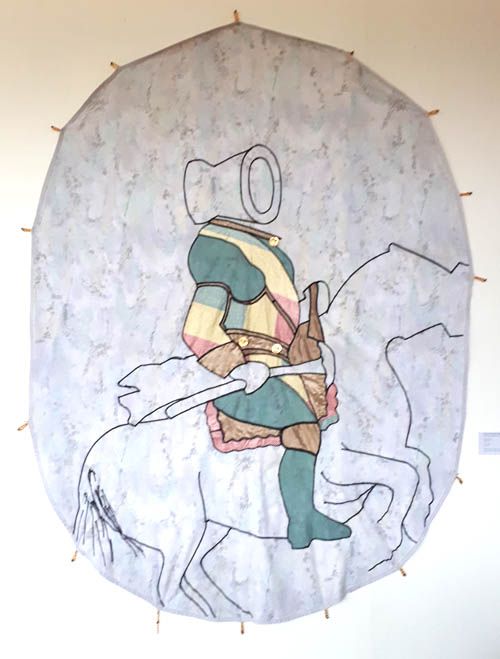
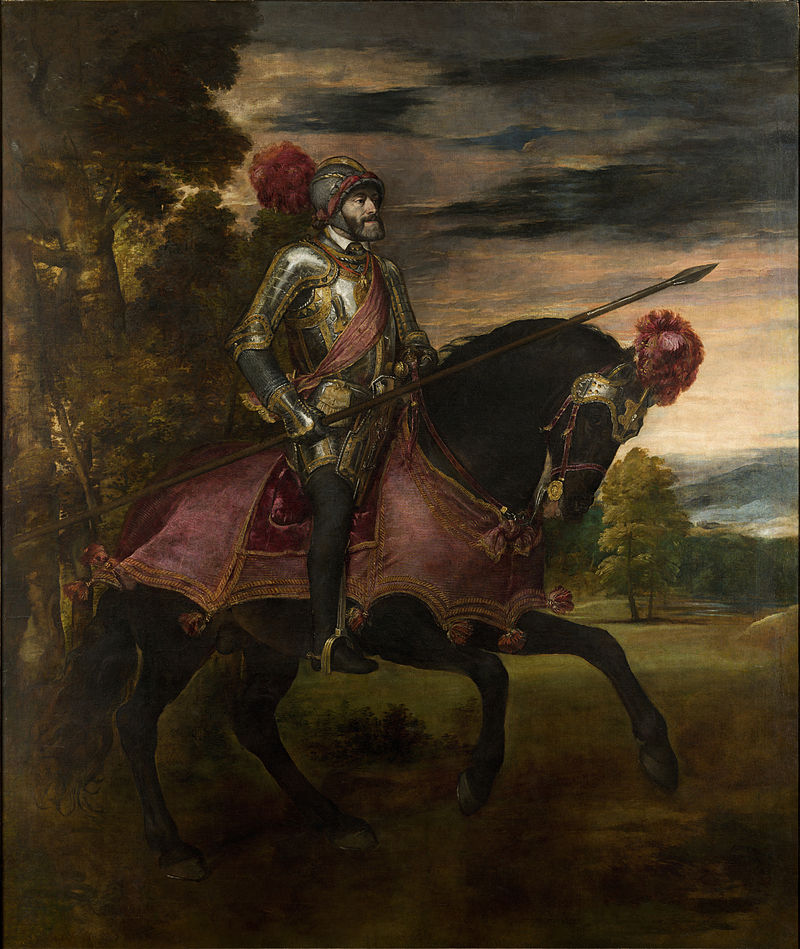
Image 1:Prince Osei Owusu Bempah, from the exhibition "Orderly Disorderly" - End of Year Exhibition, KNUST (Kwame Nkrumah University of Science and Technology) in Kumasi, Ghana, Museum of Science and Technology in Accra, 2017, © Prince Osei Owusu Bempah. (left)
Image 2: Tizian, Carlos V en Mühlberg, 1548, H: 335 cm, W: 283 cm, Oil on Canvas, Museo del Prade. (right)
published November 2020
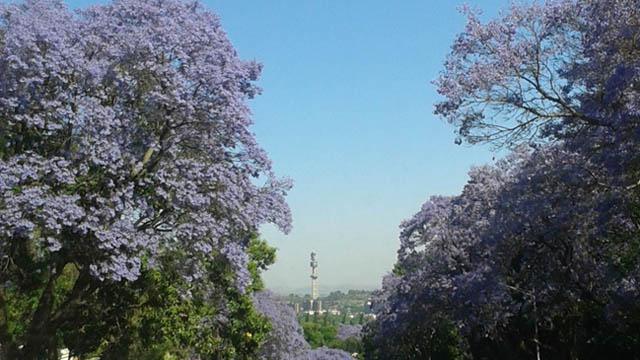
-
 Esther Kibuka-Sebitosi
Esther Kibuka-SebitosiThe image shows the deciduous large Jacaranda tree that grows up to 20-30 m high. The leaves are bipinnate produced in conspicuous large panicles, each flower with a five-lobed purple corolla. The fruit is oval flattened capsule containing numerous seeds. The Jacaranda in Pretoria flowers between September to November with purple flowers that paint the whole City purple. For this reason, Pretoria is called the Jacaranda city.
Known for its alluring lilac blossoms, the Jacaranda tree (Jacaranda mimosifolia) is native to South America and was introduced for decorative purposes way back in the 1800s to South Africa. In Pretoria, the Jacaranda was first introduced in Arcadia in 1888. Its beautiful flowers are characteristic of the springtime in Pretoria, City of Tshwane, Gauteng Province, where it fascinates the residents by putting a light purple carpet all over the roads.
Although the purple flowers remind the University students of the exams that take place around that time of the year, the elegant beauty of the Jacaranda flowers calms down the souls of many residents. Legend has it that when a flower from the Jacaranda tree drops on top of your head, you would pass all of your exams. Therefore, students wish for on eof the soft blossoms to drop one of its tubular flowers on their heads as they pass under this magical tree. The seeds, on the other hand, are enclosed in a brown, oval and flat capsule, which bursts open when dry, releasing flat winged seeds. They disseminate via wind dispersal to the savannah, woodlands, rocky ridges, riverbanks and all sorts of habitats.
To the conservationists, this deciduous beauty is an invasive species. Its origin is reported to be South America, particularly Argentina and /or Brazil because of the name’s Guarani origin in Argentina. The tree is regarded as an invasive species in South Africa and Australia. In South Africa, it is labelled as preventing growth of native species. However, in other parts of Africa such as Zambia, Zimbabwe and Kenya, the species is also present without being considered invasive yet.
In Pretoria, City of Tshwane, Gauteng province, the Jacaranda trees are enormous and line the pavement of the streets and inhabit roadsides, as evident in the images above. When they flower, they paint the whole City purple and it is spectacular to witness. The images portray the beauty and elegance of the tree that perhaps is draining the native ecosystem, which not to many are aware of.
Jacaranda blossoms are stunningly beautiful, but hidden underneath is the contradiction of the tree being an alien species that prevents indigenous trees from growing. Indeed, not “all that glitters is gold”. For this reason, the Jacaranda tree is no longer allowed to be planted in Pretoria.
Water scarcity is the most alarming problem of the twentieth century next to climate change in conservation. The sustainable Development Goal (SDG) 15 aims to protect, restore and promote sustainable use of terrestrial ecosystems, sustainably manage forests, combat desertification, and halt and reverse land degradation and halt biodiversity loss. In the meantime, SDG goal 11 promotes sustainable cities and communities. The dilemma of keeping the City green with trees and balancing the water ecosystems with the proper tree planting is a challenge that must be tackled through a multi-inter and trans-disciplinary approach to sustainable development. The Jacaranda tree is an example of this contradiction.
Apart from being beautiful ornamental trees, the Jacarandas' wood is used for furniture and other crafts. Meanwhile, programmes to address the social economic problems in communities were linked to alien species like the Jacaranda. These programmes aim at the sustainable management of natural resources through the control and management of alien invasive plants, by removing the species and thereby bringing employment to the youth, as part of the expanded Public Works Programme. The objective is to reduce the impact of invasive alien trees on water resources.
All over the world, trees and plants are introduced for various purposes. These trees contribute to multiple services for instance fodder, timber, medicines, fruits, shade and ornaments. Now as resources become scarce - especially water -, conflicts are beginning to emerge. Benefits and costs of these species are weighed against the endurance of the people and impact on the environment. Many strategies involve physical removal of alien vegetation. The benefit-cost analyses conducted so far have shown that the investment in clearing invasive species cost for example R116 in riparian areas, which equals about 6,40 US-Dollars (Marais and Wannenburgh (20008). However, it is important to remember that clearance seldomly results in total elimination.
References
- Jacaranda Jacaranda mimosifolia, retrieved from http://www.invasives.org.za/legislation/item/265-jacarandajacaranda-mimosifolia
- Marais, C and Wannenburgh, A.M. (20008) Restoration of water resources (natural capital) through the clearing of invasive alien plants from riparian areas in South Africa — Costs and water benefits.
- South African Journal of Botany 74 (2008) 526–537
- https://www.news24.com/Archives/Witness/Theyre-beautiful-but-jacarandas-can-do-harm-warns-expert-20150430
- Bolsmann, E. (1997). Jacaranda – Pride of Pretoria. Pub Be My Guest Publishers, Pretoria pp. 40.
- Potgieter, M.J and A.Samie (2019). Ethnobotanical survey of invasive alien plant species used in the treatment of sexually transmitted infections in Waterberg District, South Africa, retrieved from: https://doi.org/10.1016/j.sajb.2019.01.012
published May 2020
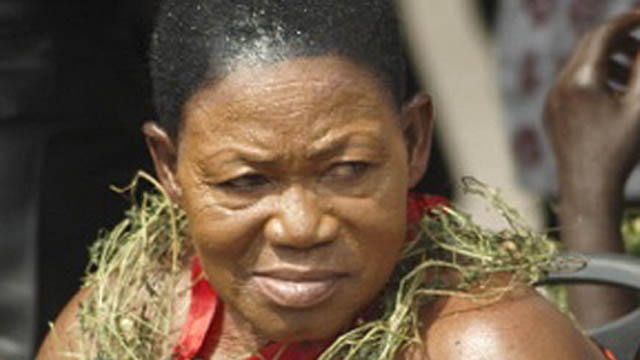
-
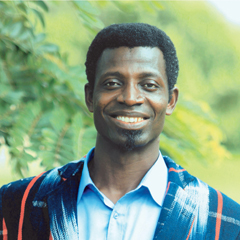 Osuanyi Quaicoo Essel
Osuanyi Quaicoo Essel
Africans, including Ghanaians, had their peculiar way of life long before they encountered the colonialists. They had a robust governance structure (kinship system), laws and standards of beauty inherent in their beauty culture practices. The African society was orderly organised to the extent that there were minimal deviants. They had built no prisons for offenders, rather, their sense of communalistic living and religious practices shaped their modest way of life. Based on their customary laws and taboos, offenders atoned for their wrongdoings through rites and rituals which were enough corrective measures. In some cases, the corrective stigma associated with particular wrongdoing was enough deterrent to possible offenders. For example, someone who stole a bunch of plantains was made to carry the plantain on the head, and matched by multitudes through the streets of the community, announcing the offenses s/he has committed. Sometimes, offenders were sent to the chief palace for settlement of the case. The society was so organised and cultured to the extent that when the community became aware of the wrongdoing of an offender, s/he may not find a spouse or suitor in that community. Before arranging for marriage, the families of both parties engaged in serious investigation about the socio-moral backgrounds of both suitors regarding their behaviours in and outside the community. When a suitor had criminal records, the family of the suitors disallowed such a marriage. In personal communication with M. Opoku-Mensah (12th June 2020), he referred to a purported address of Lord Macaulay to the British Parliament on 2nd February 1835 which confirmed what pertained in precolonial Africa. Lord Macaulay reportedly said:
“I have travelled across the length and breadth of Africa and I have not seen one person who is a beggar, who is a thief such wealth I have seen in this country, such high moral values, people of such calibre, that I do not think we would ever conquer this country, unless we break the very backbone of this nation, which is her spiritual and cultural heritage…”
Just as any society, this statement suggests that Africans also had the way of life, including the standard of beauty and makeover practices.
Precolonial Ghana, as in the case of other Africans, held in high esteem their indigenous beauty culture standards. They held a complex standard of beauty embodied in their ‘Afrocultural aesthetics’ (Essel, 2017, p.25). Afrocultural aesthetics has to do with the conceptual and contextual hybridity of aesthetics that celebrate ideas expressed in artworks (Essel & Acquah, 2016) and the intended purpose of art, be it functional, symbolic or decorative. A work of art is considered good or beautiful once it served the purpose for which it was done. This implies that beauty is judged in context as well as the concept. The Afrocultural aesthetics also apply to the beauty culture practices of the people. One of the beautyculture practices precolonial Ghana held high was hair grooming aesthetic ideals. Hair occupied a central position in the scheme of social standing to the extent that it sent a message about the status of its wearer to the audience who understand such a language. One could differentiate a married woman from the others based on her hairdo in Ghanaian society. Hair was treated with natural hair softeners, conditioners, colourants, and accessories such as comb. Special combs that helped the people to keep the hair in good shape were fashioned by sculptors from wood, bones and metal. The combs were artistically shaped with symbolical essence just as the hair itself. What the precolonial African society did not do was to stigmatise the hair type and texture of their fellow Blacks.
The advent of the slave trade, colonialism and Western education began to sew the inferior seed of black hair stigmatisation and discrimination. Gradually, this ‘inferior seed’ (Morrow, 2014) sewn has entered the educational institutions which should be the agent of change, centre of Black consciousness, character reformation centre and panacea of pan-Africanism has rather turned into Afrosaxons colonialist surrogates perpetuating Afrocentric hair stigmatisation against their educands (Essel, in press). In the effort to decolonise the bastadised and proscribed Afrocentric hairstyle practices in Ghanaian schools, this article explores the conflicting tensions in the process on the part of the school authorities, students and the parents.
Decolonisation theories is central to this study. There exists different perspective on the subject matter of decolonisation. Some have looked at it from Euro-American perspective while others argued that the process remains incomplete when it is one-sided instead of two-sided, that is, looking at it from the perspective of the colonised and the coloniser. On this path, Wenzel (2017) examined the multiple objects and aspects of decolonisation namely, political economy, epistemology, culture, language and nature, and theorised that there exists unevenness and incompletion of the decolonisation process. By studying the various roles played by the colonisers, anti‐colonial nationalists, and Cold War superpowers in decolonisation, Wenzel (2017) observed that postcolonial independence did not necessarily bring national liberation. This liberation in my view includes mental emancipation, and redefinition of Africanness, believing in
ourselves.
In the encounter of the colonialists with the colonised, the former has painted monstrous and negative perceptual image about the latter which has affected the way of life of the latter.The colonialist projected their standards of beauty and art to the colonised and spoke ill of that the colonised to retard social progress and prolong colonial domination of the latter (Nkrumah, 1963).By so doing the colonialists’ beauty culture standards have been ingrained and practised in academic institutions and everyday life and has seeming override indigenous beauty culture standard of the colonised. In line with this, the decolonisation concepts that guides this study is that, the African needs to be measured by his/her cultural beauty standards that does not breach the fundamental laws of his nation or state. The African must gain national cultural consciousness and must not be necessarily be measured with the standards of the colonialist (Nkrumah,1963; 1964). Before the Black Hair Stigma in Precolonial Ghana There are different types of hair ranging from type 1(a, b, c), 2(a,b,c), 3 (a, b, c) and 4 (a, b, c). The types were classified according to the straightness, waviness, curl patterns and kinky look. Hair may also be described in terms of its texture, density, porosity and colour. These characteristics of hair
differences may manifest in individuals, groups, society or race. Despite the differences in hair type, all people of the world belong to one race, that is the human race (Elliot, 2016). Even among Blacks, there are differences in hair type. Precolonial Ghana was made of different ethnic groups of which the Akan were the majority. Though they were of different ethnicities, they did not discriminate against each other on the basis of their hair type or hairstyle. The people wore different hairstyles based on their ethnic affiliations, beliefs and practices, social status, and to celebrate events such as festivities and or funerals. Sometimes the hairstyles were worn for art sake. The hairdos had performative importance, semiotic power, and engendered identity. For
example, queen mothers wore a kind of hairdo named dansinkran (Figure 1) known for its iconic stature amongst the chiefdom.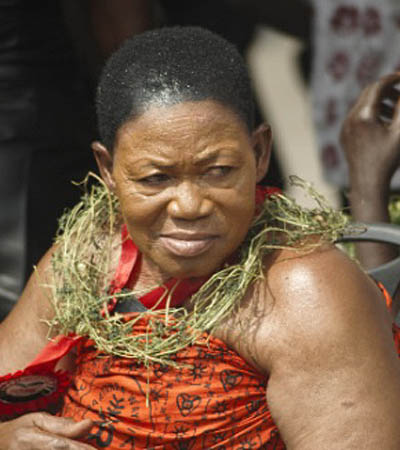
Figure 1: A woman wearing the dansinkran hairstyle. (Image courtesy: Godhit, 2017).
The hairstyles of the people ranged from natural dreadlocks popularly called rasta (known in Akan language as mpɛsɛmpɛsɛ), Afro, braiding, plaiting, shaving and African wigs. Though the word rasta is regarded more as a Jamaican phenomenon, mpɛsɛmpɛsɛ (which was named rasta) existed in some parts of Africa including Ghana in precolonial times. Some were born with the rasta. People born with rasta were considered by society as special beings, for that matter sacred. Apart from that, some priests and priestesses wore dreadlocks or afro. Cowries were placed in the rasta or afro hair of some priests and priestesses for symbolic, decorative, religious and ritual purposes. In this article, the term rasta is used in the context of both natural and artificial dreadlocks in precolonial, colonial, postcolonial and contemporary times. Again, the term Afro was introduced in the 1960s in reference to African American grown hair. From this word came Afrocentric. It is worthy of note that the enslaved Africans who were taken ashore had relatively long and grown hair. This was one of the hairstyles associated with males in precolonial Africa. The colonialists negatively described that hairstyle as bushy. Meanwhile,the long hair of the colonialists did not merit such a negative description. Till now, the term bushy hair connotes an offensive description of overgrown African hair. Many young Ghanaian people would prefer the term Afro to mean fully-grown hair than to describe their hair as bushy. Though the term Afro emanated from the US, the hairstyle was long in practice in many parts of Africa.One could differentiate between a maiden and a married woman just by looking at the hairstyles they wore. The people also used natural hair treatments that conditioned and softened it to keep it in good shape. The Akan often said ɔbaa n’enyimyam nye ne tsirhwin which literally means ‘The glory of a woman is her hair.’ This expression underscored why women in precolonial Ghana cared so much about their hair. They spent a great deal of their time in pursuance of their hair beauty culture practices. During puberty rites, female adolescents are given special education on hygiene, good grooming and hair beauty culture practices and treatments because of the premium society placed on the hair. Consequently, hair became a significant communicative symbol used to express moods such as bereavement, joy; and in some cases, power and authority. For example, a male child who lost his father, mother or close relation cut the hair down to the skin (Figure 2). He appeared hairless on the head as a sign of bereavement. Some Akan female adults wore a hairstyle called takua, done by holding the hairs together atop the head and with thread to stand upright. To them, such a hairstyle is design-less and simple in paying homage to the dead.
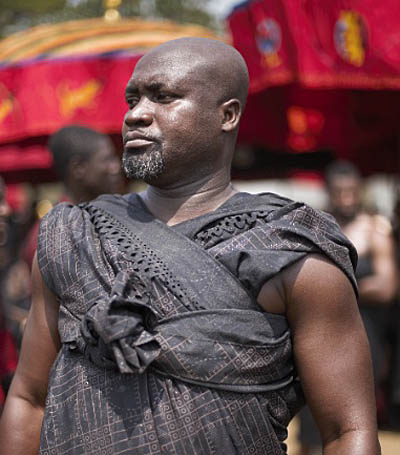 Figure 2: Man with hair cut to the skin as a signal of bereavement. (Image courtesy: Godhit, 2017).
Figure 2: Man with hair cut to the skin as a signal of bereavement. (Image courtesy: Godhit, 2017).Slave Trade, Colonialism and Western Education in Black Hair Stigmatisation
Precolonial Ghana had its own well-established form of education, evolved by the people themselves (Sampson, 1932; Essel, 2019) before their encounter with the colonialists. They trained the young ones through a rigorous enculturation process and apprenticeship system. They passed on the artistic culture and way of life from generation to generation through the robust apprenticeship system which is formal education and training (Essel, 2019). Training of the young ones was the duty of the immediate and extended families as well as other people in the community. It was for this reason that the precolonial society was described as living a communalistic life. In personal communication with M. Opoku-Mensah (12th June 2020), he referred to a purported address by Lord Macaulay’s to the British Parliament on 2nd February 1835. Macaulay had found that the people had strong cultural institutions that rule their socio-moral lives. In the said statement as pointed out by M. Opoku-Mensah (12th June 2020, personal communication), Lord Macaulay said to the British parliament:
"I propose that we replace her [Africa’s] old and ancient education system, her culture, for if the Africans think that all that is foreign and English is good and greater than their own, they will lose self-esteem, their native culture and they will become what we want them, a truly dominated nation."
Macaulay’s statement was recognition of the plausibility and relevance of the precolonial form of education that catered for the good socio-moral upbringing of the people which seemed impervious. As he suggested, the way forward was to introduce their culture including the language and beauty standards which they did, and used the slave trade, colonialism and Western education as a weapon to achieve their malevolent ideological and social-imperialism agenda. With the advent of Western education in the 1500s, learners with afro and rasta were asked to cut their hair before they were permitted to enrol. Afro and rasta hairstyles were considered unkempt and cutting them signalled cleanliness. The Euro-Christian churches planted in precolonial Ghana also asked new Black converts with rasta or afro to cut them as a sign of born again. The mission schools also proscribed
these hairstyles. In the name of religion, this practice continuously ate into the social-moral fabric of the society, especially, amongst the so-called Christian elite. In effect, this gradually contributed to afro and rasta hairstyles’ stigmatisation (Alhassan, 2020; Whiteman, 2010, Whiteman, 2007)). Those who wore these hairstyles, especially, the middle-class males and adolescents, were perceived as rascals, vagabonds, smokers, and unclean.
Based on rereading of scholarly information and archival sources on Black hair, interviews and focus group discussion as a method of data collection, the study provided insight into the hair decolonisation process in Ghanaian Senior High Schools and the conflicting tensions associated with the process. The focus group consisted of Senior High School teachers with more than five years of teaching experience at that Senior High School level. Descriptive and explanatory case study designs constituted the research design for the study. The descriptive aspect was for the purpose of describingthe phenomenon (the ‘case’) in its real-world context while the explanatory case study aimed at explaining how or why some condition came to be (Yin, 2018).A sample of twenty-eight (28) participants consisting of heads (2), teachers (20), and students (6) were purposively sampled from the accessible population of fifty (50). Simple descriptive analysis formed the method of analysis. To ensure the confidentiality of participants, pseudonyms were used to conceal their identity.
Conflicting Tensions in Black Hairstyles Decolonisation There have been reports of discrimination against the hairstyle of Black students in and outside Africa. During the 2015 West African Senior Secondary School Certificate Examination (WASSCE), three students of the St John’s Wesley Grammar School, Accra, Ghana were disallowed to write because they were wearing afro hair (Citifmonline.com 2015). In 2016, there were students protest in South Africa that questioned discrimination against African natural hair in class (Mwaura, 2016). Perry (2019) also reported Black hair stigmatisation which she sees as a vestige of segregated past that deemed blackness inferior and the emulation of whites as the route towards assimilation. This discriminative happening tells that black hair stigma persists in Africa even after colonialism. With the school as an agent of enforcing colonialists’ legacy of anti-Afrocentric hairstyle practices in primary, junior and senior high schools, specifically, rasta and afro, the practice
has become deep-rooted to the extent that attempt by parents and learners to question it proves futile. Students are not happy with the enforcement, and at some point in time prove adamant to school authorities. Mirekua narrated her story:‘I attended primary and Junior High School at Opah Municipal Assembly School from 2009 to 2012. There was a time I had to hide under my desk to avoid being sacked by the headmistress. I was given a warning at the assembly grounds to go and barb my entire hair. In my second year in Junior High School, I was told to go home and barb my hair because it would hinder me from taking part in the Basic Education Certificate Examination. I stayed home for a week because [after I cut my hair for] the fear of being mocked by friends seeing, as it was my first time of having a down cut.’
Mirekua’s accounts reveal the feeling of uneasiness and low self-esteem she developed as a result of being reprimanded to cut her long hair. Her hair was cut because she must be in school or face sacking sanctions. Students who go contrary were labelled as bad or stubborn. Maame Esi, was a student in a Senior High School in the Western Region of Ghana. She completed in 2014. She confessed that she complied with the rules and regulations governing hair beauty practices in her school because she feared being suspended, sacked or disgraced at the assembly grounds of the school. Not complying with the dictates of school authorities on hair in itself is a stigma. The enforcement of these anti-Afrocentric hairstyles has been internalised to the extent that some members of the society may cast aspersion on those who wear such hairstyles. A male participant said his best friend was
advised by the parent to Part Company with him because he left his hair to grow long. ‘My grandmum told me to keep my hair… One of my friends developed a cold attitude towards me afterward. When I asked, he told me that the parents have asked him to keep his distance from me because… I have become a bad boy. Only bad boys leave their hair without cutting it’, he said.
These vignettes of the students revealed that students kowtow to the hairstyle enforcement to avoid negative labelling by the school authorities and their own colleagues. There were others who also left the public school to attend a private school who were lenient with Afrocentric hairstyle restrictions. In a focus group discussion among 20 Senior High School teachers drawn across eight regions of Ghana, the issues that emerged were that students who wore afro and rasta are perceived as deviants and ill-mannered people who do not abide by the rules and regulations of the school. This is because the school proscribes wearing of these hairstyles. To
the teachers, students appear as adults when they wear afro and rasta hairstyles which do not distinguish them from the teachers. Succinctly put, ‘They appear like mothers and fathers’ than students in those hairstyles. In addition, they argued that wearing such hairstyles in school generates competition amongst the students as they may strive to put up flashy hairstyles and put little or no concentration on their academic work. As a result, they only permit students to wear rasta or afro on health and religious grounds. As explained earlier, hairstyles have religious implications in Ghanaian society. For example, afro and rasta have a strong affinity with African Traditional Religion, which is the authentic religion in precolonial Africa. A teacher explained that: Well, from my little knowledge, I know that … priest and priestesses do not barber. Secondly, some students have soft scalps making it easy for them to catch cold anytime their hair is down. These categories of students could be allowed to wear dreadlocks or afro to school. A teacher who aligned to the Christian faith perceived these hairstyles as unacceptable. He said, ‘My religious background wants us to have a close [hair] cut as a Christian man.’ The teachers said the culture of the school does not allow afro and rasta. So, they normally use scissors on students’ hair. They also admitted asking students to go and shave their hair but when the students refuse, they sacked them from the examination hall or class, since they were not ready to shave their hair without any tangible reason. Students who wear afro are perceived as ‘weed smokers’. On the contrary, four of the teachers argued that wearing afro or rasta is normal since it
borders on individual differences, and generally accepted in Ghanaian society. The issue is that these hairstyles become unacceptable when worn by students at the primary, junior and high school levels.
In response to the question of rules and regulations regarding hair beauty culture standards of students in public schools, a teacher said:What happens is that the housemasters, housemistresses, and some teachers on duty often send scissors to the various classes or examination halls to give students awkward hair cut against the will of the students to force them to shave their grown hair. This is
a kind of punishment given to the students for leaving their hair to grow. Some students, out of pain and dislike for such treatment, leave their hair in its awkward form as done by the teachers. Such students are often refused access to classes or examination
halls; canned, suspended or asked to weed as punishment. Students comply in order to take classes or
examinations.One of the participants has taught in five schools covering primary, Junior High School and Senior High Schools, with twenty-four years of teaching experience. She has taught in Ashanti and Central regions of Ghana, and currently a headmistress of a Senior High School. She opined that:
With twenty-four years of teaching, what the schools consider a neat haircut is down cut. Rasta isn’t allowed. Any child who came to school with grown hair is either driven home or the parents are invited to the school and advised to shave the hair of the ward. Some
parents come to explain to the school authorities that cutting the hair of their children has spiritual implications that may cause sickness to the child, so, the hair should not be cut. If the authorities disagree with them, it occasionally brings quarrels. Parents who
disagree are told that their children could not fit in the school... Personally, I think those who smoke marijuana wear rasta [dreadlock]. Once they come into the school with this hairstyle, their mannerism, their characters are influenced. They might not be smoking, but other students, sometimes, see them as marijuana smokers… Actually, for my long years in teaching, most of our recalcitrant students, most of our problematic students, when you look at them from head to toe, you realise that the sort of dressing speaks to their characters too.
The views of the headmistress-participant confirmed the thoughts of the teachers. The school expects learners to wear down-cut hairstyles as institutionalised by the colonialists. The school has done little or nothing to question the etymology of this self discriminating and self-stigmatising act they enforce hook, line and sinker. This negative enforcement has been instituted through a complex network of colonial apparatus namely Euro-Christianity, Slavery, colonialism and Eurocentric education making it difficult in decolonising the process. Any attempts to decolonise are faced with vehement opposition from Blacks to their fellow Blacks. Educated Blacks (Negroes) as pointed out by Woodson (1933, p. 7) ‘hope to make the fellow negroes ‘conform quickly to the standards of the whites and thus remove the pretext for the barriers between the races.’ Caucasians who attend Ghanaian public schools are exempted from this rule. Myjoyonline.com (2019, para 2, line 2 &3) reports of a leading member of a teacher union in Ghana who said: “what I gathered was that when Caucascians [Caucasians] students cut their hair to the level of black ladies, it makes them look very ugly and it can even affect their looks so Caucasian students are not allowed to cut their hair. There is no rule in the Ghana Education Service concerning Caucasians in Ghana because we are not Caucasians, we are negroes.”
Some teachers also argue that when students are allowed to leave the hair to grow long, it attracts lice, eczema and dandruff. These comments demonstrate the anchored conflicting tensions in the decolonising process. Diseases associated with hair are curtailed when students are properly groomed by the school to follow body and hair hygiene protocols. Their hair does not attract hair and skin-related diseases because it is black or not good. Hair and skin diseases are no respecter of colour or race. Good hair has nothing to do with its texture, density, porosity or colour. It is a hair of any type that is well maintained and kept healthy. The position of the school teachers and authorities brings to mind Carter Woodson’s (1933, p. xiii) assertion that:
When you control a man’s thinking you do not have to worry about his actions. You do not have to tell him not to stand here or go yonder. He will find his ‘proper place’ and will stay in it. You do not need to send him to the back door. He will go without being told. In fact, if there is no back door, he will cut one for his special benefit. His education makes it necessary.With this, Woodson looked at how the Negro has been miseducated to the extent that s/he exhibited ‘attitude of contempt to their own people’ (p.1). He also focused on the minds of Black people giving the right kind of education that would contribute to high self-esteem to their people. There are tensions and conflicts that ensue between school authorities and students on one hand, and school authorities and parents on the other hand. Students feel that such negative enforcement deprives them of their self-esteem, selfconfidence and uniqueness as individuals. Yet, they must abide by the colonialist monolithic mentality of wearing down-cut hair as a signal for obedience, neatness and smartness as required by the school to have access to education since noncompliance attracts harsh sanctions. Some parents who disagreed with the school authorities on the position of hairstyles, pick quarrels with the school authorities. Parents have the option of kowtowing or taking their wards from the school. One particular instance of a parent taking the school on is what happened in Achimota School on March 19, 2021, which became a national debate for more two weeks, and took a centre stage on social media, Ghanaian print (newspapers) and electronic media (radio, television, internet). One parent named Raswad Menkrabea took to his Facebook page to pour out his frustration about his son being denied admission on the basis of his rasta hairstyle. Raswad Menkrabea wrote:
This morning, the school authorities of Achimota School claimed that their rules do not allow students with dreadlocks to be admitted. The school authorities denied two brilliant dreadlock students from being admitted after having been posted there by the Computer School Placement System [Computerised School Selection & Placement System]. My son was one of the affected children and the other student was also refused on the same grounds. We have no option but to battle against this gross human right violation. As a child he has every right to his culture in so far as such culture do not breach the 1992 Constitution. He equally deserves the right to access education within his culture just like other cultural believers. As a Rastafarian, I think that dreadlock do no way cause any
harm which should even be a basis to be asserted by the school authorities. The fundamental questions to ask is what does our law
say about right to one’s culture? Do you deny a child access to education based on his/her culture? Do public school rules override the supreme law of the land?
This issue, which became a national debate in public transports and markets, attracted the attention of Ghana’s parliament in March 25 2021, based on which the Education Minister, Dr Yaw Osei Adutwum assured the house that the Ghana Education Service (GES) will soon issue policy guidelines on students’ admission to all Heads of Senior High Schools in Ghana to bring finality to the issue.
Wearing long or short hair plays no role in distracting students to focus on their academics. There are many renowned private schools in Ghana that do not proscribe students from wearing rasta or Afrocentric hairstyles. The school whether public or private has the primary role of grooming students to be creative thinkers with good time management skills. The hair students keep has nothing to do with their academic performance and socio-moral conduct.
From the discussion, it has emerged that the public schools proscribe Afrocentric hairstyles with no substantial scientific evidence that wearing afro and rasta inhibits the acquisition of creative and innovative thinking, and academic performance or progress of the students. Neither have the schools established from their arguments that wearing Afrocentric hairstyles negatively impacts the socio-moral and cultural wellbeing of the Ghanaian society or indigenous culture. They point to no sound research that establishes the relationship between academic performance and hairstyle worn, and the relationship between hairstyle and social conducts of students. The conflicting tensions around the hairstyles cut across precolonial, colonial and part of global fashion, and create multiple conflicting meanings within the many-sided existence of Ghanaian hairstyles. This helps to show how unstable, changing, and multiple the meanings of the hairstyles can be. Yet the Ghanaian public schools enforce the colonialists’ discriminative legacy of stigmatising Afrocentric hairstyles in Ghanaian schools with monolithic mentality without questioning the roots of such segregative practices. Teachers have challenges with students because when they wear rasta, afro and other Afrocentric hairstyles, they do so to show seniority. In other words, do so to signal that they have come of age. Therefore, wearing afro or rasta by the public school
students becomes a sign of rebellion and badness, while for the teachers they are signs of authority and respectability while this is not the case in the private school students. The difference between the public and private school policies creates a class division in the meaning of the hairstyles, where the Rasta and Afro styles become a sign of privilege.
Again, the teachers also deprived students of their Afrocentric hairstyles because they think it makes students susceptible to skin and hair diseases. These reasons deduced from the argument of the teachers and school authorities are not convincing to parents and students which leads to student-teacher and parent-teacher conflicts. Students gained continued access to education only when they shave their hair. Their education is threatened when they refuse to conform to the rules and regulations on hair. Students wear rasta, afro or long hair for several different reasons. Some wear it for spiritual/religious obligations, aesthetics and for fashionability purposes. This interesting practice challenges the so-called tradition and modernity opposition since a pre-colonial religious meaning and a fashion meaning can coexist in the same style and space. It is discouraging that six decades after independence from the colonialists, there are pitfalls in an attempt to decolonise the Afrocentric hair stigma created by the colonialists through the churches and schools they established. Surprisingly, the public-school authorities in Ghana have tended to be colonialists’ agents enforcing the discriminative Afrocentric hairstyles in schools. It is recommended that the Ghana Education Service and the Conference of Heads of Assisted Senior High Schools (CHASS) must work together to review the hair policies for students, so that it will not be a bottleneck for students to have access to education, which is their fundamental right enshrined in the 1992 constitution of Ghana.References
- Alhassan, S. W. (2020). “We Stand for Black Livity!”: Trodding the Path of Rastafari in Ghana. Religions, 11, 374, 1-10. doi:10.3390/rel11070374
- Citifmonline.com. (2015). School bans students with ‘unkempt’ hair from writing WASSCE. http://citifmonline.com/2015/04/22/school-bans-students-withunkempt-hair-from-writing-wassce/
- Essel, O. Q. & Acquah, E. K. (2016). Conceptual art: The untold story of African art. Journal of Literature and Art Studies, 6(10),
1203 – 1220. - Essel, O. Q. (2017). Searchlight on Ghanaian iconic hands in the world of dress fashion design culture (Unpublished Thesis).
University of Education, Winneba. - Essel, O. Q. (2019). Decolonising Ghana fashion education and training history. International Journal of Humanities & Social
Studies. 7(7), 381 – 392. - Essel, O. Q. (In press). Hair and body fashion identity narratives in ‘the Return of the Slaves’ exhibition.
- Elliot, J. (2016, May 26). Elliot Jane on the Rock Newman show. https://www.youtube.com/watch?v=fF9s0as_d_4
- Morrow, W. (2014). 400 years without the comb: Sewing the inferior seed. https://www.youtube.com/watch?v=SH7nNdz3ImY
- Mwaura, W. (2016). South African schools under attack over Afro hairstyles ban. https://www.dw.com/en/south-african-schoolsunder-attack-over-afro-hairstyles-ban/a-19513159
- Myjoyonline.com. (2019). Let it grow: Why the policy against long hair in schools must beabolished. https://www.myjoyonline.com/opinion/let-it-grow-why-the-policyagainst-long-hair-in-schools-must-be-abolished/
- Nkrumah, K. (1963). The African genius. Speech delivered by Osagyefo
Dr. Kwame Nkrumah, President of the Republic of Ghana, at the Opening of the Institute of African Studies on 25th October, 1963 - .Nkrumah, K. (1964). Consciencism. Panaf Books Ltd.
- Perry, A. (2019). “Stay out of my hair”: Black students need the federal government to tell schools to leave their hair alone.
https://hechingerreport.org/stay-out-of-my-hair/ - Sampson, M. (1932). Gold Coast men of affairs.
- Wenzel, J. (2017). Decolonization. In I. Szeman, S. Blacker, & J. Sully(Eds.), A Comparison to Critical and CulturalTheory.
https://doi.org/10.1002/9781118472262.ch28 - White, C. M. (2010). Rastafarian repatriates and the negotiation of
place in Ghana. Ethnology, 49(4), 303 – 320 - White, C. M. (2007). Living in Zion: Rastafarian Repatriates in Ghana,West Africa. Journal of Black Studies, 37(5),677-709.
- Woodson, C. (1933). The mis-education of the negro. Khalifah’s Booksellers & Associates.
Yin, R. K. (2018). Case
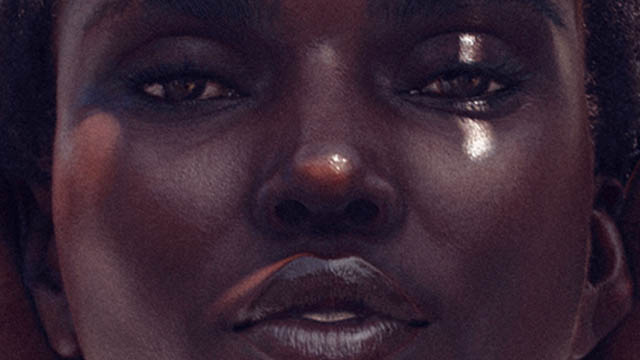
-
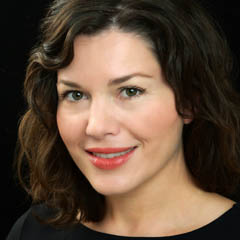 Hanni Geiger
Hanni GeigerShudu (2020), a dark-skinned mannequin based on Instagram and other social networks, is a CGI – a 3D computer graphic that, according to its creator Cameron-James Wilson (founder and CEO of the digital modelling agency THE DIIGITALS, https://www.thediigitals.com/), is considered the world's first digital supermodel. With currently more than 218,000 followers (@shudu.gram), she is one of the most booked models and has collaborations with major fashion companies such as Oscar de la Renta or the superstars Tyra Banks and Rihanna (Square, 2018). Yet the genesis of the mannequin and virtual influencer is anything but glamorous: after years as a photographer in the London fashion industry, Wilson retreats to his mother's garden shed in Weymouth, Dorset, and experiments with various design programs on a very cheap gaming computer (Jackson, 2018). In designing Shudu, he was primarily driven by a desire to work freely and “[…] focus on the art rather than the money” (Jackson, 2018). Shudu was intended to be a product of pure creativity, regardless of her later successful integration into the fashion industry (Jackson, 2018).
It takes a closer look to detect the artificiality from the model. Thanks to various digital image editing programs such as Marvelous Designer, CLO and Daz 3D, Wilson deliberately adds small flawed constructions to his very naturalistic-looking mannequin (Jackson, 2018; Square, 2018): scars, hairs, wrinkles and pores provide more liveliness, and thus also more “truthfulness”, if one were to argue in the Benjaminian sense with the aura of the unique or authentic. Basically, this is a completely contrary approach to high-end fashion photography, which classically aims to remove any physical imperfections from the human models until they mutate into doll-like, enraptured beings. This already shows through the external observation of the virtual model that „authenticity“ in the context of digital media and the outdated understanding of reality as distinct from virtuality must be rethought and oppositions in the technical, but also especially in the philosophical-social sense must be questioned.
In order to get closer to this „reality“ or the societal significance of the digital model, it is imperative to look at the controversial debates surrounding the black mannequin. As a white man, Wilson has more often had to face accusations of commercializing black culture, which is legal but equally questionable (Square, 2018). Under the rubric of “cultural appropriation”, “racial expropriation”, “racial capitalism” (Cedric J. Robinson) or “racist plagiarism” (Minh Ha T. Pham), the economic and social exploitation of inferior, marginalized cultures by the dominant white culture is understood as a neo-colonial approach, especially in the broad sector of industry. In this process, social as well as economic value is drawn from an ethnic identity, even generating a “commodity” from it, without thinking about the painful or unpleasant part or even giving minorities a share of the profits. Wilson's implementation of diversity and responsibility in the design process could, according to critics, be read as a clever marketing strategy – after all, “exoticized” phenotypes with very dark skin, high cheekbones and slender, tall stature are currently in vogue (Square, 2018). Particularly problematic in Shudu's design process appears Wilson's inspiration in the “Princess of South Africa Barbie doll”, a special edition Barbie launched in 2002 as one of the “Dolls of the World” collection (Khoabane, 2018). The digital avatar is said to have a similar origin and motivation: born out of the imagination of white companies and creatives to generate commercial success without knowing, considering or including the reality of people of color in the creation and sales process (Square, 2018).
For a holistic understanding of the figure, however, it is also important to analyze it beyond stereotypical argumentation and against the backdrop of its time, its creators and its consumers. As Generation Z and digital natives, the creators and users of virtual influencers are inevitably shaped by the technological changes of everyday life. Their thoughts and actions are primarily derived from the fascination with digital design, which increasingly merges the real and the virtual and makes physically, socially and culturally significant differentiations recede into the background. Wilson seems to use the technical qualities of the digital image, such as its mutability and ubiquity, to draw a picture of a decidedly plural, heterogeneous society in a sustainable way that is independent of time and place. Unlike the dys- and utopian visions of the future of human beings in classical fashion photography or in numerous digital drafts of human beings in art, the figure that exists only virtually seems to be the digital embodiment of a thoroughly real and, above all, present world of life characterized by diversity. With her obvious distancing from the white, male and Western-dominated political and economic mainstream, Shudu offers a template for breaking with the universalism of imperially knitted modernism via strategies of so-called inclusive marketing, which consciously considers diversity in the design process1.
The fact that the digital visualization of a virtual body that stands for diversity, such as Shudu’s, is particularly suitable for creating meanings around the human body, goes back to the postmodern discourse on the epistemology of the body and the knowledge attached to it. As Jay David Bolter recognized in the early 1990s, we as human beings know something by virtue of our bodily and social situations and not through a process of abstract and disinterested thought (Bolter, 1996, 85). Time, place and context thus determine the so-called specific “situated knowledge”, which can never be universal (Haraway, 1988). While in the 1990s transhumanist, biotechnological processes such as genetic engineering and cloning changed the body, in the (post-)digital age a new attention to the physical is evident, which is shifted to the realm of digital image production (Kröner, 2019, 72–73). What becomes evident is that despite the temporary disappearance of the human body through its dissolution into data and bits, it returns on screen in an altered and far more flexible form than the carnal. Posthumanism, following on from the tendencies of postmodernism, then makes use of digital image genesis and manipulation to base the epistemology of the body and its situatedness on the complete rejection of humanism as a Western-determined anthropocentric unity and superiority. These aspects could be relevant precisely to the reading of Shudu. The hierarchical scaling of people according to gender, ethnicity, class, sexual orientation, ability or age, which is characteristic of humanism, is to be fundamentally abandoned with the rejection of the onto-epistemological superiority of the human species (Ferrando, 2008, 438–439). Human interconnection, the symbiotic relationship with the non-human (Haraway, 2008; Wolfe, 2010) and the recognition of so-called “more-than-human geographies”2 are at the forefront of these conceptions of the body (Ferrando, 2008, 438–439). Beyond bias, dualisms and hierarchies, a (re)figuration of the human beyond the human that recognizes nature as well as technology in unity with the human (Haraway, 1985/2016) manifests itself in Shudu as a visual representation of Donna Haraway's cyborg figure. Thus, it seems that it is precisely thanks to the digital-technological “liquidity“ of bodies, techniques and media that Haraway's vision has been fulfilled: with the help of their transnational, hybrid nature, (digital) cyborgs develop subversive strategies of “writing” as a powerful form of political struggle against oppression (Haraway, 1988; Schmitz, 2016). Such “writing” (and thus also speaking) negates the dream of a common language and seemingly homogeneous identity (Haraway, 1988; Schmitz, 2016). In this respect, Shudu, as just such a (digital) cyborg, offers the template for multiple localization –against organic holism, unambiguous classification, and antagonistic dualisms (Schmitz, 2016).3
This then also includes the fact that virtual figures such as Shudu can be designed, consumed, exploited, criticized and thus also shaped on a global level in a socially, gender and culturally largely independent way4 – unlike the real, expensive Barbie dolls. With more images of underrepresented people in global circulation, habitual ways of seeing and thinking can be permanently changed, which could open up opportunities for marginalized groups, also from an economic perspective (Slay, 2018). With his collaborations with numerous representatives of the Black community as well as the Black staff team of hair stylists, make-up artists as well as also real Black models he stages for certain brands alongside Shudu (Square, 2018; Wilson 2021), Wilson intervenes in the working world and the economics of fashion. By consciously involving people of color in the design, styling, marketing, sales and profits of his company, his digital embodiments of elastic otherness impact the direction of a society that seeks to transcend Western-determined barriers – from a variety of perspectives and fields of action.
In this way, the initially small companies that originated in a decidedly plural society seem to be using both simple and advanced digital technologies to draw artificial images of a reality that has always been characterized by diversity and particularisms. The fact that the artificial figure (certainly also for marketing reasons and due to the entertainment industry) enters into a targeted interweaving with the analogue world through the staging with real people in real settings, increases its credibility and thus the social, economic and political influence of digital (human) images. Thus, these creators, who have long since outgrown their infancy and cooperate with big brands, seem to initiate a new “decentralization” of society as well as of the internet because of their politically underpinned messages about inclusion, heterogeneity and equal opportunities – and regardless of their possibly commercially colored motivation. If the dissolution of boundaries between the real and the virtual, nature and the artificial, the human and the non-human (Barron, 2003), and consequently also between art and commerce, responsibility and economy, truth and lies, majority and minority, genres, techniques and media no longer seem socially or scientifically relevant, the question of categorizing people according to skin color or ethnicity will no longer have to arise.
At this point, however, AI should also be taken into account as another possibility of digital “humanization”, which, in contrast to the purely external formation already described, concerns an “inner”, algorithmically controlled shaping of the “human-machine”. The juxtaposition of both types of artificial human creation becomes relevant in the question of the generation of “truth”, which algorithmically controlled AI – unlike the digital images and animations of social diversity mentioned above – in no way answers with the claim to represent the social cross-section. As a neural network, AI processes data such as words and images statically, it calculates the probabilities and says what the majority says and thinks (Simanowski, 2021). However, if the production of AI-generated “human images” is mainly based on large, Western-managed companies and the knowledge infiltrated into the machine is fed from data sets of a white, male majority belonging to the global North – without being externally curated or supervised – every minority and individuality is silenced (Simanowski, 2021): data inclusion on the one hand thus means the exclusion of diverse social structures on the other. This would, as it were, preprogram the return of the “gatekeepers” whose disempowerment through the internet was previously welcomed so enthusiastically (Simanowski, 2021). In this case, it becomes clear that technological progress does not necessarily go hand in hand with social progress (Simanowski, 2021).
Finally, it should be noted that the technologically induced change in the production and perception of the digital (human) image challenges us to critically rethink traditional systems of order. The interweaving with digital technologies seems to make the physical body and its interior comprehensible as an open system intertwined with its environment, whereby entrenched biases and dualisms could be invalidated and a multi-perspective view of society, politics and the economy could unfold. Whether this change in perspective can lead to a more open, even tolerant society in the long term will become clear in connection with further steps in the development and the future horizon of impact of the digital image in art, society, politics and science.
Footnotes
1) Inclusive marketing aims to create a sense of community through “authentic” cultural values inherent in the customer base. In doing so, the personal perspective of the designers, including their prejudices, should be excluded and a design for the whole of society that is as broadly conceived as possible should be created (Saputo, 2019; Maier 2021).
2) The term goes back to the findings of new cultural geography, which is based on theories of human geography. The aim of its research is to question the contemporary relationship of people to the living beings and things in their environment. Among other things, this involves the correlation between the human and the non-human, nature and culture, people and technologies. See most recently the events at the University of Bern on “More-than-human geographies”: https://www.geography.unibe.ch/forschung/sozial__und_kulturgeographie/lehre/seminar_mehr_als_menschliche_geographien/index_ger.html.
3) Against the backdrop of Haraway's theories, this multiplicity of localizations could then be conceived with the complete abandonment of the concept of identity, if relations were created based on choice in conscious coalitions and political kinship via so-called “affinities”. See Haraway 1988; Schmitz, 2016.
4) It is important to remember that although digital images circulate worldwide, they are not equally accessible to everyone in the context of divergent cultures, political, religious and sexual restrictions. Participation in a digital “global culture” is therefore always accompanied by exclusions, interruptions and detours.
References
- Barron, Collin (2003). A strong distinction between humans and non-humans is no longer required for research purposes: A debate between Bruno Latour and Steve Fuller. History of the Human Sciences, 16(2), 77–99.
- Bolter, Jay David (1996). Virtuelle Realität und die Epistemologie des Körpers. Kunstforum International. Die Zukunft des Körpers I, 132(November–January), 85–89.
- Ferrando, Francesca (2018). Transhumanism/Posthumanism. Posthuman Glossary, edited by Rosi Braidotti & Maria Hlavajova, Bloomsbury Academic, 438–439.
- Haraway, Donna J. & Wolfe, Cary (2016). A Cyborg Manifesto. Science, Technology, and Socialist-Feminism in The Late Twentieth Century (1985). Manifestly Haraway (3–90). University of Minnesota Press, http://www.jstor.org/stable/10.5749/j.ctt1b7x5f6.
- Haraway, Donna J. (1988). Situated Knowledges: The Science Question in Feminism and the Privilege of Partial Perspective. Feminist Studies, 14(3), 575–599.
- Harraway, Donna J. (2008). When Species Meet. Posthumanities, Volume 3, edited by Cary Wolfe, University of Minnesota Press.
- Jackson, Lauren Michelle (2018, May 4). Shudu Gram Is a White Man’s Digital Projection of Real-Life Black Womanhood. The New Yorker. https://www.newyorker.com/culture/culture-desk/shudu-gram-is-a-white-mans-digital-projection-of-real-life-black-womanhood.
- Khoabane, Rea (2018, May 20). Meet Shudu: the world’s first digital black supermodel. Sunday Times. https://www.timeslive.co.za/sunday-times/lifestyle/2018-05-19-mock-princess-meet-shudu-the-digital-supermodel-turning-heads/.
- Kröner, Magdalena (2019). Liquid Bodies. Ein subjektiver Überblick. Kunstforum International. Digital. Virtuell. Posthuman? Neue Körper in der Kunst 265(January–February), 72–115.
- Maier, Birgit (2021, February 5). Du bist nicht alle – warum inklusives Design uns all angeht und wie es gelingen kann. OnlineMarketing.de. https://onlinemarketing.de/marketing-tools/inklusives-design-geht-alle-an-wie-es-gelingt.
- Saputo, Sandy (2019, June). How Rihanna’s Fenty Beauty delivered „Beauty for All” – and a wake-up call to the industry. Think with Google. https://www.thinkwithgoogle.com/future-of-marketing/management-and-culture/diversity-and-inclusion/-fenty-beauty-inclusive-advertising/.
- Schmitz, Sigrid (2016, July 12). Cyborgs, situiertes Wissen und das Chthulucene. Donna Haraway und dreißig Jahre politischer (Natur-)wissenschaft. Soziopolis. https://www.soziopolis.de/cyborgs-situiertes-wissen-und-das-chthulucene.html.
- Simanowski, Roberto (2021, April 28). Identitätspolitik und künstliche Intelligenz. Es droht eine Tyrannei der Mehrheit (audio article). Deutschlandfunk Kultur. Politisches Feuilleton, ARD-Audiothek. https://podcast-mp3.dradio.de/podcast/2021/04/28/kuenstliche_intelligenz_identitaetspolitik_und_die_drk_20210428_0720_58851d76.mp3.
- Slay, Nick (2018, April 9). Twitter Reacts to Virtual Influencers: Is Shudu Art or Appropriation? The Source. https://thesource.com/2018/04/09/twitter-reacts-to-virtual-influencers-is-shudu-art-or-appropriation/.
- Square, Jonathan (2018, March 27). Is Instagram’s Newest Sensation Just Another Example of Cultural Appropriation? Fashionista. https://fashionista.com/2018/03/computer-generated-models-cultural-appropriation.
- THE DIIGITALS. Shudu.Gram. Instagram. https://www.instagram.com/shudu.gram/?hl=de.
- Wilson, Cameron-James (2021, April 30). How Digital Models are Changing the Face of Fashion. Lecture at the Online Conference „The Digital Image – Social Dimensions, Political Perspectives and Economic Constraints“, Ludwig Maximilian University of Munich, April 28–30, 2021.
- Wolfe, Carry (2010). What Is Posthumanism? University of Minnesota Press.
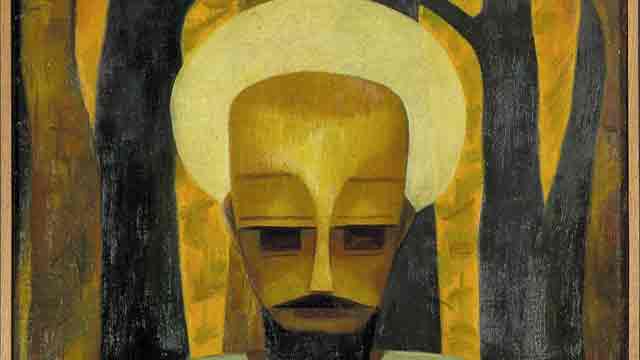
-
 Osuanyi Quaicoo Essel
Osuanyi Quaicoo EsselThe seated human-like figure is centrally placed with the head occupying almost the centre of the entire composition while the hands rest gently on the laps. The head and the face of the human figure is rendered in planes and cubistic orientation, a style reminiscent in precolonial African wooden sculptures. Hands of the figure received similar cubistic treatment with less details as in realistic depiction. Interestingly, there is a deliberate subtle emphasis on the head size of the figure. In African sculptural renditions, the human head is considered as seat of wisdom and, therefore, presented bigger to defile the realistic canonic proportions and connote its Afrocentric symbolic essence. This concept of head re(presentation) is termed as African proportions (Amenuke et al, 1991).
To create a harmonious contrast of colour and shape, tints of yellow forms an arc-shaped design around the head. This treatment possibly suggests a halo effect characteristic of saintly figural paintings in Western art traditions. It also mimics a turbaned human figure. As an artist who hailed from a predominately Muslim community, this stylistic treatment, perhaps, pays tribute to his religious cultural background. The eyes are presented with dark brown rectangular dabs, with the forehead gently highlighted with bright yellows, a treatment that puts the human figure in a meditative mood and sanctimonious character. Though Uche Okeke presented the work in a portrait orientation, the skilful placement of the human figure, and the peculiar colouration of the head regions creates a triangular effect when imaginary diagonal lines are projected from the bottom corners of the composition to the halo-shaped found on the head. Similarly, the haloed effect on the head and the elongated pharaonic beard creates an imaginary inverted triangle resonating a visual excitement.
Symbolically, yellow depicts riches and royalty in African colour scheme. With this schematic colouration, Okeke gave a clue to the kingly characteristics of the human figure. The white looking garment of the figure also adds to the sanctimonious conjecture of the figure as in African colour symbolism. The artist’s use of luminous chromatic reflection of the tint of yellow and dark shades helped in achieving the sense of depth in the garment. Complementing the overall kingly posture of the human figure is its elongated pharaonic beard and bodily language as found in sculptures of ancient Egyptian kings.
Okeke skilfully deceived viewers of this composition into believing that it is symmetrical per its stylistic tendency, yet an intense observation reveals a psychedelic mutation of the placement of the fingers, padding of the background with tree-shaped figures in rich application of tints and shades of black, yellow and brown to create contrast of colours and shapes. Placement of the trees in colour variations and the sprouting of the branches forms a psychedelic cross and contribute to breaking monotony. The patchy effects of the intense yellow forming the negative spaces adds to creating a perceptual believability that the human figure wears a contemplative mood per the facial looks. There seem to be gentle highlights of the yellow from the shoulders to the halo-shaped object.
Per the compositional portrayal, Okeke showed a kingly and majestic posture of, perhaps, the Christian religious icon in Africanised bodily posture and cultural praxis. This compositional contextualisation feeds into his personal manifesto that he did not subscribe to borrowing Western artistic accent hook, line and sinker. Neither was he comfortable with resorting his Nigerian indigenous artistic traditions without modification. He emphasised in his manifesto that it is ‘… futile copying our old art heritages, for they stand for our old order. Culture lives by change. Today's social problems are different from yesterday's, and we shall be doing grave disservice to Africa and mankind by living in our fathers' achievements’ (Okeke, n.d). For that reason, he appropriated western artistic accents and fused them with Afrocentric artistic concepts and perspectives to achieve a hybrid artistic language which is not purely African nor Western, but yet circumvent the boundaries of artistic cultural traditions in general. The fusion lends itself to exploring the familiar and the unfamiliar to create a renewed breed of art. He called this effect ‘natural synthesis’. Emanating from Nigerian non-conformist artist group named Zaria Rebels, Okeke sought to reinterpret the Western artistic style of realistic depiction, perspectival detailing, accurate proportions and tonal gradation he was exposed to by the Eurocentric-inspired faculty in the so-called formal education setup in art in Ahmadu Bello University, Zaria. As part of the pioneering post-independence artists in Nigeria, Uche Okeke was experimenting for a renewed artistic accent for his creations through the assessment of his Nigerian cultural values and the new artistic training he had been exposed to in order to arrive at the boundary of these two traditions.
Using this painting in teaching and learning in the context of collective memory could inspire relevant competencies in the learners. Gathering inspiration from the artistic pursuit of Okeke, learners could fuse multiple artistic traditions of the artworld to arrive at their individualised artistic accents. Teachers could engage learners in this manner by asking them to borrow and appropriate a foreign artistic style and fuse it with their nationalistic art making techniques to develop a new breed of art or concept. Teachers could also discuss with learners about the fact that gathering artistic inspiration is multicultural with no boundaries. Furnishing learners with links to the biographical account of the artist for them to understand his cultural nuances remains key in the process. It would also be beneficial to guide learners to explore with their own interpretation of the artwork (figure 1). Teachers could also provide learners with printed copy of the painting and ask them to redraw this religious-centred figure to suit their own religious understanding and cultures. This approach addresses the competencies of critical thinking and problem solving; creativity and innovation; cultural identity and global citizenship; and personal development.
References- Amenuke, S. K., Dogbe, B. K., Asare, S. K., Ayiku, F. D. & Bafoe, A. General knowledge in Art for
- senior secondary schools. Evans Brothers Limited.
- Okeke, U. (n.d.). Natural synthesis. final okeke natural synthesis manifesto 1960.doc (live.com)
 Mahmoud Malik Saako
Mahmoud Malik SaakoThe image is presented in a form of a male figure in a seated position with long beard, white turban, white robe, long sleeves and a probably waist band. The painting represents fairly the complexion of a male, black bearded and wearing a face mask, with hands resting on the laps possibly in a meditation mood. The Background is probably a wooded environment or garden with tall trees of two colours (black and yellow). The figure seated probably on a staircase or an amphitheater. The sun ray penetrating through the tree created shaded patches reflected on the image.
An Islamic perspective: I base my interpretation of the painting on Islamic perspective as one of the foreign region that had an early contact in northern Nigeria as early as 15th century long before Christianity and eventual colonization of Nigeria by European power (the British) and its possible independence in the 1960. The emir is mostly male usually dressed with a white robe, long sleeves and a white turban tied around his head to signify his authority. The painting perhaps represents an Emir of the Zaria state at that time sitting in a garden relaxing.
Using an African mask: The use of an African mask to represent the figure was done deliberately or perhaps to avoid revolution from the Muslim community of disrespecting their leader which the author was much familiar in this volatile society especially, the intolerance nature between Muslims and Christians at this era in the Zaria state. The mask as a tradition signature that ubiquitous across many cultures that can be used to represent the religious discourses by appropriating and manipulating them to produce art forms of the past to produce a mythology for the present.
Lessons
- The image portrays the power of the emir in the Zaria state with a possibly palace and vineyard or gardens where he retires to relax. The seat or staircase/amphitheatre is constructed within the park for relaxation.
- It also shows the importance of trees because the natural air and shade provided. It reflects the symbiotic relationship between man and the natural environment or biosphere.
- The long beard is a reflection of the age of the figure, combined with the white turban tied around the head which is a symbol of power and authority of the emir within the context of an Islamic state. Again, the white long robe coupled with black beard and the white turban is a reflection of the dress code of the emir within the states dominated by Muslims. The waist band (blue sea colour) is used to tie the robe for easy movement.
- The facial representation of the figure doesn’t conform with normal human head based on the eyes, nose and mouth. It is probably a mask of an Egyptian pharaoh to imbibe the spirit of the Pharaoh as a kingly figure that wielded much power. A story that is synonymous in both Islam and Christian doctrines except the West Africa Indigenous Religions that do ascribe this myth. The use of the mask also simmer the tension of using identifiable imagery that would have rise tension in this probably consecutive Muslim state. The use of masks within the Africa context show the spiritual powers embedded in them that the wearer or user is mostly possessed and transfigured a situation that can only be explained by adherences to that particular belief system.
- The black and yellow tall trees depict the diverse nature of the ecosystem and the symbiotic relationship mostly exhibited in the environment. This shows the complex nature of the human society with diverse cultural and different colours complexion that need a person with wisdom and patience to rule, like the emir who assumes the position of an Egyptian Pharaoh.
- Uche Okeke, was a revolutionary artist who tried to break away from normal art presentation handed to Africa by the white colonial powers. This diversion was to Africanize the art industry in West Africa and Africa at large. This where Okeke decided to use the Pharaoh mask from Egypt that was considered even among Europeans of the cradle of human civilization in the world.
 Ernst Wagner
Ernst WagnerI argue in the following text from a special position. Firstly, I was present in Bayreuth on 26.4.2022 when the two co-authors, Osuanyi Quaicoo Essel and Mahmoud Malik Saako, discussed the painting in a larger circle. The representatives of the Iwalewa House clearly expressed their doubts about the (traditional) title of the painting "Christ".[1] Perhaps this brought the question of who was depicted in the painting, Christ or another person, to the fore. This question also shapes my discussion of the painting presented here. It became the guiding theme behind which other topics disappeared, such as the question of the painting's function (what was it created for?), its biography (how did it come to Bayreuth?) the role of oil painting (is it a European import), the context of the debates on modern art during the independence movements in Africa (does the painting belong to a global modernism after the Second World War or does it mark a Nigerian path? [2]) - to name just a few.
My own interpretation is therefore less an independent approach to the work than a response to the positions presented with the intention of building bridges between the approaches by introducing a meta-level. Whether this is convincing, whether the bridge is sustainable, is for the reader to decide. But more on that below.
Traps through aesthetic stereotypes that lead to false classifications / interpretations
And a second preliminary remark: I didn't like this picture at the beginning. It reminded me too much of the religious pictures of the 1950/60s of my childhood. They were popular for death pictures back then: A mixture of a bit of Pre-Raphaelite and icon-inspired imagery, soaked in the formal world of a moderate and esoterically inclined modernism (Franz Marc). The intention was easy to see through: To somehow keep alive that which, in my view, was no longer contemporary at all, and to do so through a bland, unconvincing and even less convincing adaptation (a kind of "modern facing"). This is also why, when I saw the picture hanging at the entrance to the Iwalewa House from the corner of my eye, I immediately saw a Christ.
Iconography - inclusion of other perspectives

Detail
In the discussion mentioned at the beginning, the intervention of Mahmoud Malik Saako was really surprising for me - against the background of this perception, which was shaped by my own stereotypes. The halo (which I saw - see detail) was a turban (which Malik saw). But I could not counter his view. There was no argument for the interpretation as a halo. This is also true now when I read Malik's text (like Osuanyi's). So I first had to recognise my stereotype in perception, which had lured me onto a perhaps (?) wrong track, I had to get rid of this, unlearn something, in order to be able to open up to the other perspective.
Why I - retrospectively - still speak of "perhaps wrong", a research on Okeke's work has confirmed as meaningful. After all, there are obviously works in his oeuvre that iconographically quite certainly represent Christ or St Mary, as an internet search reveals (see fig. below). The auction house Bonhams (Abb.1) states - even if for 1963, two years after our work: "in 1963 ... the Passion of Christ was a recurring theme for the artist. He had produced the stained-glass designs of the Fourteen Stations of the Cross in Munich earlier in the year." (www.bonhams.com/auctions/25800/lot/28 accessed 14 Sept 2024)
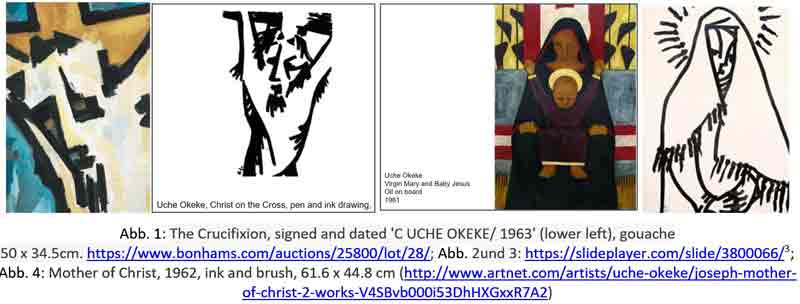
Christian motifs in Uche Okeke's Ouevre between 1962 and 1963 found by the author on the internet (May 22, 2022)
Perhaps this is why the discussion about whether Christ or a Muslim is depicted makes me feel uneasy. In my mind, the question is connected with the attributions or depreciations: To whom / which faith does the work of art belong? Does it belong to the Christians, the Muslims, or the traditional believers in northern Nigeria, if, as Philipp Schramm or Mahmoud Malik Saako suggest, one also discovers a traditional wooden mask?
New approach and reflection on its anchoring
Hence my attempt to think of the painting in a different way, i.e. not from the artist's point of view and what he or she wanted to represent. In doing so, it is clear to me that I am taking a specifically Western approach to a modernist work (where I now place Okeke's painting) with my new approach. This approach is based on the loss of a binding iconography and a fundamental openness / never-quite-unambiguity of 'autonomous' works of art for a Western-oriented, middle-class audience. In addition, my proposal for interpretation is based on a specific position in the interpretation of images, from production theory to reception theory (in the context of constructivist epistemology). The loss of a binding iconography is accompanied by a greater significance of form (which is now itself charged with content to compensate for the loss). In a next step, I therefore try to examine the image - beyond a positioning in the question of whether it is an "Islamic" or a "Christian image" or a "traditional image" - form-analytically.
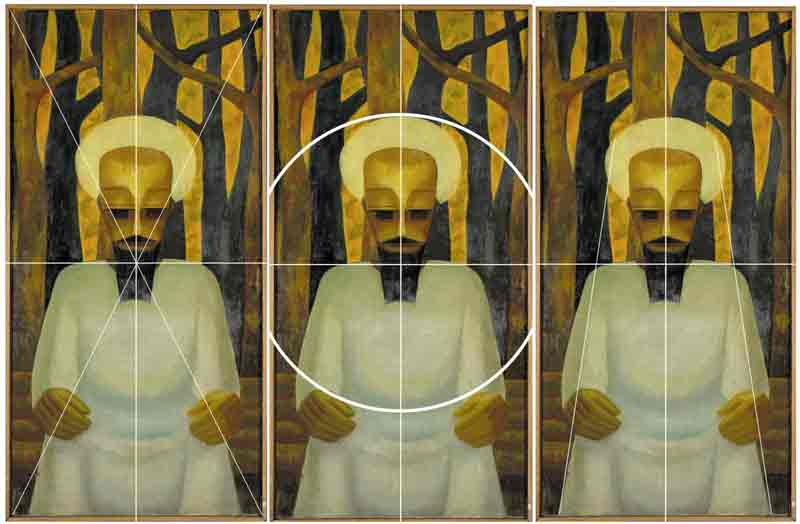
Analytical composition with auxiliary lines. (c) the author
Form analysis
The dominant, almost penetrating axial symmetry in a very high longitudinal format speaks of high order; the pyramidal structure of the figure also speaks of calm and stability, indeed of sublimity and dignity, of quiet, immovable power. And this dignity is not fed by external insignia or theatrical staging, but by a calm that radiates from within. It is a picture in front of which one can become calm if one trusts the order as a viewer.
The striking human figure contributes to this effect. Although clearly figurative, it does not represent - to the degree of abstraction - a concrete portrait or a human being that can be grasped by the senses. This is most obvious in the geometricised eye area, which is shaded in various dark zones. This makes the gaze ambiguous: is the figure looking at the viewer, is it looking forward, is it looking inwards (contemplatively, with closed eyes)? Together with the geometric rhythm of the picture's surface (the symmetry, but of course above all the parallels that can denote eyelid, tear sac, eyebrow - or not) support the depiction of a human being in an abstracted ideal form that remains open to itself, as in a mask. The latter is also characterised by the fact that the viewer immediately sees what has been made, what has been assembled, as in the case of the moustache, for example.
The figure sits quite classically in front of a middle and a background: at the bottom the zone (again - between two-dimensional and spatial effect - strongly abstracted) is divided into horizontal stripes, which become slightly narrower towards the top. They again suggest something familiar (a wooden bench), but this remains ambiguous. In the upper zones, the tree trunks (without leaves) form the liveliest, least symmetrical, most restless element in the painting, even if the alternation of light and dark again shows the abstracting hand of the artist.
With this spatial layering in clear zones (background, trees, seat, figure), but also the geometric reduction of the forms, the picture looks like a carved relief. The colouring also fits in with this, for example when the "sky" behind the trees as well as the lighter trees have the same colouring as the face, while the beard, eyes and the dark trees form a second colour zone. The lightest zones are formed by the robe and the shape around the head. Despite the large spectrum in the area of light-dark contrast, the picture does not appear colourful, rather like a natural wood relief. An effect that is again particularly evident in one detail: the way the hands are shaped is reminiscent of hands carved out of a piece of wood.
This character is supported by the way Okeke uses oil painting. He clearly outlines the contours of the surfaces. The objects are each assigned a main colour, applied impasto with broad brushstrokes. The modelling creates plasticity, lightly set with internal structures enliven the colour surfaces.
Conclusion
The degree of abstraction, the modelling construction of the figurative out of a colourfulness, the strict symmetry of the composition, the tectonics of the pictorial space unfold a tableau that nevertheless - and this is now decisive - creates zones of ambiguity in the figurative. The viewer must fill these with his or her own ideas. The viewer's gaze is directed towards the picture, but the eyes do not look back. In this respect, the painting is suitable for contemplation, meditation, spiritual experience. In seeing the painting, one's own can come to rest. And so the distinction between the Christian halo, the Muslim turban and the ritual mask can also come to rest in the contemplation of the painting.
This consideration is based on an 'ideal viewer' of the work, i.e. it is reception-aesthetically oriented. If one finally turns it once again to production aesthetics, one could interpret the work as an attempt by the artist in which it experimentally unfolds what a spirituality beyond the distinction traditional - Christian - Muslim could look like.
Footnotes
[1] Philipp Schramm's position becomes clear in his text (https://www.bayfink.uni-bayreuth.de/de/Sommerausstellung-2021_-Not-yet/audio-not-yet---welcome/index.html).
[2] Perrin Lathrop, "Uche Okeke," in Smarthistory, August 9, 2015, accessed May 21, 2022, https://smarthistory.org/uche-okeke/.
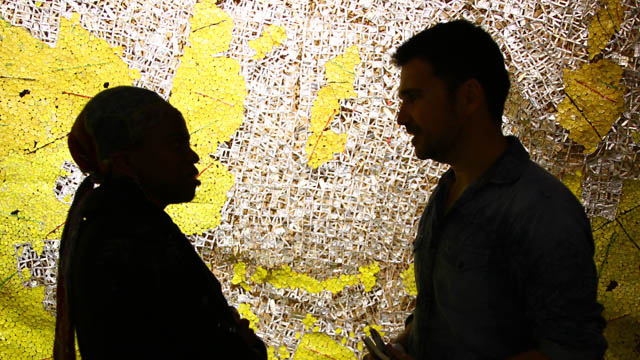
-
 Natalie Göltenboth
Natalie GöltenbothSir David Adjaye puts his hands on the ochre-coloured earth walls of the pavilion while speaking into the microphone: “We have brought that earth here. This is West Africa, this is Ghanaian soil that was applied by Venetian plasterers." 1
Sir David Adjaye, the renowned British architect with Ghanaian roots, based the design of the Ghana Pavilion on the traditional earth buildings of the Gurunsi from Eastern Ghana. The organically merging ochre room sequences evoke a rural Ghana in which the works of the six artists are presented. All of them have Ghanaian roots, but some live and work in England. In an interview, he describes his understanding of architecture as follows: “Art and Architecture create powerful narratives about our lives. Architecture is a story, it’s a way of marking and talking about our aspirations and hopes. So, in what I do, the methodology to every project I make, is to find a narrative [...].”2
This raises the question of the possible interpretations of the pavilion. Out of a multitude of possible architectural quotations and structures that could represent Ghana, it is rural Ghana that was chosen as the structure and backdrop for the artworks. But it is precisely the Gurunsi and their country that were worn down by the European colonial powers in the course of the conquest of West Africa and were finally divided in two at the end of the 19th century by their geographical affiliation to the French and British administrative districts. In this respect, a connection can be drawn to the all-encompassing motto of the exhibition – dealing with the colonial period that ends with the final cry of triumph “Ghana Freedom”.
In addition to this critical, post-colonial discourse, the pavilion also invites an interpretation in which “Africa” is staged as an earthy, dark and rural-tribal space: as much as you feel comfortable inside, the bright light makes you blink when you step out. The odour design by Ibrahim Mahama from the first honeycomb of the pavilion offers a further sensory component to this impression.
While the conscious use of white cube gallery spaces was a struggle for contemporaneity and belonging to the global art discourse,3 Adjaye has decided on a placemaking, in which “Ghanaian identity” is presented as an imaginary picture of origin and authenticity or a rural cut-out reality. In addition, the multiple experiences of London-based artists, such as Akomfrah and Yiadom Boakye, are, thus, transferred back to their native Ghanaian earthworks.
This raises the question of how much of Ghana’s aesthetic construction is to be seen as a concession to the expectations that the global art world places on the artists of African countries. Just as Edward Said has described this for the Orient4, it remains to be examined whether an imagined “Africa” has not just been created in the global art world, whose multiple requirements put artists from the African continent under pressure to master the balancing act between postmodern, conceptual approaches and African side-specificity or even ethnicity in the form of an aesthetic Africa-specific local flavour. Here in the national pavilion of Ghana, the artists are released from this pressure insofar as the pavilion already provides the aesthetic headline or frame which harmonises all the works exhibited there under the imaginary of Ghana/Africa.
While experiencing the pavilion, it becomes clear how difficult it might be for artists from an African country and its diaspora to position themselves within the global art discourse without falling into one of the numerous traps that lurk there, starting with the simplest chain of associations of clichéd fantasies. Close your eyes for a moment and tell me how you imagine the national pavilion of a West African country: earth, elephants, desert, migrants, sunsets, recycling art and a strong smell of spoiled fish?
That the expectancy of local flavour can also be handled quite differently becomes evident if we consider a young generation of Cuban artists, such as Alejandro Campins, who ask provocatively: “Cuban art, what’s that?”5
Expectations can also be met with confrontation in other respects. As a response to the demand for the adjustment to concepts of art influenced by Europe and North America, the artist collective Atis Rezistans from Haiti launched their own biennial with the programmatic title: "What happens when first world art rubs up against third world art? Does it bleed?"6 With this idea of a clash of art cultures, they are more radical in asserting their own (bloody) concept of art. However, this kind of confrontation is not for everyone. (Link)
Enwezor sums up these expectations clearly when he says that artists of African origin, whose contemporaneity he appreciates, must, in any case, comply “to be deeply located within conceptual and postmodernist matrices”.7 As understandable as this may seem from the perspective of Euro-American contemporary art concepts, it is, nevertheless, clear that it is precisely these “matrices” mentioned by Enwezor that exclude other ways of making and understanding art. That they are able to do so is due to their position of power.
The social anthropologist Thomas Fillitz speaks of the contemporary global art world as a world culture, ultimately a global transnational culture, only to conclude that “this global art world continues to be determined by the discourses of Occidental art history and its affiliated ordering systems of classification”.8 We should ask to what extent the concept of art is one of the last (so far only weakly attacked) bastions of an Eurocentric view of the definition of contemporary art and, thus, a kind of colonial survival. The increasing networking of individual art worlds does not necessarily bring about an equal reciprocal exchange.
In this respect, the Venice Biennale could be understood as the palace of this concept of art – a place where its “Urmeter” (standard) of the art is measured and conveyed in a constantly redefined way by mostly European-North American curators and art theorists.
Now the question is how exactly at this place, the Venice Biennale, as a classical place of westernness and whiteness in Ghana’s National Pavilion (even if it comes along in the manner of the buildings of the Gurunsi corrupted by the colonial system), can a confrontation with Ghana’s colonial past succeed, which in the end would have to be continued as a confrontation with existing power structures. But this does not seem to be the intention. It is too much of a joy to finally get the desired recognition from exactly this system and yet, there remains the stale taste of a paternalistic hierarchy in which Ghana is proud to finally present itself to the art world represented in Venice.
Nevertheless, the debut of the Ghana Pavilion is still a real success story, especially when one considers the representation of other African countries at the Biennale di Venezia. Only four countries of the African continent were represented with a national pavilion in the main exhibitions at the 58th Biennial, the others had to be sought out in sometimes often arduous exploratory walks in the urban area. This shows that participation and the positioning at the Biennial is linked to the political structures in the country, with contacts to European decision makers with financial resources but also with clear goals.
From the outset, Ghana’s national pavilion had a clearly defined mission, which, in turn, is inextricably linked to the nation state and its representation. Taiye Selasi9 in his article “Who is afraid of a National Pavilion?”, after critically reviewing the structure of the Venice Biennial, asks: “Is there any good reason […] to exhibit theses six wildly different artists as Ghanaian?” “Yes there is”, we hear the tourism manager Barbara Oteng Gyasi, the curator Nana Oforiatta Ayim, the Ghanaian Ministry of Tourism Art and Culture and the architect David Adjaye calling. They are all working together on the script of a “bigger book” – the positioning of Ghana on the global stage as one of the African countries that can promote itself with its art and culture,10 in short, as a country to be proud of. And so we are not claiming too much when we state that one of the greatest successes of the Ghana Pavilion at this year's Venice Biennale was that it became a place of pride and identification for its many visitors with African decent.
 Sergio Linhares, student at the Department of Social and Cultural Anthropology, LMU Munich while conducting research on the perception of the Ghana Pavillon at the Venice Biennale, June 2019. Foto: Natalie Göltenboth
Sergio Linhares, student at the Department of Social and Cultural Anthropology, LMU Munich while conducting research on the perception of the Ghana Pavillon at the Venice Biennale, June 2019. Foto: Natalie GöltenbothFootnotes
1 Sir David Adjaye in an Interview with Al Jazeera Journalist Charlie Angela (www.youtube.com/watch?v=6PM5e8NhGFk)
2 Sir David Adjaye – Building Transformative Narratives www.thehourglass.com/video/david-adjaye/
3 “For Kafou: Haiti, Art and Vodou, the gallery walls remain white and the art works are evenly spaced and lit – as is customary in exhibitions of modern and contemporary art. By sticking to type we sought to minimize the distance between Kafou and more mainstream contemporary art, hoping to create the conditions for fresh encounters between the two” (Farquharson 2013: 10).
4 See Edward Said, Deconstruction of Orientalism.
5 Alejandro Campins in an interview with Natalie Göltenboth in Havana 2018, stressed that he doesn’t want to be seen as a Cuban artist, but as a contemporary artist.
6 Leah Gordon. 2017. Ghetto Biennale – Geto Byenal 2009-2015. Port au Prince. See also: www.ghettobiennale.org
7 Enwezor 1998: 34
8 Flillitz 2007: 116
9 Selasi 2019:40
10 See Nana Oforiatta Ayim’s statement during the opening of the Ghana Pavilion www.youtube.com/watch?v=6PM5e8NhGFk
References
- D. Building Transformative Narratives.
- Retreived 15.10.2020 https://www.thehourglass.com/video/david-adjaye/
- C. (2019). Ghana makes Pavilion debut at 2019 Venice Biennale Art Show. Al Jazeera. Retreived 22.7.2020 from: https://www.youtube.com/watch?v=6PM5e8NhGFk
- Enwezor, O. (1998). Between Localism and Wordliness. Art Journal. Vol 57, No 4. Liminalities: Discussions on the Global and the Local. Pp 32-36.
- Farquharson, A. (Ed.). (2013). Kafou – At the Crossroads. IN: Kafou. Hait, Art and Vodou, pp 8-19. Nottingham Contemporary (catalogue).
- Flillitz, T. (2007). Contemporary Art in Africa. Coevalness in the Global World. IN: Hans Belting and Andrea Buddensieg (Eds.) The Gobal Art World. Audiences, Markets and Museums. Ostfildern. Hatje Cantz. Pp 116-134
- Gordon,L. (2017). Ghetto Biennale – Geto Byenal 2009-2015. (catalogue). No Eraser Publishing
- Said, E. (1978/2003). Orientalism. New York: Penguin Books
- Selasi, T. (2019). Who is afraid of a National Pavilion? IN: Ayim. N.O. (Ed.) Ghana Freedom: Ghana Pavilion at the 58th Biennale di Venezia 2019 (catalogue). Koenig Books. Pp:38-43.
published November 2020
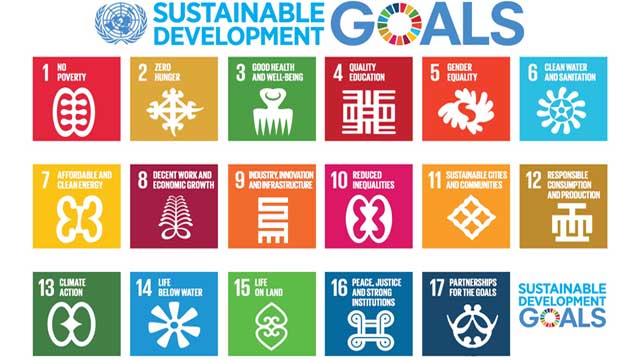
-
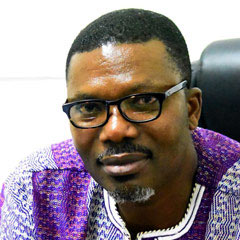 Patrique deGraft-Yankson
Patrique deGraft-YanksonWe may be right to assume that the level of awareness just at a little over four years of its implementation should not be too alarming. However, analyzing such low level of SDGs awareness among a people a country whose president is a Co-Chair of the Eminent Group of Sustainable Development Goals Advocates in Africa leaves some cause to worry.
The good news however is that, not being directly aware of the SDGs in the way they have been blueprinted does not mean the people are insensitive to its calls and claims. The fact is that, most of the demands of the SDGs are already embedded in the culture and belief systems of the people, and I consider this as an important resource to deploy for awareness creation and enthusiastic implementation of the SDGs.
For the realization of UNs commitment to leave no one behind in the mobilization of the citizens of the world to achieve the 2030 agenda (UN, 2020) therefore, I am of the belief that efforts at linking the relevance of the 17 goals to cultural manifestations of the people should be highly considered. The image shown above is a demonstration of how various traditional symbols speaks to the SDGs in a language which is understood by the traditional Ghanaian. These symbols transcend language barriers and their meanings are inherent within their traditional belief systems, making the goals both physically and spiritually relevant to people.
The meanings of the symbols are as follows:
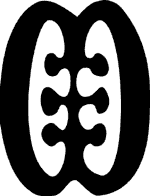
Ese Ne Tekrema (The teeth and the tongue)
Symbol of generosity towards one another. Through the formation of a linear relationship in diversity towards a common goal, both the personal and societal needs of the people will be realized.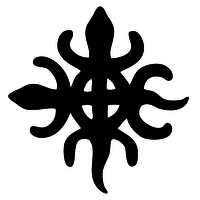
Funtumfunafu Denkyemfunafu (Siamese/conjoined crocodiles)
Symbol of brotherly feeling, caring and sharing. The society stays stronger when people coexist in the belief that we all smile and grow together when we feed and enjoy the good things in life together.
Dua Afe (Wooden comb)
Symbol of sanitation, cleanliness and beauty. This symbol reechoes the essence of physical and spiritual wellbeing through personal and environmental cleanliness.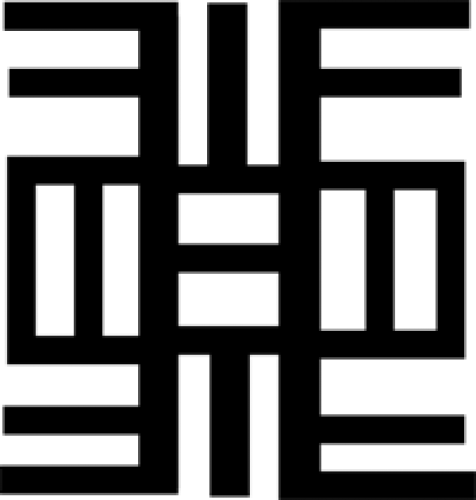
Nea Onnim No Sua a, Ohu (Anyone who does not know is capable of ‘knowing’ through education)
Symbol of educational opportunities. This symbol plays down ignorance by reminding people of their inert capabilities to get educated to any level of their preference. In other words, opportunities for quality education exist for all.
Obi Nka Bi (No one bites the other)
Symbol of equal regard, recognition and treatment for all. No one bites the other as a value ensures that all genders and age groupings have equal rights for existence in the society which allow them to listen and be listened.
Sesa Wo Suban (Change your life)
Symbol of deterrence and admonition towards all unapproved societal behaviors that affect the natural environment. This symbol represents strong advocacy for transformation and dynamic life patterns that affect nature. One of the unacceptable life patterns this symbol is currently addressing is the Ghanaian youth’s preference for wealth through illegal mining which destroys precious water bodies
Pempasie (Sew in readiness)
Symbol of production and sustainability. This symbol emphasizes the importance of societal preparedness and readiness for the future through effective production and management of all resources for posterity.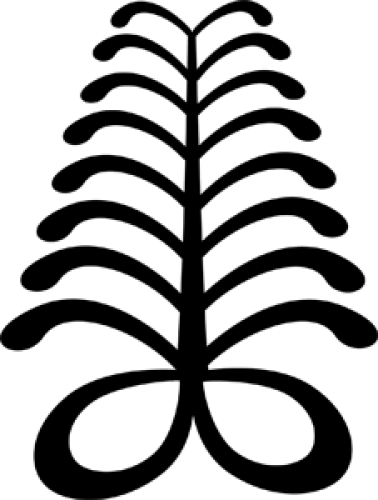
Aya (Fern)
Symbol of resourcefulness through resilience, self-reliance, hard work and judicious engagement of the environment and its resources.

Nkyimkyim (Twisting)
Symbol of collective action towards the building of the human society through initiative, dynamism, versatility, innovation and resilience. Indeed, building a successful society, like life itself, is not a smooth journey. The journey of life is tortuous and it requires a great amount of innovation and creativity to sail through.
Nkonsonkonson (Chain)
A symbol of unity. This symbol, depicting two links in a chain, advocates for the need to heal the componentized society since in unity lies strength.
Eban (Fence)
A symbol of love, safety and security. The fence symbolically secures and protects the family from unhealthy activities outside of it.
Hwehwe Mu Dua (Measuring stick)
Symbol of examination and Self/Quality Control. This symbol emphasizes the need for circumspection in all human endeavors. It directs attention to self and quality control in everything including production and consumption. It admonishes against over consumption, over production and all forms of egoistic instincts and behaviors which adversely affect the general good of the society.

Nyame Biribi Wo Soro (God resides in the heavens)
Symbol of reverence to the heavens, the abode of the Supreme Being. Recognition to the ‘heavens’, or the skies as the residence of the supreme being is tied to the belief that all good things come from the heavens – rains, sunshine, fresh air, etc. The ‘heavens’ need to be respected for continuous flow of life-given goodies.
Ananse Ntentan (Spider’s Web)
Symbol of knowledge and wisdom about the complexities of life. This symbol alludes to the intricate personality of Ananse, the spider, a well-known character in Ghanaian/African folktales. In Ananse’s world, all facets of life need to be somehow manipulated, positively or negatively, for good or bad reasons. This sometimes led him to dire situation. Ananse therefore is a character for admonitions and reprimanding. Being conscious about the character of Ananse guides your steps against any unfair treatment to the world around you, be it the skies, on the land, in the waters or below the waters.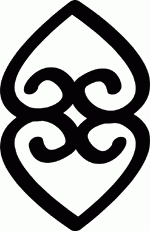
Asase Ye Duru (The Earth/Land is heavy)
Symbol for reverence and recognition to the providence and the divinity of the ‘Earth/Land’ and everything associated with it. The ‘Earth’ is the mother to everything. It carries the entire humanity, trees, water bodies, the sea (and what is in it and beneath it), big and small animals, etc. This why it is described as ‘heavy’. Respect/reverence to the Land is respect/reverence to life.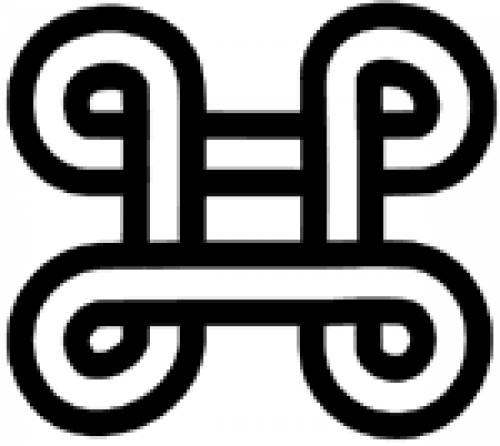
Mpatapo (Knot of Pacification/Reconciliation)
Symbol of bonding and adjudicatory factor which brings back parties in a dispute to a peaceful, harmonious and reconciliatory coexistence to ensure unified and strong societies and institutions.
Ti Koro Nko Agyina (One Head does not forma Council)
Symbol for partnership, collaboration and teamwork. This symbol emphasizes the importance of cooperation and collective efforts in the realization of all goals. Obviously, the attainment of the SDGs is a collective responsibility. No one nation (one head) can make it happen. It takes the concerted efforts of the entire citizenship of the world.Bibliography
- Adinkra Brand, A. (2020, November 15). African adinkra symbols and meanings. Retrieved from Adinkra Brand: https://www.adinkrabrand.com/blog/african-adinkra-symbols-and-meanings/
- Kasahorow Adinkra Library, K. A. (2020, November 15). Adinkra symbols and meanings. Retrieved from Kasahorow Adinkra Library: https://www.adinkrasymbols.org/symbols/nkyinkyim/
- United Nations, U. (2020, December 7). Sustainable Development. Retrieved from Uited Nations: https://www.un.org/sustainabledevelopment/development-agenda-retired/
published January 2021
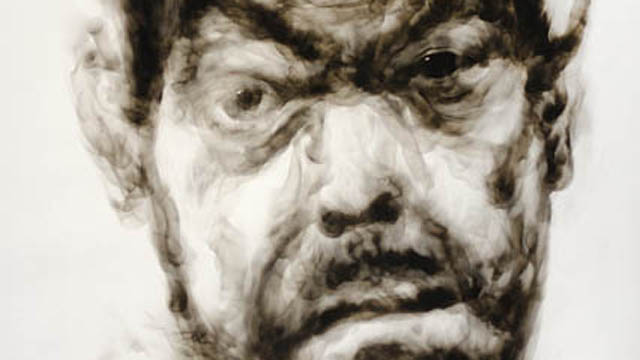
-
 Elfriede Dreyer
Elfriede DreyerThe Richtersveld National Park in South Africa has some of the most beautiful and hardy vegetation in the world. The 'botterboom' ('butter tree') (Tylecodon paniculatus) is but one example hereof. According to Wikipedia (RICHTERSVELD 2008), "The plant appears to have wide tolerance of growing habitats, growing in weathered rock in the north to coastal sands in the south. The plants can reach heights of 2 m making them the largest of the tylecodons. Tylecodon paniculatus is summer deciduous. The plants conserve energy by photosynthesizing through their 'greenish stems' during the hot dry summer months. The yellowish green, papery bark is a very attractive feature of this plant and has given rise to the common name. During the winter, plants are covered with long, obovate, succulent leaves clustered around the apex of the growing tip. [...] In nature the plants tend to grow in groups, making a spectacular show when they flower. [...] The shrub is reported to have a surprisingly weak and shallow root system for its size." This plant is representative of many other African succulents and bulbous plants that have shallow root systems and can therefore easily adjust to desert and other harsh environmental conditions. They change their leaves into thorns and the surface to protect the plant against the loss of water.
The metaphor of the succulent is of particular interest to an engagement with nomadic identity in the context of a continent such as Africa that has been subjected to "wicked, messy problems". Being similarly exposed to a severe environment, African people have accustomed themselves to survive in difficult circumstances and to a large extent have become nomadic as a result. In many cases they have adopted itinerant lifestyles and form groups for protection, safety and cultural coherence. Living on a vast continent, they are accustomed to long journeys; however, poverty, violence, civil wars, colonial and other imperial infiltrations and oppression have resulted in a focused nomadic condition where people are constantly moving and travelling in the search for a better life and even survival. Aligning contemporary culture with nomadism, Polish sociologist and philosopher Zygmunt Bauman (1996) appropriates the stereotype of the pilgrim who is on a teleological journey - ordered, determined and predictable - but cannot come to rest and leave a footprint in the sand. They operate through a 'shallow root system'.
Bulbous succulent plants are essentially botanical rhizomes, a concept that inspired the notion of the rhizome as a philosophical concept, initially developed by Gilles Deleuze (philosopher) and Felix Guattari (psychotherapist) in their Capitalism and schizophrenia (1972 -- 1980) project. Deleuze and Guattari (1987:7) state that the "rhizome itself assumes many diverse forms, from ramified surface extension in all directions to concretion in bulbs and tubers". In "A thousand plateaus" (1987 [1980]) they introduce the concept of the rhizome as follows (assigned to cultural patterning):
1. Principle of connection: any point of a rhizome can be connected to any other
2. Principle of heterogeneity: any point of a rhizome can be connected to any other
3. Principle of multiplicity
4. Principle of a signifying rupture: a rhizome may be broken, but it will start up again on one of its old lines, or on new lines
5. Principle of cartography and
6: Principle of decalcomania: a rhizome is not amenable to any structural or generative model; it is a map and not a tracing.
Deleuze and Guattari's model allows for a cultural view that entertains non-stable relationships, subjectivity, relationalism, multiplicity and volatile positions. Similarly, Italian contemporary philosopher and feminist theoretician Rosi Braidotti (2011:3) views the nomadic predicament and its multiple contradictions have come to age in the third millennium after years of debate on the "'nonunitary' - split, in process, knotted, rhizomatic, transitional, nomadic - so that fragmentation, complexity and multiplicity have become everyday terms in critical theory." Since the 1990s Braidotti has been engaged with the question as to what the political and ethical conditions of nomadic subjectivity are, grounded in a "politically invested cartography of the present condition of mobility in a globalized world" (Braidotti 2011:4).
South Africa has experienced turbulent histories over the last two centuries and nomadic movement was brought on by volatile colonial, postcolonial and global upheavals, leading to political and social displacement and consequently hybrid identities. Having been a British as well as a Dutch colony, South Africa has since 1652 shown cultural patterns of movement in and out of the country, and from place to place. During apartheid non-whites or 'people of colour' were viewed as not belonging and were removed from the city; forcibly established in townships outside the city; only allowed as workers into the city; and had to carry passbooks (identity documents) on them all the time. For many decades now, in postapartheid South Africa, migrants from all over the continent have been flocking to the country in search of a better life and even survival, and they mostly live in temporary shelters. Many other sociological and cultural problems have emanated as a result of the migrant issue, based on subjective racism, xenophobia, crime and fear for the other.
Identity (and subjectivity) in the African modernist context is neither stable nor fixed, and the corporeality of the artist-as body and the artwork-as-process in this specific part of the world henceforth has produced liminalities in many ways. Often rooted in a rural or small-town environment, African artists generally tend to move to multicultural, cosmopolitan cities where gallery and industry networks are in closer proximity. Those in the rural remote parts of Africa make it their business to connect through digital and social media in order to stay connected, current and noticed.
The art of South African artist Diane Victor provides an eminent example of nomadic identity depiction. The artist utilises various ephemeral media in her work, such as ash, crushed charcoal and staining. In Perpetrator 1, 2008, a so-called smoke portrait, she has used the deposits of carbon from candle smoke on white paper to draw with. The work is exceedingly fragile and can be easily damaged, disintegrating with physical contact as the carbon soot is dislodged from the paper, and in this way speaks about the fragility, precariousness and insubstantiality of a nomadic human condition. Although the smoke portraits started with a series on AIDS victims in 2003, Victor continued to depict various other individuals, commenting on ephemeral politics and ideas, and life generally as a temporal entity. In this work she depicts a perpetrator with reference to the previous South African apartheid dispensation and the atrocities of its perpetrators, but also to counter racism and the violence committed in the name of political redress. The Perpetrator's race is indeterminate, but his gender is certain, as well as the cruelty of his dispensation. Severed from the body, the Perpetrator's head becomes a rhizome that is not 'rooted' in a body, but uprooted, derooted, and floating with tubular arteries as corms hanging from it like a beheaded monster.
As an ephemeral, nomadic image, Perpetrator 1 speaks about a decolonial condition that presents the ambivalent Baumanian idea of the pilgrim-tourist who keeps going in circles, driven by an ideological sense of survival. Nomadic identity is essentially rhizomatic, and in Africa, as in many other parts of the world, the drive to belong and the utopian quest for a better life have resulted in identity being redefined, renegotiated, rerooted and sprouting in many directions.
References
- Bauman, Z. ‘From pilgrim to tourist – or a short history of identity’. In Hall, S and Du Gay, P (eds). 1996. Questions of cultural identity. London/New Delhi/Thousand Oaks: SAGE.
- Braidotti, R. 2011. Nomadic subjects: embodiment and sexual difference in contemporary feminist theory. Second edition. Gender and culture: A series of Columbia University Press. New York: University of Columbia Press.
- Deleuze, G. & Guattari, F. 1976. Rhizome: Introduction. Paris: Éditions de Minuit. [based on Gilles Deleuze and Félix Guattari’s Capitalism and schizophrenia project (1972 - 1980)].
- Deleuze, G. & Guattari, F. 1987 [1980, French original]. A thousand plateaus: capitalism and schizophrenia. Translated by Brian Massumi. London: Athlone Press.
- RICHTERSVELD NATIONAL PARK - VEGETATION: BOTTERBOOM (Tylecodon paniculatus). 2008.Available: https://www.richtersveldnationalpark.com/vegetation_botterboom.html (Accessed 3 January 2019).
published April 2020
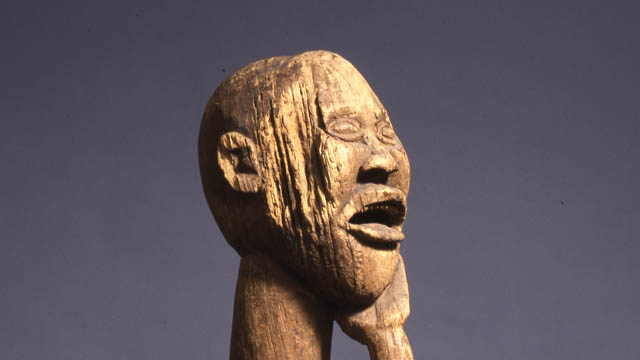
-
 Joseph Essuman
Joseph EssumanChoosing this object stemmed from my experience I had when my mother passed away in my arms. It was a painful reminder of mum's death when I saw the facial expression of the object. The question was; ‘So after all the painful moments she went through, she could not stay a little longer for me to pamper her before she died’? I therefore want this to be part of the project so that the world would appreciate responsible mothers and motherhood no matter the circumstance.
To be a mother marks female social completion in Africa especially among Ghanaians where motherhood is a pride. Without it, one is not quite an adult, or certainly not an adult who receives full respect. Images of this nature, especially in most communities of Ghana are very significant because of the belief systems of the indigenous people before conversion to Christianity or Islam. Though not so common today as a result of modernization and or Christian and Muslim religion as compared to a decade or two ago, it is still believed that, regardless of the changes in time and technology, these beliefs are still as revered as it used to be.
This work is a wood carving in the round portraying a standing, heavily-pregnant woman with her left hand on the chin; but laid on the left breast with the right-hand providing support beneath her belly. The legs are bent at the knees and she has a painful facial expression.
It is a semi-abstract form of work that is 161cm high which stands firmly on a pedestal. The pose of the figure gives an idea of life and death. The opened wide mouth indicates the pain she must be going through and the hand beneath the belly indicates a support for the weighing pregnancy and support for the unborn child.
The concept behind this piece of work depicts strain and stress most women go through before giving birth and it symbolizes fertility and good health. The elongated breasts suggest the vulnerable state of the woman though it has lots of breast milk to feed the unborn child.
This carved image is a representation of a pregnant woman which signifies life. This figure could be interpreted to represent several ideas in different cultures. However, Costa (2019) opined that, a wooden figure of a nude pregnant woman, which has been present at events, is not the Virgin Mary, but a female figure representing life.
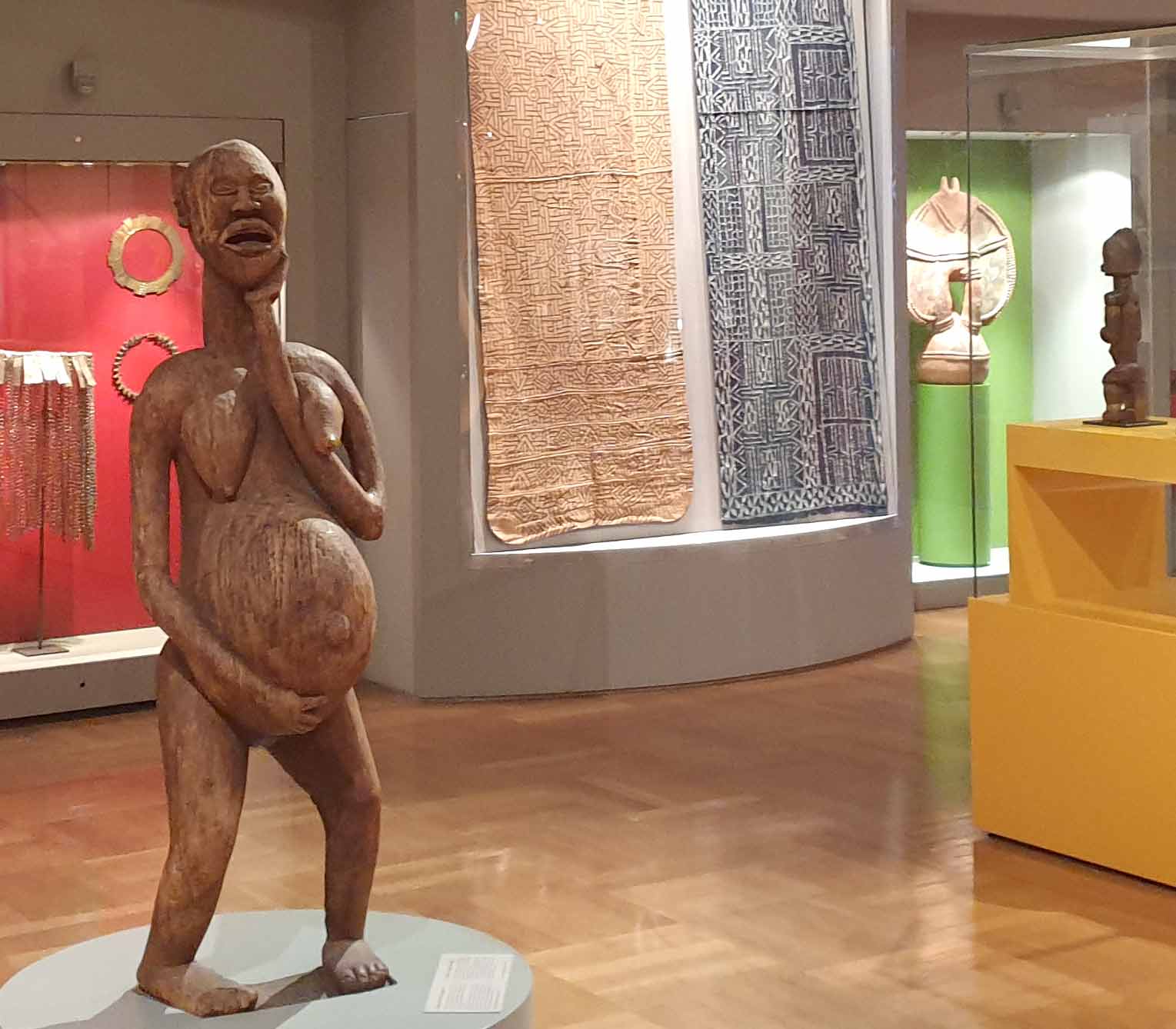
Anonymous artist, first half of the 20th century, wood, 161 cm, Bamileke, Cameroon (Photo Ernst Wagner)
In a similar narration, Costa (2019) said that, a wooden figure of a pregnant woman has been described as both a Marian image and as a traditional indigenous religious symbol of the goddess Pachamama, or Mother Earth. Costa maintained that it is an indigenous woman who represents life; it is a feminine figure and is neither pagan nor sacred but represents life through a woman.
Fundamentally, many indigenous Ghanaians believe that women are like trees that produce and reproduce to sustain life continuity. The woman is also believed to be a fertility goddess. It is with high esteem therefore that Ghanaian women who are capable of giving birth are exalted. As a result, these images or similar ones have been used to ‘serve’, particularly in the Akan and Ewe dominated communities in Ghana. They are seen as religious figures, an expression of health, fertility and grandmother goddesses, and they have over the years served as ritual or symbolic function.
Without children one cannot have a traditional funeral nor become an ancestor. While these issues relate to men as well as women, infertile men can acquire children through cooperative wives who ensure they become pregnant. Unfortunately, per the traditions of Ghana, women do not have that option. In practical terms, wives who are childless may be divorced or have to accept a co-wife. They have no support in their old age, if their husbands die, because that is the duty of children. In extreme cases, they are sometimes ejected from the husband’s house no matter their economic or social status and endure the pity or mockery of family members, friends, and acquaintances.
In most communities in Ghana, it is believed that babies born after a longed-for conception often bear names that reflect their mothers’ anxiety. For example, ‘Brenya’, which literally means “suffer and get” is such a name from the Akan people of Ghana. Also, ‘Nukomeko’, which literally means “I just laugh” is one of the names from the Anlo-Ewe of southern Ghana. These names are among many examples that reflect joy, triumph and satisfaction in a successful delivery after the pain of barrenness. Other names pointedly refer to previous distress and are meant as retorts to those who might have tried to block their pregnancy or had made fun of them. Examples are; ‘Dzitorwoko’, literally means “Only those who have the heart”, Azunukpenawo “It will be shame unto them”, or Nyavedzi “Matter that grieve the heart”. There are other unpleasant names that parents give their children as a mockery in return for what they suffered from either family, and/ or for child mortality. This has been buttressed by Agyekum, when he says that,
“the Akans, like other cultures in West Africa, believe that if a mother suffers constant child mortality, then the reason is that it is the child’s mother in the underworld that does not want the child to stay in the living world. To combat such an unfortunate situation, the parents give the child a weird name (2020: 221).”
For instance, a name such as ‘Asaaseasa’ which literally means ‘the land is finished’ is one of the many names that is used to combat such a situation. This suggests how important pregnancy and childbirth are revered in most communities in Ghana.
So, in the olden days in Ghana, just like in many parts of Africa, girls have received doll-like figures to care for – not as playthings when they are children, but as teenagers preparing for marriage. This sometimes occurs during initiation practices, when their attentiveness may be assessed. In the meantime, the girl would be detached from her family and allowed to stay alone in a small structure. The doll serves as her sole companion, and she “feeds” it, washes and oils it, decorates it with seed beads at neck or hips, and otherwise tends it like the infant she hopes to bear. Most of these dolls are made of females, as their breasts and genitals indicate. The reason being that, female children are especially desirable in order to increase the size of the matrilineage despite the desire that fathers always want their names to remain as a memorial for generations yet to come.
In direct reference to the subject under review, it is suggested that the woman is undergoing some form of pain. But as to whether it is a labour pain, abdominal pain, or crumps, could be a subject of debate depending on individual’s discretion.
It is good that technology has improved greatly over the years and there is a complete education on pregnancy as I try to analyze this piece of artwork. It is therefore necessary to note that these forms of education are very essential and there is no doubt that it will remain useful and also see tremendous improvement with time. Most of these challenges are normal occurrences during adulthood as stated earlier. It is in sharp contrast to what is used to be the case among other people across the globe where such issues are most often associated to evil spirit attacks hence creating fear in prospective mothers and a potential threat to motherhood.
It is relevant to note that womanhood is an undisputable way to ensure life’s continuous existence. In that regard, one can conclude that this artwork is tangible, contextually realistic (though physically semi-abstract) and precise to address the question of whether it communicates, represents or symbolizes the argument in the text. The world today and future will find its educational and cultural relevance as outlined in the context above. It is also appropriate to conclude that the interpretation of the meaning of the object was based not only in the belief systems of Ghanaian communities but transcultural significance and sensitivity to cultural aspects with regards to tolerance and respect as subjects of consideration.
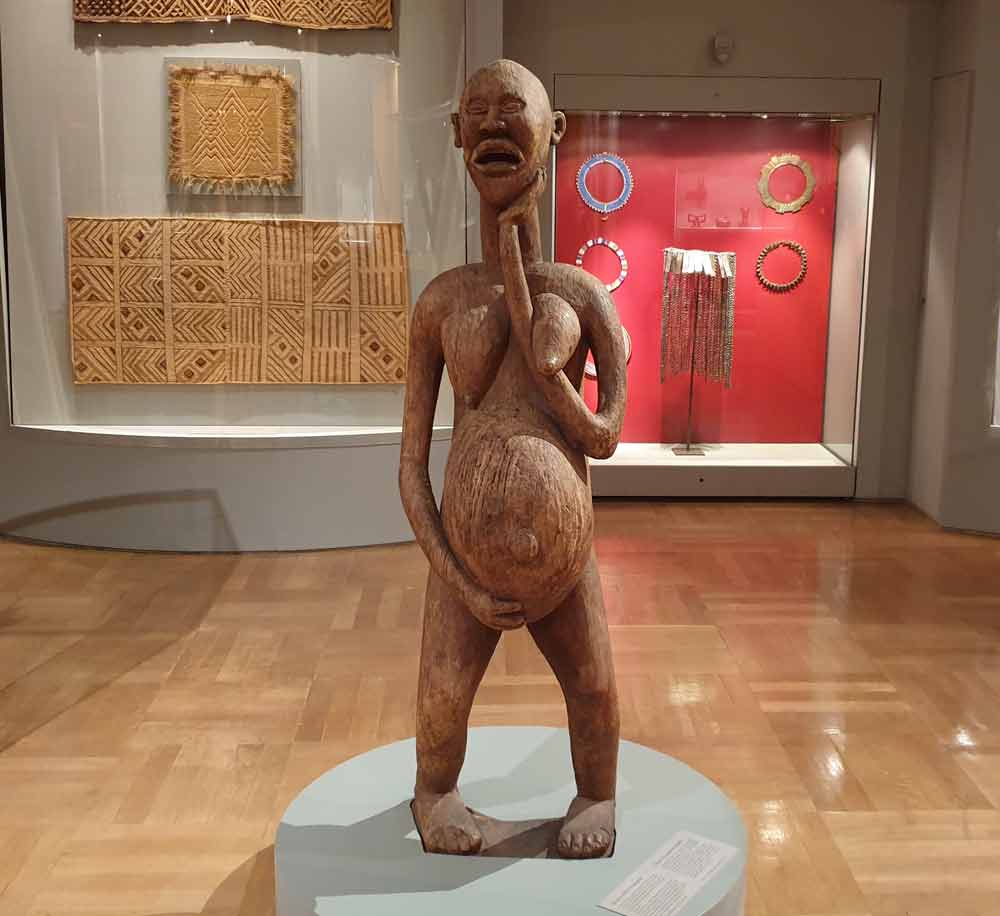
Anonymous artist, first half of the 20th century, wood, 161 cm, Bamileke, Cameroon (Photo Ernst Wagner)
References
- Costa, G. (2019). A communications official for the Amazon synod: https://www.catholicnewsagency.com/news/amazon-synod-final-report-an-instrument-communications-official-says-36081. Retrieved On the 19th March, 2020.
- Agyekum, K. (2006) The Sociolinguistic of Akan Personal Name: http://www.njas.helsinki.fi/pdf-files/vol15num2/agyekum.pdf. Retrieved On the 19th March, 2020.
This article is part of a gallery: Perspectives from Ghana on Museum Objects in Germany, published January 2021
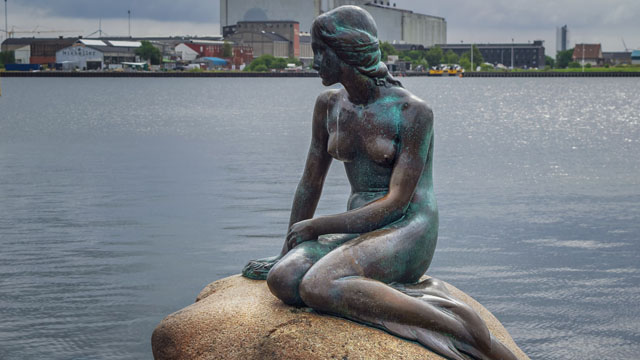
-
 Bea Lundt
Bea LundtA helplessly wretched female figure: The “Little Mermaid” in Copenhagen
Well known worldwide is the monument of the „Little Mermaid“ in Copenhagen. The figure is called a “national symbol” for Denmark and a “landmark” for Northern Europe. The bronze sculpture of 125 cm height was constructed by Edward Eriksen in 1913. It shows a naked young woman, her feet like the tail of a fish. The intention of the sculptor was to honour and remember Hans-Christian Andersen (1805-1875), the Danish author of the story „Den lille Havfrue“ (The little mermaid). The place which had been chosen for erecting the monument is a rock in the water near the open sea; the figure turns her face to the shore of the Danish capital Copenhagen.
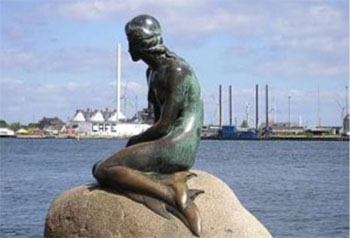
"Little mermaid" by Edward Eriksen 1913, 125 cm, Copenhagen harbour,
https://dreamguides.edreams.de/daenemark/kopenhagen/die-kleine-meerjungfrauWith this installation the country accentuates its identity of being involved in the element water and its representation in literature and culture. The famous piece of art transports different messages and reactions, has its own life and a specific history.
The narrative behind this figure, a fairy-tale for children, is well-known in Europe: A young mermaid wants to get into contact with a prince she loves. But he never recognizes her and marries a noble woman. The mermaid dissolves to foam, which flows back in the ocean. But also she is transformed to stay as a ghost in the air, where she can be part of earthly life and earn an immortal soul.
As a being of the nature the mermaid is part of the “other” of civilization and as subordinated to human and especially masculine beings. The title marks her to be “little”, not having a name and individuality. She did not receive any respect and interest, not even for her female beauty. By this ignorance she is killed, with no traces of her life. The story shows the most helplessly wretched female figure in literature we can imagine.
Within a memory-culture the monument might help a region of seafarers to feel superior over the sea and the beings involved with this element. Denmark was a colonial power. From overseas came goods and wealth on trading-ships. People from West Africa were deported as slaves to the Danish colonies Carribean Islands, where they had to grow sugarcane. The Molasses, the essence of this plant, was brought to Northern Europe, where Rum was made from it, the central product which made towns very prosperous. In visualizing a sentimental mythical story from the period Biedermeier the monument helps to divert from this context or even to suppress it. But the symbolic meaning might also be an accusation against (male) neglection of the nature and a warning for girls to hope to win the dream prince. It also can be seen as a protest against monarchy, aristocratic lifestyle and the glorified royal history of the country.
Performance and public reactions
Many tourists visit the monument every day and there are activities and actions around it. It stimulates the wish of giving the mermaid the attention she did not get in the story, as a symbolic compensation. There are also anonymous acts of aggression and destruction against the statue (see examples). Feminist groups protest against the offer of a voyeuristic view on a naked woman in this exposed location, this is also done by conservative circles in a prudish mentality. The statue also provoked campaigns of environmentalists who added her slogans demanding protection of other creatures being under control of human power like the whales for example.
An independent queen in Premodern Times: Melusine
The fairytale of Andersen is a modern adaptation of older stories and there are lots of distinctions within the development of this symbolic figure. Very common throughout several European languages is a narration about a female figure with the name Melusine, which is derived from the french word “mere” (mother) of the Lusignans, an influencial family, living in France and in Cyprus, from where the legend might have reached Africa. In the shape of a woman she marries a nobleman and rules over the country, building it up in an innovative way. When her husband discovers her in the bathroom being half a dragon, she flies away. In the official belief she is said to be a dangerous demon with no soul, destroying Christian families. But in aristocratic traditions the mermaid is understood as the ancestress of their gender and put in their heraldry. In illustrations in books she is depicted as a courtly lady with half the body of a fish, standing in a basin; the destructive element of water being abolished. She is not a victim, but the active part in the plot; when she leaves, her big family suffers and the country loses its strong ruler with her outstanding creativity.
The twofold character of Melusine represents very well the beginnings of noble families: Polygamic life was common, and when the institution of the Christian marriage was imposed, one of the spouses of a ruler needed to be sent away. The element water might hint at the origin of the mistress from a village near the river outside the castle, which is on top of a hill. In popular narrations she was given an aura of mystery, having the body of a dangerous monster.
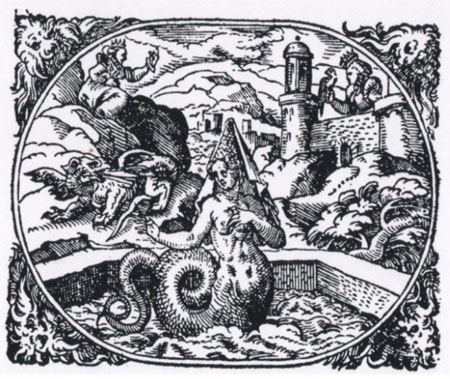
Melusine. The mermaid as a court lady and the ancestress of noble families (woodcut and illustration of a manuscript 15th century), Thüring von Ringoltingen: “Melusine”. In der Fassung des Buchs der Liebe (1587), hg. Hans-Gert Roloff, Reclam Verlag Stuttgart1991, S. 3.
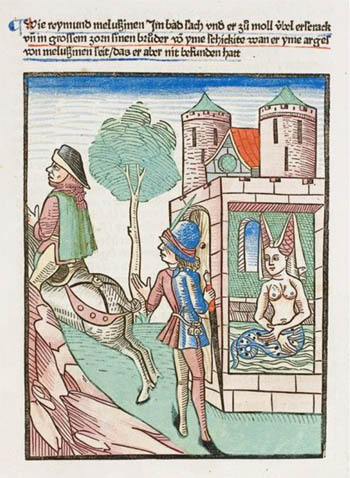
She is discovered having half a fish-body (book illustration 15th century), Thüring von Ringoltingen: „Melusine“ First printing Basel: Richel, around 1473/74. digit. ULB Darmstadt urn:nbn:de:tuda-tudigit-35087
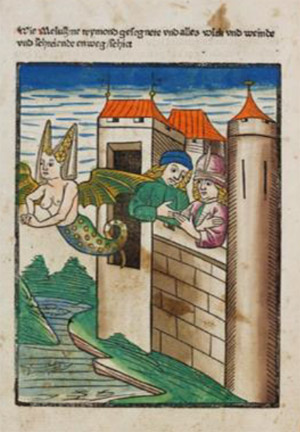
She flies away (book illustration), from "der Seelen Wurzgarten“. St. Peter pap. 23, Coburg bei Schwäbisch Hall 1467 (digitized by the ‘Badische Landesbibliothek Karlsruhe’, 65v.)
The modern tale of a beauty killing her lover: Undine
With the name “Undine” (lat. “unda”: wave) in Romanticism the mermaid-figure develops vampiric qualities, killing her lover by a kiss when he marries another woman.
This motif inspired many paintings. They channel phantasies and visions about the chances and problems of a partnership between persons from different origin and about death as the consequence of an unsuccessful encounter. How can strange-looking persons, which come from or over the sea, be integrated?
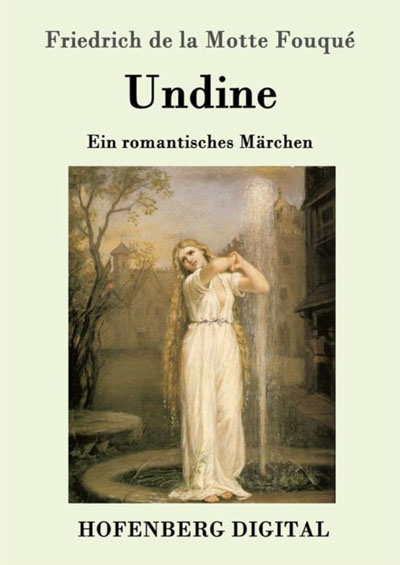
Friedrich de la Motte Fouqué (1777 – 1843), novel, 1814, published by Karl-Maria Guth. Berlin 2015, Painting by John William Waterhouse 1872.
Conclusion
Premodern times reflect the mermaid mainly as bringing fertility from nature to mankind, hoping to gain a soul through marriage with a human being. There are systematic changes to this story during modernity, which might result from the background of colonialism as absorption and subjugation of everything different and “strange”. Men are longing for its attractiviness, but also fearing that this inclusion of a natural being might cause protest and fury. The European tradition can be said to be a parable about migration and exchange between different worlds, the mermaid being a symbol-figure for the futile attempt of colonizing the other.
The task of a transcultural comparison: Mami Wata
In Ghana I learned about Mami Wata, a traditional African figure, the patron of fishermen. In Quidah (Benin) I saw her as a goddess of the python, the holy snake. She has her own shrine where specifically educated priests pay tribute to her to keep her merciful. The name is interpreted to be a pidgin-version of „Mother of the water“. Scholars from Europe assumed that Melusine was carried on ships' bows in the 15. century from Europe to the West-African coast, where her narrative interlaced with local narrations with their own long tradition of water-goddesses. But: It might also be the other way round, from West-Africa to Europe, probably on the trade-roads through the Sahara. There, the legend emerged much earlier and arrived in Europe as early as the 12th century, when the mermaid-stories began to gain popularity. How is a figure transformed when it is transferred to a region with such different history and traditions?
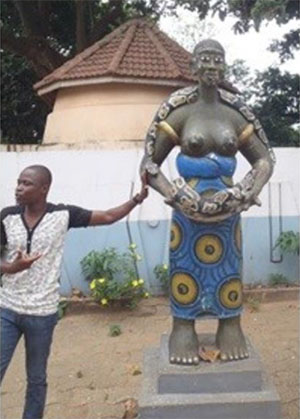
Temple of the Python, “Holy Forest”, Quidah (Benin) 2015 Foto: Nina Paarmann
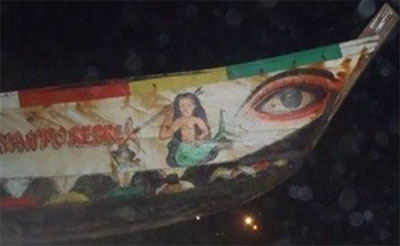
Fishing boat in Winneba (Ghana) 2012, Foto: Nina Paarmann
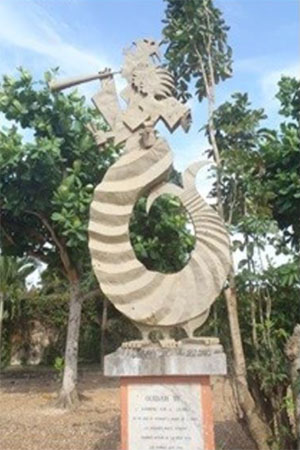
Quidah (Benin) 2015: “Slave Road”, Text: “memorial for the ‘tree of forgetting’ which had to be orbited, nine times by the male and seven times by the female slaves”, Foto: Nina Paarmann
References
- Hans-Christian Andersen: „Den lille havfrue“ (The little Mermaid) fairytale, in: Sämtliche Märchen 1-2, München 1974 (hg. Nielsen, E.).
- Bea Lundt: Melusine und Merlin im Mittelalter. Modelle und Entwürfe weiblicher Existenz im Beziehungsdiskurs der Geschlechter. Ein Beitrag zur Historischen Erzählforschung. (Diss. 1990), Fink-Verlag München 1991.
- Bea Lundt: Wassergeister als universales Motiv. Paracelsus’ Deutung der Nymphengestalt und die Figur Mami Wata in Afrika. In: Nova Acta Paracelsica. Beiträge zur Paracelsus-Forschung (NF 28). Hg. Pia Holenstein Weidmann. Bern u.a. 2018, S. 9-40
Edited by Kelly Thompson.
published February 2020
 Esther Kibuka-Sebitosi
Esther Kibuka-SebitosiMermaids at the East African coast
The Mermaid in Copenhagen reminded me of the stories I heard when I visited the coastal town of Mombasa, East African coast in Kenya. This was back in the University days when I accompanied my friend Salome to visit her mother in Mombasa. We travelled by bus all the way from Kampala through Nairobi to Mombasa, a long journey of over 24 hrs. We landed at “Mwembe Tayari” Kiswahili translation “ripe mangoes”- this market is a vibrant place with all sorts of mangoes to eat. It was a market of all diverse cultures: Arabic, Swahili, Bantu and the main language was Kiswahili- a mixture of Arabic and Local Bantu languages. The myths, stories and folklore are all mixed taking origins from Arabic and African descent.
Back to the Mermaid stories, once upon a time, a man went to have a drink at one of the Mombasa bars. He drank and went home with a woman. Before they slept, the mermaid wangled her fins to switch off the lights. He ran out of the house and told the whole town up to Malindi, a faraway town.
Mermaids are both a mystery and envy because they are told to be very beautiful women who come, seduce men, and then disappear in the night. Another story was that the mermaids were “Genie” or ghosts, which are really demons of the sea. When my Pastor friend, the late Lule went to preach the gospel in Mombasa, he had to cast out many. He told me that one night he slept only to be woken up a mermaid to command him to go and leave town. He just prayed in the name of Jesus and she left without a trace in a closed door. He said, when you see one, you need to do some spiritual warfare; use the Name of Jesus and the Blood of Jesus as weapons of mass destruction.
Stories of mermaids are varied but when told by a Swahili woman; you need to sleep over, as they never end. You need to have some “mandazi” (sweet like a doughnut) and African Tea with Masala (spices) as you listen to these rich African tales. Will keep you posted when I visit again.
References
- http://blog.swaliafrica.com/mami-wata-the-mermaids-in-african-mythology/2/
- Dona Fish, Angola, ca. 1950
published February 2020
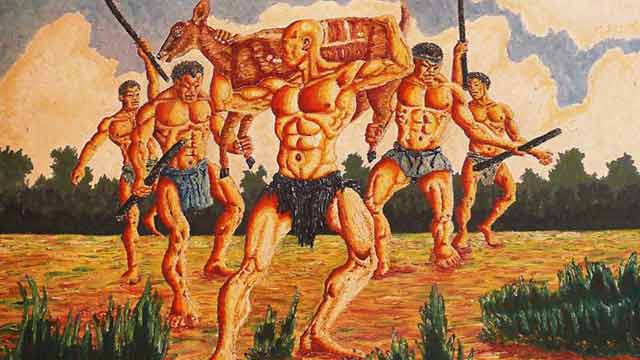
-
 Emmanuel Aklasu
Emmanuel AklasuOwusu-Ankomah’s painting at first glance reveals a foreshortening company of energetic warriors, muscular framed with broad shoulders, muscled chest, and a narrow waist in a chiselled physique. The hunters were portrayed with huge hands, clenched fist, knuckles, strong legs visibly revealing biceps brachiis and dabs of varicose veins on the arms, thighs and legs evident of powerful and efficacious men. Before modern society, the average male spent most of their time hunting, protecting, and engaging in physical activities that increased their muscle mass and maximize their muscular proportions. Owusu-Ankomah’s production exhibits masculine competitiveness and a sense of adventure – the brave team were a-fire with passion, armed with sticks in a leopard-like graceful movement as the captain leads carrying a captured antelope shoulder high.
The warriors are noticeably naked with only a string of grass costume wrapped around the private parts which is the formal and ceremonial attire for the ancient culture. Owusu-Ankomah’s choice of colour in rendering the human figures lends credence to the fact that colours have a strong position in identifying humans while hunting. Wearing hunter orange is the best way to ensure other hunters see you and don’t accidentally mistake you for game in complex backgrounds that are often green or brown. The artwork reveals harmonizing brown colours which tend to create a central focal point in the entire picture frame to evoke earthiness, emotions, security and safety related to the natural world. The tints and shades of hues enhanced the main features in the painting to vividly communicate the intended message as well as create an illusion of depth.
A thick flora forms the background of the painting evident that the hunting expedition was carried out in a thick forest. As the fearless, able-bodied men advance through shrubs in high spirit of mission accomplished, an earthly scent swirled around them coupled with a sense of eagerness to meet a welcoming, expectant and jubilant community. Hunting is an extremely important mode of human-nature interaction closely linked to culture patterns and value systems. This engagement with wild animals is thought of as part of a deeper unity with nature, which means being part of nature in physical sense (Lowassa et al., 2012). Sustainable hunting prescribes taking as much as needed and as much as the habitat and the population can regenerate. Suffice to say, when hunting for a game form the basis of a year-long survival of a people, it calls for a deeper reflection. Owusu-Ankomah’s painting comes on the back of an ancient heritage of a distinct tribe in Sub-Saharan Africa.
‘Aboakyir’ translated ‘deer hunt’ is a festival uniquely celebrated by the Effutu (Simpa) people of Winneba in the Central Region, southern coast of Ghana, West Africa. The festival which is celebrated annually on the first Saturday in May has the historical antecedent of the replacement of a human sacrifice to a tribal god with a leopard – an alternative which resulted in the loss of many more lives than the sacrifice of a single slave. Consultations with the deity for a more humane alternative resulted in the “Wansan” (the deer) as a practicable and most acceptable substitute. The capture of a live deer, like the leopard, required many more hands than the members of the royal family could find. The additional hands required were solicited from the local militia as a service to ‘the stool – a symbol of chieftaincy, royalty, custom and tradition’. It was this change in form; that is, the involvement of the local militia, that the annual consecration and appeasement of the deity became a public, state-wide affair. This marked the birth and hence the origin of the “Aboakyer” festival.
The design of the Effutu State emblem tells this story; the ‘stool’ on which the King is installed sits on the “Wansan” (the deer).
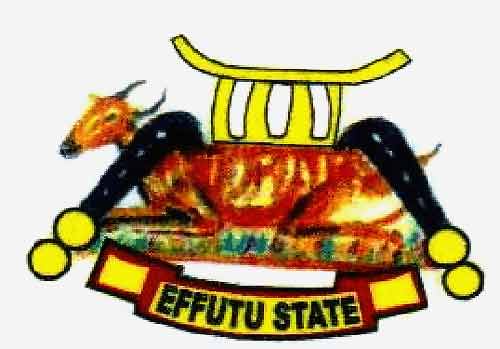
Emblem of the Effutu state (Source: Palace of Oma Odefe)
The festival is therefore important for the ‘stool’, its occupant and the entire royal stool family. It is a religious duty and an obligation for the general citizenry to ensure its celebration annually is sustained to honour the ancestors and protect their historic culture for posterity on the back of removing evil and predicting a good harvest for a prosperous life in the coming year. The week-long activity begins with two traditional warrior groups known as the ‘Asafo’ companies consult their shrines for clearance, protection and early catch. The warrior groups clad in distinct costumes with distinct musical instruments — the ‘Tuafo' and ‘Dentsefo’, move to their respective hunting grounds at dawn on Saturday, wielding sticks and clubs amid chanting of war songs. No weapons, other than clubs and sticks are used to catch the deer, as it must be brought back alive.
By far, the relevance of Owusu-Ankomah’s painting is not in doubt as it fosters a deeper understanding of the historical and societal roles of hunting within Ghanaian communities. The painting holds both cultural and educational significance which sparks discussions on conservation, sustainable practices, and the preservation of cultural heritage. Consequently, bridging the gap between present generations and the rich tapestry of cultural and environmental history. The sight of the painting in Ghana’s National Museum serves as a poignant reflection of the nation’s cultural heritage and connection to nature. In this visual narrative, the core of historical period of a distinct society is unearthed.
References
- Lowassa, A., Tadie, D. & Fischer, A. (2012). On the role of women in bushmeat hunting – Insights from Tanzania and Ethiopia. Journal of Rural Studies 28(4):622–630.
Further Reading
- Anane-Frimpong, D. (2022). Aboakyir: Deer hunt festival. Link Retrieved on April 10, 2023
- Rubiano, W. (2017). Planting trees for the aboakyer festival 2017. Link
Published March 2024
 Barbara Lutz-Sterzenbach
Barbara Lutz-SterzenbachAn energetic scene. Five men in a flat landscape approach the viewer. Their bodies are naked - except for their loincloths - their faces grim. Muscles in the bright light stand out under the skin, their chests bulge voluminously - they are timeless heroes. The men do not look at the viewer of the picture. With their long, dark sticks firmly in their strong hands, they gather symmetrically around the bald man in the foreground. He presents himself with an antelope in his raised arms. His bald skull points to the left, as does the antelope's head.
On closer inspection, some things are irritating. Are the men dancing or walking? Where is the animal spatially located? Somehow it is on the shoulder of the man, but the legs are captured by the men behind, who would be much too far away for that. Is an event, an episode (as in a photograph) depicted? Or does the symmetry of the composition speak more of a constructed symbol, a sign, as in an emblem? The latter would support the strict division into horizontal planes: with the islands of grass in the foreground, the flat, ochre-coloured plane in the middle ground and the forest with sky in the background. But then again many design principles undermine this order: the tense, energetic movements of the figures, the strong brushstrokes, the irregular shapes of the white clouds and the tufts of grass, the dynamic accents of the sticks.
We know from our Ghanaian colleagues that what is depicted here, the catching of the animal, is part of a ritual celebration and a festival (the Aboakyer Festival). Here the moment is shown when the men have stepped out of the dark, hermetically sealed forest in the background with their prey and now present themselves in the bright light with their success. A comparison with the results of an image search on the internet for “Aboakyer festival” (Fig. 2) shows that this is the iconic moment. Here the idea of the festival seems to be condensed. And this also explains the emphasis on muscles: the hunters must be well trained to match the animal's speed and strength.
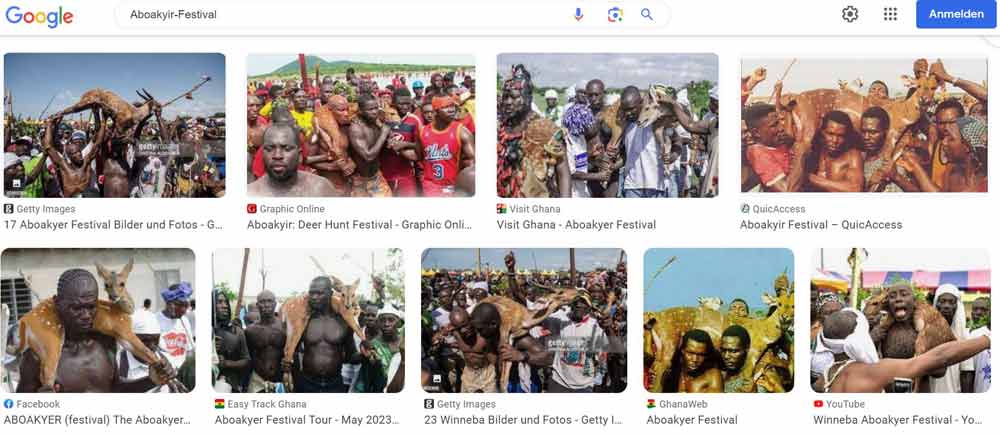
Fig. 2 (Google search for "Aboakyer Festival" on 9.9.2023 - the first page of results) Screenshot: Ernst Wagner
Owuso-Ankomah's painting focuses on the men with the animal. At first glance, the painting shows above all the strength of the men. The space thus becomes the backdrop for their performance. Their bodies are not only idealised but theatrically exaggerated, their muscles as if illuminated by a spotlight. The geometric centre of the picture, through which the horizon also passes, brings the loincloth of the leader into focus (see fig. 3) - perhaps an allusion to male potency?
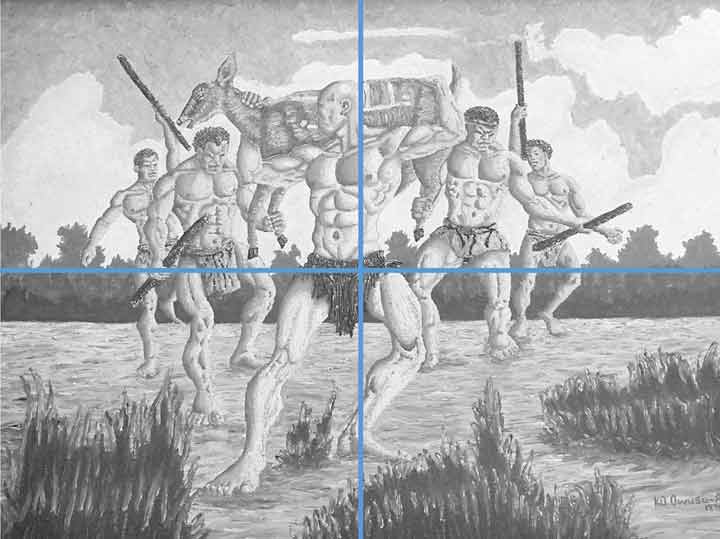
Fig. 3: Composition sketch (horizon and geometric centre) Photo: Ernst Wagner
A comparison with photos on the same theme from the Heritage Centre in Winneba (see Fig. 4-6) shows clear differences to the depiction in Owusu-Ankomah's painting. In the artwork, both animal and hunter have their mouths open, exhaustion is evident in both. In this way, too, man, animal and landscape are connected - despite hunting and death. The artist uses the warm ochre tones in such a way that the earth, the human body and the animal hardly differ in colour. Since the animal is still alive, its head does not have to be held. Thus, visually, it seems to elude a depiction of "being trapped", also due to the ambiguous spatiality described above. It could almost just as easily be understood as a triumphant appearance of the animal, to which the men are subordinate as bearers and assistant figures - comparable, for example, to Jan van Eyck's depiction of the lamb (see fig. 7), which also marks a mediating position between victim and victor, between human beings and God.

Fig. 4-6: Photos from the Heritage Centre Winneba Photos: Ernst Wagner
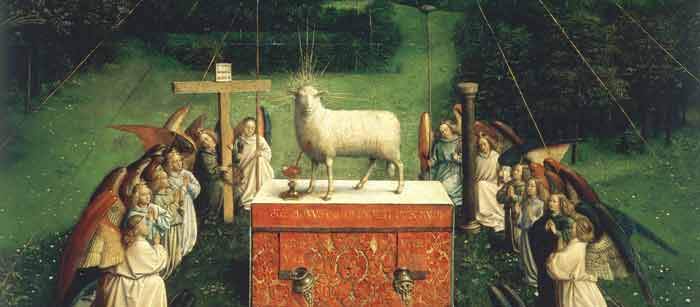
Fig. 7: Van Eyck, Lamb of God, Image Detail: Ghent Altar. Oil on wood, 350 x 461 cm
Cathedral of St Bavo, Ghenthttps://commons.wikimedia.org/w/index.php?curid=109213 [28.10.2024]
This image sets against each other contradictory concepts: static-symmetrical-ordered vs. dynamic; accidental situation vs. deliberate staging; documentation vs. sign; hyperrealism in body and space vs. symbolic charge. It sets these contradictions against each other in the unity of the painting.
Reference
Published March 2024
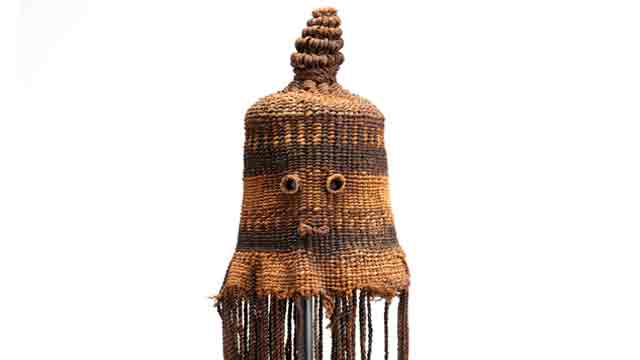
-
 Njeri Gachihi
Njeri GachihiMeaning
Ingolole serves several purposes in the circumcision ritual. It serves to mystify the ritual and more so the initiate. While wearing almost identical masks, the initiates become undisguisable in this full seclusion regalia. It is believed that even evil spirit sent would have a problem identifying the target and hence revert to sender. On the other hand, the masks also serve to wade off and scare women and children who are not supposed to interact with them during the seclusion. Even when they go out of the forest and make processions on major roads singing and dancing, the women and children should stay away. Part of the chants, dance and singing done is meant to break loose ‘childhood/boyhood’ which is symbolized by the breaking of the crown - palm reeds attached on the ingolole. Some do manage to break it which is a sign of physical strength and masculinity as well as spiritual and ritual wellbeing.
The dance that the initiates perform is know as bukhulu/bakhulu which means elder. Bukhulu henceforth, cosmologically viewed, means unity with the ancestors and is also used to symbolize fertility or the life-giving seed (seminal fluid). The effort of breaking the reed henceforth translates into becoming an adult and gaining all the permission to undertake the adult roles and the responsibilities associated with it. This means that this right gives the initiate the ability and power to engage in full conjugal and social responsibility. Last but not least, the initiates spend a lot of time in the open. Ingolole then serves to protect them from the scorching rays of the sun, protect them from sweating too much when dancing and at night serves to protect them from biting cold, wild animals and insects.
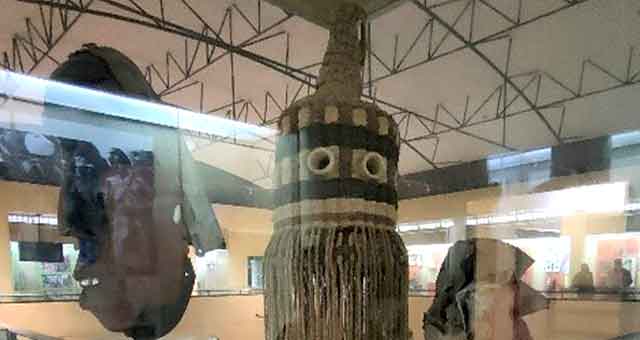 Cutout: Presentation at Nairobi National Museum, Ingolole (Circumcision Mask), Museum Fünf Kontinente and Nairobi National Museum. Photo: Njeri Gachihi.
Cutout: Presentation at Nairobi National Museum, Ingolole (Circumcision Mask), Museum Fünf Kontinente and Nairobi National Museum. Photo: Njeri Gachihi.Is Ingolole an Artwork or a Ritual Object?
The ingolole as a form of ritual art, seems to bear witness to the resilience of the Tiriki culture; what Bakhtin might have called the 'carnivalization of the social order'. A central reason for using this mask, it seems, is to affirm the Africanization of the arena, both public and private, where a culturally appropriate image reigns. The mask usually invests the wearer with signs of power over evil, while modelling him on the norms of masculinity and respectability. The ingolole is one item of art that is yet to be transformed from artefact to curio (or momento). This is apparently so because its mechanism of distinction is yet to mobilize political as well as economic categories. This mask resonates well with the notion that visual art communicates cultural values. It is a complex ideological communication that derives its symbolism and references from culture. Yet it also draws its form and content from the fundamental tenets of the magical appropriation of power through the manipulation of depiction and elucidation.
Therefore, the Tiriki Circumcision mask, Ingolole is not only an artistic representation. It is a ritualistic object that embodies several meanings. It is known to invest the wearer with signs of power over evil - in that the wearer is set apart from his enemies that would intend to inflict harm. It is believed that the evil spirits sent to cause harm on the initiate would find it difficult to positively identify the initiate. At the same time, it causes mystery around the initiates making their looks terrifying and hence keeping off those who are not permitted to come near newly initiates. Physically, it protects the young boys from scorching sun, biting cold and insects while in seclusion. Once ingolole is used, it is kept and passed on from generation to generation. A used one is still valuable to the family and must be kept safely to avoid causing harm to the members of the family. Hence, this is an item of art that cannot be easily transformed from a ritualistic artefact to a simple curio craft.
There are not many Ingolole’s in our Museum in Nairobi. Two are however exhibited in the permanent exhibition, Cycles of life, at the Nairobi National Museum.
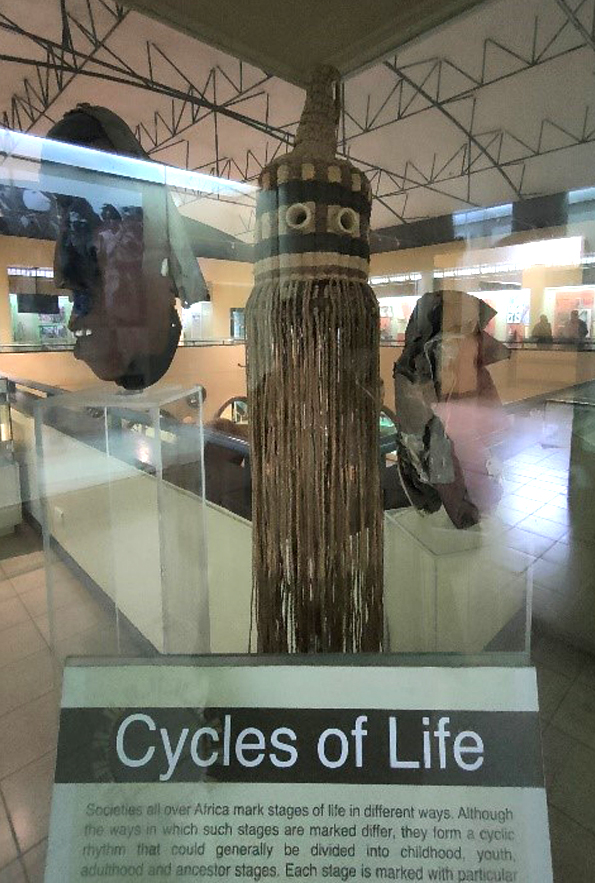 Presentation at Nairobi National Museum, Ingolole (Circumcision Mask), Museum Fünf Kontinente and Nairobi National Museum. Photo: Njeri Gachihi.
Presentation at Nairobi National Museum, Ingolole (Circumcision Mask), Museum Fünf Kontinente and Nairobi National Museum. Photo: Njeri Gachihi.
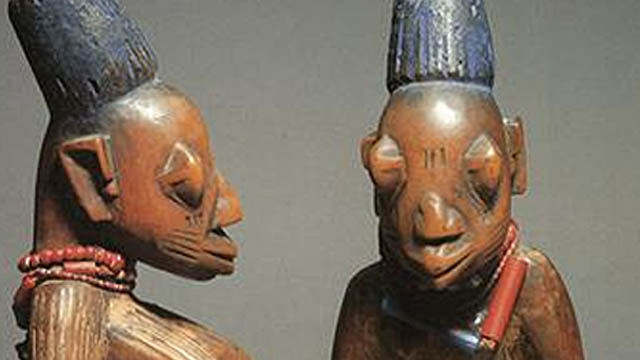
-
 Ebenezer Kwabena Acquah
Ebenezer Kwabena AcquahHistorical link between the Ga and the Yoruba
It is believed that the Ga-Adangbe came from Ile Ife at Yorubaland in Nigeria through Seme, a settlement on the border between Nigeria and Republic of Benin of today. According to popular oral traditions, the groups migrated together crossing the Mono River but scattered after crossing the Volta River (Nortey, 2012). They settled on the Accra plains within the south eastern corner of Ghana (Kilson, 1974). Their initial administrative capital was Ayawaso but was later moved to Accra, as Ghana gained its independence in 1957 and Accra became the capital city of Ghana.
Indigenous belief system among the Ga and Yoruba
The Ga, like other ethnic groups in Ghana and Nigeria, believe in life after death. They demonstrate this belief through comprehensive funeral rites. The type of occupation the deceased engaged in on earth while alive is believed to continue in the next world and as such a coffin is carved to depict the work of the deceased for their burial. The Ga, just like the Yoruba people, belong to Islam, to Christian faith or to traditional religious beliefs (Leroy, Olaleye-Oruene, Koeppen-Schomerus, & Byrant, 2002). They believe in the immortality of the soul and on its re-birth, which are both essential to the Ibeji twin belief.
The Ibeji sculptural figures in perspective and their aesthetic considerations
The Ibeji figures among the Yoruba provide an insight into the recognition of twins within the Yoruba society. The visual sculptural form presents the viewer with a glimpse of what the Yoruba society cherishes through the lens of visual culture. The two figures are presented in semi-abstract forms showing a male and a female (based on genital characteristics). It also shows the relevance of beads in body adornment as found in their usage in the form of necklace, wrist-bands, and waist-bands. On the heads of the figures are scarifications (marks on the body) and both figures are holding a string of cowries.
Cowries were extensively used during pre-colonial times in Africa as symbol of wealth and used as currency and medium of exchange, for symbolic messages, as objects of divination, as jewelry and as a religious accessory, as well as a powerful force that represents the eye of the gods and the womb of the goddess (Yiridoe, 1995; Wayne, 2010; Odunbaku, 2012). Also, the projection of the breasts of one figure is an indication of a female with youthful exuberance.
The pronounced shapes in the figures are curves with minor angular forms in feet and ears. Both figures also show projecting and rounded forehead which are basic characteristics of many African figures. The head-gear is cylindrical and this is similar to that of the Dipo initiates among the Krobo of Ghana who are related to the Dangme.
Though the basics of African aesthetic differ across cultures, the common ones would include symbolism, togetherness, luminosity, craftsmanship, self-composure, and youthfulness (Molokwane, 2010; Vogel 1986). In the Ibeji figures, it is envisaged that a culture of teamwork was involved in the production process, from the felling of the tree through carving to the finishing of the statuettes, building a sense of communal unity. The craftsmen usually work with a master-craftsman. In terms of craftsmanship, the figures are sculpted intricately, with exquisite details, body adornment, and to excellent finish that has made them stand the test of time.
Symbolism is embedded into traditionally African made objects and the Ibeji figures are no exception. They have elegant glossy finishes that portray purity and well-being/good health. The author considers the statuettes (reference to the Ibeji figures) as being young: vibrant, healthy, and a source of strength.
Recognition of twins in Yoruba and Ga societies
In many traditional African societies, twins are considered of supernatural origin and raised emotional reactions ranging from fear and dislike to hope and joy (Leroy, 1995). It is believed that twins are able to grant happiness, health and prosperity upon their family. As such, their nurture is far more venerated than that of other children (Stoll & Stoll, 1980).
Another similarity in terms of belief and practice between the Ga and the Yoruba is that twins share the same combined soul, and it is envisaged that when a new-born twin dies, the life of the other is exposed because the balance of his soul has become disturbed. To forestall any danger, a special ritual is carried out. Though the Yoruba carve a small wooden figure as a symbolic substitute for the soul of the deceased twin, the Ga only perform the ritual. If both twins have died, two of these figures are made among the Yoruba. These statuettes are called Ere ibeji (from ‘ibi’, meaning born and ‘eji’, two; ere means sacred image).
The Ga believe that the twins are special messengers from the Supreme god and therefore highly revered. They also believe that they could bring either a good or bad omen to the society based on the way they are treated. The Yam Festival which falls on the Friday of the Ga Homowo festival celebrated in August, presents a special occasion for twins in the Ga community who are presented with special feast in a form of sumptuous meal and mashed yam with eggs. It is honouring the twins in the traditional families (Nortey, 2012).
During the Homowo festival celebration on Friday, twins carry herbal mixture (leafy concoction) called “baa woo” that is prepared in metal containers and they move through the township in a frenzied manner amid singing and chants. The special concussion is believed to induce fertility and as such people bath themselves with it with the hope of bearing twins.
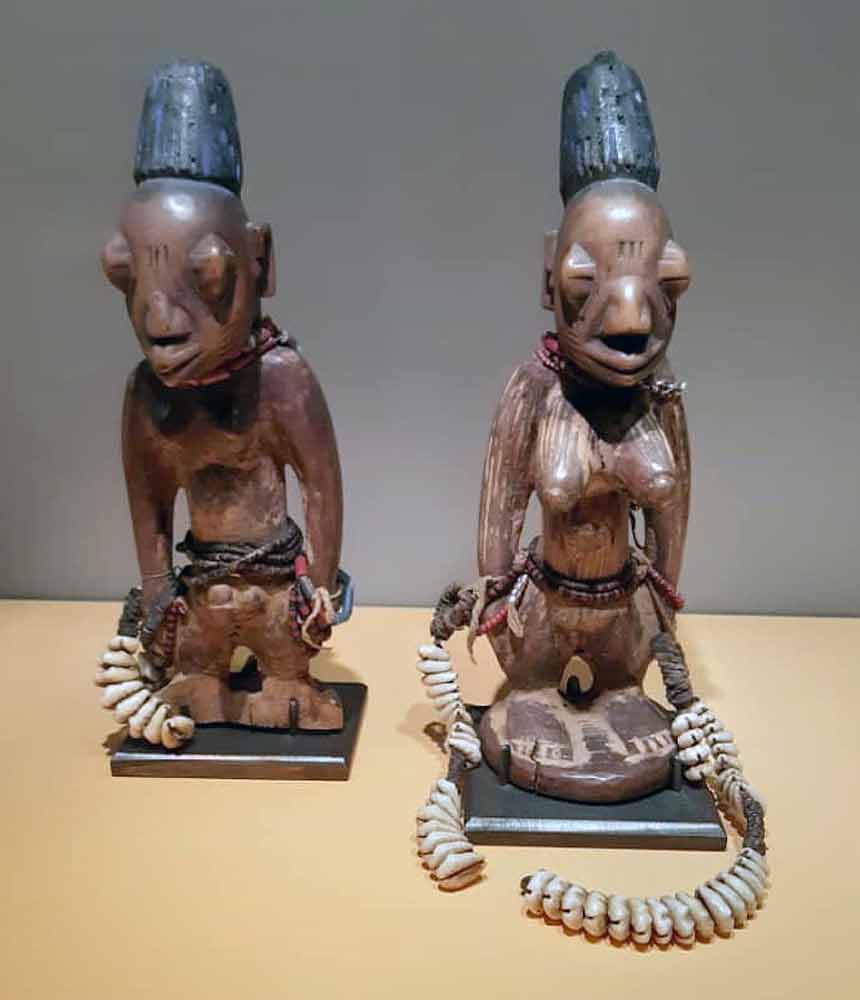
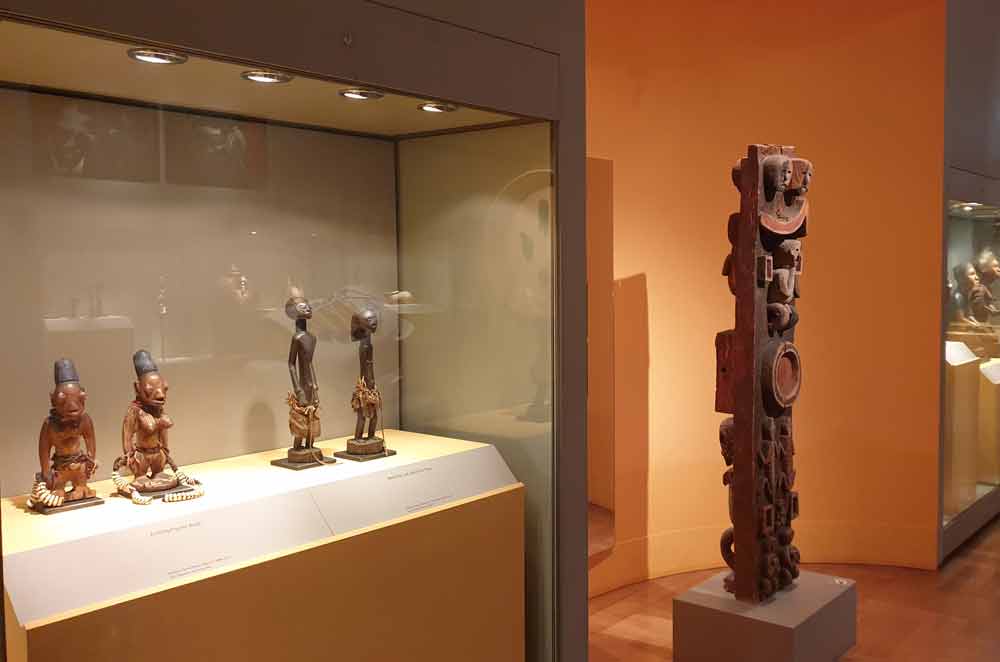
Unknown artist. Ibeji Twin Figures of the Yoruba. Presentation in the museum. First half of the 20th century. Wood, red chalk, cowries, glass. Height 27,5 cm. Museum Fünf Kontinente, Munich. © Museum Fünf Kontinente
Conclusion
The belief in reincarnation and life after death are linked to the Ga and Yoruba ancestor belief. As part of the veneration of twin in families, the Yoruba carve Ibeji figures that has symbolic and spiritual relevance among the people. Among the Ga and the Yoruba, twins are revered and honoured. Furthermore, the two societies believe that every human soul has a chance to return to earth as a new-born, mostly within the same family. The wellbeing of any family is dependent on that of its ancestors and twins. Therefore, periodic prayers/rites are said and sacrificial gifts are presented to ancestral deities, including the Ibeji figures.
References
- Kilson, M. (1974). African Urban Kinsmen, The Ga of Central Accra. London: C. Hurst and Co. Ltd.
- Leroy, F. (1995). Les jumeaux dans tous leurs états. Louvain –la - Neuve [Twins in every state], Belgium: DeboeckUniversité.
- Leroy, F., Olaleye-Oruene, T., Koeppen-Schomerus, G., & Bryan, E. (2002). Yoruba Customs and Beliefs Pertaining to Twins. Twin Research, 5(2),132-136
- Molokwane, S., & Shorn, B. (2002). The African aesthetic as it informs the product form. In:Computer-Based Design. Proceedings of the Engineering Design Conference, King’s College, London, 9 -11 July 2002.
- Nortey, S. (2012). Artistic Evolutions of the Ga Mashie Twins Yam Festival and Its Cultural Implications. Arts and Design Studies, Vol. 2, 2012.
- Odunbaku, B. J. (2012). Importance of Cowrie Shells in Pre-Colonial Yoruba land SouthWestern Nigeria : Orile- Keesi as a Case Study. International Journal of Humanities and Social Science, 2(18), 234-241.
- Vogel, S. M. (1986). African Aesthetics. New York: Center for African Art.
- Yiridoe, E. (1995). Economic and Sociocultural Aspects of Cowrie Currency of the Dagaaba of Northwestern Ghana Aspects. Nordic Journal of African Studies, 4(2), 17-32.
This article is part of a gallery: Perspectives from Ghana on Museum Objects in Germany
Published January 2021
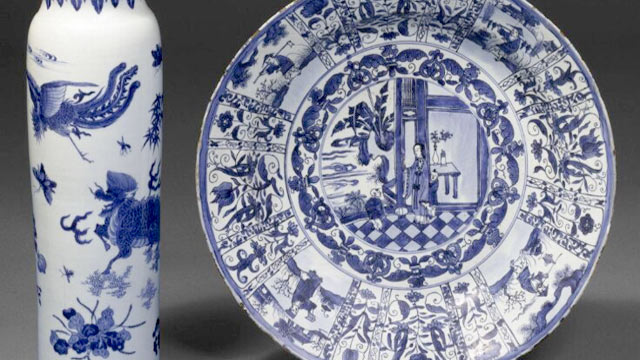
-
 Dong Xiaoling
Dong XiaolingIn the 13th century, when traffic and information were sparse, Marco Polo, a Venetian, came to China by land and served the Chinese Yuan imperial court from 1275 to 1295. The white Chinese porcelain vases, which he took back to his motherland and which are archived at San Marco Museum in Venice today, are reputed as a symbol of the Chinese vogue that went viral in Europe 300 years later. The Travels of Marco Polo has stirred European’s imagination of China[1] , and also promoted Europe's maritime exploration.
However, before the opening of the new sea route between China and Europe in the 15th century, Chinese porcelains were rarely exported to the European market as a commodity. The trade of Chinese porcelains to Europe was monopolized by Arab merchants, while European merchants could only obtain fewer Chinese porcelains from West Asia and Egypt in the form of intermediary trade. Unlike silk and spices, which were easy to carry and transport, Chinese porcelains were mostly sold locally by means of land transportation because of their fragility and weight. They were closely connected with local culture, after which they were imprinted with local aesthetic characteristics and shipped to Europe. However, Chinese porcelains were not what they had always been. Forerunner of great geographical discoveries as he was, Zheng made seven large-scale ocean voyages during Ming Dynasty from 1405 to 1433, but did not establish direct contact with Europe.
Comparatively, European humanism and capitalism were at an embryo stage. From the 15th century to the 17th century, European fleets represented by Portugal, Spain and the Netherlands carried out sailing explorations in order to seek new trade routes and trading partners as well as develop the capitalism in Europe.
First, Chinese porcelains were shipped to Europe as ballast. However, the European upper class favoured them by virtue of their smooth texture, delicate and hard casing and exquisite emblazonment. European royal nobles and bishops all were keen on owning Chinese porcelains to show off their wealth and status. European royal families’ love to Chinese porcelains did not ease in spite of the fact that they had little understanding of the materials and techniques and far away China. Philip II of Spain (1527-1598) had a collection of 3,000 pieces. Although Europe started importing Chinese porcelains on a big scale, a mysterious atmosphere always clung to these exquisite utensils. At that time, some people in Europe even thought that Chinese porcelains could play an anti-virus effect.
The French doctor Loys Guyon (1527-1617) and Sir Thomas Browne (1605-1682) of England studied Chinese porcelains. Père Francois Xavier d'Entrecolles (1664-1741), a French missionary, was in Jingdezhen, China, for 7 years during the 17th century. In 1712 and 1722, he wrote reports on the details of Chinese porcelains making which he observed and inquired into and mailed them back to the Jesuits in Europe, making it possible for French to imitate porcelains locally.
Already in 1575, Italian Medici Grand Duke Francesco's factory made an attempt to produce porcelains, which was the first imitation recorded in Europe. Such a kind of Medici pottery bottle with blue and white patterns is collected in the Louvre. Both the white glazed blue painted pottery in Delft, the Netherlands, and the Nevers kiln in France have imitated the decorative style of Chinese porcelains. However, in terms of materials, they came in pottery or soft porcelain. The alchemist Bottger did not calcinate the earliest European porcelain at Meissen, Germany until 1709. In this process, the aesthetic taste in Europe had gradually changed. The fashion of loving oriental artifacts had gradually spread from nobles to rich bourgeoisie. As the demand for relatively cheap goods had also become more and more vigorous, porcelains had gradually turned a part of the daily life of the common. The nature of Chinese porcelain had gradually changed from collectibles to daily commodities.
In order to meet the needs of European society, East India Companies in European countries imported a large number of porcelains from China in the 17th and 18th centuries. In China, this kind of porcelain for export was called export-purpose Chinese porcelain.[2] From the change of shape and pattern the export-purpose Chinese porcelains can be roughly classified into traditional styles, hybrid styles and foreign styles.
1. Traditional styles (The shape and decoration of porcelain have not been influenced by foreign styles, and are no different from products on the Chinese market.)
From the opening of the new sea route in the 16th century to the lift of the ban on maritime trade in 1684, it was illegal for Chinese to export porcelains. As per the ban on maritime trade in the Ming Dynasty, non-governmental maritime trade was strictly prohibited, while official tribute trade was allowed with strict restrictions. Foreign countries could only conduct limited official trade with the Ming authorities. Since then, the Qing authorities have repeated the ban on maritime trade. The production and shipment then were at great risks.
Merchants usually purchased Chinese porcelains in Guangzhou and then shipped them abroad from Macao, making the export-purpose Chinese porcelains dominated by traditional Chinese style at this stage. It influenced the early stage of the Chinese style in Europe as well as the reproduction and imitation of Chinese porcelain with soft pottery in Europe. Chinese porcelains were mainly used as daily necessities, such as dishes, bowls, bottles and pots. But there were few ornamental porcelains as well. The decorative patterns mostly came in cloud-dragons, deer, horses, cranes, monkeys, flying butterflies, birds and insects, folding branches and flowers, fairy ladies with babies, city walls with mountains and waters, auspicious characters, etc.
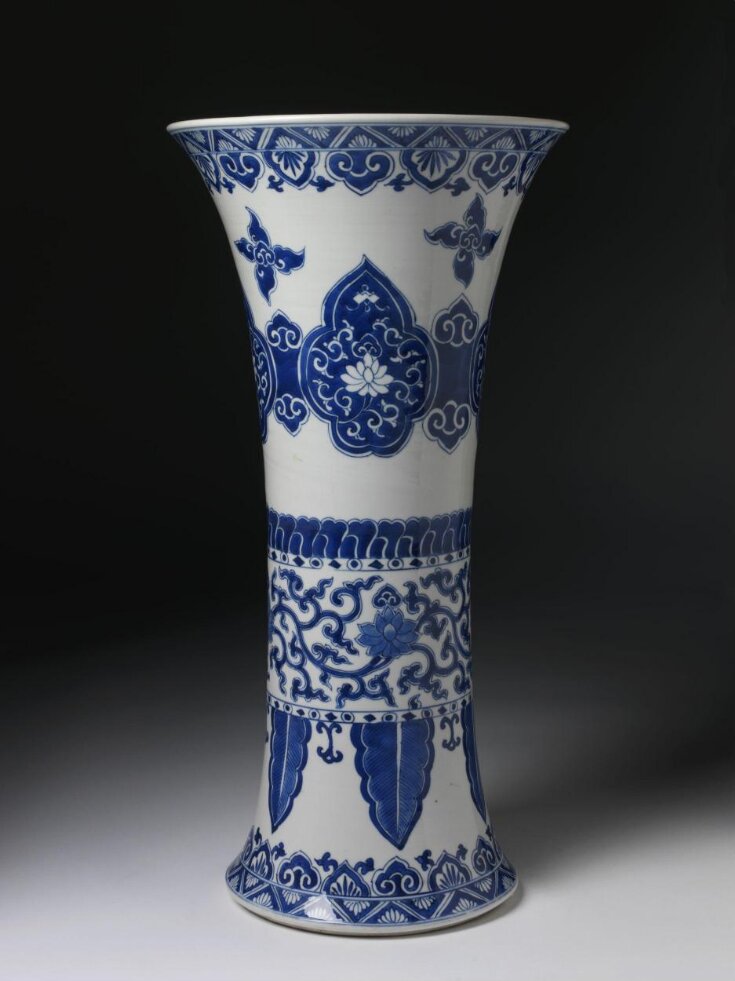
Unknown, Blue and white porcelain vase, 1700-1710, Victoria and Albert Museum London.
The style of blue-and-white porcelains represented the life of the easterners to Europeans. A great number of Chinese porcelains of this kind are recorded in the archives of Dutch East India Company.
On the one hand, few Chinese porcelains were exported to Europe with a higher price; on the other hand, the pure oriental shape made Chinese porcelains deviate from the daily needs of Europeans. For example, easterners’ habit of eating rice and using chopsticks makes bowls the most common utensils in the East, while westerners’ custom of eating bread and using knives and forks has not made bowls, with a deep-walled shape, the mainstream of European tableware by far. Because the typical Chinese tableware consists of fewer parts compared to Western dining habits, Chinese porcelain dishes could only be used for holding cakes and pastries in Europe. For example, porcelain pen containers were used as wine cooler, and porcelain fish tanks were used as flowerpots... Chinese porcelains were constrained in terms of use, and often modified or displayed as ornaments. Therefore, a new style came out in the course of development.
2. Hybrid styles. (Chinese traditional style couples with foreign ornaments and vise versa, or Eastern themes couple with Western ones for hybrid ornaments.)
It is the stage of free transformation of Chinese style porcelains. Among this type, porcelain with traditional Chinese themes, or a mixture of different themes from China and Europe, combined with European shapes is the most representative. Part of the changes in the shape of European porcelain came from metalware, and part from the changes in lifestyle brought about by trade. For example, since the 17th century, Europeans have been importing black tea and coffee from the East and chocolate from Mexico. These hot drinks come brown in color after brewing, and white Chinese porcelains serve as the most suitable drinking utensils. The emergence of new eating habits has promoted the transformation of Chinese porcelain utensils. The Dutch enlarged the size of traditional Chinese small teacups and designed a lug.[3] Kraak porcelain[4] and Mandarin style were the most representative.
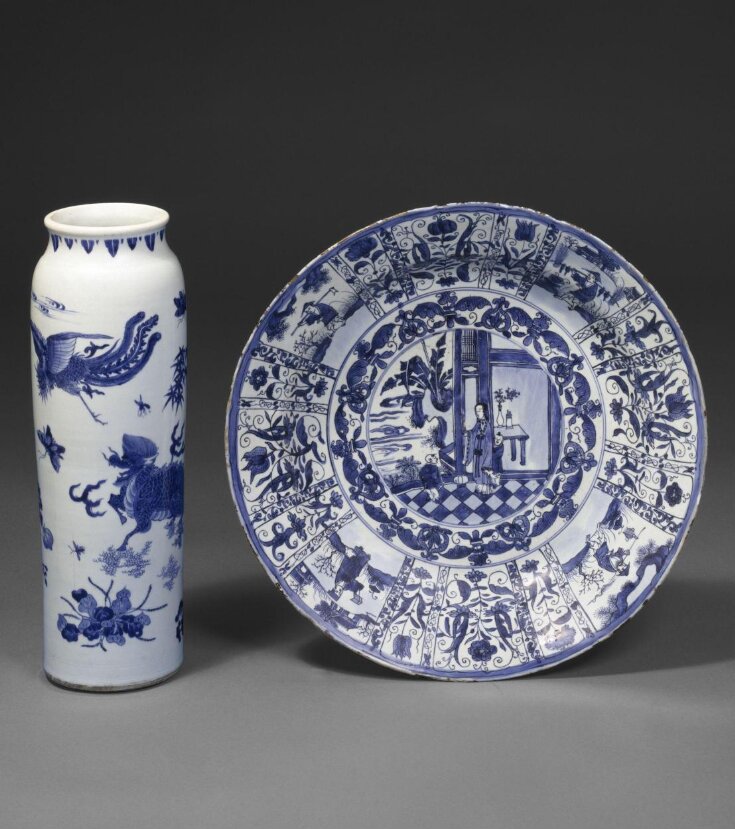
Unknown, Dish, ca. 1635-1655, Kraak Porcelain, Diameter: 47,5 cm, Bibliographic Reference: Clunas, Craig (ed.). Chinese Export Art and Design. London: Victoria and Albert Museum, 1987, p. 38, fig. 16.
Kraak porcelain is a form of blue and white porcelain exported from Wanli Period of Ming Dynasty (1573-1620) to early Qing Dynasty. It was mainly shaped in dishes, bottles and bowls, and represented by trimmed patterns. These patterns came round, diamond-shaped and lotus petal-shaped, with designs of flowers, birds, fish and insects, landscapes, figures and auspicious mascots commonly seen in Chinese porcelains. Later, exotic religious myths and social life themes appeared in trimmed patterns. In terms of techniques, the traditional way of drawing the outline of the pattern on the surface of the porcelain body with a writing brush and then filling it in with color was adopted. Kraak porcelain is a kind of export-purpose porcelain with the largest quantity and the longest influence period of more than 100 years. After that, blue and white porcelain in Kangxi Period (1662-1722) of Qing Dynasty came in western rendering techniques in drawing, showing a maximum of eight or nine color gradations on the porcelain body. And it drew much popularity among westerners.
The word “Mandarin” was a name for Chinese officials when Portuguese traded with Chinese merchants in the 17th century. In the 17th and 18th centuries, many missionaries and painters came to China and recorded their experiences there, including their life and work with Chinese officials in addition to preaching.
Most of the decorative patterns depicted the life of officials and wealthy merchants in Qing Dynasty, who enjoyed a rich and leisurely family life. These descriptions and landscape paintings further aroused European‘s curiosity about live in China. Aiming at this market opportunity, Guangzhou Porcelain Workshop launched Mandarin style products for European and American markets. Some patterns use the perspective technology of European oil paintings, and the expressions of the characters are vivid, which conforms to the aesthetic orientation of Europeans. These patterns presented a desirable pastoral oriental atmosphere for westerners. Playing in picturesque courtyard gardens, hunting in enchanting springtime, harmonious coexistence between human beings and nature, and vivid home life scenes embodied elegant Chinese costumes, fascinating home decoration, exquisite garden scenes, and charming family happiness. These themes greatly satisfied Europeans’ curiosity and yearning for the East.
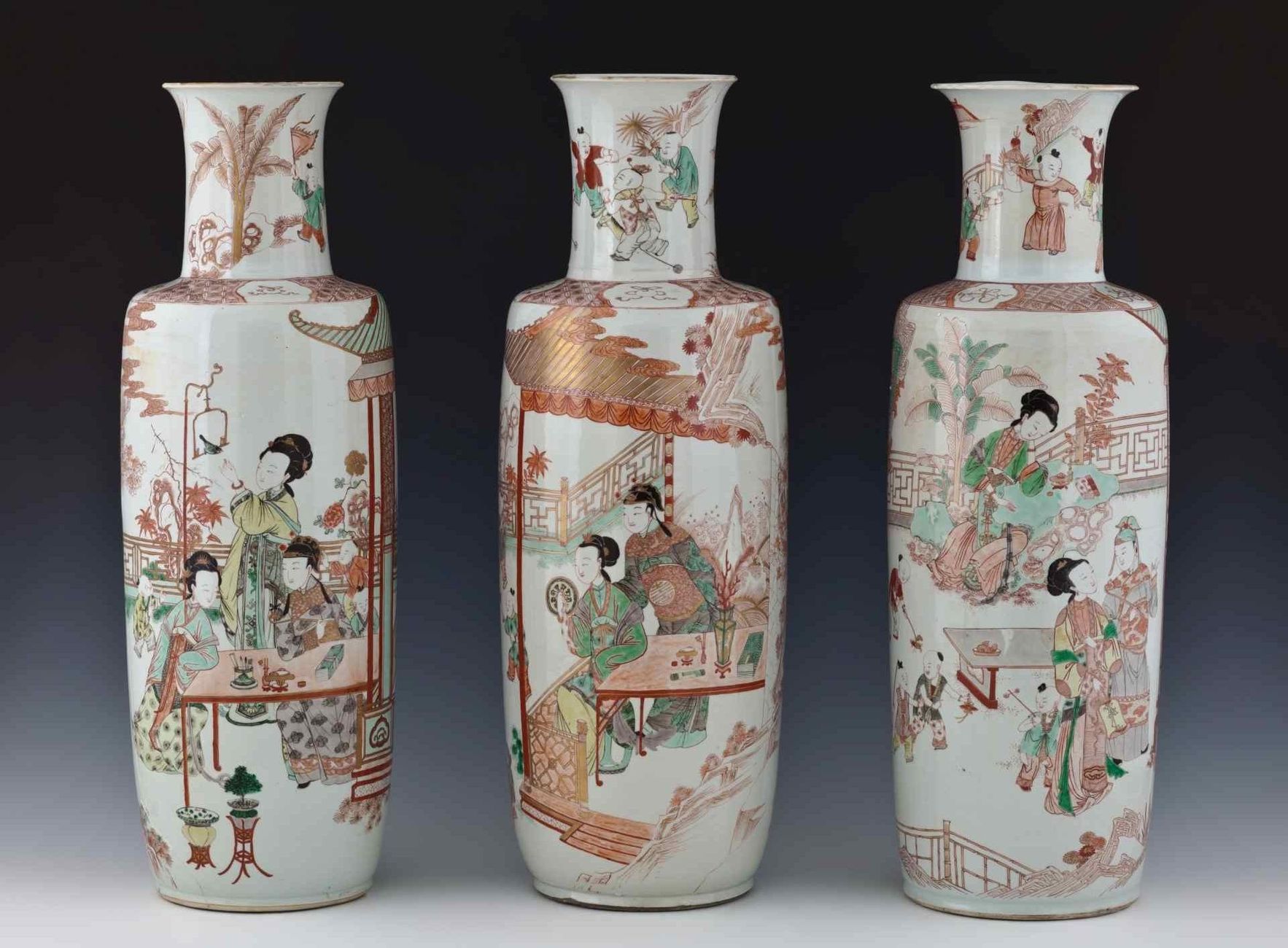
Unknown, Three Vases, 1700-1720, Procelain, Jingdezhen, Staatliche Kunstsammlungen Dresden.
3. Foreign styles. (Chinese porcelains satisfying the requirements of European merchants in terms of shapes and patterns, calcined elaborately to serve European consumers’ needs. Most of the patterns were drawn in strict accordance with the prints and patterns as required by customers, so they were usually called custom-made porcelains.)
One type was produced in the 17th century. Since Europe had not yet mastered the technology of porcelain-making, Chinese porcelain workers imitated the pottery of European style according to the requirements of European merchants. Chinese Porcelain competed with European pottery in this way and earned a lot of silver used as currency.
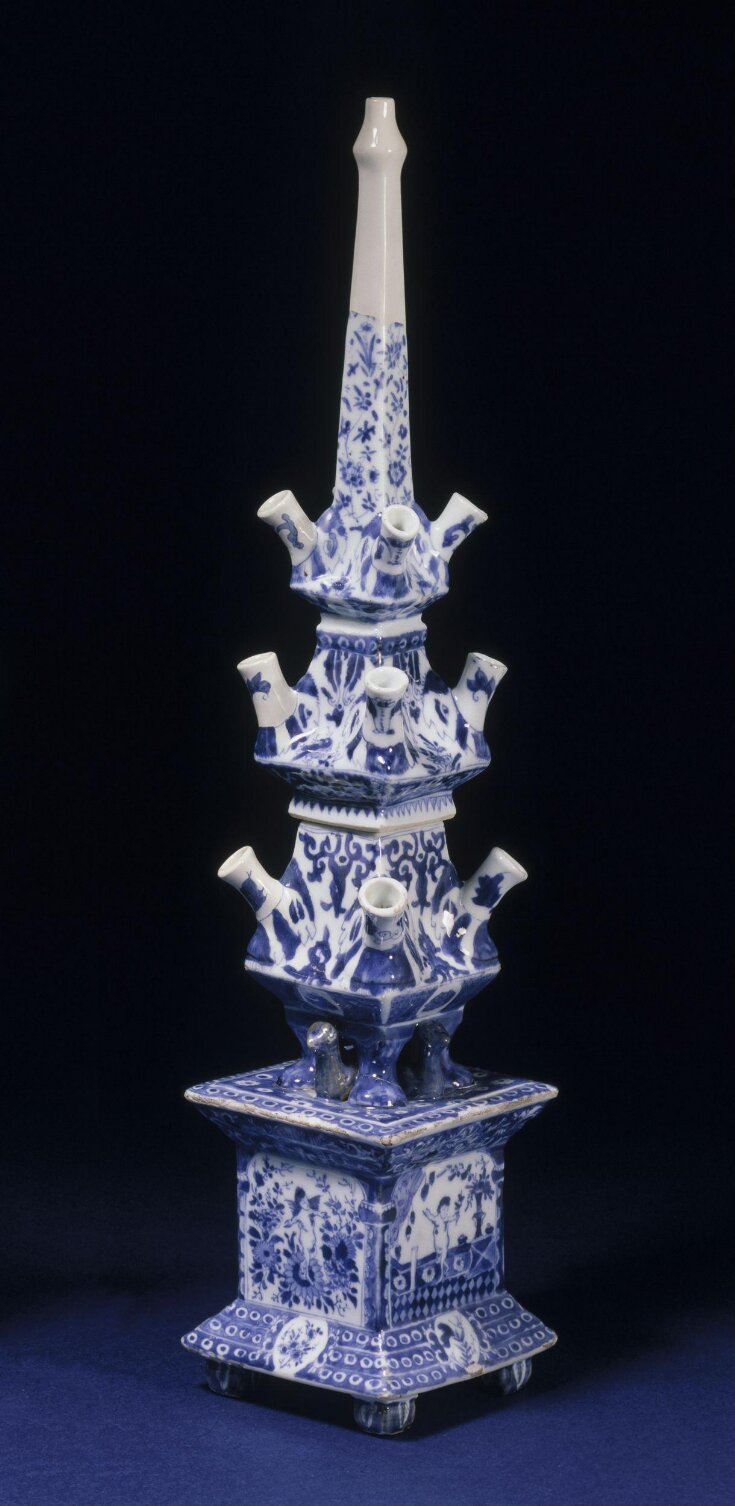
Unknown, Vase with Angel, 1700, Porcelain, H: 36cm, Victoria and Albert Museum London. Bibliographic Reference: Clunas, Craig (ed.). Chinese Export Art and Design. London: Victoria and Albert Museum, 1987, p. 60, fig. 40.
Another type emerged when the Chinese style in the West reached its peak in the 18th century and Chinese characters and landscapes imagined by Westerners appeared in the patterns. The pictures are humorous and interesting, while the number is quite limited. In addition, there were porcelain carvings, figures and animals.
The pattern was typically formed by heraldry (the special signs of European and American aristocratic guilds, groups, etc. In the 18th century, China sold up to 600,000 kinds of heraldry porcelain to Europe). In addition, characters (out of Greek or Roman fairy tales, the Bible, European customs-based sketches), ships, landscapes, flowers, etc. used to be popular themes among Europeans. Besides, European living habits were taken into consideration in terms of modeling.
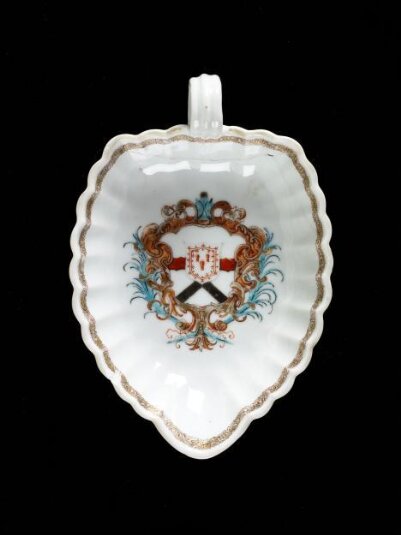
Unknown, Souceboat, ca. 1740, Porcelain, L: 18,4cm, Victoria and Albert Museum London. Bibliographic Reference: Howard, David Santuary. Chinese Armorial Porcelain. London: Faber and Faber Limited, 1974, p. 295.
Apart from blue and white, multicolored and famille rose ones were among this kind of style. Because of the higher cost, longer period of capital occupation, more complicated procedures and greater commercial risks, this variety did not turn a mainstream among export-purpose Chinese porcelains in spite of their distinctive features. Especially in 1769, the first production line of British Wedgwood Porcelain Plant rolled off, when European porcelain production began to leap from the handicraft era to the industrial era. Since then, importing Chinese porcelains has grown unprofitable, and the porcelains in Chinese style turned gradually out of date.
In the course of trade development for nearly 300 years from the 16th century to 19th century, from “Made in China” to “Making Chinese Porcelains”, the Chinese vogue going viral in Europe represented a process of Europeanization of Chinese cultural practices. In this process, lacquerware, woven carpets, clothing, furniture, wallpaper and garden architecture were as well used for reference, quotation and modification in Europe, and finally integrated into the social context of Europe, influencing and even changing the artistic outlook of Europe. Nowadays, the shortened distance and accessible information across the world enable us to see the diversity of cultures more quickly and accurately. More possibilities for cultural exchanges will definitely be springing up in the future.
FOOTNOTES
[1] China in the 13th-19th centuries was only a Far East country geographically along with India, Southeast Asia, South Korea and Japan
[2] Due to the limited space, the export-purpose Chinese porcelain in this paper refers specifically to the exported ones to Europe.
[3] Lin Lin's, Research on Porcelain Trade of Dutch East India Company in the 17th-18th Centuries, pp 31-34.
[4] Its name probably originated from Portugal Caraack, meaning “giant merchant ship”.
REFERENCES
- WangYong, A History of Art Exchange between China and Abroad, Beijing, 2013
- Shanggang, A new compilation of the history of Chinese arts and crafts, Higher Education Press , 2007
- Etiemble, L’Europe Chinoise. The Commercial Press, Beijing, 2013
- Liwei, Through the silk Road, Beijing, 2018
- Hugh Honour,Chinoiserie: The vision of Cathay, Peking University Press, 2017
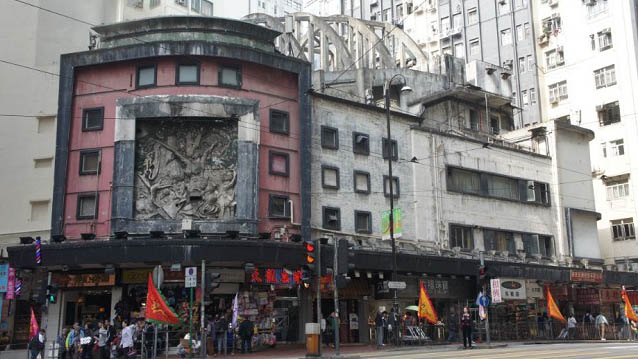
-
 Prudence Lau
Prudence LauState Theatre, originally named Empire Theatre, was opened in 1952. According to interviews with veterans from cultural circles, the Theatre was the “very origin of Hong Kong’s entry to the world of high arts” (South China Morning Post, Jan 11, 2017). It was Hong Kong’s cultural hub and only to be eclipsed by the City Hall that opened four years later in 1962. Located in North Point on Hong Kong Island, it was founded by a Russian-Jewish impresario Harry Odell, a legendary giant in the history of Hong Kong entertainment. Odell had started a film distribution company ‘Harry Oscar Odell’s Commonwealth Enterprises Corporation Ltd.’ in the post-war years and arranged for internationally acclaimed artists to perform in Hong Kong and in the theatre, including the late Taiwanese famous pop singer Teresa Teng, the late British tenor Peter Pears and Katherine Dunham’s Broadway dance company (South China Morning Post, March 2, 2016).
The Theatre was also a popular venue for live shows such as Chinese drama, opera and musical performances. The roof of the auditorium is suspended from external parabolic concrete roof trusses, which are exposed to the public and serves as a prominent feature and trademark of the building. This ingenious design also freed the auditorium from pillars and allowed for flexible internal arrangements. Designed by a Chinese architect S.F. Liu, the Theatre is moreover fronted by a large decorative relief panel with the artwork by renowned Lingnan artist Mui Yu-tin featuring the ancient Chinese tale of ‘The imperial warlord Dong Zhuo and the legendary beauty Diao Chan’. Together with the framed squared architraves and banded windows harmoniously fronting the elevation of the Theatre, there is a distinct Modernist and Art Deco quality to the whole building.In 1959, it was renamed State Theatre, and due to practical reasons the building has since then been converted into a theatre-cum-shopping complex, and a multi-storey block with shops, residential flats and a night club was opened in the adjacent site. The Theatre finally ceased to operate in 1997, and has today changed its use to a billiard centre with removable partitions sealing off the upper deck of the auditorium. The rest of the complex currently consists of a rundown shopping mall, still in function, and small residential flats.
In July 2015, a local property developer started to purchase various property rights within the State Theatre complex, and rumours of demolition and redevelopment of the site started to spread. Eventually, after substantial consolidated public efforts towards the Theatre, it was finally given a Grade 1 historic building status in March 2017. The State Theatre, narrowly escaping demolition, is only the third building after the Bank of China (built 1952) and the City Hall (built 1962) listed as a Grade 1 historic building in Hong Kong that is built after 1950, indicating a flaw in local heritage policy to value modern built heritage.
published January 2020
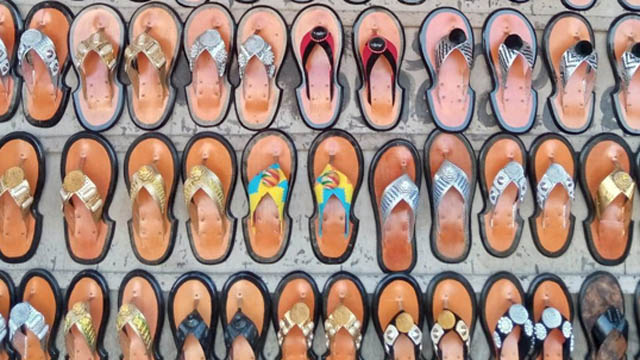
-
 Osuanyi Quaicoo Essel
Osuanyi Quaicoo EsselFashion accessories help in decorating the human body and act as an essential influencer of accessories production and commodification. By decorating the human bodies, fashion accessories heighten the aesthetic aura around its wearers based on the precepts of the standard of beauty held by the society that created such objects. The production and commodification of fashion accessories are universal to different cultures across the globe. It happens in different parts of the world, including Africa. On the continent of Africa, different societies have demonstrated their creative prowess in fashioning accessories for the decoration of human bodies. For example, the Asantes of Ghana are known for their decorative gold weights, pendants, and other jewellery products that served as regalia (Rattary, 1927; Busia, 1951; McLord, 1981; Ross, 1982, Antubam, 1963; Kyeremanten, 1965; Fosu, 1994) for utilitarian and communicative purposes.
The use of artistic fashion accessories such as dresses, fabrics, footwear, headwear, brooches, earrings, belts, bangles, anklets, amongst others, have always had a strong political, social and cultural role in safeguarding the histories, values, and identities of different cultures. It implies that these fashion objects give hints that help to unravel particular histories surrounding their origin, material, tools, semiotics, and creators in society. Of the accessories that served as regalia, one of the commonest, yet essential and inevitable fashion objects for Asante kings/chiefs, and by extension Akan and even non-Akan chiefdoms is ahenema (native sandals). The usage of ahenema goes beyond Ghana. Some kings/chiefs in neighbouring countries such as Togo and Cote D'ivoire also use it as essential regalia for traditional functions. There have been instances where ahenema has seemingly been used as panoplied regalia and an authoritative object of the power of a king/chief. Ghanaweb (2007, August 18) reports of the Asantehene, Otumfuo Osei Tutu II’s destoolment of the Asomfohene, Nana Osei Kwabena, for flouting the chieftaincy orders of the Asante Kingdom. The destoolment process included the removal of his ahenema sandals to signify that the said chief has been destooled under Asante chieftaincy tradition. There were also reports that the Asantehene, Otumfuo Osei Tutu II, in December 2010 destooled the Queen of Atwima, Obaapanin Asamoah Duah II, and two sub-chiefs for taking a bribe (VibeGhana.com, 2010). As part of the destoolment rituals, the ahenema sandals of all the three culprits, which symbolised their office as traditional rulers, were removed from their feet. These instances of destoolment with the ahenema seemingly playing a symbolic role need further investigation. This is because the instances raise questions of the sociocultural relevance of ahenema regalia in Asante chieftaincy culture. Besides, the historical twist to the origin of this fashion object and regalia needs academic attention. This study, therefore, traces the historical origin of ahenema, and investigates its sociocultural relevance in Asante chieftaincy cultural milieu.
The theoretical perspectives that support this study is the object-based theory propounded by Lou Taylor. The study is situated in the object-based theory propounded by Lou Taylor (2002) and Riello’s (2011) methodological model of material culture of fashion. The object-based theory is concerned with materiality which has to do with description and documentation to bring out and classify garments or objects for historical purposes. It also focuses on the contextual attributes of the exhibits, oral history, company history, and design philosophy of fashion production (Taylor, 2002; Skou & Melchior, 2008). Riello’s (2011) methodological model of material culture of fashion which he borrowed from art history, anthropology, and archeology also makes fashion art objects central to historical studies and narratives be it socio-cultural, economic, and other practices of a particular period (Essel, 2017). Informed by object-based theory and material culture of fashion, the study considered the contextual attributes of ahenema, its oral history, design philosophy, description and documentation to bring out its history and sociocultural relevance amongst the Asantes and by extension, the Akan chieftaincy. This theoretical stance took ahenema fashion art object as central to historical studies and narratives in a sociocultural context.
Historical case studies constituted the research designs for the study. The historical case study helps in analyzing cases from the distant past to the present, using eclectic data sources, in generating both idiographic and nomothetic knowledge (Widdersheim, 2018). The use of the historical case study was informed by the fact that although case studies and histories can overlap, the case study’s unique strength lies in its ability to deal with a variety of evidence including documents, artifacts, interviews, and direct observations, as well as participant-observation beyond what might be available in a conventional historical study (Yin, 2018). A total of nine (9) respondents were purposively sampled for the study. They consisted of four (4) ahenema designers and producers with active experience ranging from 20 to 35 years on the job, two (2) chiefs and three (3) elders from chief palaces in Asanteland. Unstructured interview and focus group discussion constituted the method of data collection. Permission was sought from the respondents for face-to-face interview with the agreement to audio-tape for transcription purposes. Historical and narrative analysis tools were the data analysis tools used. With the historical research tool, the study used the heuristic of considering the source and the context of the data and corroborate it to ensure the trustworthiness and authenticity of the data gathered. Historical research concerns itself with identification, analysis, and interpretation of old texts (Špiláčková, 2012), eyewitness accounts, and other oral history and interviews. Using the narrative structure, data analysis was done to accentuate consistency, suppress contradiction, and produce rationally sound interpretation (Holloway & Jefferson, 2000) without truncating the content of the told stories about the lived experiences of the respondents. The historical narration was supported with photographs of ahenema taken with the permission of the creators. The transcribed and analysed data was shared with the respondents for verification purposes. The respondents also provided some pictures and permitted the researcher to use them for academic purposes. To ensure the anonymity and confidentiality of the respondents, pseudonyms were used in place of the original names.
The Akan word ahenema literally means ‘children of kings/chiefs.’ Legend has it that, when it was developed, only kings/chiefs and their families could wear it to show their status as royals. Later, it became permissible for the subjects and all to use. The king/chief belonged to the high class of society because they were the leaders of their flourishing kingdoms and ethnic states respectively. They had creative artists in their courts who produced functional and decorative artworks and fashion accessories used as body adornments. Per the high status of kings/chiefs in the society, the trickle-down theory, where new fashion art usage begins with the top echelon of society and gradually gets to the masses, exemplifies the spread and use of ahenema in Ghanaian society. Ahenema is also called Kyawkyaw. The word Kyawkyaw was derived from the sounds it makes when worn for the usual characteristic majestic walk. Respondent Opanin Kwame explained that:
Ahenema used to be worn by only the chiefs/kings and their families. If you are not a chief … you are not permitted to wear it. When the one who is not a chief is sighted wearing some at a durbar, the elders sent people to remove it from the person’s feet.
Legend has it that, the first ahenema was fashioned out of wood which served as the sole (called aseɛ) while the top (referred to as nsisoɔ or ahenemapɔnkɔ) was made of leather. It developed to a stage where the flat wooden soul was replaced with layers of animal skins, cut out to form the shape of the sandals. The animal skins (for example, okohoma) used as the sole produced the kyawkyaw sound when in use. The sound became the name of the sandals.
Respondent Opanin Antwi and Opanin Kwaku have been in the business of Ahenema production for more than thirty-five years. They make a living from the job, and have trained more than ten 10 and 16 apprentices respectively, some of which have set up their production shops. In a focus group discussion, they revealed that:
There are two basic soles (aseɛ) of ahenema, namely Asansatoɔ and Atenee (Figure 1). Beyond these, producers create new ones which are sometimes suggested by clients. It could be in the shape of animals like crocodiles, lizards, tortoises (Figure 1c) or fish. The soles have symbolic meanings that are usually associated with the animal or objects which influenced its creation. However, it is the top (nsisoɔ) that determines the name of the ahenema.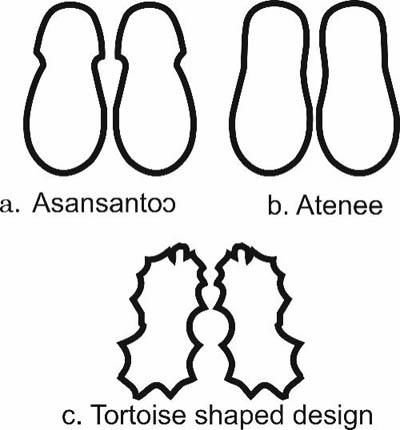
Some of sole pattern designs of ahenema. © Osuanyi Quaicoo Essel
There are different schools of thought on the etymology of ahenema footwear. One legend account traces it to the reign of the fourth Asante king, Otumfuo Osei Kwadwo Okoawia who ruled from 1764 to 1777(‘A Guide to Manhyia Palace Museum’, 2003). This account posits that Asantehema (Queen mothers) had specially made sandals, for they do not walk barefooted in the courtyard of the palace. One of the Asantehema once got injured in the foot while walking without sandals. The wound, according to legend, took long to heal and became a great oath of the Asantehema. Since this account is believed to have occurred during the reign of Otumfuo Osei Kwadwo Okoawia, then, the fourth Asantehema, Nana Konadu Yiadom I (whose tenure began in 1768 – 1809), was the possible beneficiary of the earliest ahenema footwear.
Bodwich’s (1818) narrative accounts of the culture of the Asante people offer some hints on the history of the ahenema footwear. In his description of the regalia of the kings, he pointed out that (p.35) ‘their sandals were of green, red, and delicate white leather …’ In thick description of what the king wore Bodwich said, their royal sandals ‘of a soft white leather, were embossed across the instep band with small gold and silver cases of saphies’ (p.38). Gold pendants and designs of varied symbolism that show the power and wealth of the Asante kings were used to embellish their unique ahenema footwears. Vansina (1982, p.222) offered hints of the period of production and usage of some ahenema. She revealed some of the artefacts including sandals and cast of gold rings had production dates estimated in the range of 1700 to 1900. This confirms the eighteenth century as a possible period ahenema sandals production in Ghana began.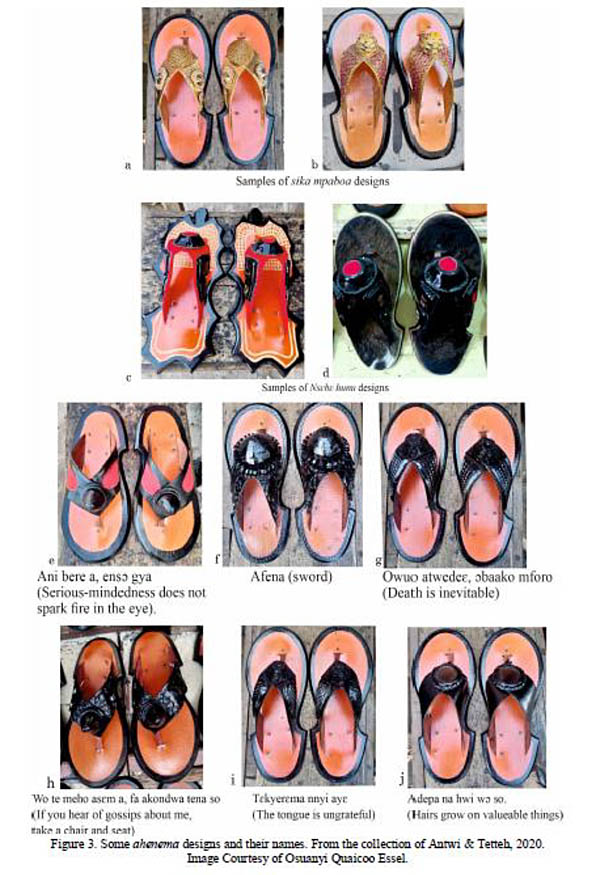
Categories of Ahenema. © Osuanyi Quaicoo Essel
There are categories of ahenema (image above). The categories of ahenema are traditionally informed by the kind of occasion and the purpose for which they are made. There are those used for funerals, durbars and festive occasions (festivals and other merrymaking events), especially, in the customs and traditions of chieftaincy institutions. The red, black and brown coloured ones are usually used for funerals to depict bereavement, sadness and death. In the Akan notion of colours, red, black and brown are associated with decay, death, bereavement and pain (Antubam, 1963; Amenuke et al., 1991), hence, its association with funerals. Those meant for durbar (adwabɔ) are the gold stud sandals (Sika mpaboa), silver and related colours. One of the Akan chiefs commented that:
To complement the wearing of toga style by the chiefdom, they desired to develop footwear to match with it. As a result, they developed ahenema for different occasions. They created ahenema for funerals and durbars. But there are some people who are unaware of the types and, therefore, use them anyhow. This suggests that there are categories of ahenema worn for different occasions but certain factors have caused its improper usage in the traditional cultural milieu. These factors include ignorance of the colour symbolisms as well as the meanings ascribed to the entire design. In one breadth, the users who default the conventional usage in terms of colour schemes and meaning may be doing so for purely aesthetical reasons rather than meaning associated with them.
Amongst the Akans (which form over 70% of Ghana’s population), ahenema is the traditionally sanctioned footwear accessory suitable for traditional gatherings or occasions. Wearing the toga fashion (usually 6- 12 yards of fabric gracefully wrapped on the body) without ahenema is culturally inappropriate in the traditional chieftaincy milieu. Likewise, it is traditionally unethical and unacceptable in Asante customs and traditions for kings or chiefs to wear the toga fashion classic without wearing befitting ahenema. Even for those who are not part of the chiefdom, wearing ahenema that is unsuitable for a particular durbar, funeral and other traditional events of the chiefdom are likely to invite troubles for themselves.
Per the categorisation of ahenema sandals, sika mpaboa (literary translated as ‘golden footwear/sandals) for example, is the highest status-defining type of ahenema footwear amongst the chiefdom. For the chiefdom in the Asanteland, sika mpaboa (Figure 3) is a preserve of the Asante King. No other paramount chief could wear it without his approval. Based on the achievement of chiefs under the rulership of Asantehene, he may honour a chief with sika mpaboa. Such honours remain a great chieftaincy laurel, privilege and meritorious achievement in the Asanteland. Once a chief has bestowed this honour, it implies that that chief has the power to wear sika mpaboa at traditional chieftaincy functions, durbars, or occasions. The sika mpaboa of the Asante king remains distinctive. It may be decorative with cast-gold (Ross, 1982) symbolic animal and geometric figurines that ornament the (top) nsisoɔ of the sandals. Bodwich (1818, p.256) confirms this centuries-old and long-standing tradition of who has the prerogative to wear sika mpaboa (ahenema stud with gold or golden colours). He writes:
The caboceers of Soota [Nsuta], Marmpon [Mampong], Becqua [Bekwai], and Kokofoo [Kokofu], the four large towns built by the Ashantees at the same time with Coomassie [Kumasi], have several palatine privileges; … These four caboceers, only, are allowed, with the King, to stud their sandals with gold.’
A chief who wears Sika mpaboa that is not sanctioned by the Asantehene to durbars and other traditional occasions is slapped with contempt. The act becomes contemptuous because it breaches Asante chieftaincy etiquette, customs and traditions, which is punishable. In support, one of the chiefs commented that: ‘Look, I’m a chief in the Asanteland, but I do not have the right to wear sika mpaboa. Should I wear it, I would be cited for contempt, for it does not show respect to the Asante King.’ There are ranks of chiefs. A subchief could not wear ahenema of a higher status and prestige such as sika mpaboa to a durbar of paramount chiefs. He will be cited for contempt. One elder recounts that:
We attended a durbar in the Asanteland. I wore a particular ahenema as part of my toga fashion. As custom demanded, I was part of the entourage that went to greet the chiefs at the durbar. While greeting, I overheard one of the subjects whispering to one of the chiefs, if I’m traditionally permitted to wear that particular ahenema. The chief sighed in the affirmative in response to his subject due to my status in the traditional area (N. K. Duah, personal communication, October 19, 2020).Ahenema names and Semiotics
As in the case of wax print fabrics, ahenema are given unique symbolic and proverbial names. The names are usually given by the producers. In some cases, the client suggests the preferred name for the producers to fashion the sandals based on that. Respondent Opanin Kwame added that:
We came to meet some of the design names given by some of the earlier ahenema producers. We also create some designs and name them based on Akan symbolism associated with animals, plants, human body parts, adinkra symbols, among others. I have personally created some designs based on periwinkles which are small marine snails. Per its tiny nature, many people usually eat it when they don’t have money to buy fish or meat. People, therefore, consume it in difficult times. Based on this I used the shells of the periwinkles in my ahenema design and named it Me nso meho behia da bi which literally means ‘I will be useful to people one day’.
The names given by the producers or suggested by the clients may cast insinuations, promote peace, warns against the ills of society and show one’s status. Some of the names are presented in Table 1 and Figure 3 respectively. For example, Ani bre a, ensɔ gya design (Figure 3 e), shows red-dyed leather used as in-lay against the black colour scheme to suggest the symbolism of it name. The red parts of the design look seed-like, an abstract representation of reddening eye, which symbolically suggests seriousness. Philosophically, this treatment connotes that no matter the degree of seriousness in pursuing something, it will not cause the eyes to redden. In other words, seriousness, as an attribute does not mean one has to be boisterous or overly expressive. One could be serious and yet show a calm disposition.
In the production of ahenema, some producers specialise in making the sole (called aseɛ) while others specialise in making the top (referred to as nsisoɔ). Both the sole and the top have their unique names. However, when the top is fixed onto the sole, the name of the top becomes the name of the ahenema.
Meaning of some ahenema designsName of ahenema Meaning Ani bre a, ensɔ gya. Serious-mindedness does not spark fire in the eye. Ebididi bi ekyi. There are classes/grades in things Enku me fie, na enkosu me abontene. Do not kill me home and turn to sympathize with me in public. Da bɛn na me nsoroma bepue? When will my star arise? Abuburo nkosua, adea ebɛyɛ yie no, ɛnnsɛe da. Something that is destined to succeed will never fail. Asaase tokru, oibara bewura mu bi. All are susceptible to death. Wo te meho asɛm a, fa akondwa tena so. If you hear of gossips about me, take a chair and seat. Tɛkyerɛma nnyi ayɛ. The tongue is ungrateful. Nsɛbɛ hunu. Powerless talisman Kɔtɔ didi mee a, na ɛyɛaponkyerɛni ya. When the crab is well fed, the frog becomes jealous. Ebusua dɔ funu. The extended family cares overly for the dead body. Ebusua te sɛɛ kwayieɛ. A family is like a forest. Akokɔ nae tia ba, na ennkum ba. The legs of the hen step on its chicks, but it does not kill them.
Ahenema symbolisms in enstoolment and destoolment
Ahenema is considered as irresistible chieftaincy regalia in the scheme of Akan customs and tradition. Without it, the adornment of any Akan king or chief becomes incomplete. This implies that it holds a central position in the chieftaincy diplomacy and culture. As a result of its inevitable role in that regard, it has become symbolic regalia in both enstoolment and destoolment of kings and chiefs. When a chief goes contrary to the etiquettes, rules and regulations, taboos, customs and traditions in his/her role which tantamount to destoolment, the removal of his/her ahenema from his/her feet is a symbolic sign of destoolment. One of the chiefs explained that:
When a chief faulter, the queen mother and the council of elders that throne, removes the ahenema from the feet of the culprit chief to show that s/he has been destooled. The affected chief could seek redress from the paramount chief under which s/he serve.
Likewise, in the enstoolment process, wearing ahenema signifies his/her authority. In both the enstoolment and destoolment process, the sandals connote power, authority and might. Beyond enstoolment and destoolment, the Akan observe some etiquette in the usage of ahenema because of its symbolism to show respect to the elderly or powers that be. One has to negotiate a partial withdrawal of the feet from the ahenema as a sign of respect and demonstration of custom adherence during the greeting of the elderly or chief at durbar or public gathering.
Ahenema occupies a central place in the chieftaincy institution, customs and traditions of the chiefdom and the life of Asante people, and by extension the Akan of Ghana. It has remained essential regalia that is inseparable from the customs and traditions of the Akan. Though the regalia is associated with the Akan, it was developed by the Asante people. As a culturally essential fashion object, its historical origin and socio-cultural relevance in Asante chieftaincy cultural tradition which remains largely uncharted was the focus of this study.
By delving into oral history, supported with available historical documents, the study positioned the root of ahenema (also called Kyawkyaw) regalia designing and production as an eighteenth-century Asante phenomenon during the reign of the fourth Asante king, Otumfuo Osei Kwadwo Okoawia who ruled from 1764 to 1777; and the queenship of Nana Konadu Yiadom I. The Asantehema Nana Konadu Yiadom I, whose tenure began in 1768 – 1809, was the beneficiary of the earliest ahenema regalia. Subsequently, ahenema became regalia for the chiefdom, a tradition which has remained unchanged; and spread to both Akan and non-Akan states and kingdoms till now. Some chiefdom in parts of Togo and Cote d'Ivoire use the regalia. From the chiefdom, the regalia did trickle-down to the masses. To be ablest with the evolving designs of ahenema in the twenty-first century require extensive documentation of existing ones for posterity. Also, the creators of ahenema designs need to be saved from the clouds of anonymity to reveal their creative contributions in fashion accessories production.
Ahenema design and production are informed by the purpose and functions (occasion) for which they are made. There are designs meant for funerals, durbars and festive occasions (festivals and other merrymaking events), by traditional authorities in the observance of the customs and traditions, while there those made for purely utilitarian and aesthetical reasons. The Akan notion of colours applies in the designs for the chiefdom. Of all the ahenema, sika mpaboa (ahenema stud with gold), is regarded as the most prestigious, for it is the preserve of Asantehene. A chief under his reign could be honoured with sika mpaboa. With ahenema assuming a fashion object of huge socio-political and cultural connections and signification, it would be of interest to delve into the power politics of ahenema and how it is used to negotiate self-actualisation among the chiefdom.
The regalia, Ahenema, has unwavering socio-cultural power in the (un)making of kings/chiefs in Akan culture in the realms of enstoolment and destoolment rituals of Asante chiefs as well as Akan chiefs as a whole. Ahenema are given unique symbolic and proverbial names by its original producers and, in some cases clients. The names have philosophical meanings that need decoding to fully understand the language of ahenema. In the traditional sense, failure to understand the language of ahenema, may land one into contempt.
References- A Guide to Manhyia Palace Museum. (2003). Ashanti Region Kumasi. Otumfuo Opoku Ware Jubilee Foundation.
- Bodwich, T. E. (1819). Mission from Cape Coast castle to Ashantee, with a statistical account of that kingdom, and geographical notices of other parts of the interior of Africa. W. Bulmer and Co.
- Busia, K. A. (1951). The position of the chief in the modern political system of Ashanti. Frank Cass.
- Ghanaweb (2007, August 18). Otumfuo sacks chief. http://www.ghanaweb.com/GhanaHomePage/economy/artikel.php?ID=129165
- Essel, O. Q. (2017). Searchlight on Ghanaian iconic creative hands in the world of dress fashion design culture (Unpublished PhD thesis). University of Education, Winneba.
- Fosu, K. (1994). Traditional art of Ghana. Dela Publications and Designs.
- Holloway, W. & Jefferson, T. (2000). Doing qualitative research differently. Sage Publication Ltd.
- Kyerematen, A.A.Y. (1965). Panoply of Ghana. Longmans, Green and co Ltd.
- McLeod, M. D. (1981). The Asante (87 – 111). The Trustees of British Museum.
- McCaskie, T. C. 2000. Asante Identities. History and Modernity in an African Village 1850-1950. Edinburgh University Press.
- Rattray, R. S. (1927). Religion and Art in Ashanti. Oxford University Press.
- Ross, D. H. (1982). The heraldic lion in Akan art: A study of motif assimilation in Southern Ghana. Metropolitan Museum Journal, 16, 165 – 180.
- Špiláčková, M. (2012). Historical research in social work – theory and practice. ERIS Web Journal, 3(2), pp. 22 – 33.
- Vansina, J. (1984). Art history in Africa. Longman Group Limited.
- VibeGhana.com. (2010). Otumfuo destools chiefs for taking bribe. http://vibeghana.com/2010/12/15/otumfuo-destools-chiefs-for-taking-bribe/
- Widdersheim, W. M. (2018). Historical case study: A research strategy for diachronic analysis. Library & Information Science Research, 40(2), 144 – 152.
- Yin, R. K. (2018). Case study research and applications: Designs and methods. Sage.
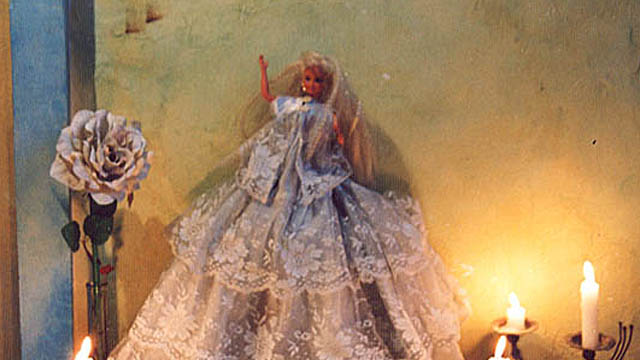
-
 Natalie Göltenboth
Natalie GöltenbothWhen I first entered Anna’s house1, I was surprised to hear that it was a temple of the Afro-Cuban Santería religion, a place determined by the presence of the orichas – the sacred beings of Santería. The objects of the interior did not reveal but seemed to hide their sacred meaning for the uninitiated viewer.
On our way through the house, Anna introduced me to a doll dressed up in white: Obatalá, the paternal oricha of wisdom and justice, with a cream cake on his right and a wide-eyed Bambi on his left. On the sideboard in the corner we greeted Yemayá, the maternal oricha of the sea, represented by a plastic bowl filled with water in which various floating animals swung and a Barbie, whose light blue lace dress complemented the turquoise colored water of the bowl. Finally, in a small wardrobe, the soup tureen of the goddess Ochún was decorated with two elegant Barbies in golden outfits, staring out of the darkness with their always flawless smiles. Two foreigners, charged with western ideals of beauty, who, in this context, had been commissioned with representing Ochún, the oricha of femininity, love and freshwater.
The representation or illustration of sacred powers through everyday objects, such as toys, dolls and knickknacks, have held a strong fascination for me since I literally stumbled upon them in Santero households, and, thus, the question of how this transference of powers and meanings to ultimately mundane objects could occur has long accompanied me on my fieldwork.
How can we interpret the fact that Ochún, the Afro-Cuban goddess of love and freshwater is visualized by a glittering Barbie doll sent to Cuba by Cuban family members living in the USA.
We should take a look back to the beginnings of the history of this religion for a better understanding of these dolls on the altars of Afro-Cuban Santería. Between the 16th and the 19th century, people were moved from one world to another on the sea routes of the transatlantic slave trade, which connected West Africa with the Caribbean (and this, in turn, with Europe), where they would henceforth work as slaves on the plantations of white landowners.
We should consider that people from Nigeria, Togo and Benin who had been deported to Cuba arrived in the New World without any luggage. The carved wooden sculptures of their gods, power objects, masks or costumes were left behind together with the African coastline. The transfer of religious concepts from Africa to Cuba, the Caribbean or Brazil, therefore, took place primarily in the minds of these people and remained dependent on this imaginative reservoir for long periods of time.
Despite the fact that the Cuban social anthropologist Don Fernando Ortiz2 still managed to collect some old carved wood oricha representations which had been produced during the colonial period in the 1930s to 1950s, the tradition of carving sculptures had not been resumed in the new situation in Cuba. The wooden oricha representations of Nigeria and Benin were replaced by smooth porcelain Madonna statues and the serious looking saints of Spanish folk Catholicism. Slaves from West Africa who were forced to worship the statue of Santa Barbara reacted with a phenomenon known as the syncretism of the Caribbean: statues of the Madonna and saints were interpreted as “reservoirs” of African deities and treated as such.
In the course of these syntheses, Santa Barbara is venerated as a representation of the virile oricha Changó, ruler of fire, thunderstorms and lightning. The Virgin of Regla, with her blue and white Madonna robe, is associated with Yemayá, the maternal oricha of the sea, and the Virgen de la Caridad del Cobre, in her church near Santiago de Cuba, is worshipped as Ochún, the oricha of love, creativity and sexuality. This possibility of reinterpretation, of “declaring something to be something else,” is tantamount to breaking the link between form and content and is the precondition for the unusual appearance of Barbies on the Santería altars.
As the colonial supplies in holy figurines diminished, colorful multiples of saints from Cuban mass production are found nowadays instead of the statues. Together with plastic dolls, Barbies or everyday objects, these new assemblages bear witness to the change of time and values, of new desires and new myths that move the people of Cuba today and are visualized on the altars.
Despite the fact that the connection of object and meaning has been blown up in modern Santería arrangements, it remains unclear to what extent new narratives are woven into the conception of the orichas when they are represented by new material objects: how much Madonna can one find in Yemayá, the oricha of the sea, and what is the relationship between a Barbie and an oricha? Referring to Marshall McLuhan’s3 famous statement that the medium is a significant part of the message, we can try a more specific interpretation of Barbies on Santería altars.
Original Barbie dolls are commodities acquired in stores in the USA and sent as gifts by relatives. As commodities and gifts, they mirror family ties that have continued over decades connecting Cuba and the USA, countries that have been politically separated since the Cuban revolution in 1959. In addition, Barbie dolls are not only saturated with the sacred aura of the orichas, they are also simultaneously encrusted with a fine texture of Cuban dreams of consumption and the feverish delirium of departure. Like Catholic saints, Barbies are figurines which are highly charged with their own narrative: the story of Ken and Barbie in the US American glamour world is a story of success, power and consumption. In this sense, Barbies on Afro-Cuban altars represent the fusion of idealized body and lifestyle imaginaries with sacred Afro-Cuban entities and deified ancestors. And, in the end, the forces of the orichas are conjured for reaching exactly these reasons: to provide their adepts with power that enables them to achieve their goals and realize their dreams – be they capitalistic or of another sort.
The reclassification of the Barbie doll from toy to altar object does not happen suddenly. The dolls have to undergo a transition process to become part of an altar installation. The dolls that appear on altars have been subjected to a ritual cleansing ceremony using decoctions of herbs associated with a particular oricha, which allows them to bear the vital power “Aché” of the sacred being. A bundle of herbs and other substances have been placed inside their bodies. Throughout these preparations, nothing has changed the appearance of the doll, which preserves its fashionable style and smile. What has changed is the idea about the object and hence its place – the Barbie is now part of a sacred altar installation.
Barbie dolls watch the strollers from the illuminated doorways that line the dark streets of Havana. Powerful representations of forces, imaginations, places and practices, connecting Africa and Cuba as well as Cuba and the USA, blending boundaries between dolls and gods, toys and power objects, commodities and sacred beings. They connect long-separated families and fragmented religious concepts. They guard the entrances of homes and watch over the desires of their inhabitants, who rely on the power of their Barbie goddesses.
Footnotes
1) Natalie Göltenboth. “Yemayá und der Spielzeugdampfer – Zur Sakralität der Ready-mades auf afrokubanischen Altären.” In Ideen über Afroamerikaner – Afroamerikaner und ihre Ideen. Beiträge der Regionalgruppe Afroamerika auf der Tagung der Deutschen Gesellschaft für Völkerkunde in Göttingen 2001, edited by Lioba Rossbach de Olmos & Bettina Schmidt. Marburg: Curupira, 2003, pp. 107-127.
2) Fernando Ortiz. Hampa Afrocubana: Los Negros Brujos. Miami. Universal, 1973.
3) Marshall McLuhan. Understanding Media: The Extensions of Men. 1st Ed. New York: Mc Graw Hill, 1964
References
- Brown, David H. “Thrones of the Orichas. Afro-Cuban Altars in New Jersey, New York and Havana”, African Arts, Oct. (1993) 44-87.
- Danto, Arthur C. Transfiguration of the Commonplace. A Philosophy of Art. Cambridge, Massachusetts: Harvard University Press, 1981.
- Göltenboth, Natalie.2020. „Invoking the gods – or the apotheosis oft he Barbie doll“ IN: Philipp Schorch, Martin Saxer et al. Exploring Materiality and Connectivity in Anthropology and Beyond. London: UCL
- Göltenboth, Natalie. “Yemayá und der Spielzeugdampfer – Zur Sakralität der Ready-mades auf afrokubanischen Altären.” IN: Ideen über Afroamerikaner – Afroamerikaner und ihre Ideen. Beiträge der Regionalgruppe Afroamerika auf der Tagung der Deutschen Gesellschaft für Völkerkunde in Göttingen 2001, edited by Lioba Rossbach de Olmos and Bettina Schmidt. Marburg: Curupira, 2003, pp. 107-127.
- Holbraad, Martin, and Morten Axel Pedersen. “Things as Concepts.” In The Ontological Turn. An Anthropological Exposition. Cambridge: Cambridge Univ. Press, 2017, pp. 199-238.
- Willie Ramos, Miguel. “Afro-Cuban Orisha Worship.” In Santería Aesthetics in Contemporary Latin Art, edited by Arthuro Lindsay. Washington: Smithsonian Press, 1996, pp. 51-76.
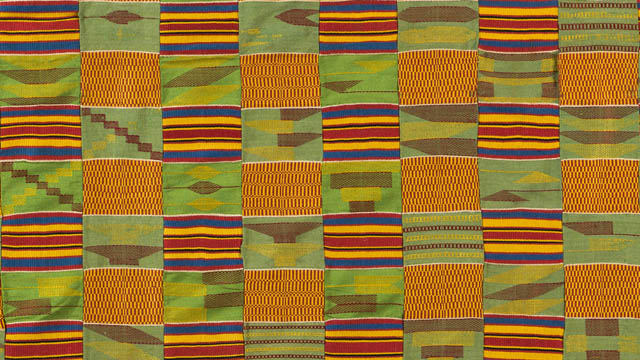
-
 Osuanyi Quaicoo Essel
Osuanyi Quaicoo EsselNoted for its attractive and bright colour schemes, a beautiful kente design is stuck on the walls of the entryway to the Permanent Exhibition of the African Collection at the Museum Fünf Kontinente. Its wide array of colours and strategic placement invites spontaneous spectatorship and captures into consciousness of visitors, the Afrocentric sense of colour use which is a precursor to the continental origin of the fabric. Indeed, kente originate from Ghana located on the African continent. Kente fabric designs have also gained international reputation and attracted considerable amount of research that centre on its historicity, weave structure, symbolic patterns, semiotic power, design structure, and its loom and the corresponding accessories, amongst others. Featuring the kente design in the collection by the curatorial team complements to drawing renewed attention to the indigenous fabric design technology of Africa.
Historically, kente has been known as a cloth which was a preserve for royals (kings and the chiefdom) in the Asante kingdom. It was later produced for use by all in the society. Being a fabric for royals, it signifies pride, wealth, power, authority and status of wearers. Though its usage extends to all, the kente designs worn by the Asante Kings are unique, distintive and of couture standard. The culture of adorning the Asante Kings with the top notch kente designs as in the ancient times has, therefore, not been eroded. In the court of the Kings were seasoned kente designers and weavers carefully selected to produce stunning kente design that are not found on the market. The fabric was woven with variously dyed handspun cotton yarns, in plain and double weave format in the form of stripes usually determined by their design structure. The stripes are joined together with the aid of a needle to form a wide sheet of fabric. The zigzag machine has become a replacement in joining the stripes together.
On the political sence of Ghana, the first president of the country, Osagyefo Dr. Kwame Nkrumah’s introduction of national dress agenda evoked the kingly use of the fabric in presidential inauguration ceremonies which has become a non-statutory policy emulated by six out of eight democratically elected presidents of Ghana from 1960 to present (Essel 2019). Nkrumah was the pacesetter in the use of kente in toga style for presidential inauguration in the history of Ghana. Prior to that he had worn kente fashion to political events and meetings in and outside Ghana before he became the president of the nation. His exemplary use of the Ghanaian fashion classic has been maintained and practised for more than half a century, though it is non-statutory.
Apart from its aesthetic clout, kente comes with symbolic patterns, whose decoding reveal the philosophical message encoded in the woven patterns of the fabric. Structurally, the kente fabric design featured in this exhibition encompasses variations of babadua, kaw, nkyemfre and fa hia kɔtwere Agyeman patterns, amongst others.
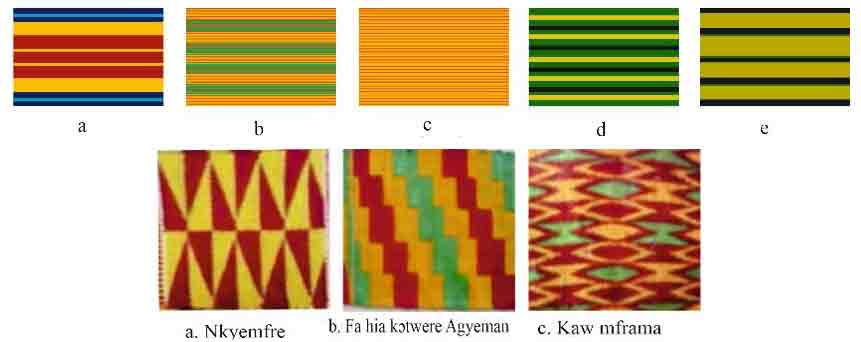
Figure 2: Top row: Variations of Babadua patterns. Bottom row: Names of some identifiable Kente patterns (Photo: the author)
Babadua is a name of a plant based on which the pattern was developed. The plant is noted for its strong look and resilience, perhaps a reason for its choice. Babadua, therefore, signifies strength, resiliency, formidability, firmness, superiority and power. These symbolic attributes of babadua is communicated by its wearer to observers. There are variations of babadua patterns used by kente designers (Figure 2). Some of the variations of babadua patterns are captured in the kente design (Figure 1). Nkyemfre (‘a pot shed’) pattern, depicted with alternating right-angled triangular shapes, symbolises history, recyclability and healing power, knowledge and service while Kaw mframa pattern derived from the physical characteristics of centipede, symbolises uniqueness. Fa hia kↄtwere Agyeman (literally translated as ‘lean your poverty on Agyeman’), arranged in the form of staircase in diagonals stands for hope, faith, sharing and benevolence (Essel, 2019). Combination of these observable kente patterns deftly arranged to communicate the idea of history, power, hope, pride, healing power, knowledge and service. The philosophical interpretation of kente designs could be informed by decoding its symbolical patterns. It could be observed that the variations of Babadua patterns dominate in the design (Figure 1). The dominance of this pattern informs the overall message embedded in the design. In this context, the fabric sings praises to the power and superior status of a king or chief in keeping intact the history and indigenous knowledge systems of the society.
Kente has become a prominent visual image and identity marker used in reference to the African continent. For instance congressional democracts led by Nancy Pelosi on June 2020 wore kente stoles to make political statement in pursuit of legislative goals of equality for Black people. This occured in solidarity of the gruesome death of the African-American George Floyed in the hand of white police and police brutality in the US. The kente fabric adorned by the lawmakers was used to signify African heritage and pride. During the 400th anniversary celebration of the arrival of enslaved Africans to America in 2018, the Congressional Black Caucus wore kente in paying allegiance to their African heritage. Kente fabric, therefore, has strong historical connections with Blacks across the globe.
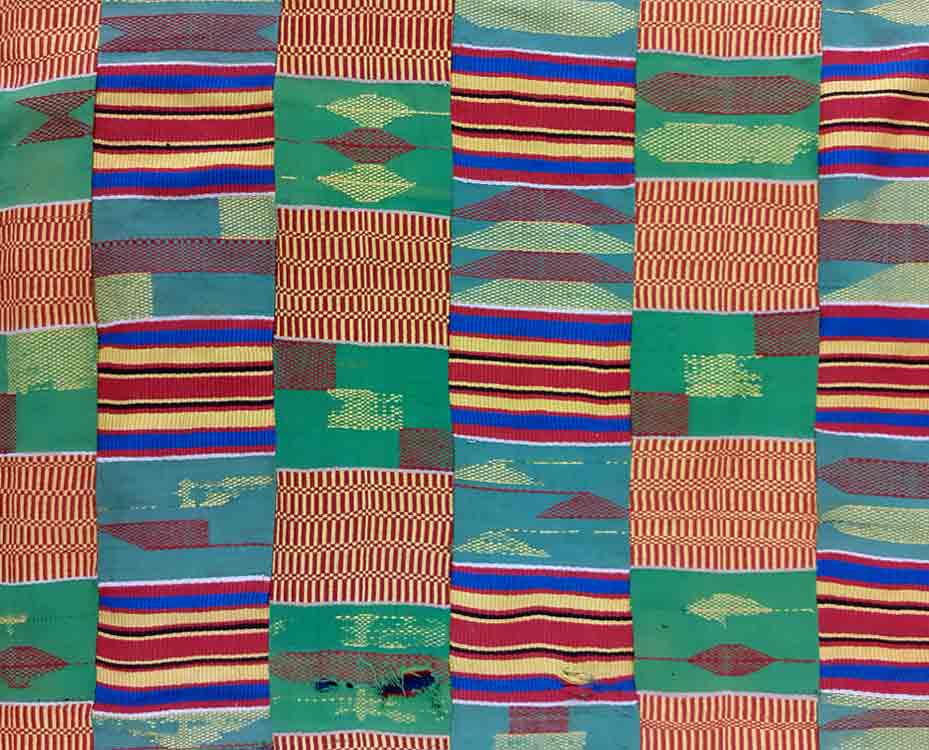
The Kente fabric in the depot of the Museum Fünf Kontinente © Museum Fünf Kontinente (Photos: Sophia Lubin)
Teaching and learning of kente fabric with the focus on history, sociocultural, political significance and educational relevance; improving the production technique for mass production purposes; improving of loom and its accessories; and alternate way of creating handmade kente print, among others, informed my teaching. Learners under my tutelage also explore appropriation of the symbolic kente patterns and engage in experimenting with kente designs.
published January 2021
Reference
- Essel, O. Q. (2019). Dress fashion politics of Ghanaian presidential inauguration ceremonies from 1960 to 2017. Fashion & Textiles Review, 1(3), 35 – 55.
This article is part of a gallery: Perspectives from Ghana on Museum Objects in Germany
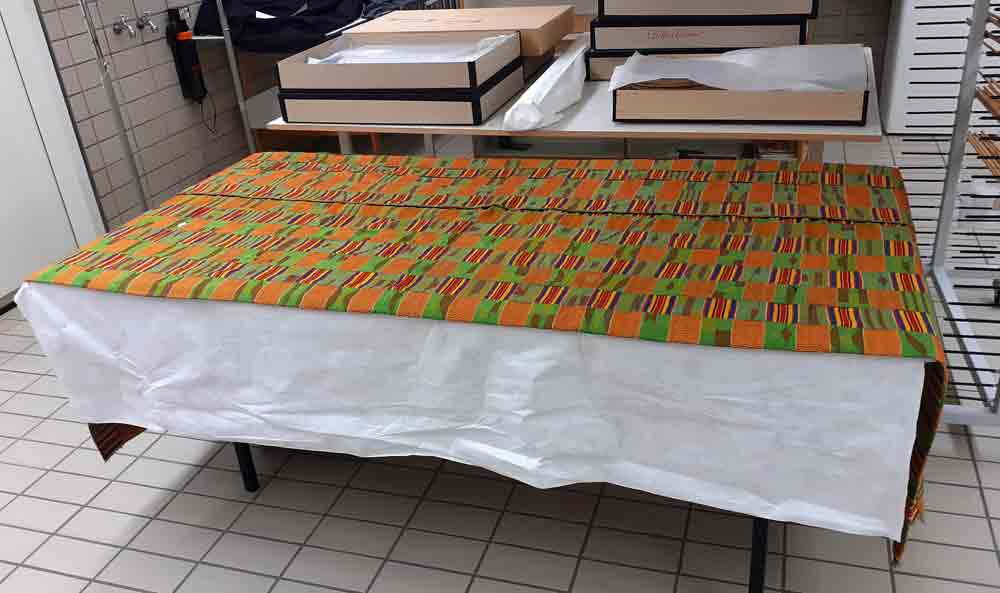
The Kente fabric in the depot of the Museum Fünf Kontinente © Museum Fünf Kontinente (Photos: Sophia Lubin)
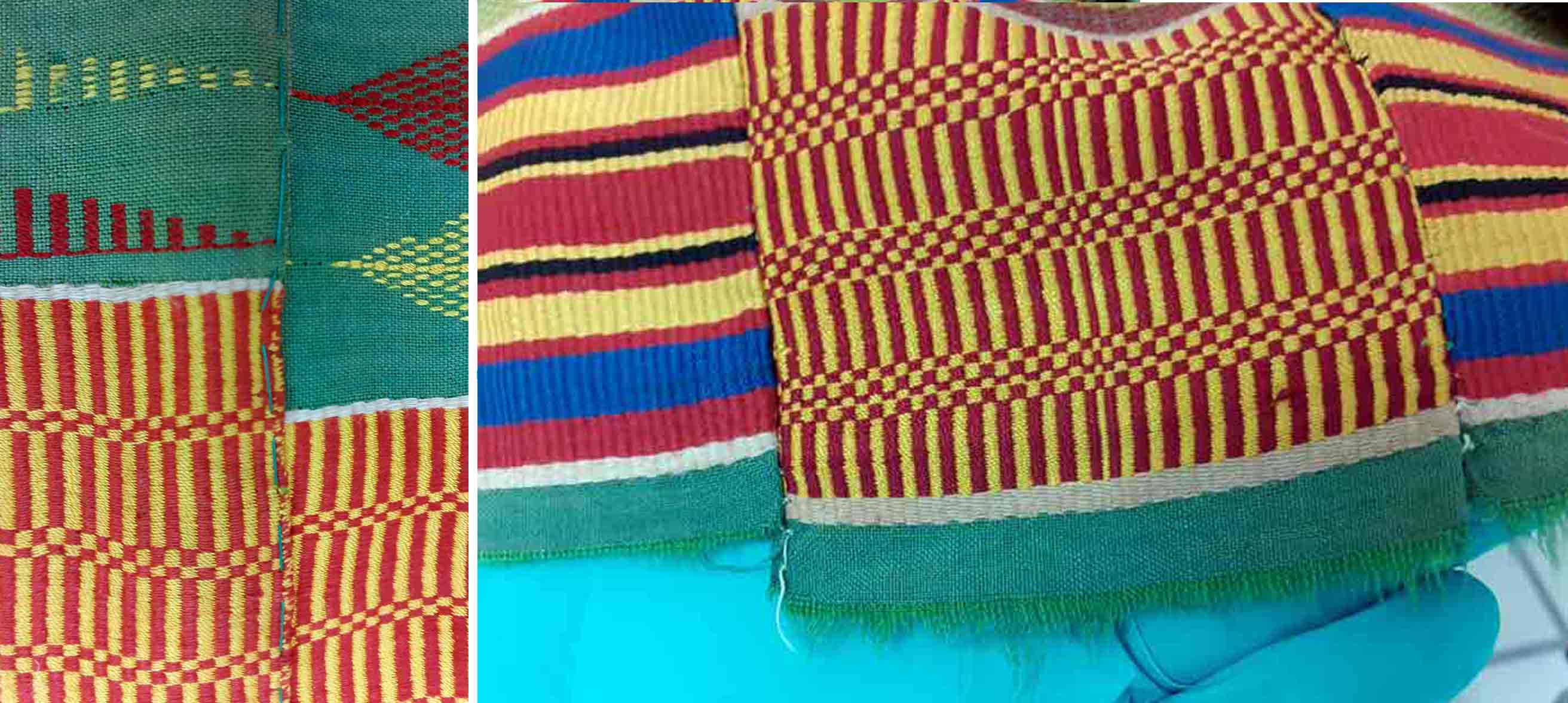
The Kente fabric in the depot of the Museum Fünf Kontinente © Museum Fünf Kontinente (Photos: Sophia Lubin)
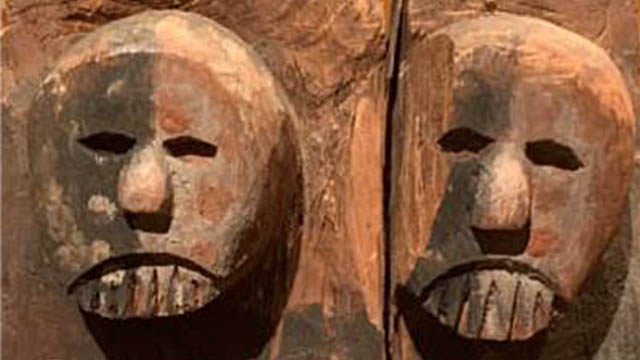
-
 Patrique deGraft-Yankson
Patrique deGraft-YanksonExploring an Enigmatic Piece of Traditional Cameroonian Sculptur
The Veranda Post found in Museum Fünf Kontinente is an exemplification of the extent to which indigenous Africans mutually reinforced socio-religio-cultural existence and expressiveness of form through sculpture. Various examples of these artefacts abound in the collections of African plastic artforms found in many museums across the globe. The beauty in experiencing, analysing and speaking about this artwork (as well as many of its kind), lies within the absence of authenticated historical and analytical literature on them. This makes it possible for the observer to exert complete authority of personal perception and interpretation devoid of any fixed attitude that dictates, interfere or curtails aesthetic enjoyments, interpretations and judgements, as attempted in this presentation.
With the dimensions of 199 x 60 x 50 cm, the Veranda Post found in Museum Fünf Kontinente is one of the numerous examples of the African artistic expressiveness, confirming the artistic prowess of the traditional African. Examples of these artefacts abound in the collections of African plastic artforms which record indigenous religious beliefs, practices and performances that date back from the beginning of African history.
As typical of most indigenous African sculptures, this work is not only uncaptioned, but the artist/creator is not known. What is known, however is that, its peculiar characteristics and style makes it easily identifiable and representative within the milieu of popular African sculptures. According to the Museum Fünf Kontinente records, this work was collected from 'Kamerun'. 'Kamerun' was an African colony of the German Empire between 1884 and 1916, which was located in the region of today's Republic of Cameroon (Wikipedia, 2020). Comparing the characteristic features of this sculpture with similar sculptures described by some art historians as Veranda Posts created as part of ancient African monumental architectures found in the Cameroons Grassland (Willett 1981) therefore, it is not difficult place it within that category. Hence its caption.
As can been seen from similar ‘posts’ and judging from the elaborateness of the images created on them, the major reason for the production of these posts was more to afford the sculptor or sculptors the opportunity to decorate the buildings with stories, rather than serving as supports (see figure 1).
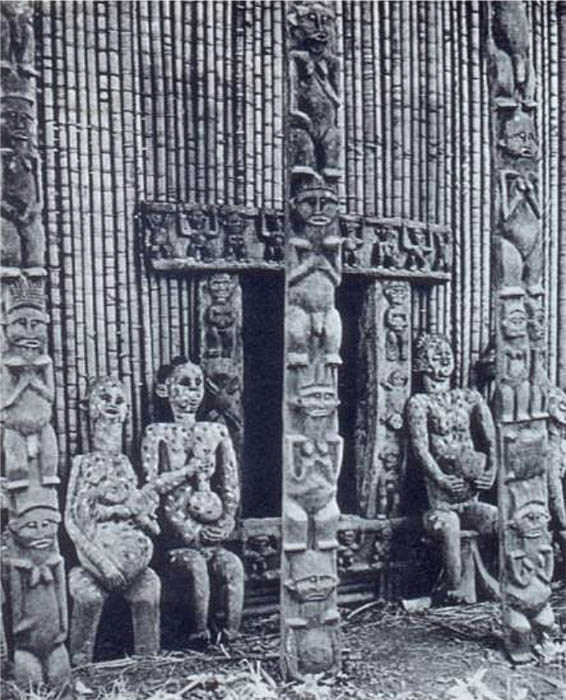
Figure 1: Ancestor statues, carved door-frame and verandah posts (Source: Willett 1981)
As said above, the beauty in analysing and speaking about this artwork (and many of its kind), lies within the absence of historical and analytical literature. The fact that this makes it possible for me (and for that matter any other observer) to exercise personal powers of perception and interpretation without any fixed attitude to direct or curtail their aesthetic interpretations and judgements made it my object of choice for this project at the Museum Fünf Kontinente.
Going by Margaret Trowell’s generalisations about African art, this Veranda Post can be classified under the ‘spirit-regarding’ art. Like many others of its kind, this work, which has front and back views, is flanked with human and other figures, ostensibly those of ancestors and is symmetrically disposed about a vertical axis, rendering it frontal at both sides.
Analyses of the images created on this pole reveal striking similarities between the age old traditional religious practices of the African and the Western religious beliefs and practices brought in by the earlier missionaries.
At the direct look of the object from the front (as it has been positioned at the museum, but actually one of its two sides), a prominent kneeling figure with hands clasped together unto the chest (much like the praying hand) can be seen in a pose that looks very much like the kneeling praying postures at Christian worships. To the African, this posture is not only assumed at prayer sessions as a visual image of submission to God’s authority, but is also exhibited as a sign of respect, humility and total surrender to a superior authority. For the sculptor to present the kneeling man as a central figure and subsequently rendering all other human figures in similar submissive postures therefore makes the theme of prayer, submissiveness and spirituality very strong in the composition.
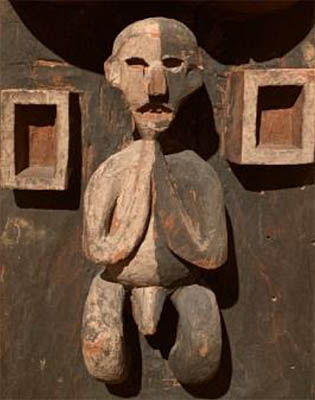
Figure 2: The kneeling or praying figure
The kneeling man is placed right below two human faces whose prominence and positioning easily pass them for elders, superiors, or better still, ancestors. Before the ancestors, all supplications are made, and through them, request are carried through to the supreme God.
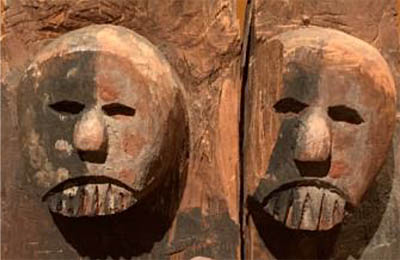
Figure 3: Ancestor figures
The importance of the two faces and emphasis on their superiority is further strengthened by a strong demarcation between them and the kneeling man through a thick rigid contoured line that forms a partition between the elements. This could be interpreted as a spiritual borderline that separate the spiritual world from the physical world. Generally, the African believes in the existence of the physical and the spiritual worlds as separate entities and this demarcation clearly depicts this belief. Also worthy of notice is the orientation of the demarcating border which rhymes with the praying hands of the kneeling figure, thereby visually connecting the figures. This carefully chosen placement of the two faces in the composition alludes to the supremacy of the ancestors and their exclusive existence in the after world as well as their connection with humans.
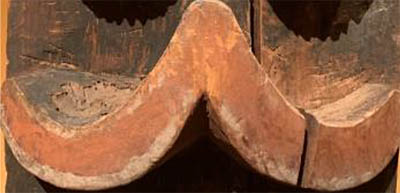
Figure 4: The spiritual borderline
Another striking imagery is created with the placement of a very visible image rendered in concentric circles. Among many African ethnic groups, the circle represents completeness, holiness, perfection and other such attributes ascribed to the supreme being (God). Among the Akan people of Ghana, for instance, the Adinkra symbol called Adinkrahene (king of Adinkra symbols) is presented as concentric circles. This symbol represents authority, leadership and charisma. The sculptor most likely created a bull’s eye of this symbol as an indication of exactly where this particular post belongs. The post could possibly be one of the furnishes for a palace or the abode of a traditional priest. This could also suggest the likelihood of the prominent kneeling figure being the King or the chief priest. Considering the atmosphere created by these symbols, the circle, with the kind of prominence it exudes could also represent the omnipresence of the supreme being, thereby heralding the people’s belief in the iniquitousness of God and His closeness to mankind.
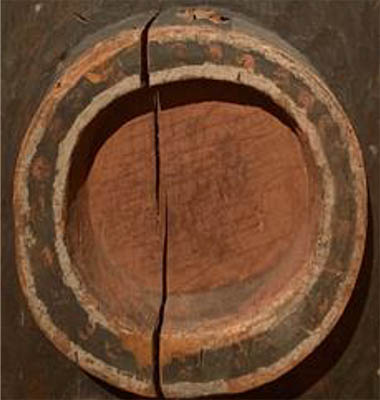
Figure 5: The concentric circles
Other recognizable images of animate and inanimate objects in the work include crocodiles, lizards and geometric shapes. Whilst it is likely that the geometric figures may have been deliberately presented to create balance, simulate a built living environment and arouse aesthetic sensibilities, the images of animals like those of the crocodiles have significant meanings as far as African culture and belief systems are concerned. Among some ethnic groups in Africa, crocodiles are believed to be the souls of ancestors who come back to live with men. Examples are the crocodiles in the Crocodile Pond at Paga in the northern part of Ghana who virtually live peacefully among the people. There are numerous African stories about crocodiles coming to the aid of men to either protect them or lead them to safety. Their inclusion in this particular work therefore is to establish the existence of spirits among men, especially as humans pray to seek their guidance and protection.
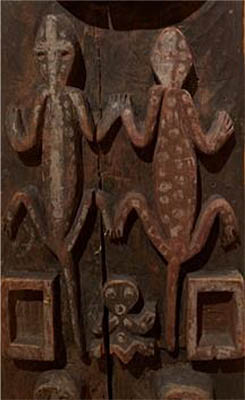
Figure 6: The crocodiles
Considering where it was created and where it is located now, as well as the current effort towards extracting a meaning out of its symbolism, this veranda post and many other such African artefacts in several museums around the globe have demonstrated how images and symbols resonate relationship between cultural practices around the world. The confluence of symbolic interpretations of the icons in the traditional African religions and the Euro-Christian religion, as depicted in this veranda post, gives justification to Africa’s unquestionable acceptance of Euro-Christianity and all the associated visual cultural practices.
For comparison, also read Karin Guggeis' analysis of this object here.
References
- Roy, C. (2019). Signs and Symbols in African Art: Graphic Patterns in Burkina Faso. Signs and Symbols in African Art: Graphic Patterns in Burkina Faso. https://africa.uima.uiowa.edu/topic-essays/show/38?start=13
- Wikipedia. (2020). Kamerun. Kamerun. https://en.wikipedia.org/wiki/Cameroon
- Willett, F. (1981). African Art. London: Thames and Hudson.
 ISB_Team
ISB_TeamThis 'Veranda Post' is variously referred to (mostly in relation to its architectural-functional context) lintel or "te ken dy dye" (in the local Bandjoun language - PHSAA), porch post, house front pillar, post, cult house post (M5K, p. 17), Cameroon post / family crest (Macke at M5K, 13, 24). Post, however, in the sense of sign (post-it) is suggested by PdGY to address the communicative function. Other designations do not address the function, but limit themselves to the given, perhaps to avoid any pre-interpretation: 'sculpted wooden block' (Kecskési 1999 n. 108) or 'large carved square wooden block' (Kecskési 1976, p. 22).
Object biography: The object was taken before 1893 by Max von Stetten during expeditions on the Bamileke Plateau (south-western Cameroon), where it was presumably part of a meeting house of a confederation. Stetten (1860-1925) was German commander of the Kaiserliche Schutztruppe for Cameroon until 1896. Cameroon was a German colony at that time. The exact circumstances of how the object came into Stetten's possession are unknown, as is its original location and context.[2] In 1893, the Royal Ethnographic Collection acquired the pillar as a gift from Stetten.[3] In 1912, a photograph of the pillar was published in the Almanac of the Blaue Reiter. It is currently on display in the permanent exhibition in the Museum Fünf Kontinente Munich in a niche - a mirror allows a view of the second side (see Fig. 2). Along with other objects from the collection, it is currently the subject of a transnational project on their provenance (GI).
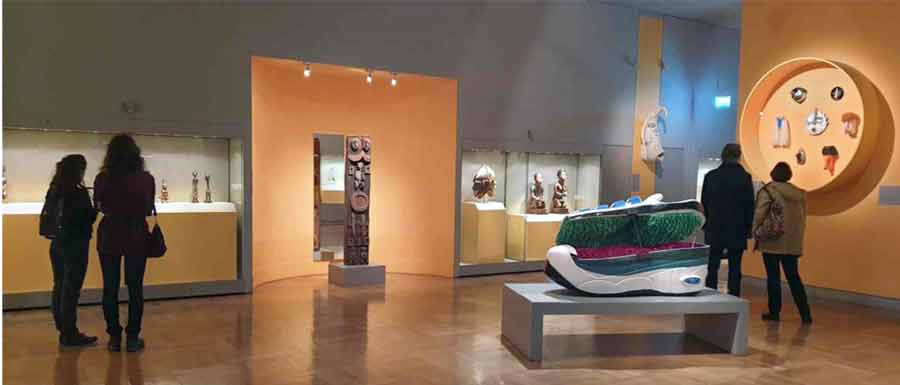
Fig. 2
Status: In comparison with carved mullions on façades of royal residences in the Cameroon grasslands (Fig. 3),[4] other mullions or door frames in the Museum Five Continents (M5K, p. 17, Kecskési 1999 No. 11, 70, 75) or in the Humboldt Forum Berlin, there is a partial similarity of motifs, but a strikingly 'archaic' formal language. Other examples are clearly more 'elaborate'. The multitude suggests that this type of pillar is quite typical of works from this period in this region of West Africa.
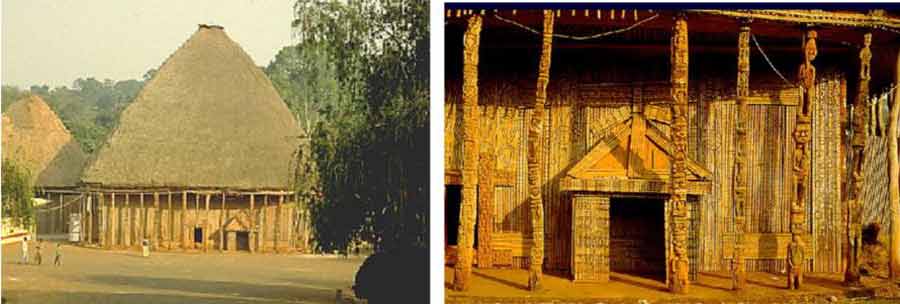
Fig. 3
Interpretation
The current view of the work
For the interpretation, the following questions lend themselves to art lessons: Form, iconography (meaning of the motifs), function, theme (or core idea) of the object, i.e. an interpretation.
With regard to the guiding idea of multi-perspectivity, two positions will be addressed: On the one hand, the view of today on the basis of ascertainable contexts, which seeks to understand the object from its time of origin and its context of origin. On the other hand, the view of the object by the artists of the Blaue Reiter. The comparison of these perspectives seems particularly relevant from an art didactic point of view, even though other perspectives would be conceivable, e.g. from the point of view of museology, provenance research, from the context of current restitution debates, etc. However, these are addressed in the teaching suggestions.
Shape
At first, the pillar develops an immediate physical presence for the visitor: through its sheer size (larger than life, almost square in plan), the materiality of the massive, cracked block of wood (the outline is irregular and probably corresponds to the tree) and the clear, concise, reduced language of form, whose meaning seems inaccessible. The surface treatment is archaic, the wood is more hewn than carved.[5] Thus it appears powerful and at the same time mysterious, which is supported by its presentation in the exhibition on a plinth and without glazing (see Fig. 4).
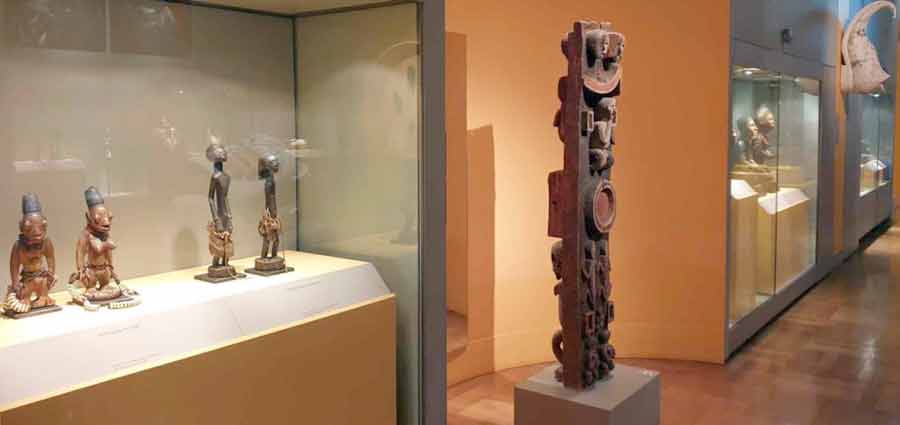
Fig. 4
A closer look reveals how the sculptor interweaves various modes of representation between complete abstraction (circle, rectangle) and representationalism (human figures, animals) in a compositional way[6] , monumentalising the individual motifs through internal symmetry, geometrisation, frontality and statics. This is supported by the painting (see Fig. 5). In this reduction, everything narrative is missing. The representation becomes emblematic, it becomes a symbol.
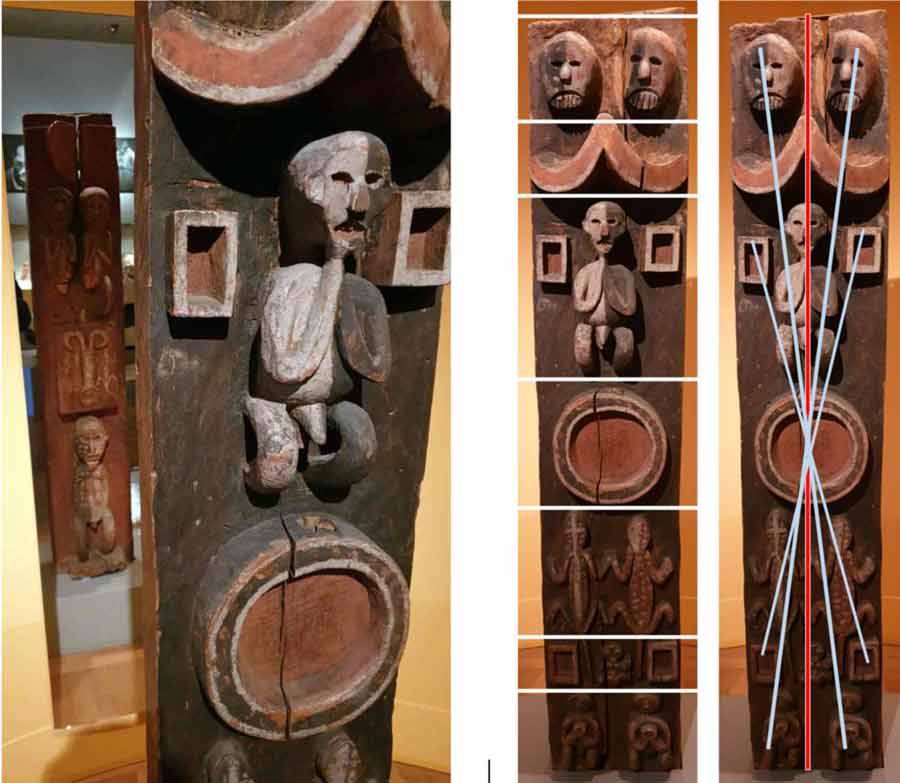
Fig. 5, 6 and 7
This is also supported by the overall composition, which obviously follows a calculated geometric order. It is strictly horizontally divided into individual zones, only once do lizard tails protrude into another zone. However, the separation into individual layers is ingeniously overcome compositionally by the strict axial symmetry in the vertical, but also by the point-symmetrical arrangement around the respective centres. The result is a tension between the contradictory compositional principles (see Figs. 6 and 7) that is decisive for the effect of the pillar.
The lack of any narrative on the one hand and the high creative effort on the other underline once again that it is about a symbolic level. This can perhaps be deciphered, even if its immediate complex order makes it seem above all direct, sensual.
The secure decoding of the iconography (what the individual motifs as well as the arrangement meant in the context of origin) is not possible with today's state of knowledge. Oral culture has left no written sources that could be consulted. Moreover, the oral tradition has been torn down - not least due to colonial destruction. However, since the work obviously has a symbolic language with clear iconography, this level cannot be left out in art lessons. German-language literature and oral experts from West Africa were consulted here. The results contradict each other, but nevertheless yield a court of meaning (see Fig. 8, in which the individual attributions of meaning are named)[7] , which provides a certain direction.
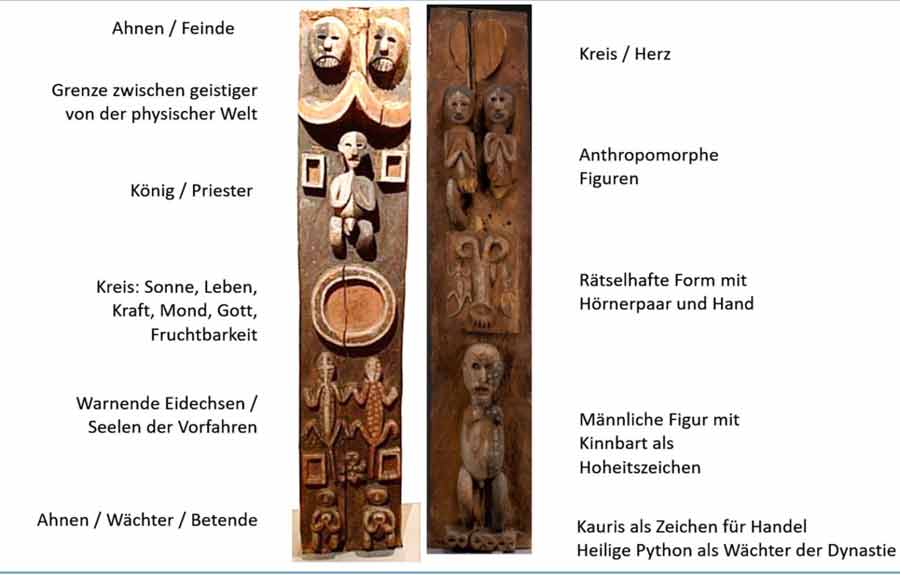
Fig. 8
In addition, the block is painted in three colours. These also carry meanings: Black could symbolise suffering, white could be the colour of the dead and symbolise mystery, red, the colour of blood, symbolises life (PHSAA). The light-dark contrasts themselves symbolise life and death (Kecskési 1999).
Function
PdGY suspects that the pillar - as part of the architecture of the house - stood at the spatial interface with the public (on a path) in order to communicate the significance of the house, presumably a cult house, to the outside. The object could therefore have been part of the façade of a particularly distinguished house[8] , also with a supporting function for the roof. It communicates what happens in the house or who lives or resides there.
Kecskési, on the other hand, considers a free positioning in space (Kecskési 1976, p. 22) and suspects an ancestral tablet. This in turn would fit the following determination by Gouaffo: "The 'Blue Rider Post' is a spiritual object. According to oral traditions, the object was placed in the sacred house like a statue. Caps, chains, bags or skeletons could hang from the object. Secret societies like the 'Losango' used the statue to perform certain rites, for example to cleanse the village of evil spirits." (Albert Gouaffo in GI) KG also suspects the context of a meeting house of such a secret society. Common to all assumptions is that the pillar stood in the context of a house with a sacred or cultic function.
'Theme' of the object: Basically, three different levels can be delimited, some complementary, some contradictory. First, the communication function on the façade or at the entrance to the outside. Then the pictorial formulation of a certain understanding of human being-in-the-world is asserted; man is ultimately embedded cosmologically.[9] At the Humboldtforum Berlin, in turn, such pillars from West Cameroon are also seen as the "architecture of power", power exercised by the rulers or the secret societies through impressing and deterring.[10]
Second perspective
The interpretation provided above can be countered by a second perception of the pillar, as it appears in the almanac "Der Blaue Reiter". This almanac, an artist's book, was published in 1912 by Franz Marc and Wassily Kandinsky. The reception of this book is over a hundred years old, but it is significant for the development of European art, as it is a good example of how artists of this time created a new frame of reference by referring to non-European art. In this respect, the Blaue Reiter clearly differs from Cubism, Expressionism or Dadaism, which were all being developed at the same time.
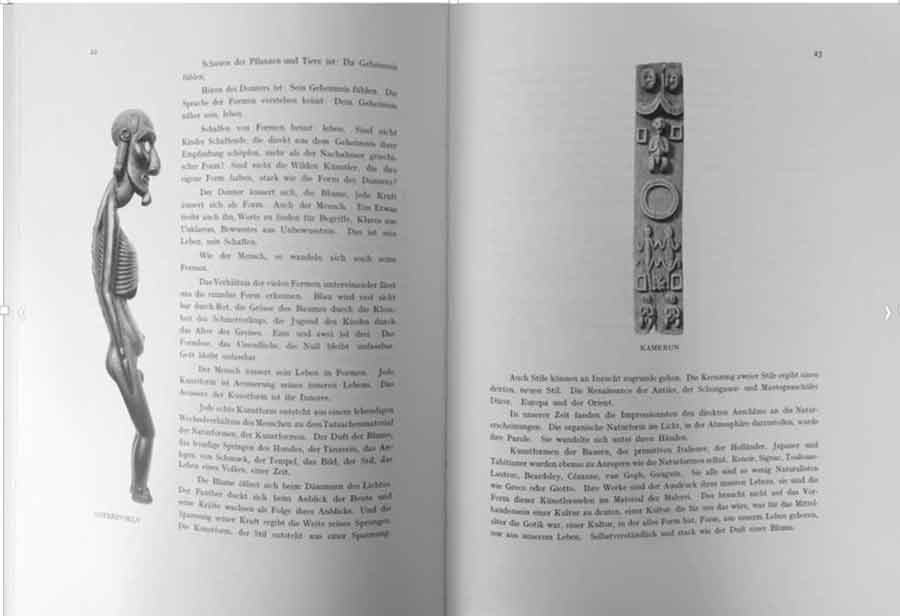
Fig. 9
In the Almanac, on pages 21 to 27, there is an essay by the painter August Macke entitled "Die Masken" (The Masks), in which a relatively small illustration of the pillar in question is embedded (see Fig. 9). Macke's contribution, like all the other texts in the Almanac, was probably written at a joint meeting of Macke, Marc, Münter and Kandinsky in Murnau.[11]
Visits to ethnographic museums are documented above all for Wassily Kandinsky, who was a trained ethnologist, and Franz Marc. Marc had also admired sculptures from Cameroon in particular during his visit to the Berlin Ethnographic Museum in 1911. And it was he who was ultimately responsible for the insertion of the photograph of the post in Macke's article.[12] In his letters to Macke, Marc writes about this. On 14.1.1911 about the objects from Cameroon in the Berlin Ethnological Museum: "I remained amazed and shaken by the carvings of the Cameroonians"; and later that he would furnish Macke's article in the Almanac with "ethnographic wonders" (MW).[13] In the text itself there is a single, very brief reference to "carved and painted pillars in a Negro hut", by which presumably the post was meant.
The text itself represents Macke's conception of art. In it, "intangible ideas", "mysterious forces", an "invisible God" express themselves in the world of appearances and "cultic expressions". The invisible materialises in the visible. This realm of the visible includes not only art, such as that of Giotto or van Gogh, who are classified as 'primitive', but also nature. Children's drawings, the folk art of the 'primitives' and 'savages' or non-European cultural forms are also expressions of the mysteriously invisible. These themselves are - and this is decisive - equal to each other. There is no hierarchy, no distinction between high and low, between high art and popular culture. All forms speak - as Macke characterises it - in "strong language". For Macke, the pillar in the museum is then an example of "the tangible form for an intangible idea, the personification of an abstract concept" (Macke 24). He also calls this the figure of an "idol".
The approach underlying this thinking sounds familiar; we have known it since the Platonic theory of ideas. However, this approach does not justify the selection of this particular post, as other posts from the museum's collection would also have been available.[14] Here one can only assume. I suspect that there are various factors that led to the selection: the archaic power of the forms; the initially wild and carefree-looking, additive combination (or montage) of the various principles of representation in the individual motifs (concrete - abstracted, geometric - organic, symbolising - depicting), which on closer inspection, however, then reveals itself to be consciously composed; or the coarse, physically perceptible materiality of the cracked, thick block of wood in impressive dimensions. PdGY also speaks of "wonderfully composed".
In the work, everything is represented with great sensual power that is the opposite of an "empty" image in European "cultures that have already passed through a thousand-year course, like [...] Italian Renaissance" (Macke 24) and from which Macke renounces: "We must bravely renounce almost everything that has hitherto been dear and indispensable to us as good Central Europeans [...] in order to get out of the fatigue of our European lack of taste". (Macke ibid.)
In art lessons, the question arises to what extent the image that Marc or Macke create of the pillar (as representative of the idea of an idol) goes together with what the object presumably was and is in its original context. Or to put it another way: are they designing a certain, exotic image that does not correspond to the object itself? [15]
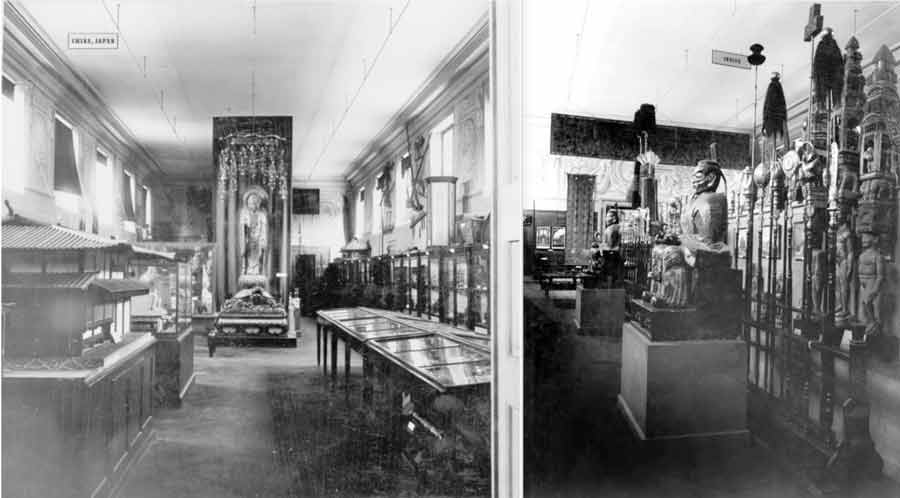
Fig. 10 Historical photos of the exhibition of the India Department in the Munich Museum around 1910 (source M5K)
References
- GI: Juliane Glahn and Marta Krus: CAMERUNS RIGHT TO CULTURAL OBJECTS. https://www.de/prj/zei/de/pos/22656808.html
- Kecskési 1999: Maria Kecskési. Art from Africa - Museum of Ethnology Munich. Munich (Prestel) 1999
- Kecskési 1976: Catalogue for the exhibition African Art. Andreas Lommel (ed.). Munich (Bruckmann) 1976
- M5K: Staatliches Museum für Völkerkunde München (ed.). The Blaue Reiter and the Munich Museum of Ethnology. Munich (Hirmer) 2009
- KG: Karin Guggeis. The Blue Rider Post. (2021): https://www.explore-vc.org/en/objects/expanding-the-canon-of-art-at-the-global-north.html
- PdGY: Patrique deGraft-Yankson. The Veranda Post. (2019) https://www.explore-vc.org/en/objects/the-veranda-post.html and oral interview on 23.4.2022 in Bayreuth, Iwalewahaus.
- PHSAA: Paul-Henri Souvenir Assako Assako. Information by email 20.5.2022
- Wikipedia: Cameroon & Max von Stetten
- MW: Macke Wolfgang (ed.). August Macke - Franz Marc: Briefwechsel, Texte und Perspektiven. 1964. Cologne (DuMont).
- Macke: Macke August. The Masks. In: Almanac "Der Blaue Reiter", 1912, edited by Franz Marc and Wassily Kandinsky, pp. 21-27
Appendix on iconography
- Anthropomorphic figures: ancestral couples / guardians and protectors of the royal residence. These anthropomorphic figures are treated with respect as extraordinary personalities. They are considered ensouled beings, spirits with supernatural powers. (PHSAA) Depiction of all human figures in similar postures: theme of prayer and submission to spirituality. (PdGY)
'Front' side from bottom to top:
- Two people: Ancestral couples / guardians and protectors of the royal residence (PHSAA). People pray for the guidance and protection of the ancestors (PdGY).
- Lizards: The symbol of the lizard warns everyone; it symbolises death. (PHSAA) PdGY sees here two crocodiles (ancestral souls returning to live with humans) instead of lizards.
- Circle: motif of the sun, symbol of life and power; the moon, image of woman and symbol of fertility. (PHSAA) The circle represents completeness, holiness, perfection and other attributes attributed to the supreme being (God). (PdGY)
- Kneeling figure: King or priest (PdGY)
- Line of demarcation between the spiritual and the physical world
- Two heads above: Ancestors (PdGY)
'Back' side from bottom to top:
- Python (geometric frieze at the bottom of the 'back' side): royal totem/sacred python, guardian of the dynasty (PHSAA).
- Male figure with chin beard as emblem of sovereignty (Kecskési 1999)
- Enigmatic form with a pair of horns ending in a hand (?) at the bottom (Kecskési) on a rectangle with two flanking lizards.
- Anthropomorphic figures
- Circular area
Footnotes
[1] The object is variously referred to, mostly in relation to its architectural-functional context: lintel or "te ken dy dye" (in the local Bandjoun language - PHSAA), porch post, house front pillar, post, cult house post (M5K, p. 17), Cameroon post / family crest (Macke at M5K, 13, 24). Post, however, in the sense of sign (post-it) is suggested by PdGY to address the communicative function. Other designations do not address the function, but limit themselves to the given, perhaps to avoid any pre-interpretation: 'sculpted wooden block' (Kecskési 1999 n. 108) or 'large carved square wooden block' (Kecskési 1976, p. 22).
[2] The first German trading posts were established in Cameroon as early as 1868, and in 1891 German military "expeditions" were launched in Cameroon. In 1884, the German Consul General concluded protection treaties with regional rulers and thus proclaimed the protectorate of Cameroon as a German colony. The seizure of the hinterland, which included the grasslands, took place over the course of the following 30 years. (Wikipedia) Even if the provenance is still not clear today, one can certainly share the Humboldt Forum's assessment of such objects that - even if they were not looted through acts of war - they are nevertheless "an expression of unequal power relations and structural, colonial violence". (https://www.smb.museum/nachrichten/detail/ethnologisches-museum-weg-frei-fuer-die-rueckkehr-der-ngonnso-nach-kamerun/)
[3] In the entry book it is noted: "Gr. square block, 1.80 cm high made of heavy wood, carved on both sides with humans and lizards, heavily damaged by termites". (https://onlinedatenbank-museum-fuenf-kontinente.de/) In 1895 Stetten published detailed "Travelogues" in the Deutsches Kolonialblatt.
[4] http://www1.biologie.uni-hamburg.de/b-online/afrika/kamerun/palast.htm; http://www1.biologie.uni-hamburg.de/b-online/afrika/
[5] The block is almost certainly worked with a chisel.
[6] "decorated with geometric, anthropomorphic and zoomorphic forms" (PHSAA)
[7] All performers avoid a complete decoding. They only make suggestions for individual motifs.
[8] It could have been the house of a 'priest' whom one could consult there and through whom or ancestors one could pray to God (PdGY).
[9] "Expression of the cosmogony of the universe of the peoples of the Bamileke plateau; expression of the belief system" (PHSAA).
[10] The assertion of power is also included by PHSAA.
[11] Catalogue: August Macke, Lenbachhaus Munich, 1987, Bruckmann. Munich. S.164
[12] He simply titled the painting "Cameroon", the name of the country of origin (the country whose sculptures he admired).
[13] There are other illustrations in the text: a bird's head from Brazil, a figure from Easter Island (see Fig. 9), one from Mexico, a bird mask from New Caledonia, a cloak from Alaska[13] and a child's drawing entitled "Arabs". Except for the child's drawing, all objects are from the then Royal Ethnographic Collection in Munich (M5K, p.11). They are only titled with the respective country of origin, e.g. Cameroon. Macke was obviously involved in the selection as well as the layout, as his layout sketch shows (M5K 24).
[14] It is not certain what was shown in the presentation at the Royal Ethnographic Collection in Munich at the time, which covered 400 square metres in six rooms in the north wing of the Hofgarten arcades in Munich. The only thing that is certain is that photos of the ten objects depicted, which came from various parts of the world, were lent to the artists for the publication of the Almanac. Photos of the presentation do not exist. "Whether Marc and Macke [actually also] saw the work in the exhibition at that time can be assumed with a high degree of probability, since it is after all very large and thus impressive." (Information Karin Guggeis 26.7.2022)
[15] In this context, it seems of interest that neither Marc nor Macke take up in their own pictorial language the aesthetics of the non-European works they "celebrate" here.

-
 Ernst Wagner
Ernst WagnerIt is a small but powerful image. This power is based on its pictorial conciseness, its artistic quality. My reflection on the woodcut is based on a suspicion. Obviously, its message is problematic. At the beginning of the modern era in Europe, it formulates a worldview that has had great influence and fatal consequences to this day: the destruction of diverse nature and culture in the course of the anthropocene and colonialism.

On the left construction of the horizon and vanishing point, on the right with the viewer inserted (visualisations by the author)
With the help of this grid, he succeeds in creating a way of convincing representation, an interpretation that photography (invented almost 400 years later) would also deliver. I.e. a representation that is ‘correct’ in terms of perspective.
The woodcut itself also follows this principle of ‘correct’ linear perspective. The horizon is marked as the sea horizon in the right-hand window; the vanishing point of the grid lying on this horizon. This vanishing point also assigns a specific, clearly determined space to the viewer's eye. It is at the same height as the depicted artist, and on the right, the ‘male side’ of the image. In this way, the viewer is not only a witness to the event, but also a confidant and accomplice of the drawer / the artist.
In terms of composition, the symmetrical layout is particularly striking. As in a coat of arms, we see two equal-sized fields on the left and right, divided by the grid frame. In both parts, two windows, also of the same size - each with a view to the outside.
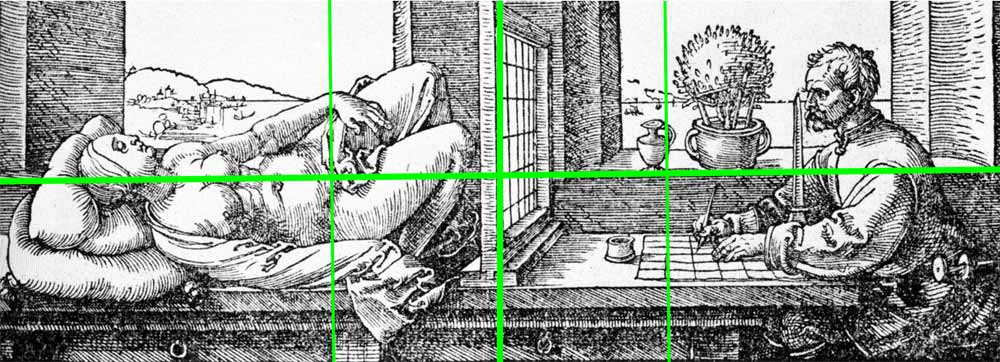
Subdivision according to centre lines, additionally thirds. The vanishing point is on the right perpendicular.
In the left part of this emblematic image, the woman. The flowing cloth emphasises her nakedness rather than covering it. She is bedded on soft cushions, 'lying according to the artist's will' (to speak with Dürer in his accompanying text). Her raised lap turned towards the man, her eyes look closed, her left hand rests on her thigh. The table on which she lies works as a presentation plate.
Dichotomies
With this composition, the image formulates an almost striking dichotomy. To name just a few aspects that are particularly significant in our context:
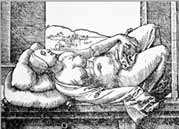
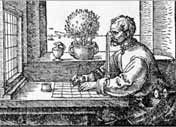
- Woman: naked and thus ahistoric, i.e. "timeless", with closed eyes and diffuse spatial orientation.
- Man: clothed and armed, watching closely, focused on the woman in front of him.
- Woman: In her passivity she has a powerful presence in the picture; she is - lying - the theme (the
- Man: He is actively engaged, sitting, taking action. He is an individual
- In the window: 'free', lively nature.
- In the window: reduced nature, mostly just the horizon line.
- Tall, naturally growing trees outside in the open air.
- One small, domesticated and cultivated 'tree' in a pot, indoor.
This dichotomy is not only emphasised by the narrow format and the symmetrical layout, but above all by the clear separation of the two ‘worlds’, which is achieved by means of the grid frame, i.e. an important tool in (Dürer’s) art. This again cements the structure of distance established by the artist: On the right, the male attention to the woman is conceived as (and through this reduced to) distanced looking and the spellbinding drawing of what he sees. The woman, on the other hand, presents herself - against a lively backdrop - as the ‘target object’ behind the frame. In this way, however, it is not only the clichéd gender roles being fixed, gender roles as they will be significant throughout the next centuries. But there is more at stake.
Panofsky had characterised this kind of linear perspective "as a symbol of a beginning, when modern anthropocracy was setting itself up" (1980: 126). That perspective initially puts the world at a distance. Above all, it opposes ‘subject’ and ‘object’ to each other in a clearly separated way. The aim of this procedure and the underlying model of thinking is to make the world 'calculable' in a 'modern' way: At last, even in a picture, one can say whether a line, a shape is right or wrong. The world is thus degraded to a supplier of 'appearance data' (Rebel 1996: 198). The data selected are now recorded - through a technical procedure - by the isolated and disembodied eye. In this process, the eye is the representative of a specific 'pictorial intellectuality'. Dürer emphasises: "the eye is the noblest sense of all" (Rebel 1996: 200). This gives the rational mind the decisive role, which becomes the ‘signature’ of the Renaissance. And, perspective is its symbolic form, its paradigm. Linear perspective represents "the world as it can be in the idea alone. It constructs the world" (Belting 2008: 27) according to cognitive principles.
In the woodcut, this rational, intellectual way of seeing belongs to the man. The woman, on the other hand, has her eyes closed, she does not look. (She is looked at.) With regard to the anthropocratic claim of the (male) rational mind, woman (as a sensually tangible allegory) thus becomes the indeterminate, unmarked “Other” (Latour 2017: 38). Ultimately she becomes the representative of the natural: she is naked, ‘as nature created her’ and thus timeless, i.e. untouched by a specific contemporaneity. She must - in order to become visible - be 'captured' by the man on the right, who has an individual face and is dressed in a contemporary manner.
Above all, the specific form of relationship of the two sides to each other are decisive for our question. As already shown, we find here a clear subject-object relation. The man (who represents civilisation, culture, the domestication of nature) is the active, acting, looking, mentally grasping subject who now ‘subjects’ the woman as a passive object to his artistic appropriation (and through this the 'naked', non-civilised nature that is embodied by her).
Latour points out that this conception is specifically European: "What occidental painting invented [...] and of which no trace can be found in any other civilisation" (Latour 2017: 38). From there, there is an striking parallel to the conquest of the "New World" by European powers in colonialism, as the image below shows.
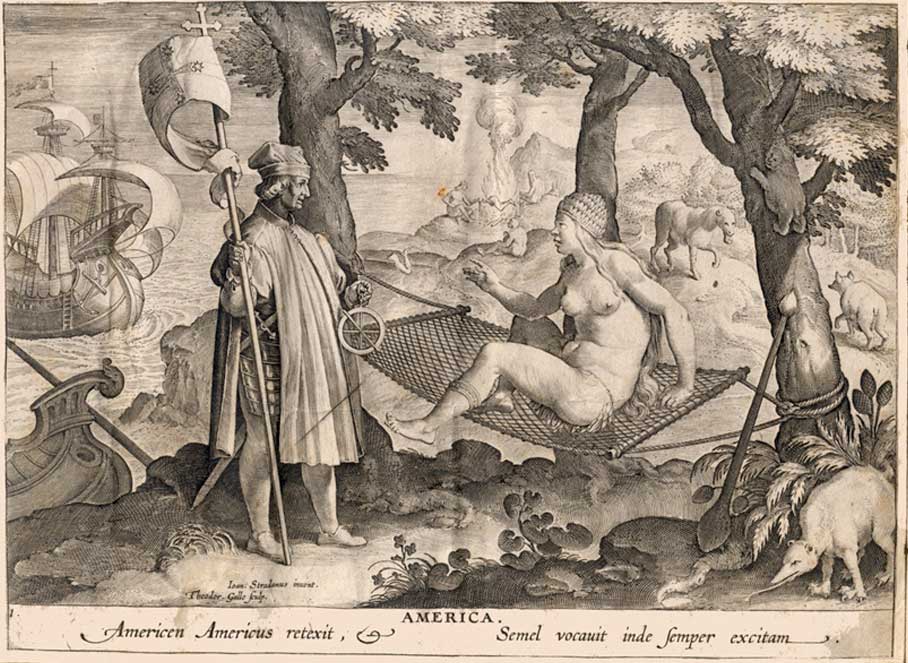 Theodor Galle/Jan van der Straet. Vespucci discovers America.1589. (https://www.deutsche-digitale-bibliothek.de/item/C6QXUXQLVIKAIVADBOAJ7ZM3WXLWTVT5)
Theodor Galle/Jan van der Straet. Vespucci discovers America.1589. (https://www.deutsche-digitale-bibliothek.de/item/C6QXUXQLVIKAIVADBOAJ7ZM3WXLWTVT5)References
- Belting 2008: Hans Belting. Florenz und Bagdad – Eine westöstliche Geschichte des Blicks. München (Beck)
- Latour 2017: Bruno Latour. Kampf um Gaia. Berlin (Suhrkamp)
- Panofsky 1980: Erwin Panofsky. Die Perspektive als „symbolische“ Form. In: Erwin Panofsky. Aufsätze zu Grundfragen der Kunstwissenschaft. Berlin (Volker Spiess)
- Rebel 1996: Ernst Rebel. Albrecht Dürer, Maler und Humanist. München (Bertelsmann)
- Zur Lippe 1981: Rudolf zur Lippe. Naturbeherrschung am Menschen. Bd. 1. Frankfurt (Syndikat)
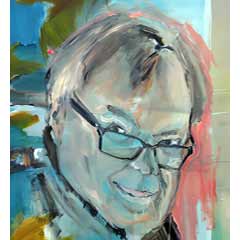 Johannes Kirschenmann
Johannes KirschenmannThis small-format woodcut by Albrecht Dürer from his book on perspective shows a sleeping woman, which is modelled on the motif of a Venus in Italian Renaissance painting. While two windows, typical of the Renaissance, provide a view of the vast landscape outside, a third ‘window’, the grid, leads the artist's gaze to the woman's intimate zone. The woodcut thus shows far more than a perspective construction: the male artist, as creator, seeks to capture his divine ideal in a construction. He keeps distance and pretends to give an objective view. Opposite him lies the partly naked, partly clothed ‘Venus’, who can be both a sign of purity and a sign of sin. In the innocent state of sleep, she has nothing to hide and stands for the much-cited ‘naked truth’.
This constellation gives rise to a speculative interpretation of the relationship between artist and woman, between draughtsman and model, between gaze and desire: "The wooden frame is positioned between the draughtsman and the woman. Not an opaque wall, but a grid and transparent. But precisely because of this, it creates a dichotomy, or at least supports it, the division of the one space in which both are. This creates two separate and oppositely charged areas. It seems as if the libidinal current between woman and man and man and woman is cut off by the apparatus of the visual grid. It obviously only lets through the visual rays, those of the draughtsman, with which he 'studies' his counterpart, his object. The woman keeps to herself with her body and the man keeps to himself with his activity.
In effect, the possible object of the male desire has become the object of an artistic investigation of nature. An activity that is borne by a sublimating activity and transformed into a form in which the sensual desire of the man is transformed, partly abolished, eliminated. [...] Desire only becomes visible to the person looking at the image, to the (male) viewer. He finds himself in a voyeuristic predicament. Is she not lolling around for him? The forces of seduction rejected by the grid are now directed at him. The man at the end of the table can be forgotten. He has other things to do. His occupation does not affect the erotic desire that could build up between the voyeur and his object. A completely different form of relationship that the male gaze there, the male gaze here, takes up."[1]
[1] Dürer, Zeichner. ungleichzeitig gleichzeitig. http://wegvonwegen.de
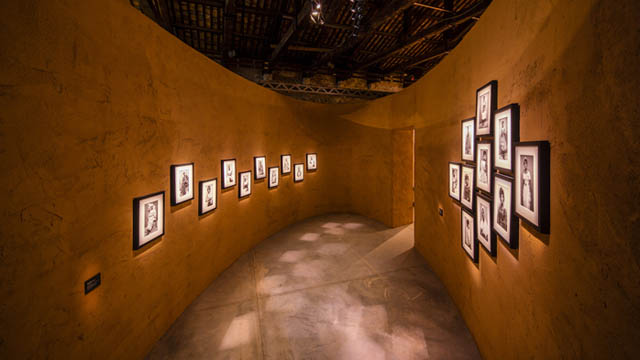
-
 Kwasi Ohene-Ayeh
Kwasi Ohene-AyehThe Ghana National Pavilion at last year’s 58th International Art Exhibition of La Biennale di Venezia served to augment the fervent energy of contemporary art already simmering in its locality. The Pavilion staged a stellar intergenerational selection of six “multi-local”1 artists from Ghana— Felicia Ansah Abban, El Anatsui, John Akomfrah, Lynette Yiadom-Boakye, Selasi Awusi Sosu and Ibrahim Mahama— whose works range between photography, painting, film, video, and installation. Stationed in the Artiglierie within the Arsenale, the Pavilion displayed the artists' works in continuous cylindrical enclosures designed by architect David Adjaye, and executed with laterite soil couriered from Ghana. The nation’s debut outing at the Biennale, titled Ghana Freedom, summoned the “boundlessness” and euphoria in the spirit of self-determination promised in its mid-century Independence moment and epitomised in such cultural events as the World Festival of Black Arts— the first being Festival Mondial des Arts Nègres (FESMAN) which took place in 1966 in Dakar, Senegal, and then the Festival of Arts and Culture (FESTAC) which happened in Lagos, Nigeria, in 1977. “There is no longer any need to look back in the same way as an act of reclamation or reaction”, writes the curator Nana Oforiatta Ayim, since “these pathways remain with us and evolve”(Ayim, 2019, pp. 31).
The emancipatory ideal summarised in the titular of the exhibition is a poignant basis for this evolution given the colonial mediation of Ghana’s formal education in general, and art education in particular (seid’ou, 2014; seid’ou, 2016). In this regard, Ghana Freedom could be said to have countenanced an approach to the practice of art that is unconstrained by the de-contextualised imposition of the beaux-arts tradition which became ingrained through colonial instruction in the Gold Coast (pre-independence Ghana) from the late-19th century to the late-1950s, and which prevailed in the postcolonial mediation from then till the first decade of the 21st century. Exhibitions of this dispensation predominantly lacked curatorial direction. Indeed, the Ghana Pavilion, however obliquely, can also be said to have announced the inventiveness of emergent exhibition practices in the country. For example, Ibrahim Mahama’s early site-oriented and itinerant exhibitions in public places is a pragmatic and critical response to the derelict infrastructural conditions an art practitioner in the country has to contend with. Mahama’s attitude to this systemic neglect is traceable to the interventionist ethic and affirmative politics of blaxTARLINES KUMASI.2
It goes without saying that the spectacular occasion of the Pavilion accumulates cultural capital for the nation in asserting a compelling place and reputation as far as the global mainstream of art is concerned— more especially for a nation which has been treated as a footnote in literature on the history of art in Africa. It is therefore our task to, so to speak, “brush history against the grain” (Benjamin, 1969, pp. 257) by practically intervening in it through such exhibition making ventures. In this vein, the success of the Pavilion highlights two major points for discussion.
The first is a dialectical situation. At a time when cultural institutions and producers are enduring famishing conditions as far as state support or infrastructural systems are concerned, the state has demonstrated that it is possible to alter this fate— seeing as the Ministries of Finance and that of Tourism, Arts, and Culture, respectively supported and commissioned the Pavilion. But now that the impossible has happened, one would have thought that prioritising a National Pavilion would pave the way to launch serious longterm cultural policies ensuring continued presence in Venice itself, and also to invest in and build the necessary economic and cultural support structures for those local practitioners who are in dire need of it. As this is yet to happen, it will be crucial for Ghana to sustain the legacy of the Pavilion beyond the rhetoric of representation, even if it turns out to be a one-time affair.
Secondly, turning our attention to local relevance, the intention of the organisers to, later that year, bring the exhibition to the National Museum of Ghana to be able to show it to local audiences and to generate new knowledge has yet to materialise, for whatever reasons.3 This is unfortunate given the curator’s unequivocal concern for institution building and the “possibilities of artistic development in Ghana itself” (Ayim, 2019, pp. 140). If we keep in mind, apropos Borges, that every exhibition, at any given moment, based on its arguments or claims, “creates its own precursors” and therefore holds the potential to alter our conceptions of both past and future within that genealogy,4 then it presently counts as a missed opportunity not to have optimised Ghana Freedom in terms of creating history rather than solely staging one. What I mean is that the exhibition could have served as an epistemic site through which to actively produce and update the history of contemporary art in Ghana. For example, by citing5 or acknowledging the timeliness in the return of the exhibition to the National Museum falling on the 20th anniversary of South Meets West6 — the seldom talked-about contemporary art exhibition of African artists based on the continent and in the diaspora which also took place at the National Museum in 1999 with an artist lineup including Atta Kwami, Tracey Rose, and Yinka Shonibare— in addition to such “precursors” as FESMAN, FESPAC and “Authentic/Ex-centric".7
Such an instance would have contributed to the intellectual legacy of Ghana Freedom in fulfilling the task of theorising the newly emergent curatorial and artistic paradigms in Ghana, all the while establishing the critical connections, differences, and evolutions between postcolonial and transnational antedatings of such political attitudes to exhibition making. This is especially important when we take the emancipatory promise of contemporary art seriously by considering the exhibition as a system that is not only meant for [re]producing spectacular displays, while taking the commodification of art for granted, but as one which deploys the convergence of symbolic and material consequences enveloped in the immanent tensions of history and power. Particularly when we acknowledge that the National Pavilion structure of the Venice Biennale impedes the institution from turning towards the non-imperialist substance of contemporary art.8
It remains to be seen how far representation of culture as the sole basis of participating in such blue-chip events as the Venice Biennale can get us9 (or any nation with egalitarian aspirations for that matter). Let us also not forget that biennales have not always existed, nor should they necessarily always exist in the future.10 Accepting this, at least, cautions us not to take its existence as well as what it promises for granted. If we succeed in the latter it breeds conformism which can be opposite to true freedom. To boot, the present COVID-19 pandemic has gone a long way to expose the fragility of existing exhibition conventions as it threatens to revolutionize our economic, socio-cultural, health and political sectors on a planetary scale. The institutions by which we traditionally associate the production, circulation and experience of art— i.e. galleries, museums, the art market, etc.— have all suddenly ground to a halt and are facing the challenge to structurally rethink their modus operandi. Therefore the future of exhibition making, as we know it, is what is currently at stake. We are confronted with the task, now, as in previous times in history, to be more inventive with the exhibition form. Bonaventure Soh Bejeng Ndikung, artistic director of Sonsbeek (2020-2024), articulates this grammar of contingency well enough in the epigraph.
Where Ghana goes from here in verifying art as an egalitarian universality and creating particular models to suit its locality is entirely up to us, its protagonists. And so the question becomes, when such real threats and crises have paled the superficiality of representation (in other words, when all the pomp and pageantry of Ghana Freedom has disappeared), what will its historical substance be posthumously based on?
About Selasi Awusi Sosu's presentation at the pavilion see: Link
About Ibrahim Mahama's "Savannah Center for Contemporary Art" in Tamale see: Link
Footnotes
1Taiye Selasi uses this term in her essay Who is Afraid of a National Pavilion? in Ayim (2019 pp.38-44).
2Both Mahama and Selasi Sosu are alumni of KNUST and active protagonists of blaxTARLINES who espouse these transformations. This internationally networked collective has been functioning as the contemporary art incubator in the Department of Painting & Sculpture in Ghana’s foremost Art College at the Kwame Nkrumah University of Science & Technology (KNUST) since 2015, and has radically upended the hegemony of salon style display formats erstwhile ubiquitous in commercial galleries, hotel lobbies, and other spaces which had contrived the realisation of artistic potential primarily for the patronage of tourists.
3Nana Oforiatta Ayim confirmed in her lecture in ibid. (in June) after its opening on May 11th that the show would be at the National Museum of Ghana later that year.
4I appropriate this thought from Jorge Luis Borges in his essay Kafka and his Precursors (1951).
5By citing, I do not mean merely mentioning (since the curator succeeded in mentioning FESMAN, FESPAC and “Authentic/Ex-centric” as precursors), but through curatorial research, and coming to terms with their historical, theoretical, and aesthetic substance and formulating an argument that deals critically with the claims and implications of these events through an analysis of their significance to our own epoch.
6South Meets West is an exhibition organized by Kunsthalle Bern and Historical Museum of Bern in collaboration with the National Museum of Ghana which happened in Accra in 1999 and travelled to Bern in 2000. The exhibition curators are Dr. Bernhard Fibicher (Kunsthalle Bern, assisted by Eszter Gyarmathy), Dr Yacouba Konaté (Université d’Abidjan-Cocody, Côte d’Ivoire), Dr. Yvonne Vera (National Gallery Bulawayo, Zimbabwe). Participating artists are Jane Alexander, Fernando Alvim, Meshac Gaba, Kendell Geers, Tapfuma Gutsa, Atta Kwami, Goddy Leye, Zwelethu Mthethwa, Tracey Rose, Yinka Shonibare, Pascale Marthine Tayou, Yacouba Touré, Minnette Vári, and Dominique Zinkpe. The catalogue included texts by Oladélé A. Bamgboyé, Dr. Bernard Fibicher, Kendell Geers, Clive Kellner, Dr. Yacouba Konaté, Atta Kwami, Simon Njami, Prof. Joe Nkrumah, Tonie Okpe and Sarah Zürcher. See South Meets West (2000).
7Oforiatta Ayim acknowledged her debt to Salah Hassan’s and Olu Oguibe’s curated exhibition at the 49th Venice Biennale in 2001, Authentic/Ex-centric: Africa In and Out of Africa. See Ayim (2019. pp. 140).
8Oforiatta Ayim commented on the problematics of this in our public conversation in op. cit. @thestudioaccra. (2019). Taiye Selasi also points at this issue in her catalog essay.
9The curator of the Pavilion, Nana Oforiatta Ayim, states her motivations for realising the Pavilion as such: “One of my driving forces [for being in Venice] is this idea of representation— of voice, of narrative— of who gets to speak the narrative.” She made this statement in a public conversation I had with her at @thestudioaccra. (2019, June 27). Ghana Pavilion Venice Biennale: Conversation with Nana Oforiatta Ayim. [Facebook post]. https://web.facebook.com/accrastudio/photos/a.1118364178194088/2491384694225356/?type=3&theater. Audio of lecture is in author’s archives, courtesy @thestudioaccra.
10I appropriate this thought from Walter Benjamin who, in a similar spirit of contingency, was speaking particularly of the novel form in literature. See Benjamin (1998. pp. 89).
References
- Ayim, N. O. (Ed.). (2019). Ghana Freedom: Ghana Pavilion at the 58th International Art Exhibition La Biennale di Venezia [catalogue]. Koenig Books.
- Benjamin, W. (1969). Theses on the Philosophy of History. In Hannah Arendt (Ed.) Illuminations: Essays and Reflections. Schocken Books.
- Benjamin, W. (1998). The Author as Producer. In Understanding Brecht: Walter Benjamin. Verso.
- Mitter, S. (2020). Art Biennials Were Testing Grounds. Now They Are Being Tested. 2020. https://www.nytimes.com/2020/05/01/arts/design/art-fairs-biennials-virus.html. Accessed 6th May, 2020.
- seid’ou k. (2006). Theoretical Foundations of the KNUST Painting Programme: A Philosophical inquiry and its contextual relevance in Ghanaian Culture [Unpublished PhD Thesis]. Kumasi: KNUST.
- seid’ou, k. (2014). Gold Coast Hand and Eye Work: A Genealogical History. Global Advanced Research Journal of History. Political Science and International Relations ISSN: 2315-506X Vol. 3(1). pp. 008-016.
- South Meets West exhibition catalogue. 2000. Kunsthalle Bern, NÀWÁO. ISBN 3-85780-124-7.
published May 2020
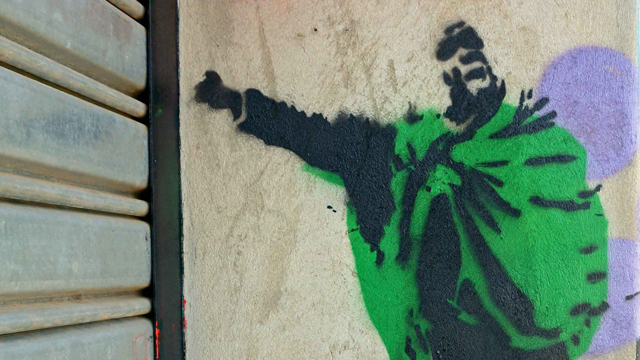
-
 Runette Kruger
Runette KrugerCape Town based Tokolos Stencil Collective uses stencil and graffiti to address socio-political issues such as lingering racial inequality, labour exploitation, segregation, and poverty. The name of the collective refers to a dwarflike mythical being, the tokoloshe, that materialises at night to frighten unsuspecting victims, now mobilised by the Collective to “terrorise the powers that be”, or, the status quo of inequality (Tokolos-Stencils, 2015). The declared aim of the Collective is to highlight continuing spatial and social segregation in a post-apartheid South Africa (Botha, 2014).
The social discrepancies whereby the majority of South Africans continue to experience social and economic isolation are addressed by Adato, Carter and May (2006), who cite the Poverty and Inequality report of 2000. In the report, South Africa is described in terms of two parallel worlds, “one, populated by black South Africans where the Human Development Index (HDI) was the equivalent to [that of] Zimbabwe or Swaziland. The other … [populated by] white South Africa in which the HDI [was] between that of Israel and Italy” (Adato, Carter and May, 2006, p. 226). This inequality had, disturbingly, only deepened between 2000 and 2006, and in a March 2018 report by the World Bank, South Africa is cited as the most unequal country globally in 2015, based on the Gini coefficient of 0.63 of that year (World Bank, 2018, p42). The Gini coefficient measures the gap in income between the wealthiest and poorest members of a population. A score of 0 would indicate absolute income equality, and a score of 1 would indicate that one person owned all the wealth. This disparity, as well as the resultant exploitability of the poor, informs the Tokolos Stencil Collective’s main subject matter.
The most widely recognizable image associated with the Collective is the Remember Marikana stencil, which combines these words with an image of Mgcineni Noki, known as Mambush to his friends and family, or, within the context of the Marikana massacre, The man in the green blanket. The Marikana event played a formative role in the establishment of the Collective – it was founded in 2013 on the day of the first anniversary of the event (Anaya, 2014). The massacre is widely regarded as a watershed crisis, comparable with the Sharpeville tragedy of 21 March 1960, now commemorated as Human Rights Day.
Noki was a community leader who became a prominent news figure in the days before the Marikana massacre, identifiable by the bright green blanket tied around his shoulders. The Marikana massacre took place on 16 August 2012 when striking miners working at the London-based Lonmin Platinum Mine in the North-West Province were gunned down by police wielding automatic rifles, violently ending a six day build-up of tension. Noki grew up in Thwalikhulu, a small village in the Eastern Cape, and was aged 30 at the time of his death. He had a wife and two year old daughter who lived in Carletonville, about 100km away. He is reported to have attempted to de-escalate the growing violent skirmishes, and to focus the gathered strikers on their aim – to increase their wages. The evening before the massacre, the miners were led to believe that if they returned to work, wage negotiations would begin. In the hours before the final events, while the miners’ repeated requests for negotiations were ignored, they were finally beseeched by their union to withdraw. Weighing up the growing indications of a final crack down, Noki began to lead a group of miners away from the outcrop of rock that had been the main scene of conflict over the course of the week. As they reached the nearby settlement their path was blocked by police and barbed wire. Noki led the men another route, only to be blocked again. The ensuing gunfire on the group led to the death of 17 men, Noki among them, identifiable by his green blanket as he lay on the ground. A second group of men were also attempting to leave the site, and were fired at with 295 bullets, resulting in 17 more casualties. The strike continued for another five weeks before the mining company agreed to negotiate. Pay was increased by 7% (Davies, 2015).
I specifically chose this image of Noki, his arm raised while exhorting and encouraging his fellow workers, instead of the dehumanising imagery of up-close, lifeless mineworkers that was freely shared by the press. In contrast, this image in the Remember Marikana stencil shows him as a leader with courage and purpose, and has become an iconic symbol of the struggle for dignity and an adequate wage among the most exploited workers in South Africa, on whose labour an economy that they are unable to access, has been built. Commenting on the lot of the under-classes in 1940, during the impending humanitarian crisis of the Second World War, Walter Benjamin (1969, p. 255 original emphasis) reminds us that “every image of the past that is not recognized by the present as one of its own concerns threatens to disappear irretrievably ... To articulate the past historically ... means to seize hold of a memory as it flashes up at a moment of danger [failing which] even the dead will not be safe”. The Remember Marikana image reminds us that it is crucial to prevent the sacrifices of the most vulnerable members of society from slipping into the amnesia of oblivion.
References
- Adato, M., Carter, M.R., & May, J. (2006). Exploring poverty traps and social exclusion in South Africa using qualitative and quantitative data. The Journal of Development Studies, 42(2), 226-247.
- Anaya, V. (2014, September 10). Tokolos Collective: “Cape Town is a very oppressive place for the poor”. Wiriko Artes Y Culturas Africanas. Retrieved from https://www.wiriko.org/tag/marikana/
- Benjamin, W. (1969). Illuminations. Edited by Hannah Arendt. New York: Schocken.
- Botha, N. (2014, November 21). Tokolos Stencil Collective: 'Crap' art designed to unsettle. The Mail & Guardian. Retrieved from https://mg.co.za/article/2014-11-21-tokolos-stencil-collective-crap-art-designed-to-unsettle.
- Davies, N. (2015, May 22). The savage truth behind the Marikana massacre. The Mail & Guardian. Retrieved from https://mg.co.za/article/2015-05-21-the-savage-truth-behind-the-marikana-massacre.
- Tokolos-Stencils. (2015). Retrieved from http://tokolosstencils.tumblr.com/.
- World Bank. (2018). Overcoming poverty and inequality in South Africa: An assessment of drivers, constraints and opportunities. Washington DC, USA.
published March 2020
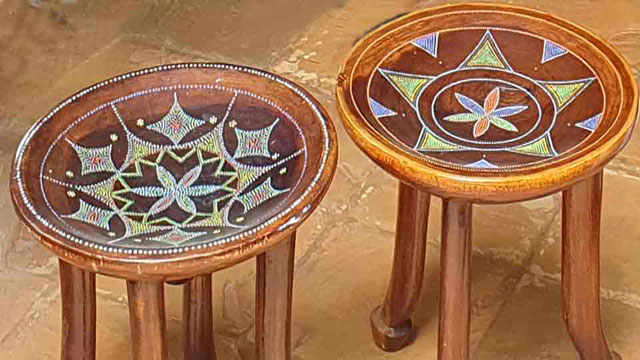
-
 Mary Claire Kidenda
Mary Claire KidendaKenya is extraordinarily rich in creativity, materials, and ideas sources of inspiration reflected in their artefacts which has evolved to its current prosperous state over the centuries. The Kenyan culture can be seen in the visual arts, applied arts, food, music, dance, sports, fashion, literature, and theatre. The artefacts are an extraordinary source of inspiration and nourishment for the artist. Their designs embody African design aesthetics that have retained traditional designs as they also reflect elements of innovation, hybridity, sustainability and modernity (Maina et al., 2017). The artefacts reflect religious beliefs and cultural values – two inseparable elements enmeshed in Kenyan craft. The Kenyan traditional art is fundamentally functional, meeting some specific utilitarian purposes, whereas its aesthetic consideration is typically regarded as having some secondary significance. Art was integrated into everyday aspects of life from formal ceremonies and religious rites to daily household tasks. The arfetacts were produced by skilled experienced crafts persons who were found in the societies. Art is an expression of a particular community or culture through the employment of local materials and craftsmanship.
The Jua Kali manufacturing subsector is the predominant creator of craft products in Kenya (Maina et al., 2017). Jua Kali is a self-organising community of practice producing goods. It is comprised of artisans running micro and small enterprises that are not fully integrated into the mainstream formal economy. The artisans learn skills through traditional apprenticeship (TA). Apprenticeship training is regarded as a critical contributor to skills supply, fostering economic development in Kenya. It involves the transmission of the tacit rather than the explicit knowledge and is the most tangible exhibition of the intangible cultural heritage. It facilitates the transmission of skills from a custodian of knowledge, the Master Craftsman. It combines ethnic design and aesthetics and contemporary styling in craft production in Kenya. Involves the transmission of the tacit rather than the explicit knowledge through observation, imitation and reputation. Besides, apprenticeship ensures that the knowledge and skills that relate to the craft are passed down to future generation so that they continue to be produced within their communities. The learning of the Kenyan design, aesthetics is therefore, an intergenerational phenomenon.
Kenya's ethnic groups can be divided into three broad linguistic groups Bantu, Nilotic and Cushite. The Nilotic tribes in Kenya include Luo, Kalenjin, Maasai and Turkana (Hino et al., 2019). The Nilotic speakers migrated from Sudan and Egypt. They are traditionally pastoralists and fishermen and reside in Kenya's vast Rift-Valley region and around Lake Victoria (Madut, 2020). Each of these communities has its traditions, customs, and practices, imbued with multiple layers of culture, colonial legacies, and migration that add to the rich Kenyan cultures (Deisser & Njuguna, 2016) . The distinctness and confluence of these cultures have served as artistic inspiration for many a cultural product creatively fashioned out of raw materials primarily sourced from the natural environment.
The Luo or Lwoo (also called Joluo, singular Jaluo) are an amalgamated agro-fishery and Nilotic Dholuo ethnolinguistic groups in Africa that inhabit an area ranging from South Sudan and Ethiopia, through northern Uganda and eastern Congo (DRC) (Ojwang, 2021; Prince & Geissler, 2008), into western Kenya, and the Mara Region of Tanzania west Kenya, eastern Uganda, and in Mara Region in northern Tanzania. The name Luo or Low means "God's life-bearing exhalation.' The past economic activities of the Luo included fishing and cattle farming (Ndeda, 2019). Agriculture, especially that which involves staple crops such as maize and beans (Ojwang, 2021). Nilotic communities such as Turkana and Pokot (ekicholong) and even Bantus such as Kamba (mumo ya muthamia) and Taita (kifumbi) in Kenya have traditional stools that have been used for various cultural and functional purposes (Somjee, 1993).
This paper discusses the Luo Traditional Three-Legged Stool called “Kom Nyaluo” in the Luo tribe (Hoehler-Fatton, 1996). My interest in this stool arose because I am a Luo lady married to a Luo man who owns the stool.

Kidenda, “Domestic Exhibition of Kom Nyaluo to EVC Expert Panel Discussing the Versions of the Traditional Stool”, Wood and Beads, 2022 Karen, Nairobi
The circular top of Kom Nyaluo symbolises the round universe and a miniature universe on which the husband reins in a home. It is a sign of prestige and leadership, reflecting the status or power of men or the husband within society and a reflection of the round traditional Luo huts. Its legs embody male masculinity and virility (Biko, 2010). Only the father was qualified to sit on the seat as he had requisite authority and was the owner of all the women he brought forth life with. He would sit on it when addressing issues; women and children would sit on the ground.
The traditional Kom Nyaluo was small, with a height of about 30cm from the ground and decorated with beads (Hoehler-Fatton, 1996). Each elder had their stool, and women and children were forbidden from sitting on it. Kom Nyaluo is associated with the authority the elders wielded and the respect that they were accorded in their homes and society. The stool design reflected the traditional activities of men and women. The men worked and socialised outside the home, and the women mostly worked inside and around the house and garden (shamba). A married young man with a few children applies for an eldership position in a ceremony where he hosts community elders. He would be dressed in traditional regalia, carry a spear and fly whisk. The elders would sit him on Kom Nyaluo and crown him as an elder.
Most traditional Luo homes were polygamous, and the stool played a significant role in controlling the wife, which enjoyed marital favours and childbearing. The husband or man of the house would send the stool to the woman's hut. He would want to spend the night in her hut. The stool would be sent secretly, and early the following day, the man would sneak back into his hut so that the other wives would not know whom he slept with. This brilliantly averted obvious petty jealousy will arise from a polygamous home. If one wife felt that she didn't have the stool in her house often enough, she would ask the first wife to intervene on her behalf. "If the first wife didn't like her, she would ensure her complaints did not reach their husband. The seat symbolised love and joy and sustained life in a traditional Luo homestead. Literally and figuratively, of course. Kom Nyaluo did not only represent the authority of the man but also love and joy and sustained life in the traditional Luo home (Biko, 2010).
Kom Nyaluo was used during the levirate ceremony or "tero", where a widow was remarried to a relative of their deceased husband. The levirate union is consummated by sexual intercourse on the first night. If the widow invited the elders for a drink the day after the night of "ter", it was a sign that the night had been successful. During the drinking session, there was the enthronement ceremony of the new head of the home onto the stool of the deceased, "Kom wuon dala" (seat of the homeowner). With the enthronement, it was as if the dead man was alive again (Lutta, 2015). After marrying and having a few children, a Luo man applies for elderhood by hosting the elders at a party where he will be crowned and dressed in traditional regalia. Signs and symbols of authority that include a spear fly whisk and a three-legged stool are given to the elder.
Production Process
In this case study, the Kom Nyaluo is produced by an artisan from Siaya County Jua Kali Association craftsman. He learned his father's craft skills through traditional apprenticeship and made his products on demand. The Luo traditional stools are carved with logs from ober (mvule tree), ngo'wo (fig tree), duwa (oak tree) and the member (mango tree). The logs are chopped by a power saw and dried for one week. These are hardwood types that are strong, durable and water-resistant. They also feature unique colours and grain patterns that create a stunning display. Oak is light yellowish-brown and generally straight-grained; it is also hard and durable. Mvule wood comes from the African teak, known in Nigeria as the iroko tree; it is challenging, dense, and durable. Fig tree wood sometimes contains latex, which can be toxic or an allergen. Since the fig trees seldom grow straight, their boards tend to be shorter. However, the wood is soft and not very strong. Mango wood is relatively easy to work with; it is easier to shape, plane and sand while still strong and durable. It is also friendly to waxing and staining, making it excellent for furniture or other household objects.
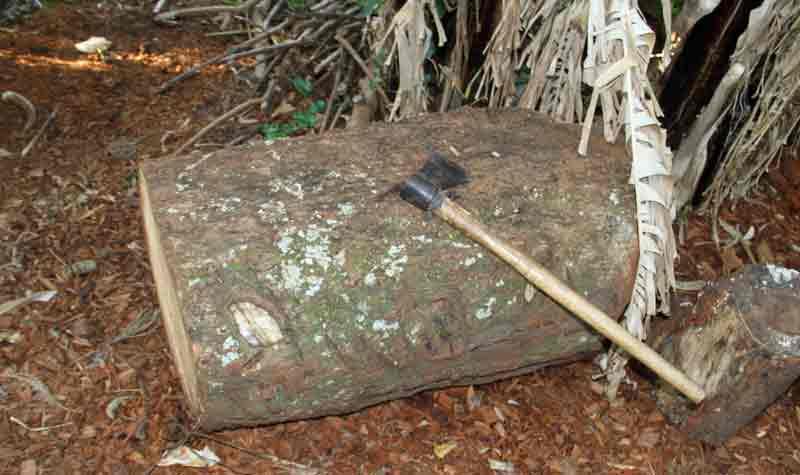
Kidenda, “Wood Logs used for curving out Kom Nyaluo”, 2013, Siaya, Kenya
Each log costs the artisan ten thousand Kenya shillings (Ksh. 10,000), equivalent to sixty-seven (67) euros. The stool is carved from a single block of wood, the wood between stem and roots, which has twisted grains that are more durable and cannot break or crack. The stool is made without using joints or nails. The seat takes the shape of a log. The carver uses Koyo (adze) to fashion Kom Nyaluo from the log, which does not require nails or joints.
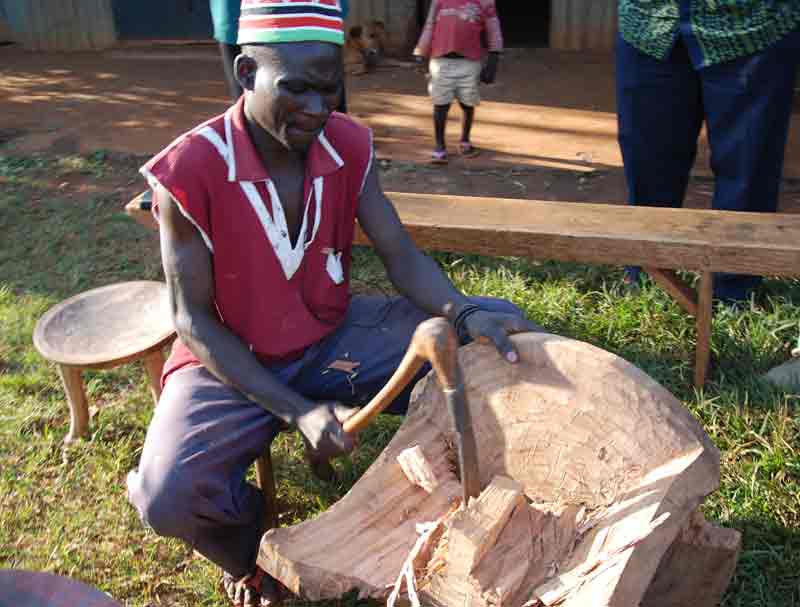
Kidenda, “Curving out the Kom Nyaluo from a log”, 2013, Siaya, Kenya (photo by Mary Clare Kidenda)
Its top takes the circular shape of the log, and after carving, it is smoothened with a furr (metal scrapper for smoothing wood).
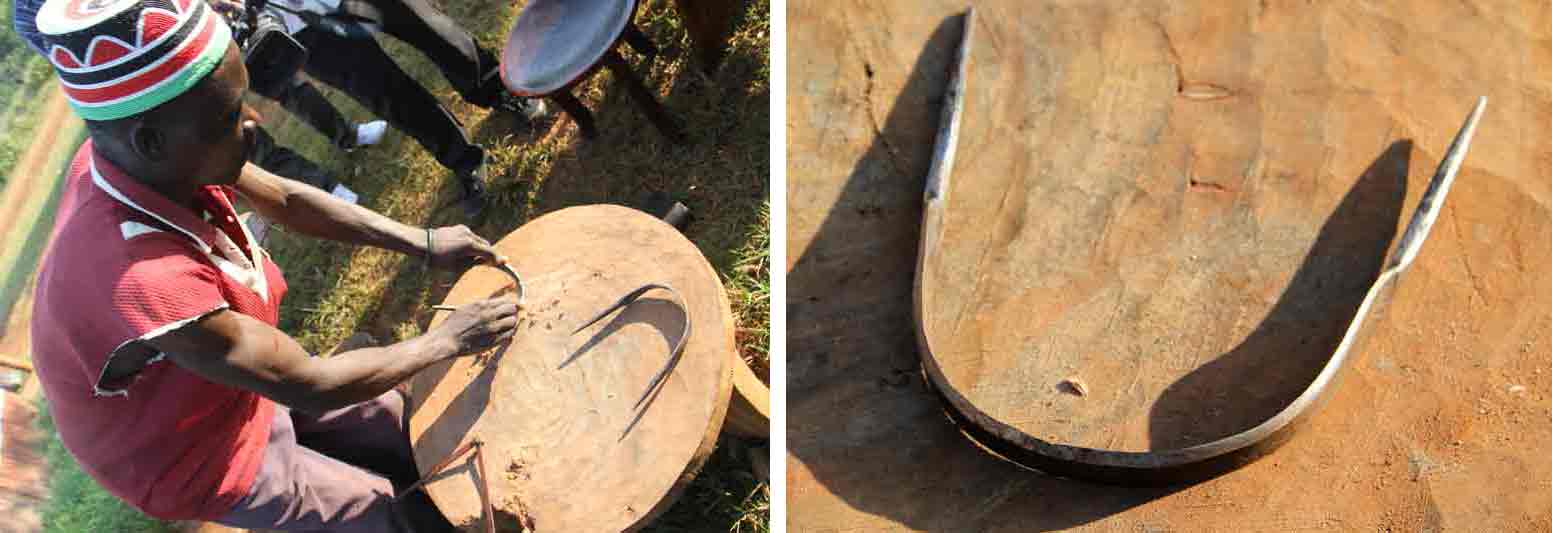
Smoothening the Circular Top Using Furr, 2013, Siaya, Kenya; Furr, the handmade metal tool used to smoothen the top of Kom Nyaluo, 2013, Siaya, Kenya (photos by Mary Clare Kidenda)
They are then sandpapered and vanished using paintbrushes.

Sandpapered and vanished sets of Kom Nyaluo, 2013, Siaya, Kenya (photo by Mary Clare Kidenda)
A compass is used for drawing geometrical patterns on the top of the stool.
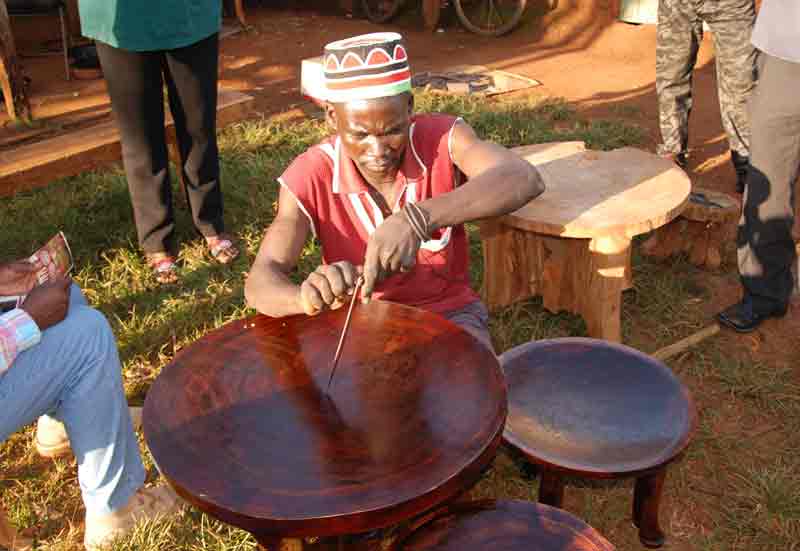
The drawing of geometrical patterns using a compass, 2013, Siaya, Kenya (photo by Mary Clare Kidenda)
Supposedly the design is inspired by a parquet floor in a European-style house owned by Tom Mboya. The wire inlay practised by the Kamba may also have been a model. Thereafter, wood, glass beads, metal, and colourful Maasai beads are banged onto the top, providing intricate decorative artwork.
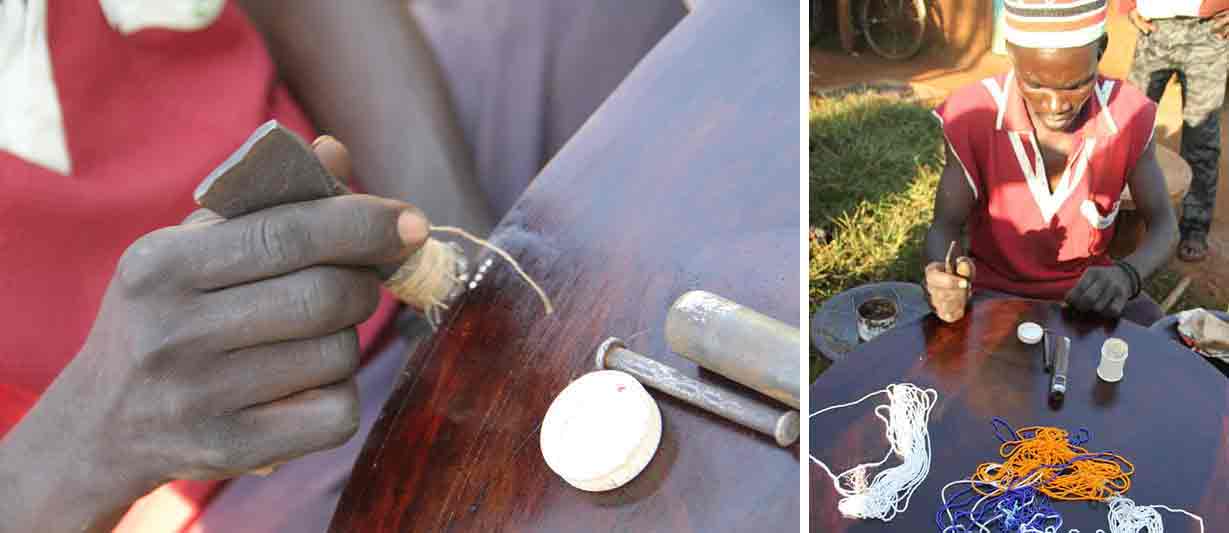
The inserting/banging of beads into the top of Kom Nyaluo, 2013, Siaya, Kenya (photo by Mary Clare Kidenda)
Finished: A Luo Dignitary Stool “Kom Nyaluo”
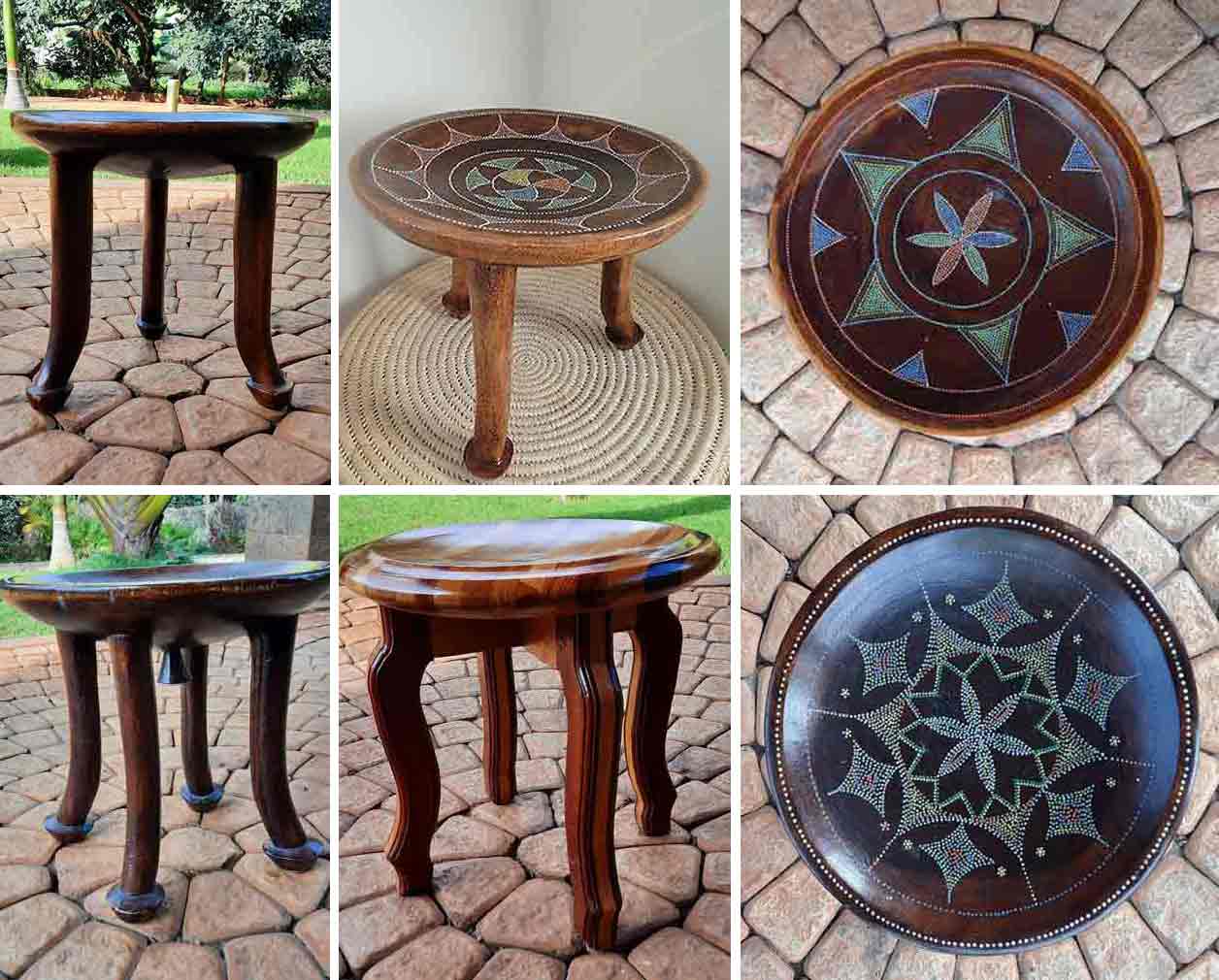
Variety Designs of Finished Kom Nyaluo, 2019, Karen, Kenya (photo by Mary Clare Kidenda)
When Sara went to the US for the inauguration of Mr Obama as president in January 2009 Mama Sarah carried a similar stool. In 2015 when President Obama visited Kenya, he was given a traditional Luo stool (Langat, 2015).
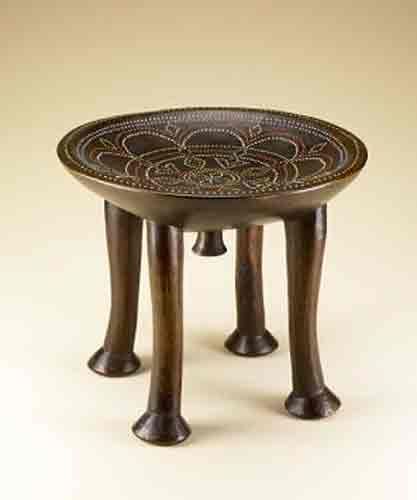
Kom Nyaluo Created by Luberastus Onyango, Wood, glass beads, metal, 2020 Smithsonian National Museum of African Art.
Luberastus Onyango was a renowned Kom Nyaluo craftsman (he died in 1988) whose stools have been given to at least 2 US presidents as gifts President, including John F. Kennedy and Barrack Obama.
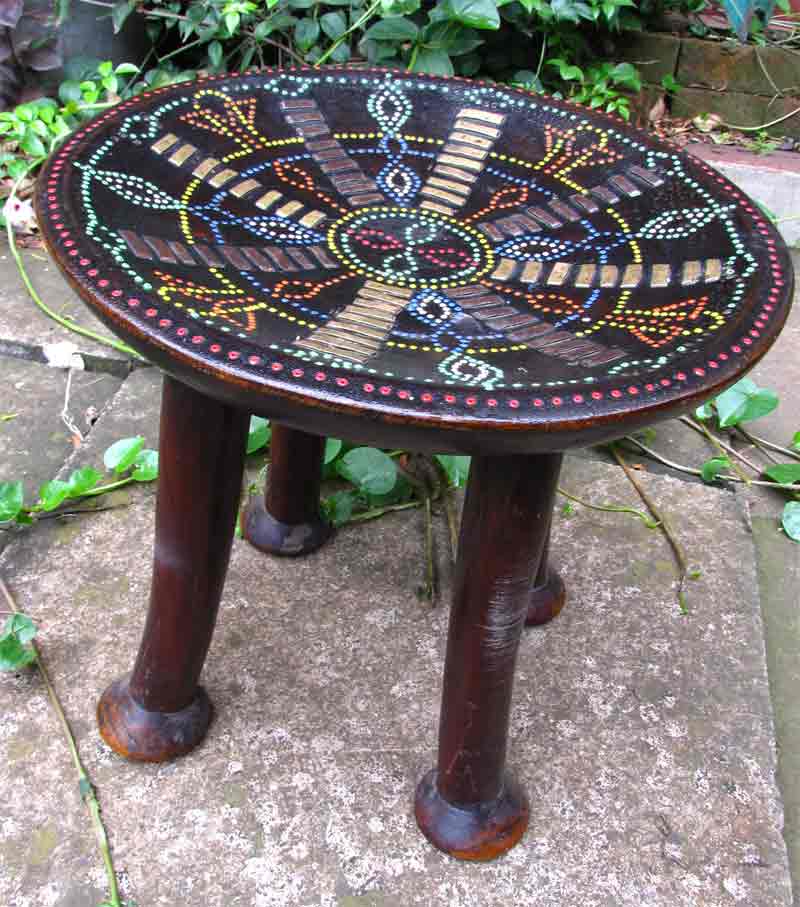
Variety Designs of Finished Kom Nyaluo, 2019, Karen, Kenya (photo by Mary Clare Kidenda)
A generation of Kenyan artists and designers are translating their view of Kenyan design into beautifully crafted products and creating an aesthetic diverse as the tribes and cultures that make up Kenya. This is evident in the JKS in the preservation and modification of the designs like Kom Nyaluo through a traditional apprenticeship that is the critical training methodology of apprenticeship used in Jua Kali Associations. This is evident with the continued production of Kom Nyaluo because of for its cultural utility and aesthetic functionality in the contemporary modern spaces. Artisans and designers are to re-direct and co-create new narratives that re-position philosophical discourse on aesthetics, among other contemporary debates. A generation of Kenyan artists and designers are translating their view of Kenyan design into beautifully crafted products and creating an aesthetic diverse as the tribes and cultures that make up Kenya.
References
- Biko, J. (2010). When in Kisumu, make sure you visit the museum. Eastern African Publication. https://www.theeastafrican.co.ke/tea/magazine/when-in-kisumu-make-sure-you-visit-the-museum--1297986
- Deisser, A.-M., & Njuguna, M. (2016). Conservation of natural and cultural heritage in Kenya: A cross-disciplinary approach. UCL Press.
- Hino, H., Langer, A., Lonsdale, J., & Stewart, F. (2019). From Divided Pasts to Cohesive Futures: Reflections on Africa. Cambridge University Press.
- Hoehler-Fatton, C. (1996). Women of fire and spirit: History, faith, and gender in Roho religion in western Kenya. Oxford University Press.
- Langat, P. (2015). Mama Sarah reveals her special gift to Obama during visit. Nation. https://nairobinews.nation.africa/mama-sarah-reveals-her-special-gift-to-obama-during-kenyan-visit/
- Lutta, C. (2015). The Traditional Levirate Custom as Practiced by Luo Of Kenya. University of Gavle.
- Madut, K. K. (2020). The Luo people in South Sudan: Ethnological heredities of East Africa. Cambridge Scholars Publishing.
- Maina, S. M., Rukwaro, R. W., & Onyango, W. H. (2017). Infusing Design In The Jua Kali (Informal Sector) Production Processes. Journal of Humanities and Social Science, 3(2), 1–12.
- Ndeda, M. A. J. (2019). Population movement, settlement and the construction of society to the east of Lake Victoria in precolonial times: The western Kenyan case. The East African Review [Online], 52.
- Ojwang, H. H. (2021). A study of Luo Ethnobotanical Terminology with implications for Lexicographic Practice. Lifelong Education Material Publishers.
- Prince, R., & Geissler, W. (2008). Becoming “One Who Treats”: A Case Study of a Luo Healer and Her Grandson in Western Kenya. Anthropology & Education Quarterly, 32(4), 447–4.
- Somjee, S. (1993). Material culture of Kenya. East African Educational Publishers.
 Osuanyi Quaicoo Essel
Osuanyi Quaicoo EsselPan-African collective memory: Sociocultural power and identity making on indigenous stools from Ghana and Kenya
Indigenous stools play significant roles in Ghanaian and Kenyan cultures and societies, especially, among the Akan and Masai ethnic groups in the two respective countries. Stools in the sociocultural context serve many functions. One of the primary functional roles is that, it serves as object for sedentary purposes. It is used as a utilitarian object for sitting, welcoming visitors, relaxation for people, for example, family and friends. In Ghana, it is customary to offer a visitor a chair (stool) by way of welcoming, serving him/her water, before asking the visitor of his/her motive for the visit. In the first instance, a visitor is given a sit to relax, followed by cup of water for drinking before asking the visitor to give purpose for the visit. Offering a visitor a chair shows an overt acceptance and respect for his/her presence. This traditional etiquette of serving visitors is ingrained the sociocultural life of both Ghana and Kenya.
Amongst the Akan of Ghana, a visitor is usually given a traditional stool as a seat that may befit his/her status in the traditional society or culture. A family may have different stools: those for showcasing power and authority of its user, honouring guests, and everyday usage by the household. The usage of stools in this context depicts its status-defining tendencies.
Apart from signifying status of individuals, stools, among the Akan of Ghana symbolises the authority of the ethnic or nation states. Stools in Ghana, generally serves as a symbolic soul of the society which links people to the traditional leadership (Antubam, 1963; Amenuke et al, 1991). The stool carries authoritative presence and signifies leadership concept. Warriors, clan heads, chiefs, kings used it to signify their status.
Stools serve as scared and authoritative object in the traditional chieftaincy institution of the southern part of Ghana. Kings/chiefs are enstooled in southern Ghana while those at northern part are enskinned. This implies that in the cultural rituals in the making of Kings/chiefs, stools are inevitable. Amongst the chiefdom, there are several ritualistic uses of stool. Some stools in the court of a chief may be used only once in his or her lifetime. Some are also used once a year during traditional festivities while some are used on daily bases.
As an object strongly connected with power and authority, the Ghanaian stool has three basic parts: the arc-shaped top, the middle portion and the flat base. Its arc-shaped top symbolises loving embrace of women or the concept of motherliness (Amenuke et al, 1991; Antubam, 1963). The middle portion usually gives the stool its name based on the symbol used in representing a concept or idea. The name of the of a stool could be based on a proverb, Adinkra symbol (Figure 1), traditional emblem or idea. For example, the stool in Figure 1 derived its name from the Adinkra symbol which has been stylised to occupy the middle portion, hence the name Nyansapow Stool.
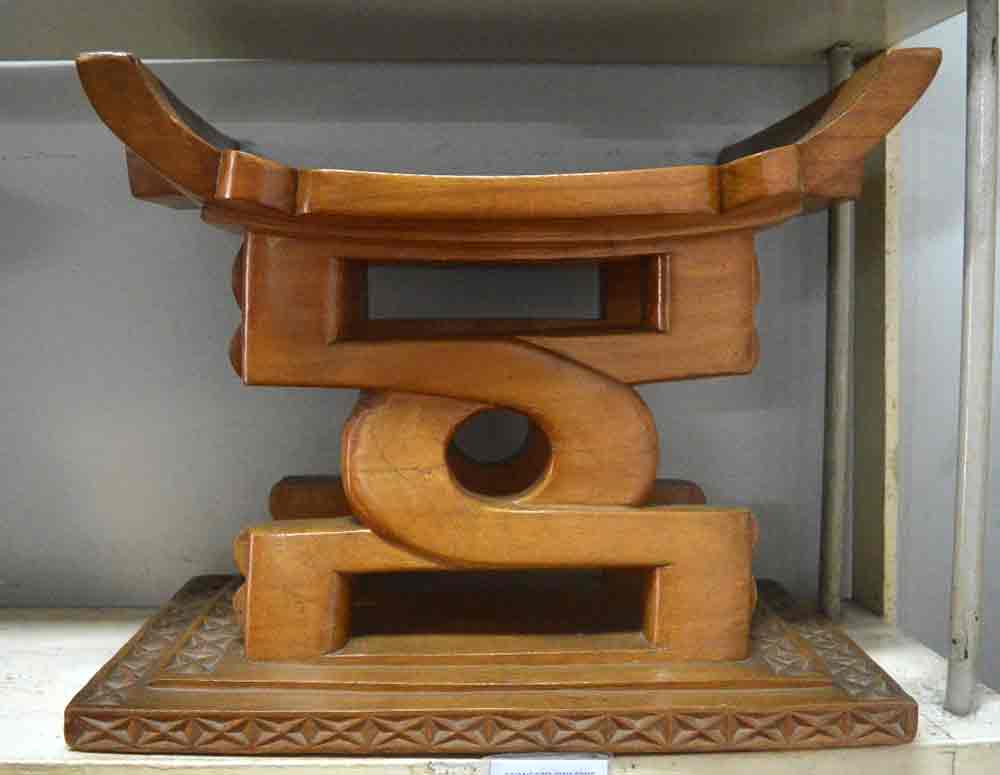
Figure 1: Nyansapow (Wisdom knot) stool, wood, Ghana National Museum, Photo: the author.
The recognition of the presence of God in the society, gender roles and the presence of children is also acknowledged by the middle part of the stool. Design of a stool may adopt basic beliefs and practices of symbolic significance to the society in general. The symbolic adaptation speaks to the visual presentation of Ghanaian societal values including concept of societal functions, cosmic beliefs, family and gender roles.
As a utilitarian object, the stool plays vital roles in the rites of passage (birth, puberty rites, marriage and death) in indigenous Ghanaian and Kenyan cultures in different context. In indigenous Masai culture, stools are used by husbands as object of announcing their eminent visit to their wives on rotational basis. In many African societies, marrying more than one woman is an accepted norm just as same sex marriage are acceptable in other continents of the world. African society holds polygamy as a culture and not in negative perspective as non-African wrongly perceives it. Masai men with more than one wife usually build their houses in circular orientation, allocating a room each to the wives. The house of the man is situated in the middle of the circular-arranged houses. With this traditional set up, the stool is used as a preserve for the husband to signal his presence and authority. To announce his official intention of visiting one of the wives in the same compound, he sends his messenger to send his stool to one of the wives he intended to visit. By seeing and receiving the stool, the wife interprets this symbolic gesture to mean official announcement of her husband’s visit.
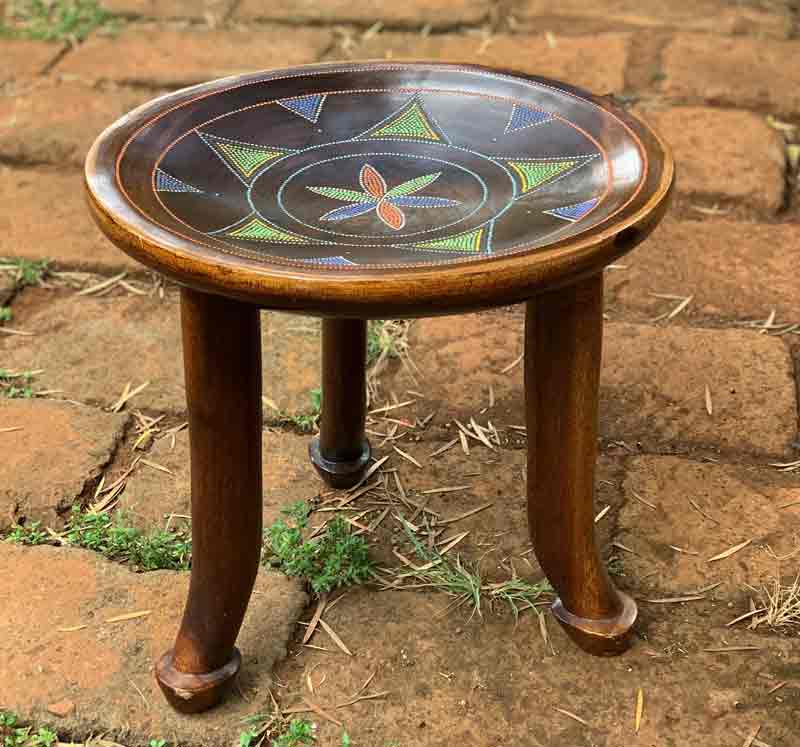
Figure 2: Traditional Kenyan stool used in negotiating visitation to wives, Found in the personal collection Mary Clare Kidenda. Kenya, Photo: the author.
The design of the Masai stool of Kenyan (Figure 2) varies from that of the Akan of Ghana. The Maasai stool features a circular-shaped top and prominent three-legged phallus-shaped upright stands. Usually decorated with traditional Masai beads, the top of the stool has bowl-shaped surface that serves as a comfortable receptor of the buttocks of the user. The tip of the phallus-shaped stands touches the ground and gently bends inward, and depicts crown-shaped cork memetic of the phallus. These observable characteristic features symbolise the presence and potency of the manhood in procreation. Despite its simplistic appearance, the stool creates a collective memory of marital relationships and the supervisory power of males and the loving embrace of women. Interestingly, this depiction to the African, is not a show of chauvinism but a reminder to males to protect and care for women within their power. Generally, having secret rendezvous or extra marital affairs is frond up by society. Performing official marital rights to marry a lady is the traditional expectation rather than having them as mistresses.
In Ghana, the head of a clan, warrior, chief/king and queen mothers uses the stool to symbolise authority. For that matter, the presidential seat was fashioned with inspiration from the shape of the stool. Despite the difference in design concept of the Kenyan and Ghanaian stools, both signify a collective memory of marital relationships, idea of procreation, leadership authority and the loving embrace of women in the society.
References
- Amenuke, S. K., Dogbe, B. K., Asare, S. K., Ayiku, F. D. & Bafoe, A. General knowledge in Art for senior secondary schools. Evans Brothers Limited.
- Antubam, K. (1963). Ghana’s heritage of culture. Koehler & Amelang.
- Asihene, E. V. (1978). Understanding the traditional art of Ghana. Associated University Presses
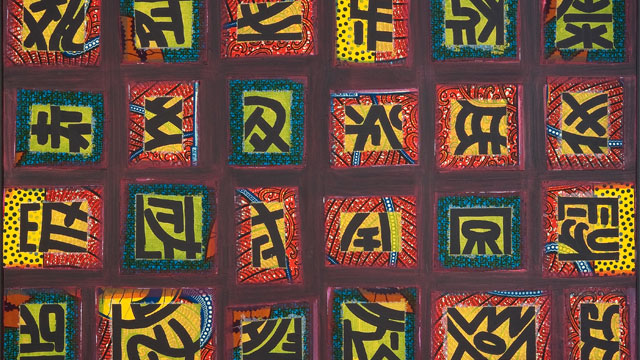
-
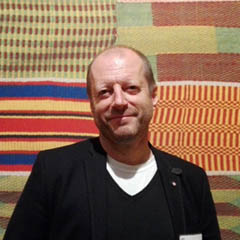 Stefan Eisenhofer
Stefan EisenhoferIn 1971, El Loko moved to Germany to study sculpture, painting and graphics with Joseph Beuys, Rolf Crummenauer and Erwin Heerich at the Staatliche Kunstakademie Düsseldorf, where he graduated as a master student in 1977. He created woodblock prints, sculptures, installations, drawings, graphics, photographs, paintings and performances in almost four decades, using an extremely wide range of working techniques and forms of expression. El Loko participated in numerous solo and group exhibitions on several continents and his work has been widely published. In addition, he repeatedly organised workshops for artistic and intercultural exchange in Europe and Africa.
El Loko, who lived and worked in Cologne (Germany) until his death in 2016, was one of the first African artists to venture into the art worlds of the West. His autobiographical book "Der Blues in mir" (The Blues in Me) - published in 1986, written in German and illustrated with woodcuts by the author - vividly recounts how he had to fight for and invent his identity and his path as a human being and artist at that time.
In Germany, El Loko experimented from 1972 onwards primarily with woodcuts before turning to painting in the mid-1980s. His series "Landschaften" (Landscapes), which interspersed colourful architectural elements with human faces, bodies and body parts and aesthetically dealt with the theme of threat, confusion and alienation in an urban context and how to overcome them, subsequently gained great popularity.
Subsequently, it became characteristic of El Loko that, for all the diversity of his work, he took up certain themes almost cyclically. His series of works "World Faces", "Cosmic Letters" and "Figure Landscapes" played a special role here, which he reinterprets again and again, seeking different perspectives and positions. Through a non-hierarchical treatment of the face or the bust portrait, the "World Faces" convey the vision's striving to abolish the differences between people of different origins, world views and gender. A utopian striving for a universal language and a global identity manifests itself in his series of works "Cosmic Letters", in a sense an alphabet of his own characteristic visual language. In paintings and pigmented steles made of wood and steel, El Loko combines ornaments, figurations, signs and ciphers of different origins and strives, by means of this symbolic sign language, for an art language that can be understood worldwide and for the construction of a meaningful world of his own.
Inspired by Joseph Beuys and the dissolution of the conventional bourgeois concept of art, El Loko also turned to temporary art actions from 1976 onwards. He developed his "duel performances", which combined poetry, song and drum rhythms and were characterised by the principle of rhetorical surprise and immediate reaction to each other.
In his installations, El Loko deals primarily with Western images of Africa and clichés in an often provocative manner. In his popular work "How to explain pictures to a pack" (1995), he ironically takes up Joseph Beuys' action "How to explain pictures to a dead hare" (1965): A gathered pack of 70 animals stands in front of a map of Africa hanging on the wall, composed of various elements and symbols like a puzzle. With this installation, El Loko not only posed questions about images of Africa, but also traced his own situation at the same time: The pack as the world that lies outside of him looks on the one hand expectantly, on the other hand more or less uncomprehendingly at him as an artist. In "The eternal mask" (2006), the artist painted 50 portrait photos of Africans with acrylic, alluding to Western views of African people: Through the disfiguring colour, the faces lose their individuality, become anonymous and frightening. In his work "Africa down", partly done in Cologne (Germany) and finished in Cape Town (South Africa), El Loko addresses the positions of Africans in the world. The visitors to the exhibition were forced to walk on 256 photos of Africans and 53 African national flags lying on the floor, through which the artist makes the oppression and devaluation of Africa and its people through colonialism and through corrupt, selfish and ignorant African rulers almost physically comprehensible. His provocative installation "Mohrenköpfe - Hohlköpfe" (2005), which questions the role of kleptomaniac politicians of black skin colour who systematically ruin their own continent and do not care about cultural matters or the economic or social development of their countries, aims in a similar direction. As in all his works, El Loko was not interested in simplistic answers or accusations, but in a serious examination of painful and uncomfortable topics as well.

Image 1: Vogelakrobatik, 1996, 250x30x20 cm // Image 2: PE.VO.TO.7, EL Loko, 2017, 135x99 cm // Image 3: El Loko at Museum Fünf Kontinente (Karin Guggeis, El Loko, Stefan Eisenhofer) // Image 4: Dokponou (Der Gescheiterte - The failed), El Loko, 2013, Acrylic on canvas, 80x120 cm. // Image 5: Vogelakrobatik, 1996, 250x30x20, Museum Fünf Koninente, Munich. All images: Copyright Museum Fünf Kontinente, Munich.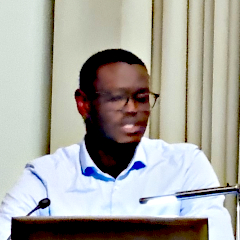 Ibrahima Sene
Ibrahima SeneEl Loko - Migration, resistance and the circulation of knowledge
In Western modernity, time is often conceived as a linear progression—clearly divided into past, present, and future. This conception structures not only individual life trajectories but also institutional and political imaginaries. Yet, across many religious and spiritual traditions—be it Islam, Christianity, Judaism, or various African cosmologies—time is not necessarily a fixed chronology. Rather, it is a dynamic, layered continuum in which the boundaries between past, present, and future are porous. In such worldviews, the dead do not merely belong to the past; they remain active presences, situated in a time ahead of us. We walk toward them. In this sense, the deceased possess a temporality that exceeds linear sequence—they remember, they anticipate, and they guide.
It is within this framework that the work of El Loko (1950–2016) continues to resonate. His life and artistic practice offer an enduring voice on questions of migration, identity, and the ongoing legacies of colonialism. Though physically absent since 2016, his presence persists—both as a historical figure and as a visionary of possible futures. In a world increasingly marked by identity-based closures and a renewed denial of the Other, his trajectory offers a powerful counterpoint: an invitation to reimagine belonging, movement, human difference – all within the framework of migration.
This contribution proposes a return to El Loko’s oeuvre from a literary and historical perspective. His work—spanning visual arts, literature, and intellectual engagement—creates spaces of reflection where the migrant experience is not reduced to moments of departure or arrival. Instead, migration emerges as a temporal rupture: a lived experience of dislocation, memory, anticipation, and transformation. In this light, the struggle against racism is not only a social or political endeavor but also a confrontation with hegemonic temporalities.
El Loko’s artistic practice documents and contests the historical fractures experienced by African migrants in Europe, while simultaneously gesturing toward alternative epistemologies. His paintings, graphic works, and writings become acts of resistance and remembrance—counter-archives that preserve erased histories and imagine new futures. Through his work, we are reminded that art is not merely a reflection of time, but a mode of temporal intervention. It gathers the dead, the living, and the not-yet-born into a shared, contested space of meaning.
Biographical background
Born in Pédakondji (Togo) in 1950, El Loko studied at the Düsseldorf Art Academy from 1971 after training in Accra – under Joseph Beuys, among others. However, his artistic career in Germany was interrupted in 1978 when he was refused permanent residency. His return to Togo marked the beginning of a transcultural oeuvre that is situated between Africa and Europe, art and politics, biography and society. In an interview with Manfred Loimeier, El Loko describes how his artist's name developed from his initials:
“Please explain how you came to call yourself EL Loko?
EL Loko is my real name, I just changed it slightly. My name is Edoh Lucien Loko. If you take the two first names, you have E and L and then Loko. That's exactly what it says in my passport. At first I started writing E.L., but at some point both letters asked: "Why should we stand alone? We're moving in together." That's how E.L. became EL.”[1] (Loimeier 2012, 165-166).
El Loko’s choice of name is itself a statement—a gesture toward a philosophy of togetherness and connection. As he himself explained, the name refers not only to the link between letters but also to a broader principle of unity: a weaving of identity, community, and interrelation. Yet, as Susanne Gehrmann (2004) has noted, the name also evokes the notion of madness—la folie—a theme frequently present in artistic and literary traditions. This “madness” should not be dismissed as pathological; rather, it marks a form of social marginality that enables acute perception. From the fringes, the artist often sees most clearly the fractures and contradictions of the society that excludes him. In this sense, El Loko’s marginality (in German social context) becomes epistemological—a vantage point from which to critique dominant structures and imagine otherwise. He, seen as peripheral or subaltern, becomes the seer, the chronicler of the everyday.
El Loko’s broader body of work—spanning over four decades and encompassing painting, literature, and graphic design—bears the traces of diasporic experience and migratory existence. His artistic production reflects not only physical movement between places but also a constant negotiation of cultural and epistemic borders. He emerges as an important figure within the postcolonial African intellectual landscape, offering aesthetic and philosophical responses to questions of identity, memory, and historical trauma. His work invites us to listen to voices from the margins—canine, mad, or exiled—and to reconsider who is permitted to speak, to see, and to remember.
This broader inquiry into identity and displacement cannot be separated from the historical and political conditions shaping the African diaspora in Germany. El Loko’s personal and artistic trajectory is deeply intertwined with the lesser-known histories of African presence in postwar and postcolonial Germany—a presence marked by invisibility, marginalization, and resistance.
African Diaspora in Germany
The African diaspora in Germany and Europe has become a central topic of public debate, particularly due to the intensification of migration policies and the ongoing debates on cultural diversity and integration. In Germany and the EU in particular, the rise of far-right parties has strongly influenced political and social discourse. These debates often centre on the so-called ‘danger of migration’ and the assumed inability of certain migrant groups to integrate into society. These narratives, which often link migration and crime, shape the public image of migration and cultural diversity and contribute to social polarisation.
In this context, however, the question also arises as to how present people with an African background are in Germany. Compared to the former colonial powers such as France, England and Belgium, their presence is significantly lower. According to a census conducted in 2024 by the Statistisches Bundesamt (Mikrozensus - Bevölkerung nach Migrationshintergrund. Erstergebnisse 2023), around 1.27 million people of African origin live in Germany. This low number can be attributed to four main factors: (01) the short duration of the German colonial presence in Africa, (02) the low migration of Africans to Germany during the colonial period due to German colonial policy. This colonial policy is based on a concept of nation (03) that defines a unit by common descent, language, religion or geography. This refers to a nativist identity with a closed concept of ethnic groups and communities. This creates an exclusive understanding of belonging and demarcation. In contrast, France, for example, pursued an approach that is influenced by the idea that a nation is a community of will as well as a community of experience (Assmann 2006, 21; 41; 160). This view characterised French colonial policy and led to the policy of assimilation and association. The massive migration of African students or Africans to Paris, Marseille, etc. through the colonial school, for example, contributed to the formation of an African diaspora in France. (04) A fourth factor is guest worker and educational migration after the Second World War (Oguntoye 1997; Aitken & Rosenhaft 2013). While the African diaspora in France emerged largely from the colonial legacy, African migration to Germany was characterised by economic and educational cooperation between the two German states, the GDR and the FRG, and African countries (Kassé 1995). In the GDR and FRG, African students were sponsored in order to train future political elites for socialist or capitalist systems. In addition, labour, for example from Angola or Mozambique, was recruited to support the economic reconstruction of Germany after the Second World War (Schenck 2023).
The concept of the ‘African diaspora’ in Germany therefore remains very heterogeneous. It includes people with different migration histories, including descendants of transatlantic enslavement, labour migrants, refugees and students, etc. Afro-Germans and African migrants have little political visibility and are hardly represented in central political institutions. Only recently has Germany begun to address its colonial legacy through debates on reparations and the renaming of streets - often initiated by diasporic and civil society organisations. This broader reckoning with Germany’s colonial past parallels the emergence of African migrant voices in literature, which began gaining momentum in the mid-1980s despite initial marginalisation.
The first wave of African migration literature in Germany, which emerged in the mid-1980s, was primarily characterised by students who came to Germany for their academic education. However, their voices gained only limited public attention - a reflection of the historical invisibility, political marginalisation and colonial fading that characterise the African diaspora in Germany. These included Nsekuye Bizimana (Müssen Afrikaner den Weißen alles nachmachen? 1985), Aly Diallo (Die Täuschung, 1987) as well as El Loko, Chima Oji and Daniel Mepin.
A second wave followed in the 1990s, in which African women increasingly made literary appearances. Examples of this are Amma Darko with Der verkaufte Traum (1991) and Philomène Atyamé with Abengs Entscheidung. Eine schwarz-weiße Liebe in Kamerun (2002). This phase also produced works by refugees and other students, including Thomas Mazimaka (Ein Tutsi in Deutschland: Das Schicksal eines Flüchtlings, 1997), Idrissa Keita (Der Wind bläst, 1994) and Osman Alimamy Sankoh (Ein Vermittler zwischen zwei Welten: Afrika und Deutschland, 1999). Authors such as André Ekama (Schwarzer sein im weißen Himmel, 2007) also thematised migration experiences and questions of identity. These works not only reflect personal experiences, but also scrutinise colonial structures and racist discrimination in Germany. They tie in with the political commitment of the former African diaspora (Diagne 2012).
As early as the interwar period, African activists raised their voices and demanded equal rights in petitions. Organisations such as the African Aid Association in Hamburg campaigned for better living conditions in the Weimar Republic. These developments show that the debate about colonialism and migration on the part of the African diaspora is not a recent phenomenon, but can be traced back to long historical continuities.
Literary work
Among his literary production, the autobiographical novel Der Blues in mir (1986) (engl. The Blues in Me) remains the most cited and most central. The novel combines elements of poetry, documentary and personal reflection. In the work, El Loko uses the blues as a metaphor for the emotional turmoil of migrants in Germany, in particular the feeling of alienation, racism and the search for identity. Characterised by legal disputes and personal challenges in Germany, the work reinforces the emotional impact of the narrative (Daré 2015: 135). The Cuckoo's Egg Ahoba (2009) is little known. Just like the work Der Blues in mir, his novel also deals with themes such as loss of home, experiences of foreignness and the search for identity.
El Loko deliberately combines different media in his literary texts, including official documents, woodcuts and newspaper cuttings, in order to convey his message more forcefully (Daré 2015: 135). This diversity of media forms a bridge between art and literature. His works function not only as an expression of personal experience, but also as a critical reflection on migration and intercultural challenges. In addition, they offer a cathartic function by not only documenting migration experiences, but also actively questioning and reinterpreting them (Diagne 2012, 144).
El Loko’s work operates within what cultural theorist Homi K. Bhabha calls a “Third Space” – a hybrid zone where cultural meaning is not fixed but negotiated (Bhabha 1994). El Loko’s position within this Third Space enabled him to see and compare both Togolese and German societies from within and beyond. For El Loko, this meant refusing binary labels and instead embracing a fluid position between cultures, nations, and artistic traditions. By situating himself between Germany and Togo, between Beuys’ avant-garde and African visual systems, El Loko engages in a comparative reflection on societies: their values, exclusions, and imaginaries of the ‘Other’. El Loko turns these inherited comparisons into tools of critique. His works are not only personal narratives of displacement; they are decolonial interventions that call for alternative ways of imagining cultural coexistence and historical responsibility.
Artistic and political resistance
Resistance is a well-known attitude of authors of migration literature. Resistance does not simply mean being against, but rather asserting oneself and claiming one's place. Confronted with rejection and racism on a daily basis, El Loko – like many writers of this generation – epitomises this form of resistance. This is expressed in different ways - artistically, intellectually and existentially - and is reflected both in his work as a writer and artist and in his relationship with the German authorities and the German public. Many forms of resistance can be recognised in EL Loko's works.
An essential form of his resistance was directed against the clichéd depiction of Africa in Western media and discourses. The stereotypical perception of the continent as a place of war, poverty, corruption and chaos represents a clear distortion of Africa's real socio-cultural diversity (Krems 2007, 18). Many writers, including El Loko, consciously distanced themselves from polarising identity attributions between ‘own’ and ‘foreign’. He saw it as his literary task to break through these entrenched and pejorative images of identity. For him, this resistance was not only an intellectual, but also a socio-cultural process that was intended to help migrants maintain their independence in the new society. Instead of reinforcing divisions, El Loko looked for ways to connect. He refused to be categorised even as a Togolese, African or German writer, but rather saw himself as a traveller who was in a constant dialogue with the world and nature. For many writers from diasporic or postcolonial backgrounds, this approach allows them to challenge dominant narratives and explore complex, hybrid identities shaped by migration, displacement, and global interconnectivity. By situating his work within this framework, he joins a global literary conversation that interrogates how histories, cultures, and experiences intersect beyond traditional borders.
In addition to his artistic exploration of identity issues, resistance also became a political act for El Loko. A central theme of his work The Blues in Me is his personal conflict with the German authorities. His idealised image of Germany was severely shaken by his confrontation with the authorities. He had believed that decent and hard-working people did not have to worry about deportation - especially not if they came from Togo. But the reality was different: in a letter to the immigration authorities, he defended his artistic work as a bridge between cultures, but the answer was disappointing: his stay would contradict the development policy objectives of the Federal Republic of Germany. This rejection is exemplary of the structural difficulties faced by African migrants in Germany. El Loko therefore also used his work as a political statement against institutional injustices, reflecting the social challenges faced by migrants.
El Loko also formally breaks through rigid narrative structures. In The Blues in Me, he combines texts, images and sculptures to create a multi-layered, hybrid narrative. This interweaving of media not only questions the boundaries of autobiography, but also reflects the fragmented experience of migration. El Loko integrates newspaper clippings, reports from immigration authorities and visual elements to open up different perspectives on his story.
In addition to literature, El Loko also realised his resistance in the visual arts. He combined traditional African and modern Western forms of expression and created an art that was located in both African and European art traditions. His works not only served as a platform for representing African perspectives in Germany, but also as a challenge to hegemonic Western art norms.
Knowledge circulation
The debate on colonial history in Germany shows that the African diaspora plays a central role in coming to terms with colonial atrocities and their consequences. It has raised public awareness of the suppressed colonial past and brought the debate on these issues into social and academic discourse. In this context, the current critical debate on knowledge production from a decolonial perspective is becoming increasingly relevant. It calls for the deconstruction of Eurocentric knowledge systems and the recognition of African forms of knowledge that have been historically marginalised.
El Loko contributes significantly to this debate and to the circulation of knowledge through his works. He integrates traditional African philosophies and narrative structures into his oeuvre, making it accessible to a wide audience. In his cosmograms, he visualises alternative knowledge systems that combine European and African traditions of thought. This intercultural approach questions colonial notions of knowledge and creates new approaches to African perspectives.
The circulation of knowledge in this context takes place through various mechanisms: e.g. through oral traditions and memory transmission within diaspora communities, preserving and transmitting cultural knowledge; through literary and cultural translation and intertextuality. Art and literature serve as spaces for the transmission and transformation of knowledge by linking different experiences. Through his art, El Loko not only contributes to the preservation and transmission of traditional knowledge, but also creates hybrid forms of knowledge that combine African and Western knowledge. This illustrates that art and literature are essential platforms for the circulation of knowledge, bringing not only African but also global perspectives into dialogue with each other.
El Loko's work is at the centre of a decolonial critique of the Eurocentric knowledge system. He integrates African ways of thinking, oral traditions and spiritual concepts into his texts and images. His so-called cosmograms epitomise this philosophy: as visual spaces of knowledge in which the past, present and future are not thought of in linear but cyclical terms. His art acts as a platform for the visualisation of marginalised knowledge and opens up new perspectives on memory, migration and global justice.
Relevance and legacy
At a time when migration and racism continue to be central themes of social debate, El Loko remains an important thinker whose productions point to both the challenges and the future of the African diaspora. He is more than a chronicler of the African diaspora – he is a mediator between worlds. His works call for a confrontation with colonial heritage, institutional racism and cultural self-empowerment. At a time when migration is being negotiated globally, his work remains highly topical: it calls for memories to be re-read – as a source of knowledge for a fairer future. His works call on us to learn from the past, to fight against the injustices of the present and to build a more just future. In this sense, El Loko's literary and artistic contributions have garnered significant recognition in Togo and across West Africa, where his works are celebrated for their profound exploration of identity, migration, and postcolonial legacies. Throughout his life, El Loko maintained a dual presence in both Togo and Germany, facilitating cultural exchange and dialogue between the two countries. His work has been also featured in various international exhibitions, including the Johannesburg Art Fair in South Africa, underscoring his influence in the broader African art scene. These platforms have amplified his voice, allowing his reflections on identity and belonging to reach a global audience. And when we understand migration as part of a shared history, we realise that racism is not just a problem of the present, but a structure that does not have to determine the future. The deceased, just like El Loko, are already part of this future. We can and should learn from his work and use these insights to shape a future in which we not only free ourselves from the mistakes of the past, but also focus on the knowledge of all those who came before us and the efforts of those who will come after us.
References
- Daré, Gbandé. “La fusion du récit littéraire avec l’art, la presse et la correspondance administrative: Der Blues in mird’El Loko.” Créativité intermédiatique au Togo et dans la diaspora togolaise, edited by Susanne Gehrmann and Gilbert Dotsé Yigbe, LIT, 2015, pp. 135–158.
- Diagne, Ibrahima, editor. Koloniale Vergangenheit und deutsch-afrikanische Erinnerungsorte = Passé colonial et lieux de mémoire germano-africaine. Mont Cameroun, no. 7, 2010.
- Diagne, Ibrahima. “De la violence du passé au sens du vécu présent: Les survivances de la mémoire coloniale dans Lisahohé (2005) de Théo Ananissoh.” Mont Cameroun: Zeitschrift für deutsch-afrikanische interkulturelle Studien, edited by Albert Gouaffo and Salifou Traoré, vol. 7, 2010, pp. 31–47.
- Diagne, Ibrahima. “Différenciation, hybridation et transposition du Je: Pratiques autobiographiques et écriture interculturelle dans la littérature de l'immigration africaine en Allemagne.” Conventions & Conversions: Generic Innovations in African Literatures / Innovations génériques dans les littératures africaines, edited by Susanne Gehrmann and Flora Veit-Wild, WVT, 2012, pp. 141–159.
- Diagne, Ibrahima. “Kulturanthropologische Grundpositionen im schwarzafrikanischen Emigrationsdiskurs in Deutschland.” Mont Cameroun: Afrikanische Zeitschrift für interkulturelle Studien zum deutschsprachigen Raum, no. 6, 2009, pp. 11–27.
- El-Tayeb, Fatima. Schwarze Deutsche: Der Diskurs um ‘Rasse’ und nationale Identität 1890–1933. Campus, 2001.
- Gehrmann, Susanne, and Gilbert Dotsé Yigbe, editors. Créativité intermédiatique au Togo et dans la diaspora togolaise. LIT, 2015.
- Gehrmann, Susanne. “Exil als äußerer und innerer Zustand: El Lokos autobiographische Erzählung Der Blues in mir.” Weltengarten: Deutsch-Afrikanisches Jahrbuch für Interkulturelles Denken, Revonnah Verlag, 2004, pp. 121–134.
- Honeck, Mischa, et al., editors. Germany and the Black Diaspora: Points of Contact, 1250–1914. Berghahn Books, 2013.
- Humboldt, Carmen. Afrikanische Diaspora in Deutschland: Eine explorative Studie zur Entstehung und Gegenwart transnationaler afrikanischer Communities in Köln und Umgebung. Logos-Verlag, 2006.
- Loimeier, Manfred. Wortschätze: Interviews mit afrikanischen Schriftstellerinnen und Schriftstellern. Horlemann, 2012.
- Loko, El. Der Blues in mir: Eine autobiographische Erzählung. Wuppertal, Verlag M. Krumbeck, 1986.
- Loko, El. Mawuena: Gedichte und Holzschnitte. Erkrath, Franke Eigenverlag, 1983.
Endnotes
[1] All translations from the original texts into English are my own. Original quote: „Erklären Sie bitte, wie es dazu kam, dass Sie sich EL Loko nennen? EL Loko ist mein richtiger Name, ich habe ihn nur leicht verwandelt. Ich heiße Edoh Lucien Loko. Wenn Sie die beiden Vornamen nehmen, haben Sie E und L und dann Loko. Genauso steht es in meinem Pass. Erst habe ich angefangen, E.L. zu schreiben, aber irgendwann haben beide Buchstaben gefragt: „Warum sollen wir allein stehen? Wir ziehen uns zusammen.“ So ist aus dem E.L. EL geworden.“ (Loimeier 2012, 165-166).
Published August 2025

-
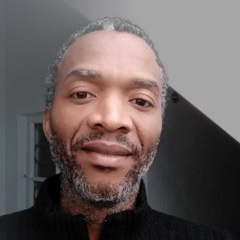 Paul-Henri Souvenir ASSAKO ASSAKO
Paul-Henri Souvenir ASSAKO ASSAKOThe logo takes on the formal look of the chips used in the “Abbia” game. It is a traditional game that was played only by men in the South Cameroon Plateau until the beginning of the colonial period. In its general form, the logo is comprised of two main parts: an upper part which bears the phrase “The University of Yaoundé 1” (in French and in English) and a lower part that is defined by the slogan in Latin words “sapientia collativa cognitio” (wisdom is collected cognition).
The central part of the upper component of the logo features four human figures organized around a table. The rigid geometrization of the composition of the logo and the regularity of the lines give great expressiveness to these graphics. The treatment of the shape of the logo exhibits remarkable influence by traits of the “Abbia” token. The geometric schematization of the pattern and the ogival shape of the logo scrupulously drawn by regular lines determine the elements that mark this influence.
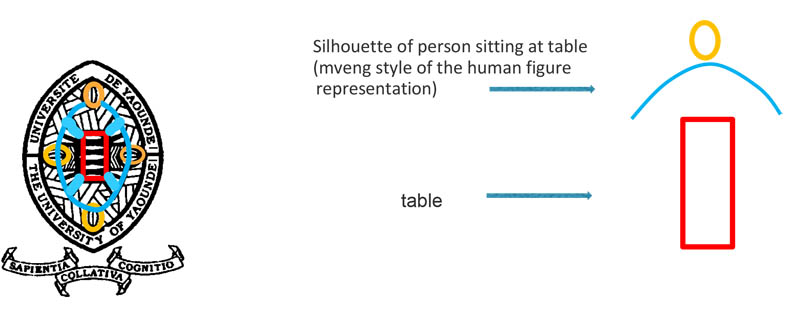
The name of the game “Abbia” refers to “hazard”, “a game of chance where bets are placed, which may be a simple gourd of palm wine, a human being (woman or child), livestock, or the player's farm or plantation etc.” (Cyrille Bela, 2006). These are not just simple tokens but a characteristic artistic expression that is pertinent to the sculptural heritage of South Cameroon’s population. These tokens obtained from the pits of the sapotaceous fruit (Mimusops le-testui), present on their smooth faces a wide variety of anthropomorphic, zoomorphic, geometric subjects, etc. minutely engraved in bas-relief by the artists. In addition to their use for the game, Abbia tokens are also ideograms and pictograms that have sometimes been associated with divinatory practices (Maurice Pervès, 1949: 27). Designing a logo that is inspired by them is significant from a dual aesthetic and symbolic perspective capable of inspiring elements of content to national identity.
On the independence trajectory of the 1950 – 1960 period, the year 1957 is significant. It is marked by the creation of Cameroonian citizenship and the adoption of the first symbolic acts of the nation. After the investiture of André Marie Mbida, the first Prime Minister of the State of Cameroon on May 15th, 1957, the Legislative Assembly of Cameroon (ALCAM), on November 10 of the same year, chose the first national emblems: national anthem, flag, and a motto. From that moment, the visual and artistic elements revealed themselves and displayed their importance very early in the narrative of the history of the Cameroonian nation and the constitution of its heritage. The adoption of these national identification symbols is not unequivocal. We note with regret the anonymity of the authors/creators of these national emblems: “but we must nevertheless state the fact that no specific and nominal mention was made of the Cameroonian authors of the national anthem thus chosen. Later in 1960, the same silence will be reserved for the author – also Cameroonian, of the seals of the Republic of Cameroon, without us fully understanding the meaning to be given to these oversights” (J. E. Pondi, 2012: 65).
The trauma created by the sanctions imposed by the colonial powers on the various forms of reference to local iconographic and symbolic culture could justify the timidity of an exaltation of visual culture and its authors. The elements of visual and symbolic language such as the logo will come from an experience of distant memory and sporadic circumstances for several years. We observe, for example, that for several years the University of Yaoundé remained without a logo. The covers of the University’s annals of 1969 and 1970 illustrate this and bear only the words “Federal University of Yaoundé”. During the same period within the intellectual elite of the aftermath of independence, a nostalgia for traditional artistic culture is expressed in a literary modality. For example, one of the most important cultural journals created by this elite in 1962 is called Abbia in reference to the art of “Abbia”.
The absence of details on the date of creation and the conditions for the adoption of the logo of the University of Yaoundé does not exclude the probability that it was designed and produced by Engelbert Mveng between 1983 and 1987. Everything suggests that Mveng's legitimacy to take credit for the creation of this logo has not been subject to any reservations. As a Jesuit priest and artist/researcher, Engelbert Mveng’s cultural sensitivity, his academic reputation and his important artistic promotion action must have facilitated the adoption of the logo by the University’s administration. (Engelbert Mveng was Director of Cultural Affairs at the Ministry of Education and Culture from 1966 to 1974. Then, from 1983 to 1987, he was Head of the History Department at the University of Yaoundé.)The 1993 University Reform with the establishment of new state universities in Cameroon was also a significant factor in the creation of this logo. In Yaoundé, for example, the presence of two universities undoubtedly required the elements of visual identity capable of distinguishing the University institution from the others.
Universities are considered by politicians as the contexts for the conception of modern culture with identity characteristics for the young nation. Mveng (1930-1995) does not lose sight of this perspective. This is how he undertakes the re-appropriation and integration of traditional knowledge and skills in the creative process of the logo. The author applies his theory of the “loi de creation esthétique” (aesthetic process of creation) to the graphic design of the University of Yaounde’s logo.
The simplified form of this process is “OLMC” where O represents “natural object”, L represents “essential line of the object”, M is for “motif”, and C represents “composition”. This process was inspired by a methodological scheme of synthesis that Mveng (1980) notes by studying traditional artistic practice in several African societies. Mveng observes a recurrence of certain principles of creation: the observation of the natural object, the graphic representation of the object limited to the essential line and finally the use of the essential line as motif / sign in the composition of the works of art. The practical applications of this process favoured the development of an iconographic style and a production of works with a characteristic and very singular visual identity. This style is characterized by a schematic reinterpretation of the elements that surround us in patterns that we arrange in the compositions, which we transpose on different supports. In 1966, Mveng, inspired by the idea of modernizing “traditional African art”, created the “Art Nègre” workshop in Yaoundé. This workshop became a veritable laboratory for graphic design of iconography called to mark a cultural renewal.
Thanks to the privileged social and political position held by Mveng (priest, academic and artist), the Negro Arts Workshop succeeded in producing several works (paintings, drawings, sculptures, collages, etc.) both in Cameroon and in the diaspora. The workshop brings together artisans from various regions of Cameroon. It created a form of co-incorporation and also developed an important part of the production of religious art there. On the same methodological principles of “aesthetic creation”, the workshop produced the first liturgical imagery which presents the characteristics of the phenomenon of inculturation in the Cameroonian Catholic Church.
The University which the logo identifies is an educational context that predicts the future of society. The development of this society depends on the quality of training/education, skills and values that the school gives to young people. Education extends to everything from economic expansion to civic spirit. It engages the individual and collective prosperity of the country recalled in 1965 by Ahmadou Ahidjo (first president of the Cameroonian republic). The motto of the University in Latin: “sapientia collativa cognitio” displays the ideas that are dear to this institution whose mission is to train each Cameroonian well, to make him an artisan of prosperity and to make him a participant in the management of the state (J. C. Bahoken and E. Atangana, 1975).
The mention in French and English of “Université de Yaoundé 1/University of Yaoundé 1”, which follows the contours of the upper component of the logo, mainly reflects the bilingual nature of the Cameroonian University. Of course, this bilingualism is one of the symbolic markers of the political and cultural history of the unity of Cameroon. It expresses national political unity and guarantees openness to the participation of the Cameroonian University in transnational and intercultural dialogue that is essential for the development of the country. To use President Ahmadou Ahidjo's words during the inauguration of the said University on November 17, 1967, the University is an instrument of “dialogue with all nations of good will”.
Nowadays, the vices which characterize Cameroonian society such as corruption, the weakening of the patriotic and nationalist spirit in favour of ethnic and regional withdrawals, the weakening of the civic spirit, the inadequacy between training and employment and unemployment, to cite only these examples, expose the weaknesses of the education system in the country. The factors responsible for such an assessment are inter alia linked to the problems of immaturity of educational references very often adopted in a circumstantial manner (at random). Learning suffers from a lack of ingenious practices linked to the social transformation project. In other words, the educational project has a hard time building learning methods that take into account the socio-cultural, political and economic flows and bridges now established between here and elsewhere, today and tomorrow. As George E. Hein (2011) wrote, understanding learning as a social activity is a principle for considering successful education. An educational project which does not take this into account would venture to commit the fate of society at random as in the scenario of the game of “Abbia” where the most important goods of the players were randomly bet.
Download Paul-Henri Assako Assako's presentation on the origin of the logo by following this link.
References
- BAHOKEN J.C. et ATANGANA Engelbert. 1975. La politique culturelle en République unie du Cameroun, Éditions Les Presses de l’Unesco.
- BELA Cyrille. 2006. l’art des abbia : une forme d’expression sculpturale des pays pahouin, in « Afrique : archéologie et arts », 4 | 2006, p. 83-90.
- George E. HEIN. 2011. Constructivist learning theory//1991, in education, documents of contemporary art, London, Edited by Felicity Allen.
- MVENG Engelbert.1980. L’Art et l’Artisanat Africains, Éditions CLE, Yaoundé.
- PERVÈS Maurice. 1949. Parmi les Fangs de la Forêt Equatoriale : le jeu de l’Abbia, Revue de géographie humaine et d’ethnologie n° 3, p. 26-41.
- PONDI Jean-Emmanuel, 2012, (Re)découvrir Yaoundé ! Une fresque historique et diplomatique de la capitale camerounaise, Yaound Ed. Afric’Eveil.
- https://journals.openedition.org/aaa/1373.
- https://www.osidimbea.cm/cameroun-okoba/cameroun-1967/
published February 2020
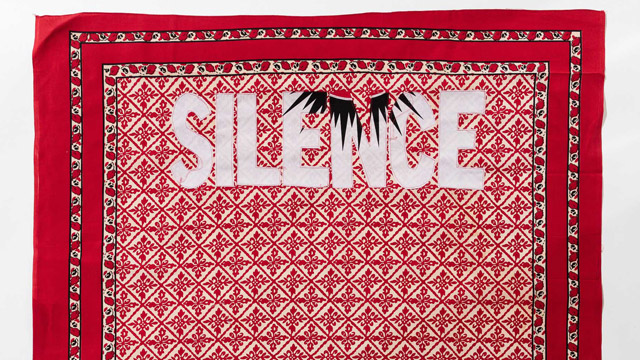
-
 Bernadette Van Haute
Bernadette Van HauteLawrence Lemaoana’s work, entitled SILENCE … FALLS (2017) consists of Kanga fabric with cotton embroidery, measuring 155 x 115 cm. Lemaoana is a South African black male, born in Johannesburg in 1982, who lives and works in Johannesburg. The work serves as an example of the ways in which young black artists in South Africa aim to express a specific South African identity which appeals to the global art world.
The use of Kanga fabric as medium is in itself very significant. Lemaoana states that: "Kanga fabrics [...] are used extensively in my work. Manufactured in the East, and brought to South Africa to be sold in markets and bazaars, the journey of the fabrics speaks of the idiosyncrasies and trade imbalances of globalisation. The textiles themselves though have a wholly different life in South Africa – they are regarded as significant markers of spiritual healing, imbued with great religious and spiritual power, used by diviners and fortune-tellers." (Afronova)
The Kanga cloth is “used specifically in Emandzawe rituals, both as clothing for the sangoma [diviner] performing the ritual and as cloth on the shrine inside the shrine room in which the ritual takes place” (von Veh, 2017, pp. 13-14). The use of this fabric thus establishes Lemaoana’s identification with both global culture and black African culture which does not belong to a mythical past but is still very much alive today. His own familiarity with the sangoma becomes clear when he maintains that the ambiguity of the traditional healer’s utterings parallels that of headlines in the news media. He also exploits the deeper meaning embedded in the three colours white, red and black to heighten the impact of his highly topical messages.
Lemaoana’s work is inspired by current socio-political events and the way in which they are reported in the local media. The composition Silence Falls evokes the #RhodesMustFall movement which began in 2015. This demonstrates the artist’s concern with the plight of the South African youth and his identity as an artist born in the 1980s – the so-called ‘born-frees’ who did not actually experience the ‘struggle’. The works of this generation of artists are described as “symptomatic of the new identity issues of the post-apartheid era. This young generation is appropriating a history that it believes has been confiscated and twisted in order to develop an alternative that takes into account its own subjective experience. Conscious of their responsibilities, these artists are helping to formulate and affirm a specific South African identity” (Pagé and Scherf, 2017, p. 8).
Lemaoana expresses his concern with socio-political issues through a critical engagement with mass media in South Africa. He is particularly concerned by the ability of the local media to shape social consciousness. By isolating news headlines and appropriating political slogans in his very own cynical way he “turns didactic and propagandistic tools on their head” (Afronova). As Lepage (2017, p. 117) states, Lemaoana uses the power of “words as favoured instruments in the political struggle”.
The importance of Lemaoana’s work is vested in his participation in the Fondation Louis Vuitton exhibition in Paris in 2017. The exhibition was divided in three parts; the first one was entitled Being there: South Africa, a contemporary scene and aimed to show South African vitality through the works of 16 artists. In the accompanying catalogue the curators Suzanne Pagé and Angeline Scherf (2017, p. 8) explained that their choice of artists was “based primarily on the action of the artists themselves, on their engagement with the current economic and social institutions, their awareness and conviction that they can act and play a role: BEING THERE”.
Interestingly the curators also comment on the fact that this younger generation of artists, in the context of ongoing economic and social divisions more than two decades after the end of Apartheid, sees it as its mission to transform “disenchantment into the energy for renewal” (Pagé and Scherf, 2017, p. 8). Achille Mbembe (2017, p. 16) elaborates on the current tensions in South African politics and culture which have led to a stalemate. In a society where consumption has become the quintessential state of being, the visual arts are in crisis, characterised by radical fragmentation and dispersion of reality (Mbembe 2017, pp. 23-24). “What is needed in contemporary South African arts”, writes Mbembe (2017, p. 24), “are concepts with which to seek out the real … . This will not happen without a new collective imagination that will help to facilitate the passage from the past and present to the future”.
This is what Lemaoana has achieved in his art. His participation in the show confirms his status as a contemporary South African artist who has managed to decolonise his art by “seeking out the real” and grounding it in a local or national context. Furthermore, in Lemaoana’s works there is no room for, what Mbembe (2017, p. 25) calls, “tropes of pain and suffering” or the injuries inflicted “by the forces of racism and patriarchy” – tropes that are the characteristic traps of postcolonial discourse. His art is decolonised in the sense that all the resources of cultural and artistic modernity – both in terms of medium and narrative – have been mobilised in order to render itself more relevant to a modern Africa and a global humanity (Ekpo, 2017, p. 20).
References
- Afronova. http://www.afronova.com/artists/lawrence-lemaoana-2/ (accessed on September 19, 2017).
- Ekpo, D. (2017). Manifesto for a Post-African art. Unpublished keynote address presented at the SAVAH Conference, Tshwane University of Technology, South Africa, September 21 – 23, 2017.
- Lepage, A. (2017). Lawrence Lemaoana. In S. Pagé & A. Scherf (Eds.), Being there: South Africa, a contemporary scene (pp. 116-21). Paris: Fondation Louis Vuitton and Editions Dilecta.
- Mbembe, A. (2017). Difference and repetition. Reflections on South Africa today. In S. Pagé & A. Scherf (Eds.), Being there: South Africa, a contemporary scene (pp. 15-25). Paris: Fondation Louis Vuitton and Editions Dilecta.
- Pagé, S. & Scherf, A. (Eds.). (2017). Being there: South Africa, a contemporary scene. Exhibition catalogue. Paris: Fondation Louis Vuitton and Editions Dilecta.
- von Veh, K. (2017). Textual Textiles: Gender and Political Parodies in the Work of Lawrence Lemaoana, TEXTILE,1-19. doi: 10.1080/14759756.2017.1337381 (Accessed September 5, 2017).
published March 2020
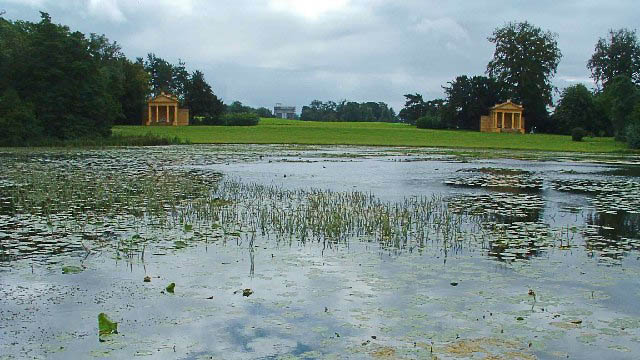
-
 Ernst Wagner
Ernst WagnerThe English Garden perceived as harmonious, lovely, picturesque or graceful to visitors in our present day, is charged with political resistance, struggle for power, projection of social utopias or flight into resignation. Like many interesting creations, these gardens are microcosms full of contradictions – particularly during the time they were created in the early 18th century: utopia and idyll, a mirror of society and its antithesis, dream and melancholy, imitation of nature and going beyond nature.
Stowe House Park, less than 70 miles northwest of London, is considered to be the first and most definitive site of an ‘English Garden’ – Lancelot Brown (1716 – 1783) who was employed there was the first person whose life-long occupation was that of a landscape gardener. The Stowe gardens embodied the ‘English Garden’ paradigm like no other and Benton Seeley’s guidebook (1742), the first garden guidebook to be published in the world, helped to spread Stowe’s influence throughout the 18th century as the model for the ideal English garden.As a country estate of the Temple family, it was – many decades before the redesign – first committed to Baroque, i.e. French models: symmetrically laid out, geometrized nature, combined with the pompous splendor of the manor building. The early model was abandoned and the new complex design of 26 hectares followed more innovative principles, for good reason; however, it still remained a status symbol of the wealthy family.
Thus the many buildings that were built in the park are demonstratively not Baroque. After all, Baroque embodied absolutism, which was despised. Instead, they were inspired by Renaissance, Gothic, antiquity, or Chinese architecture, pre-baroque styles or styles found geographically outside the borders of England. Each style tries to evoke its own mood: Gothic stood (and stands) for the morbid, the unearthly, China for the exotic, antiquity for the free citizenry.
In this sense, the names of the garden parts can be understood as allegories: Temple of Concord and Victory, Grecian Valley, Stauen von Saxon Deities (Germanic Deities) or Homer and Socrates, Gothic Temple, Elysian Fields and many others refer to cultural regions that represent a different, supposedly better social order. It is about an alternative concept to the absolutist principles, about freedom. The dedication inscription on the Gothic Temple makes this very clear: “To the liberties of our Ancestors”.
This directly decipherable political iconography is complemented by a differentiated iconology of forms. For example, the grass around the Temple of Ancient Virtue is subtly maintained as a lawn, while the grass around the ruins of ‘contemporary virtue’ grew wild until the ruins disappeared completely. The outdoors devours the contemporary, decadent, (neo-) absolutist tendencies. Thus nature was liberated from geometrizing corsets just as society was liberated from absolutism. As in free nature outside the garden with its unbridled forms, the garden becomes a free landscape in which free people move freely.
This conception of how such a landscape garden should look was influenced by three main sources: from the personal memories of nature that English nobility brought back with them from their Grand Tours through Europe; various descriptions of exotic Asian gardens; and, finally, from the classical landscape paintings by Ruisdael, Lorrain or Poussin.
Areas in the garden were designed for such three-dimensional pictorial stagings, which in Stowe featured over 90 selected scenes (or one might call them intriguing or harmonious compositions) that could be experienced from certain spots or areas in the garden. The visitor had to and has to set out to walk in order to experience all the spaces and perspectives along the way. Winding paths, which repeatedly open up to surprising glimpses of the unexpected, lift the visitor from everyday life and put him in a special mood. Hence, the course of the path is the central means of the landscape designer to develop his own dramaturgy. He steers the visitor and controls what he sees and when. What the visitor doesn’t see are typical walls. Instead the use of ha-has, a recess in the landscape similar to a sunken ditch, creates a vertical barrier while preserving an uninterrupted view of the landscape. The fine line between art and nature disappears.
The ever-changing weather, light and appearance of the plants, and the multifold of views along the way, allow the visitor to immerse himself again and again in an entirely new visual experience. This sensual experience should have a purpose. In the five-volume Theory of Garden Art by Hirschfeld, published 1779-85 in Leipzig, the aims are clearly outlined: On the one hand, the education of the observer through the enjoyment of art (“inner true cheering up of the soul, enrichment of the imagination, refinement of feelings”) and on the other hand, the “beautification of an earth which is our home for a time”. The aim is thus the refinement of nature by man as well as the refinement of man by nature.
The Temple family had initially acquired its immense wealth through sheep farming, and on the basis of its economic success it provided members of the English parliament for generations, including four prime ministers. English politics in the 18th and 19th centuries would be inconceivable without its influence. Richard Temple, 1st Viscount Cobham (1675 – 1749), who was a key figure in the founding of the park at Stowe, was initially a successful army commander in the War of Spanish Succession against France. In the early 18th century, however, as a supporter of the ‘Glorious Revolution’ (1688/89), which had led to the abolition of absolutism in England, he was marginalized by internal adversaries, which made the development of his garden so important for him.
In search of an aesthetic alternative to the ideologically rejected French garden (as the embodiment of absolutism), Chinese or Japanese gardens offered a central source of inspiration. William Temple had already published a book on Asian gardens in 1690. These gardens were above all a counter-model to the symmetrical arrangement of geometrically limited flowerbeds, the prototype of which was the park of Versailles. The irregular, free composition of trees, plants, stones, and water in Asian gardens was the model for a natural appearance that was as natural as possible and, in turn, created with the highest degree of craftsmanship, that is, artificially. In 1738, this enthusiasm for Asian gardens led to the construction of a Chinese house in Stowe – the first in garden history – an innovation that found its successors in many gardens throughout Europe.
Reference
Sibylle Hoimann, Garten; in: Fleckner U., Warnke M., Ziegler H. (eds.), Handbuch der politischen Ikonographie, Vol. I, München 2011 (Beck), pp. 388.
published January 2020
 Prudence Lau
Prudence LauAt the moment, I find it fascinating that such English and Chinese or Asian cultural exchange upon the built environment started so early on in the 18th century. It reminds me of the Chinese garden that focuses also on landscape, and an emphasis for reflection and escape from the outside world.
published January 2020
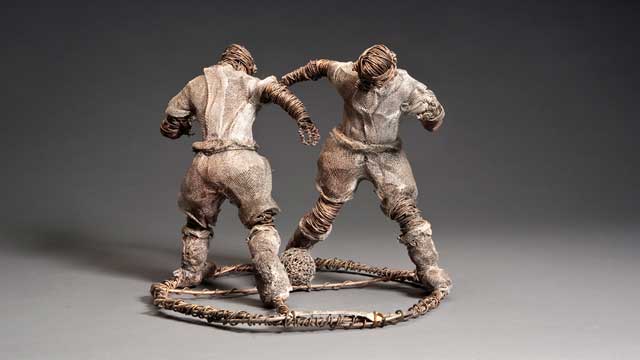
-
 Stefan Eisenhofer
Stefan EisenhoferHis artistic production is informed by the basic concepts of "love", "peace" and "liberty", and he expressly hopes that his works will help to create a better future.
Since 1996, after twenty-five years of working with clay, plaster, stone, cement and wood, Joe Big-Big has mainly used wire, iron nets and barbed wire to produce works with a very characteristic signature. Through the use of metal nets, he produces an effect of lightness and dynamism, even in sculptures several metres high. It was his fondness for big and high sculptures that earned him the nickname Big-Big.
Through his choice of materials he reveals the preoccupations that inform his work: he believes that people are free to decide whether they want to produce or destroy something, to encourage or suppress. In Joe Big-Big's work, wire and barbed wire, commonly symbols of oppression, captivity and division, represent the overcoming of bondage: they stand for prevention and protection. Joe Big-Big plays here with the notion of wire as an everyday material that normally goes unheeded, but which can become an instrument of human creativeness and global understanding through artistic activity. However, in Joe Big-Big's work this metal material seldom loses its ambivalence – for it is also a symbol of human labour and human toil. The artist makes use of these associations in works showing toiling people.
Joe Big-Big is intensely interested in the iconology of his metal materials and the objects he integrates into his works. Padlocks, for instance, symbolize the difficulties we get ourselves into, while keys stand for solving problems, freedom, peace and happiness. Coins represent the money we need to live, and clocks or watches are references to the time we need for solving our problems on the way to a carefree future. The metal materials thus symbolize wealth, strength and power. The artist also deliberately combines old with new metals, as a reminder that one needs to remember the old in order to be able to cope with the present and the future.
The themes taken up by Joe Big-Big come from nearly all areas of human life. His works are concerned with very personal issues as well as with political topics, such as war, poverty, flight, displacement, or the equality of women. He believes that his images speak louder than words, and he intends them to arouse emotions in the viewer, for "art without emotion, feeling or meaning is like a voice or a noise without meaning".

-
 Esther Kibuka-Sebitosi
Esther Kibuka-SebitosiRainbow Nation
The rainbow in the Bible given in Genesis 9:16 is a reminder that we have a covenant with God not to destroy the earth again by floods. “I set My rainbow in the cloud, and it shall be for the sign of the Covenant between Me and the earth,” says the Lord. God had made a covenant with Noah and his seed for generations. Genesis 9:9. And I, “behold, I establish my covenant with you, and with your seed after you”. Since we are all Abraham’s seed, we are covered in this covenant, although Jesus makes a better covenant in the New Testament. Returning to the rainbow nation, this covenant is saying “ no more destructions”. It is as if God is saying we should no longer fight each other but live together in peace. He made us all people with different colours (rainbow).
The metaphor describes a people with multi-cultures living together. The image of the flag is a symbol of togetherness or unity. The different colours. Adopted in 1994, the red, white and blue were adopted form the colours of the Boer Republic while the yellow, black and green were taken from the ANC (African National Congress) flag. The black colour is a symbol of the people; the green represents fertility of the land while the gold represents the wealth from minerals beneath the soil. The ANC adopted these colours way back in 1925.Associated with the flag is the national anthem. This is unique in that it has many languages:
- Nkosi sikelel’ Afrika
- Maluphakanyisw’ uphondo lwayo,
- Yizwa imithandazo,
- yethu,
- Nkosi sikelela,
- thina,
- lusapho lwayo.
- Morena boloka setjhaba sa heso,
- O fedise dintwa la matshwenyeh
- O se boloke (Ntate)
- O se boloke
- setjhaba sa
- heso,
- Setjhaba sa
- South Afrika
- – South Afrika.
- Uit die blou van onse hemel,
- Uit die diepte van ons see,
- Oor ons ewige gebergtes,
- Waar die kranse antwoord gee,
- Sounds to call to come together,
- And united we shall stand,
- Let us live and strive for freedom,
- In South Africa our land…
Songwriter: Cornelius Jacob Langenhoven
Summary
The Rainbow metaphor is characteristic of a nation that aspires for peaceful living; building a peaceful nation. The symbol taken from the Bible donating the Noahic covenant reminds us that God will no longer send the floods to destroy us.
The flag is a symbol of unity between the Boers and the African National Congress colours, which represents the whole of South Africa. It is a sign of hope and nation building.
Associated with the Flag and the Rainbow nation is the National anthem. It is written in many languages signifying the rainbow nation of multi-cultures.
References
- https://en.wikipedia.org/wiki/Rainbow_nation
- https://www.worldatlas.com/webimage/flags/countrys/africa/soafrica.htm
published January 2020
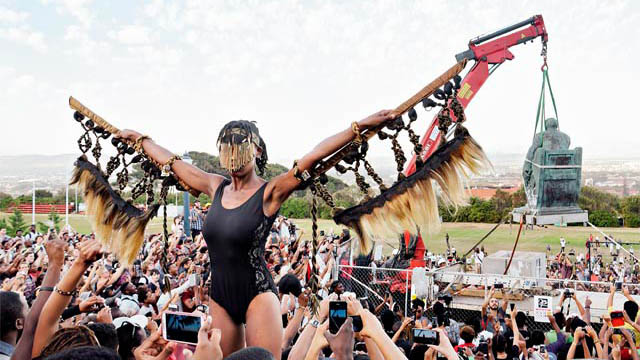
-
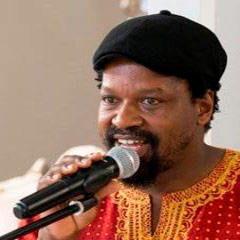 Bongani Mkhonza
Bongani MkhonzaIn this chapter, I trace the original source of the image that inspired the artwork by Sethembile Msezane titled, ‘Chapungu- The Day Rhodes Fell (2015). I envision that to get to the bottom of it, the etymology of the word ‘chapungu’ as used in the title of the artwork will have to be retraced and given context. The second section of the chapter discusses the content of the artwork in relation to how it endeavors to employ the old classical imagery in an attempt to negotiate new meanings. Lastly, borrowing from a family of critical discourse analysis theories (Fairclough and Wodak 1997; van Dijk 1997; Wodak 2001b) the strategies of monumentalisation as constructed by the dominant political culture will be analysed.
What is in the title? The etymology of the word ‘chapungu’.
The word chapungu is associated with a language used by the Shona people found in Zimbabwe. The Shona language developed as part of the greater Bantu heritage populating the central and southern Africa. According to the online VaShona project dictionary, the word chapungu refers to: “Any large, rapacious bird of the Falcon family, esp. of the general Aquila and Haliaeetus. The eagle is remarkable for strength, size, graceful figure, keenness of vision, and extraordinary flight” (https://vashona.com/en/dictionary/sna/chapungu). The Shona tribe of Zimbabwe created myths about the chipungu bird. Some elements of those myths seem to have been inspired by other world’s mythologies of birds with mythical powers. In the beliefs of the Shona, “the bird called chapungu (bateleur eagle) is a good omen, bringing protection and good fortune to a community” (Muzari 2013:1). The chapungu bird is also seen as a symbol of strength hope and renewal. The attributes used by the Shona people to describe the myths and beliefs about the chapungu bird seem to flow into the metaphor of a phoenix bird. Accordingly, I maintain that the context is key in recapturing the derivation of meaning behind the title of Msezane’s artwork. Shedding light on the etymology of the word ‘chapungu’ brings us to appreciate the connection between Cecil John Rhodes and the Shona people of Zimbabwe. Of course, to assume that the title ‘Chapungu - The Day Rhodes Fell’ (2015) is not connected to Cecil John Rhodes might be too farfetched. Evidence drawn from history shows that there is a direct relationship between Rhodes and Zimbabwe (formerly known as Rhodesia). Moreover, when you ask the Shona people where does the word Zimbabwe originate from, they will inform you that it is a Shona word for ‘Stone houses’. Stone houses are a “historical stone structure known as Great Zimbabwe, which is the second largest in Africa after the Egyptian pyramids” (https://www.sahistory.org.za/article/role-cecil-john-rhodes-british-south-african-company-conquest-matabeleland). Cecil John Rhodes and the British South African Company (BSAC) invaded Zimbabwe in 1890. After the invasion, the lands were named the Southern and Northern Rhodesia, to honour Cecil John Rhodes (https://www.sahistory.org.za/people/cecil-john-rhodes). This connection enlightens us in terms of what might have probed the artist to use the Shona word, ‘Chapungu’ as part of a title of her work.Old image new meanings
The foreground of the artwork depicts an image of the artist spreading her arms far wide projecting a takeoff position. It is known knowledge that humans will never fly by flapping arms with wings. Therefore, this self-defining act transforms her incapable human physicality into a metaphysical creature that is capable and ready to fly. The act by this metaphysical creature can also be received as its yearning for freedom and justice. Moreover, it also becomes a creature that is able to defy and transcends time and space. In her artists statement Msezane (2016) concedes that “she employs strategies of creating self-definition that are deeply rooted in looking at her own past, be it through spirituality or relearning South African history and its alternate narratives” (Msezane 2016). The image of this creature is strategically deployed for the audience to perhaps liken its agency to that of a myth of the phoenix rising from the ashes.Associated with the temple of the Sun in Egypt, and re-invented in Greek mythology, the story of the phoenix has been appraised as one of the world’s most-loved stories. It is the mythology of the world of modern monsters as told and retold by writers, philosophers, artists and poets through generations. Tacitus and Ovid are the two great authors from the classical period who stand out when painting a picture of the phoenix mythology. Perhaps it is mostly because of the way that Tacitus ventures out to humanise the attributes and actions of the phoenix and he refers to it as ‘he/him’. While, Ovid negates the phoenix of subject pronouns which are only used when referring to people. In telling his story, Ovid refers to the phoenix as ‘it’.
Tacitus narrated the story in the following detail, “in the consulship of Paulus Fabius (A.D. 34) the miraculous bird known to the world by the name of the Phoenix, after disappearing for a series of ages, revisited Egypt. It was attended in its flight by a group of various birds, all attracted by the novelty, and gazing with wonder at so beautiful an appearance. The first care of the young bird as soon as fledged, and able to trust to his wings, is to perform the obsequies of his father. However, this duty is not undertaken rashly. He collects a quantity of myrrh, and to try his strength makes frequent excursions with a load on his back. When he has gained sufficient confidence in his own vigour, he takes up the body of his father and flies with it to the altar of the Sun, where he leaves it to be consumed in flames of fragrance” (Bulfinch 19AD:[sp]).
Ovid’s story is almost similar the one told by Tacitus. Ovid’s version is narrated as follows: “Most beings spring from other individuals; but there is a certain kind which reproduces itself. The Assyrians call it the Phoenix. It does not live on fruit or flowers, but on frankincense and odoriferous gums. When it has lived five hundred years, it builds itself a nest in the branches of an oak, or on the top of a palm tree. In this it collects cinnamon, and spikenard, and myrrh, and of these ‘materials builds a pile on which it deposits itself, and dying, breathes out its last breath amidst odours. From the body of the parent bird, a young Phoenix issues forth, destined to live as long as its predecessor. When this has grown up and gained sufficient strength, it lifts its nest from the tree (its own cradle and its parent’s sepulchre), and carries it to the city of Heliopolis in Egypt, and deposits it in the temple of the Sun” (Bulfinch 19AD:[sp]). To this end, Msezane’s (2015) artwork references a known classical image of the phoenix to negotiate her struggle to recover her lost forms of visibility as a black woman in South Africa. In this way, it can be said that she is born again. Msezane (2016) is quoted as expressing that, “by examining past and present representations of black women…, in public and private domains, [she] focuses on the omission of iconic black women in history and mythology” (Gallery Momo 2016:[sp]).
At the background, the stage of the statue of ‘Rhodes falling’ is set. The site is loaded with the ambience of euphoria, yet almost similar to the scene of tragedy; it also gives you a baffling feeling of trepidation. A sense of uneasiness perhaps also emanates from an inferred ever presence of violence. Intended or imagined, the violence is visibly signaled by a force of a crane removing the statue. To anyone with eyes and curiosity, the crane’s arm also propounds an idea of a machine-gun. Unlike Camus’ (1942) existential theatre of the absurd, this background theatre in Msezane’s artwork seems to seal the fate of Rhodes, as if ‘he’ was going to be destroyed either way. Either by the truck that is physically depicted removing ‘him’ to a point of obscurity or by the machine gun.
Monuments and dominant political power
In concluding notes, monuments form part of a critical discourse in the legitimisation of a dominant political power structure. The public installation of powerful elites as iconic figures is either a precursor or descendant of the formulation of a nation. Either way, monuments and monumentalisation are a political construct that is trapped within the discourse of inclusion and exclusion. In response to this dilemma, Msezane’s artwork (2015) deploys a struggle to affirm the existence of the excluded in the formulation the powerful symbols for the nation. Most of all, her work challenges the percieved role of national symbols and commemoration spaces as key features in the portrayal of women as invisible subjects in history. As a young women growing up in Cape Town South Africa, Msezane looked around and saw no reflection of herself represented in public space such as the statues and monuments. Her performance piece where her female black body stands upright holding her wings straight out to the sides as if a phoenix rising from the ashes is indeed an act of self-affirmation. Msezane asks for no permissions but use the re-imaging as a strategy to re-insect her female black body as evidence of her existence.Bibliography
- Birch, D. 2009: The Oxford Companion to English Literature (7 ed.) The Theatre of the Absurd (1942). Oxford University Press.
- Bulfinch, T. 2019: AD Bulfinch’s mythology: the age of fable: the age of chivalry: legends of Charlemagne. New York: Modern Library.
- Fairclough, N. and Wodak, R. 1997: Critical discourse analysis, in T. van Dijk (ed.), Discourse Studies: A Multidisciplinary Introduction. Vol. 2. London: Sage, pp. 258–84.
- http://www.krugerpark.co.za/africa_bateleur_eagle.html (Accessed 20 January 2019).
- https://www.sahistory.org.za/article/role-cecil-john-rhodes-british-south-african-company-conquest-matabeleland (Accessed 19 January 2019).
- https://www.sahistory.org.za/people/cecil-john-rhodes (Accessed 19 January 2019).
- http://www.unwomen.org/en/news/in-focus/women-and-the-sdgs (Accessed 23 January 2019).
- https://vashona.com/en/dictionary/sna/chapungu (Accessed 20 January 2019).
- Msezane, S. 2016: Artist statement. Gallery Momo, Johannesburg.
- Msezane, S. 2017: Kwasuka Sukela: Re-imagined Bodies of a (South African) 90s Born Woman. Exhibition catalogue 2017, Gallery Momo, Cape Town
- Muzari, G. 2013: When a luck-bringing bird falters. The Standard News. Zimbabwe.
- van Dijk, T. (ed.) 1997: Discourse Studies: A Multidisciplinary Introduction. 2 Vols. London: Sage.
- Wodak, R. 2001: What CDA is about — a summary of its history, important concepts and its developments, in R. Wodak and M. Meyer (eds), Methods of Critical Discourse Analysis. London: Sage, pp. 1–13.
published November 2019
 Janina Totzauer
Janina Totzauer"Rhodes Must Fall" - Personal Experiences of a Guest Student in Cape Town
The protests around Rhodes Must Fall were a unique and cathartic experience for me as a German guest student in Cape Town in 2015. When I arrived in January, the city was on fire. Literally, because it was the hottest summer in a long time and Table Mountain had caught fire; figuratively, because something was boiling under the students. While the fire-fighting helicopters thundered over our heads, I caught up within a few weeks what the German school books on colonial history denied me. Cecil Rhodes, great colonial ruler and self-proclaimed philanthropist, had once donated large tracts of land to the University of Cape Town, securing for himself an imposing statue on the main campus. Sitting on a throne, the eternal bronze image gazes down from the heights of Table Mountain to the plains of Cape Town, the so-called Cape Flats, where even today many of the poorest of the poor live. The only problem with his patronage is that he illegally appropriated the building land that secured him the eternal gratitude of the university, befitting a colonial ruler. In other words, he stole the land from the locals and drove them out.
Twenty-one years after the fall of Apartheid in South Africa, it seems overdue that such a ruler be overthrown. The first generation of "Free Borns", all South Africans born in free South Africa after 1994, had reached their third year at the University of Cape Town and they yearned for this reminder of the colonial past to fall.
I remember hot afternoons spent in the streets. We demonstrated; all of us, white and black, "coloured" or "Indian" as they say in South Africa. Water bottles were passed around, the heat brought some of us to our knees. By the second demonstration, there were many more of us, hundreds. The driveway to the university was blocked. We were better organised. Water bottles, oranges and yoghurt were passed around. When I squinted puzzled at the countless milk cartons, they explained to me that they were there in case we had to wash our eyes out if the police would shoot at us with tear gas. I was still laughing. Later that afternoon, I provided milk to screaming faces and watery eyes. Art students staged performances and the main leaders fired up the crowd through the megaphone. "Rhodes Must Fall!", "Decolonise our University!" In between, old struggle songs were sung in Zulu. Songs that once accompanied the fall of Apartheid. I didn't understand a word, yet the power of the crowd pierced me. Something big was happening here, the history of the country yearned to be rewritten in the coming weeks.
I pushed my way to the student-organised congress about the next demo on the main campus. I wanted to know where to help. The atmosphere was heated. There was a lot of shouting. Anger spoke from many speakers. I wanted to get involved and raised my hand when, after a while, it was announced that no white people were allowed to speak today. I couldn't believe it at first. I was raging inside. I was on your side. I had been forbidden to speak and I was outraged. To this day, that small and subtle moment is a big turning point for me. Over the next few weeks, I worked my way from indignation to the realisation of what a privilege life I must have lived if I was so outraged to be banned from speaking for once. What a democratic paradise I must have grown up, if I take it for granted that I am allowed to speak and be heard. The fact that the ban was issued because of my skin colour brought me back into the prevailing conflict. If this one ban on speaking upset me so much, how must the majority of people in South Africa have felt during Apartheid. A trauma that even the first generation "Free Borns" have not yet let go of.
We were standing in front of a government building - I don't remember which one exactly - when the howling grenades went off. We were only about 40 students that day. I knew many of them from the art campus. It was hot and they kept sending white students forward to demand water from the government building's securities or to stand in the front row as a buffer against the police who besieged us. Skin colour as a defence mechanism. The demonstrators implied that whites were less likely to be attacked by the police. That they would be treated more politely and thus have their water bottles refilled. Just two small examples of grievances that seems to be out in the open in South Africa, but disappear under the colourful emblem of the "Rainbow Nation". When a small scuffle broke out between the young demonstrators and the few police officers, there were suddenly two bangs. So loud that the world seemed to sink into eternal silence afterwards. Everyone bursted apart, a young man sunk to the ground. He held his ears. He was later taken to hospital in a taxi.
It is the 9th of April when the protests are heard. The university has been closed for weeks because of the demonstrations, but today everyone gathers on the main campus. Cecil Rhodes is going to fall. We can't believe it yet. A crane is ready and thick winches hang around his body. Mr Rhodes' head is dripping with red paint, his jacket decorated with graffiti for weeks. We stand on the steps at Cecil's back, also looking down on the city. The city that in a few minutes will be a bit more free. More decolonised. There is singing and dancing. For the first time in weeks, the mood is exuberant. There are hundreds of us, representatives of all political parties take the microphone again and again, wanting to make sure they were there at this historically important moment. And then it happens, the statue is lifted from its pedestal. The crowd screams, drones circle in the air. Smartphones capture everything for eternity. And when the construction fences can no longer hold back the crowd, people also dance on the truck that slowly drives a Cecil Rhodes crowned with a dirty bucket off campus. The crowd continues to dance into the evening hours and as classes tentatively resume at the university the following week, the spirit of revolution is in the air. "We have been heard". To this day, the fall of Cecil Rhodes stands for a first strike in the struggle for the decolonisation of South Africa, not only on university campuses.Published December 2021Translation by Matthew Bremner
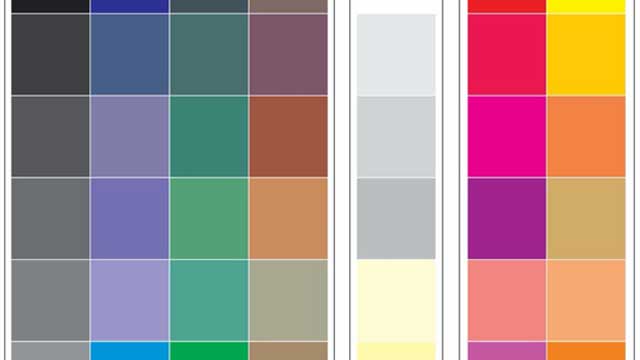
-
 Patrique deGraft-Yankson
Patrique deGraft-YanksonAkan definition of Colour
The Akan people have no precise terminologies that assign a ‘name’ which interprets into the meaning of colour the way it is understood in English and other languages. In other words, most of the answers to the question ‘what is colour’ makes very little meaning to a pure Akan speaker whose understanding of colour transcends a scientific definition. In spite of several efforts by contemporary linguists to subject the Akan concept of colour to nomenclatural consideration, the traditional Akan people continue to describe hues by their relationship with similar colours in nature.
Consequently, terminologies in Akan, which are associated with the word colour, are likely to describe what a hue looks like in association with the natural (or in few occasions, manmade environment) or how a hue makes one feel, think or behave. Among numerous attempts at coming up with an Akan word for ‘colour’, the ones many respondents settled on were yɛbea, subea, su, husuo, ahusuo and bↄbea. These words, which mean almost the same in Akan, literally describe the nature, quality or, probably more precisely, the physical look/appearance of something. By implication therefore, the terminologies deduced are more general and their usage go beyond the description of just the colour of an object or a situation under discussion.
Colour names
Colour names among the Akan people, are often given directly after identifiable objects within the known environment. Therefore, names given to colour in Akan have the tendency of affecting the perception, understanding and accurate adaptation of colour among the Akan people. Name, like colour itself, has strong cultural significance. Therefore, names that are understood in one’s language are likely to have better cultural associations and connections with their people than those that sound foreign.
In this regard, many Akan people are of the opinion that all efforts at identifying names for colours should continue with the culture of associating colours with the local names of known objects among the Akan people. For instance, if there are names such as ahabanmon (fresh leaves) for green and akokↄ serade/akokↄ aŋoa (chicken fat) for yellow, there could also be names like ahabanfunu/ahatawfun (dead leaves) for brown, gyafrane/gyanframa (fire flames) for orange, gon/dwene (gray hair) for gray, etc.
Number of colours
The number of colours recognizable by a traditional Akan are as many as those identifiable and describable in nature. As already indicated however, recognized Akan colour names and their identification are mostly in relation to those discernible in nature, for which reason their descriptions are broadly categorized. The following are colours available in the traditional Akan language.
- Kↄkↄↄ (Red)
To a very large extent, kↄkↄↄ, the sound of the name of the colour identified as red among the Akan people is more onomatopoeic than semantical in interpretation. Kↄↄ, the root word, visualizes the sensation of the word glow. Therefore, kↄkↄↄ actually connotes more to complexion with a strong bright colour. It commands an ambience of hot brightness, usually with scorching visual sensation, rather than a simple colour name. For this reason, kↄkↄↄ is attributable to all objects that emit some warmth in their visual ascriptions. Therefore, whilst a ripe pepper is described as kↄkↄↄ, ripe mangos, ripe oranges, glittering gold, burning coal, sunny skies, flames, the skin of a ‘white man’, etc. are all kↄkↄↄ as well. In the Akan colour scheme therefore, colours that could be placed analogous to kↄkↄↄ include red, orange, pink, wine and the like.
- Fitaa/Fufuw (White)
Fitaa/fufuw is white, light, plain, spotless, clean, neat, pure, holy, untainted and incorrupt. Moreover, fitaa/fufuw is always associated with cleanliness, purity, victory and spirituality. It denotates white coruscating brightness, visual spotlessness and stainlessness. No matter where it is spotted, the associated psychological and spiritual experience comes naturally, and this is inert in almost every Akan.
Another dimension of fitaa/fufuw is its direct association with light especially when it reflects bright objects to shine. When something shines or sparkles, or hyerɛn as it would be said in Akan, it is associated with brightness and for that matter, white. In this regard, a spark that would be lighted by any colour to give the feeling of brightness will be described as fitaa. The reason is that the psychological feeling of brightness invoked by the sensation is more important than its sensation on the eye.
- Tuntum
One does not need to understand the word tuntum to be able to link its semantic association with weight and heaviness. Tuntum connotes darkness and visual weight, and technically expressed, all the cool colours on the colour wheel fall within the brackets of colours in this category. Tuntum connotes darkness, gloom and heaviness. To the Akan, tuntum does not only stand for black, but absence of lightness, brightness, shine, glow, gaiety, happiness and sparkle. This is not to say that tuntum in Akan spells doom. Just as with all the other colours, the reason behind its application is what matters most to the Akan. For instance, the weight and compactness of tuntum also represents unmatched strength and solidity. Hence, expressions such as black power, black beauty, black star and black magic connote the highest levels or degrees attainable in the referent condition. So, whereas tuntum or dark colours are used in the expression of gloomy and moody conditions or situations, they are also considered for situations that require seriousness, formality, deep concentration, calmness, maturity, strength and energy. Again, in its association with darkness and stillness of dark night, tuntum also connotes calmness, coolness, rest, quietness and serenity.
The Akan Colour Chart: Minimal Dimensions of the Akan Colour Scheme
The following charts present attempts at putting into perspective the minimal dimensions of the Akan colour scheme. As mentioned earlier, everything that qualifies to be described as colour from the Akan point of view can be located within three broad colour spectra—tuntum (dark), fitaa (white) and kↄkↄↄ/memen (glow, spark, shine), and they physically manifest in the shades and tints of black, white and red. Right from this point, it is clear that colour among the Akan is perceived more with feelings than just the light sensation it emits. Therefore, the colours that fall under these themes are believed to share more physiological, psychological and spiritual feelings than aesthetical feelings (even though that is an integral part). In the examples of natural colours associated with colour names in the tables below therefore, the ripeness of pepper, mango, orange and tomatoes are all described as kↄↄ, establishing the overall feeling they evoke. The greenness of a virgin forest, the darkness of rain clouds, the depth of the deep blue seas and the blackness of charcoal are all tumm or tuntum (dark) because of their command of psychological heaviness. The bright skies, the white flower, cotton and the grey hair are all fitaa because they share similar ambience and invoke the same feeling of brightness. It should also be noted that apart from tuntum (black, dark), fufuw/fitaa (white, bright) and kↄkↄↄ/memen (red, glow, spark, shine), none of the associated colours has a name in Akan. What they have, at best, could be discussed as descriptions. In other words, colours of objects are rather described than named.
The following charts illustrate colour from the perspective of the participants in this study, as illustrated by the author:
Figure 1: Akan colour category Tuntum and its natural colour associations. (Photo: the author)
Figure 2: Akan colour category Fitaa/Fufuw and its natural colour associations. (Photo: the author)
Figure 3: Akan colour category Kↄkↄↄ/Memen and its natural colour associations. (Photo: the author)
From the above charts, the Akan colour reference scheme above was derived.
Implications for design and design education
Cultural understanding of colour from Akan perspectives will direct how colours could be appropriately grouped under the appropriate themes to enhance effective appreciation of design as well as effective communication. It would also ensure that the role of language and cultural interpretation of colour is given due recognition in the design education process.
Reference
- deGraft-Yankson, Patrique (2020), ‘Of the Akan people: Colour and design education in Ghana’, International Journal of Education Through Art, 16:3, pp. 399–416, doi: https://doi.org/10.1386/eta_00041_1
published November 2020

-
 Kerstin Pinther
Kerstin PintherAs a miniature, the sculpture Indépendence Tchao (2014) by the Franco-Algerian artist Kader Attia refers to the Hôtel de l'Indépendence in Dakar, Senegal. At the beginning of the1970s – a little over ten years after the independence of the west African country under Lépold Sédar Senghor and a few years after the first Festial Mondial des arts nègres (1966), the hotel was built by Henri Chomette and Roland Depret. Since the end of the 1940s and into the 1980s, the office of the French architects had built governemental and private buildings and others in numerous African countries. Indépendence Tchao was initially created as a site-specific installation on the occasion of the 11th Dakar Bienniale in Senegal. It refers back to the hotel high-rise with the sculpture; the ‘borrowing’ can immediately be recognized, above all by its characteristic brise-soleil façade. Kader Attia used discarded and somewhat rusty inex index boxes, stacked on top of each other. The inventory of the archive itself came from a dissolved administration in Algeria. Only a few kilometres away from the central exhibition venue of Dak'Art, the hotel still forms a striking, decidedly 'modern' architectural antithesis to the flat neo-classical colonial administrative buildings - an aesthetic incunabulum that symbolized the future in its outstanding verticality and modern furnishings. However, the former architectural icon is now empty and in a state of decay. Indépendence Tchao (the title is a reference to the famous song Independence Cha-cha from 1960/Kalle) thus refers both to a utopia that has grown fragile, the bursting of a dream; as well as to the persistence of colonial archiving and (also structural) standardization practices, to old and new (architect) networks in the postcolony.

Attia, Kadar. Pascale, Fernand Pouillon, Alger. 2012
https://inferno-magazine.com/2012/06/23/kader-attia-le-corps-utopique/ [Stand: 28.10.24]
Two further - this time photographic - works by the same artist also address the ambivalences and potentials of modern architectural promises: In the case of the photograph of a woman, seen from behind, surrounded by the mighty arcades of the 200-column courtyard, the connection between the body as the 'first architecture' and the 'built' architecture is central. Not least through the title Pascale, Fernand Pouillon, Alger (2012), it becomes apparent that the person is a transsexual. According to Attia in an interview, the strangeness in one's own body corresponds to the 'architectural' alienation that the inhabitants of the 'Climat de France' who had resettled from the Kasbah in Algier must have felt in the 1950s; the necessity of appropriation, re-territorialisation or even 'becoming at home' applies to both bodies (the human and the architectural).
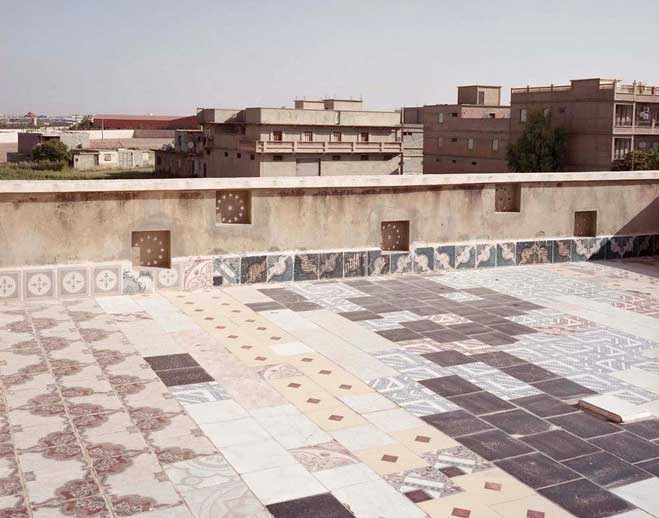
Attia, Kadar. Déconstruir - Reinventer. 2012
https://slash-paris.com/en/evenements/construire-deconstruire-reconstruire-le-corps-utopique/sous/3669 [Stand: 28.10.24]
A reflection on transgression and imagination also lies at the centre of another photo: Déconstruir - Reinventer (2012) actually shows only the results of a minimal intervention in the standardized construction method, and yet these traces of spatial action are marked here as meaningful in the sense of aesthetic place-making.
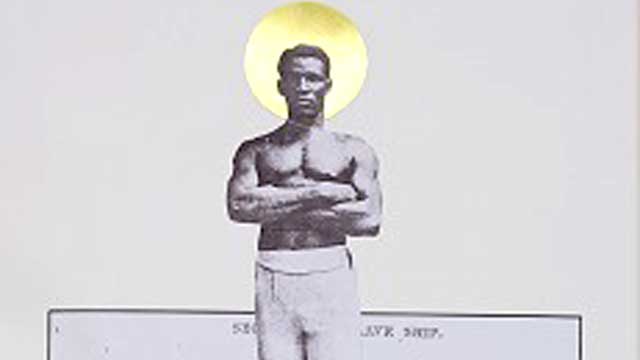
-
 Stefan Eisenhofer
Stefan EisenhoferGodfried Donkor is now considered one of the most renowned British artists with numerous acclaimed solo and group exhibitions in Africa, Europe, North and Latin America, including "Around the world in 80 Days" at the ICA (London), "Pin Up" at the Tate Modern (London) and "Authentic/ Excentric" at the Venice Biennale 2001. His multimedia visual art practice incorporates collage, printmaking, photography, film and performance. He is joint founder of "AISS-Art in Social Structures" and has participated in a number of residency programs in Africa, Europe, the US, and the Caribbean. In his works, Donkor creates visual references to the buried and repressed relationships between "black and white", between the upper and lower classes.
Based on profound research, he tells multifaceted counter-histories that reveal the hidden principles of production and exchange in historical and modern societies. At the core of his work are questions about the stereotyping of black people and their reduction to their physicality - firstly in slavery, then in sport, in the fashion- as as well as in the sex industry. In his work "From Slave Ship to Champ" (1992), for example, the slave ship, contrasted with images of black boxers in classic prizefighter poses, becomes a kind of "womb" and „uterus“ of particular types of racism. In Donkor's work, the historical slave trade also becomes a metaphor for current degrading mechanisms of the globalised world and leads to the question: How far is it from slave ship to champion - is it very far, or not far enough?
He questions the supposed "neutrality" of stock market prices and statistics in his series "Financial Times", in which he uses the serious-looking stock market pages of this newspaper as a background and alienates them collage-like with black and white images or full-colour glossy magazine figures of boxers and African women.
"The black body“ as a commodity in Western culture is also the focus of his "Southern Vogue" series. He traces the ways in which women's bodies, in particular, were and are degraded into marketable commodities and how people were and are degraded into financial objects. Donkor's work has much to do with the fragile and ever-threatened dignity of human beings. He asks questions about victimisation and innocence, about the balances and imbalances of the world, but does not allow for one-dimensional quick answers. Rather, he creates not only alternative histories, but also alternative icons. In his "Browning Madonna", "Black Madonna" (2002/6) and "Birth of Venus" series, for example, he takes up Western pictorial motifs, "africanises" them and thus creates a field of tension between the elevation and exploitation of - not only black - women and men.
Donkor's conceptually multilayered works are often inspired by places that played an important role in the historical slave trade. The artist uses the architecture of these places and the goods that were and are produced there to refer to the social conditions and interactions that lie behind them. This is exemplified by "Once upon a time in the West there was lace" (2007), with which Donkor reflects parallels between modern day and historical slavery through cotton and lace in Nottingham (UK). The luxury good lace, that is still synomymous with this English city, stands for the lavish lifestyle of the elites of the 18th and 19th centuries and at the same time for the exploited manufacturers who were often forced to live in great poverty. Donkor links this status symbol with his horrific history, and at the same time refers to the exploitative mechanisms of the current economic world.
The location also plays a leading role in the performance/fashion/video installation "Jamestown Masquerade" (2004). The Ghanaian coastal town of Jamestown is one of the first communities to make contact with Europeans in the 18th century. In Donkor's work, this place now becomes an archetypal city for commerce exchange and a symbol of the cultural interplay between Europe and West Africa from the 18th century to the present. In this performance, Present day Jamestown becomes the setting for a masquerade of fashion and memory in which African performers wear English costumes from the 18th century and are accompanied by music by Handel and Mozart. In this way, Donkor also points out that the meeting of two cultures does not necessarily have to be destructive, but can also offer a great deal of creative scope for both sides.
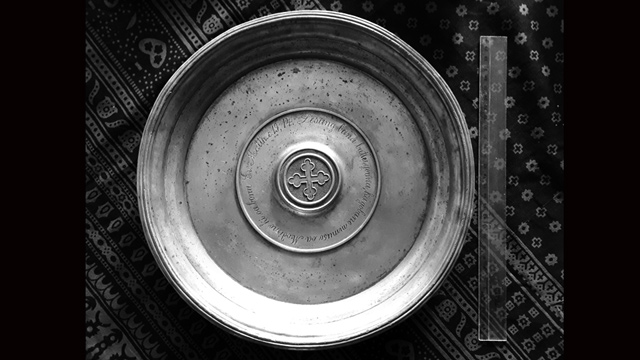
-
 Lize Kriel
Lize KrielA German bowl inscribed in Africa
In the process of finding out more about this baptismal bowl – where it comes from, who used it, and when it was discarded, it becomes a portal into South Africa’s contested past. Methodologically, a cultural-historical approach is taken to investigate the object as multiple signifier, not only as part of a transcontinental network, but also within a local, transcultural, context – what John and Jean Comaroff (1991, p. 200) referred to as the “long conversation” between European missionaries and African Christians.
The bowl was meant to be used with an accompanying, although, in this case, not quite matching, pitcher for the baptism ceremony, in which Christians use water to symbolise the blood of Christ washing away their sins. The Wallmansthal station where the bowl was found, was established by the Berlin Mission Society in 1869. The farm was about thirty kilometres north of Pretoria, today a capital city of South Africa. It became home to African converts gathered from the Kekana-Ndebele and several other pre-colonial northern Sotho polities (Van Rooyen, 1953, pp. 15-20). By the mid-twentieth century, the congregation was approximately 550 people strong (Schulze 2006, p. 456). Together with several other German protestant mission societies, the Berlin Mission contributed to the making of a Christian denomination referred to as “Lutheran” in South Africa today. After a century under white missionary tutelage, the African Church became independent as the Evangelical Lutheran Church of South Africa in the 1970s (Pakendorf, 2011, p. 115).
Knowing that a protestant congregation in Bochum, Germany, donated a church bell to the Wallmansthal Church in 1870 (Van Rooyen, 1954, p. 26), we can deduce that the baptismal bowl may also date from this era. The pitcher bears the mark of Gerhardi & Co. Judged from its Art Nouveau design elements and knowing that this Ludenscheid-based (Gerhardi) company was quite prolific in the production of cast pewter in the Jugendstil (Online Encyclopedia), a post 1890 manufacturing date seems equally probable.
Called Taufgeschirr (Baptismal dishes), bowl-and-pitcher sets of this kind are still being manufactured and used in churches in Germany today. Some congregations include images of old as well as new baptismal bowls on their websites as part of the material markers of their heritage. The exact same design displayed by the Evangelical Church of Illertissen in Germany on their website, is still in use today in the Evangelical Lutheran Church of Masealama (formerly the Kratzeinstein Congregation of the Berlin Mission Church) in South Africa’s Limpopo Province (Joubert, 2015).
Many baptismal bowls were inscribed with verses from the Bible. The quote on the Wallmansthal bowl is a contracted version of Matthew 19:14. What makes this bowl an exceptional object of transculturation, is the fact that its inscription appears in the early orthography of the local African language, Sepedi: “Lesang bana batle gonna, ka gobane mmuso oa Modimo ki oa bona” (NIV: “Let the little children come to me, … for the kingdom of heaven belongs to such as these”).
The bowl was used in church services on mission stations in the same way it would be used in protestant churches in Germany: the pastor would sprinkle the children of African Christians on the forehead with water which had been poured into the bowl from the pitcher. The initial African converts, however, were baptised as adults, only after proving that they had internalised enough knowledge of the Bible and convinced the white missionaries of their commitment to the beliefs and practices of Christianity (which, well into the twentieth century, remained entwined with Western ideas about civilisation).
To these converts, the baptismal bowl was symbolic of their ritual immersion into a foreign way of thinking, living and believing. And yet it was inscribed in their own language, invoking possibilities for cultural translation; for selective appropriation as well as for imbuing the alien culture with own interpretations, relating it to the indigenous and the familiar, and composing new meanings in anticipation of changing circumstances. The baptismal bowl is thus taken as reflective of broader processes of societal, economic and political reconfiguration brought about by the colonial encounter, but with an emphasis on African resilience.
On the site where the Wallmansthal baptismal bowl was used, these processes played themselves out in a series of extraordinary episodes that indirectly also related to broader world-political epochs: Up until the First World War, the Wallmannsthal land sustained an African Christian farming community. In 1936, as an attempt to address their post-war financial crisis, the Berlin Mission sold off a large section of the farm, giving the (exclusively black) African buyers full title deeds for their plots. Until after the Second World War, Wallmannsthal was a bustling African town giving its inhabitants the economic advantage of being close to job opportunities in Pretoria (Van der Merwe, 1987, pp. 69, 135).
In 1967 the Apartheid government forcibly removed all the inhabitants, including the Berlin Mission Christians who had still lived on the retainer of the farm where the Church and other mission station buildings were (Schulze, 2005, p. 458). Wallmannsthal then became a military base and arms depot for the South African Defence Force. During the late 1980s, with the Cold War still dictating international relations and South African whites slowly awakening to the need for political reform, the Defence Force contemplated the restoration of the site. These plans never materialised.
In the early twenty-first century, in a successful land claim, the Wallmannsthal farm was returned to the descendants of its early twentieth century owners. The restitution did not herald a final episode of utopian prosperity. Increasing demands on limited resources seem to be one of the reasons for the reinstated landowners’ current challenges, ranging from obtaining municipal infrastructure, to addressing the status of illegal squatters on their land, and designing the best possible ways of yielding a sustainable livelihood for an increasing population (eNCAnews, 2018).
Today the Evangelical Lutheran Church of South Africa is but only one of several Christian denominations in South Africa with missionary roots. Many more South Africans belong to African independent or African initiated churches – and, increasingly, international churches with their roots elsewhere in the Global South. The process of inscribing Christianity with own meaning and local significance, continues.
References:
- 925-1000.com (2018). Online encyclopedia of silver marks, hallmarks and maker’s marks. Retrieved from https://www.925-1000.com/silverplate_G.html.
- Comaroff, J & Comaroff, J. (1991). Of revelation and revolution. Christianity, colonialism and consciousness in South Africa I. Chicago: Chicago University Press.
- eNCAnews (2018, 27 October). Pretoria land claims. Retrieved from https://www.facebook.com/eNCAnews/videos/pretoria-land-claims/302862580316147/
- Evangelische Kirchengemeinde Illertissen (2019). Die Taufe. Retrieved from https://evang-kirche-illertissen.de/informationen/taufe/
- Gerhardi (2019). Gerhardi – Ein innovatives Traditionsunternehmen. Retrieved from http://www.gerhardi.com/index.php?id=9&L=0
- Joubert, A. (2015). A journey into the life of a mission-ethnographer. doi: 10.6084/m9.figshare.1375528
- Pakendorf, G. (2011). A brief history of the Berlin Mission Society in South Africa, History Compass, 9/2, 106-118.
- Schulze, A. (2005). “In Gottes Namen Hütten Bauen“. Kirchlicher Landbesitz in Südafrika: Die Berliner Mission und die Evangelisch-Lutherische Kirche Südafrikas zwischen 1834 und 2005. Stuttgart: Franz Steiner.
- Van der Merwe, W. (1987). Die Berlynse Sendinggenootskap en Kerkstigting in Transvaal, 1904-1062. Pretoria: Government Printers.
- Van Rooyen, T.S. (1953). Kronieke van Wallmansthal I, Pretoriana: Journal of the Old Pretoria Society 4, 15-20.
- Van Rooyen, T.S. (1954). Kronieke van Wallmansthal III, Pretoriana: Journal of the Old Pretoria Society 2, 24-28.
published February 2020
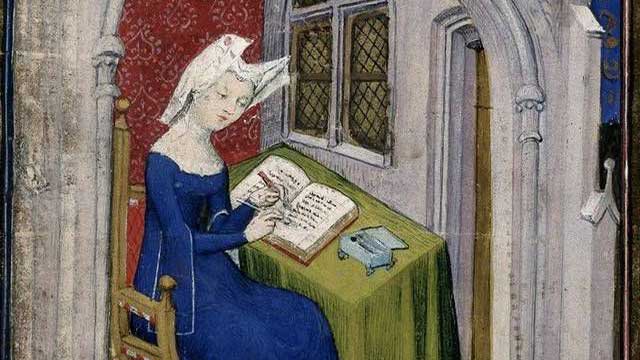
-
 Bea Lundt
Bea LundtThe picture of Christine de Pizan and our knowledge about her life show that this is not true. Christine de Pizan (1364 – c. 1429), born as Cristina da Pizzano in Venice, was a poet and author at the court of King Charles VI of France. Christine produced a large number of vernacular works, in both prose and verse. Her works include political treatises, mirrors for princes, epistles, and poetry.
This very famous miniature is an illustration from a book, handwritten in the years between 1410 and 1414 and preserved at the British Library in London (Harley MS 4431, Vol. 1, fol. 4 r). This manuscript contains texts by Christine de Pizan and is called The Book of the Queen, as it had been produced on behalf of and dedicated to Isabeau of Bavaria, wife of King Charles VI of France. There is another miniature showing Christine on her knees dedicating the book to the French queen. Christine can be identified by her facial features and style of dress.

Detail of: Master of the Cité des Dames and workshop, 1413 - 1414, parchment, 36,5 cm x 28,5 cm, British Library, London. © British Library, London. Photo: the author
In the centre of the aforementioned picture, a woman is shown sitting at a table and writing into a voluminous book. With her left hand, she is erasing coloured letters with a knife and with her right hand correcting them. This dynamic gesture of self-correcting fills her working situation with life. On her head is a headdress typical for a widow, the guimpe/wimple. Around the desk, we see some fictive architecture with a broad symbolic meaning: it shows a room which is specifically tailored to an intellectual working woman but also opens to the outside, as there are windows, an arch, and entryways. The roof of another storey marks the building as a town house. Though the scene is an interior one, the colours on the woman are bright, and there are warm red colours around her. This is different from older pictures showing clerical female authors in the narrow, closed rooms of a cloister.
‘Je, Christine’: An independent author defining her role in society
The picture shows a professional female author in an urban context in the process of writing a book and working for the public, where she is honoured as being part of the highest level of society. There are similar pictures with Christine sitting behind her desk with an open book and people coming and arguing with her in a lively manner. In one, a young man, who has been identified as her son, stands in front of her and speaks to her. Another one shows four men visiting her in her room and discussing her writings with her. Sitting Christine, standing men: the arrangement shows that the guests will leave soon. Such encounters are also atypical for a cloister, which is said to be the usual space for educated women.
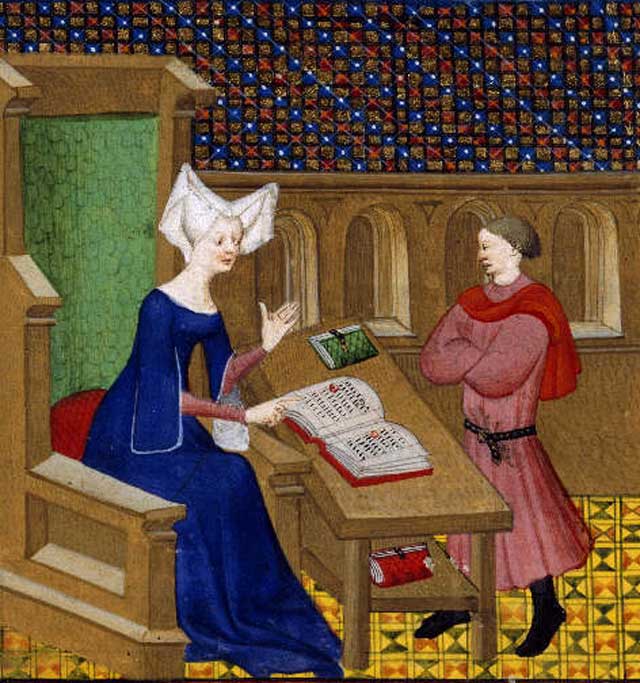
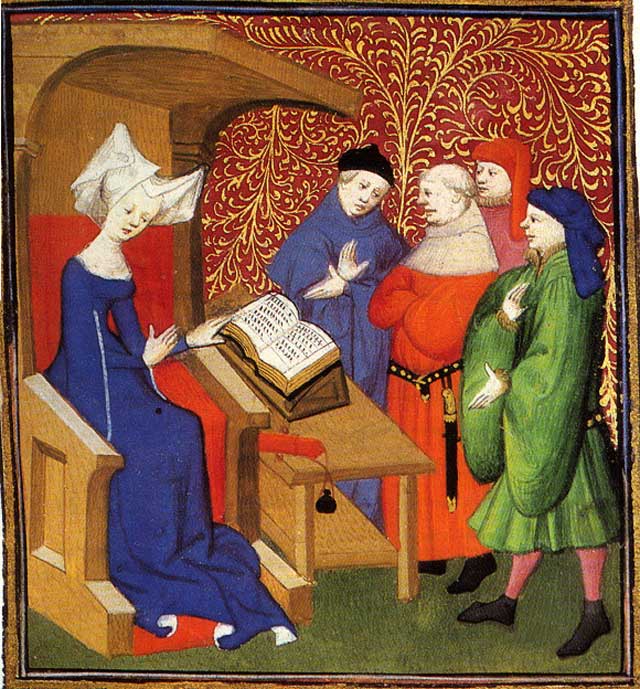
Detail of: Master of the Cité des Dames and workshop, 1413 - 1414, parchment, 36,5 cm x 28,5 cm, British Library, London. © British Library, London. Photo: the author
As experts see it, it was Christine herself who ordered the illustrator to characterise her in this manner. Several autobiographical comments of hers document that she liked to show herself living this individualist intellectual lifestyle. Traditional scholars call this typical for the Renaissance, which began a bit after Christine’s lifetime. Very often in her books we find ‘Je, Christine’ (‘I, Christine’), at the beginning of a chapter.
Christine’s life story
Christine was born in Venice in 1364 as the daughter of a doctor of medicine and astrology. He was called to the French court in Paris. Christine married a royal secretary and had three children. But then her father, her husband, and the king who had supported the family died. Christine was 25 years old and had to care not only for her children but also for her old mother and younger relatives living with her. She decided not to marry again but to support her living by writing. Her oeuvre contains poems alongside utopian, philosophical, historian, didactical, allegorical, and autobiographical texts. Noble families ordered her books and paid her well. In her old age, she escaped from the civil war in Paris to a cloister nearby where she died around 1429.
The first secular female author in Europe
With her Italian-French background, Christine is an example for the migration of intellectuals in southern Europe in the late Middle Ages and early Renaissance. She was not herself noble but came from an academic family and remained near the court. She was privately educated, mostly by her father, and also educated herself using the offer of the erudition centre in France. Living within a totally Christian cosmos with a spiritual way of thinking, she was not a clerical but rather a secular woman. In her books, she fought for gender equality, especially in education, as well as for recognizing the extraordinary performances of women in the past and in her own time. She wanted this knowledge to be part of a new understanding of history. She sharply protested against texts which reduce women to sex objects. With her pugnacious notes, she provoked the first literary quarrel about femininity and masculinity in Europe, the ‘Querelle des Femmes’.
The masculinisation of literacy and education in the modern era
In premodern Europe, competencies in literacy were considered more or less ‘feminine’. Girls learned to read at least the Bible to their families; noblewomen were taught languages and literature to be able to marry into different countries. The ideal for masculinity was fighting strength; sitting with books seemed to be viewed as non-masculine. Many kings and noblemen were illiterate. This changed in modern times. Literacy became part of the public world and school education developed as a privilege of men.
In the colonial period, Europeans attempted to impose this central European order on the African colonies: women were relegated to the private sphere, while men had the privilege of acting in public, which was more valued. The colonisers argued these gender roles were anthropologically fixed constancies, and they had the civilising mission of transferring this pattern to their colonies. But African scholars insist that in precolonial times, polar structures of different worlds for men and women did not exist, exactly as they had not in premodern Europe.
Conclusion: Confirming non-dualistic, fluid gender concepts
As we still need to fight against the discrimination of women and girls in educational systems worldwide, the message of the picture might be encouraging. This visual icon helps to deconstruct a common myth about Europe and to reject static ideas about continuities of bipolar gender structures. Even in the European Middle Ages, independent female authors were shown, combining inside and outside worlds. To see that it was different in history motivates us to see the hybridity of gender structures on both continents, which do not merely follow the dualistic scheme of men working in public professions and women working as housewives.
References:
- Christine de Pizan: Le Livre de la Cité des Dames. Stock 1986 (French).
- Christine de Pizan: The Book of the City of Ladies (Penguin Classics) rev. 2000 (English).
- Christine de Pizan: Das Buch von der Stadt der Frauen. Originally in Middle French. Translated and with commentary and an introduction by Margarete Zimmermann, Orlanda Buchverlag Berlin 1986, dtv 1999 (German).
- Roberta L. Krueger: Towards Feminism: Christine de Pizan, Female Advocacy, and Women’s Textual Communities in the Late Middle Ages and Beyond. In: Judith M. Bennett, Ruth Mazo Karras (eds.): The Oxford Handbook of Women and Gender in Medieval Europe. Oxford University Press 2016, pp. 590-606.
- Henry Kam Kah: The Sacred Forest. Gender and Matriliny in the Laimbwe History (Cameroon), c. 1750-2001. Berlin 2015.
- Oyewumi, Oyeronké: Colonizing Bodies and Minds. Gender and Colonialism. In: ibid (ed.): Invention of Women. Making an African Sense of Western Gender Discourses. Minneapolis, MN 1997, pp. 121-156.
Edited by Kelly Thompson.
published August 2020
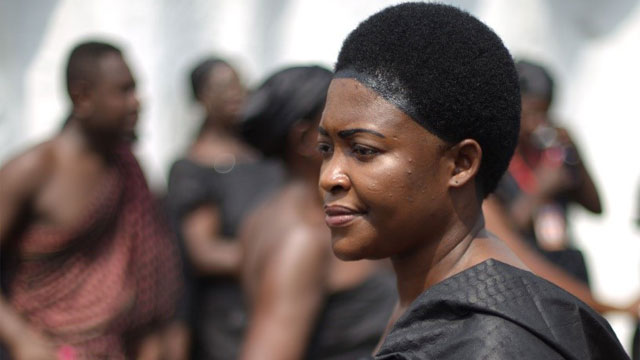
-
 Osuanyi Quaicoo Essel
Osuanyi Quaicoo EsselDifferent cultures may practise different hair beauty culture. Some of the hair beauty cultural practise could be unisex or may distinguish between sexes. In this instance, hair becomes a tool for sexual differentiation and serves as a precursor to one’s gender. It may tell which part of the world a person hails from. That notwithstanding, one may borrow hairstyles from different cultures other than his or her own for fashionable reasons since fashion inspiration is multicultural. Based on the cultural orientation and the role of a particular hairstyle to a group, society or institution, hair aesthetic ideals may be preserved as a tool for identity construction. A typical example of a hairstyle that has remained resilient even in the face of (neo)colonial and imperial hair aesthetic regimentation of the West on Africa is kentenkye hairstyle (Akan Women’s Hairstyle, 2008), popularly renamed as dansikran. Legendary has it that, queen mother Nana Kwaadu Yiadom II, (1917 - 1945), the sister of Nana Prempeh I, of the Asante Kingdom, performed the majestic Adowa dance during the restoration of the Asante Confederacy around 1935 in her kentenkye hairstyle, which inspired the then Governor’s description of her kentenkye hairstyle as a 'dancing crown' (Akrase, 2008) due to its visual effect during the dance. The phrase ‘dancing crown’ was linguistically corrupted as dansinkran which has become the popular name of the hairstyle.
The dansinkran hairstyle is noted for its simple, yet iconic stature in purely indigenous Ghanaian cultural milieu. Its selection was informed by its historical epoch, purely indigenous natural hair beauty care and treatment and socio-political significance in Ghanaian chieftaincy. It has proven to be an unadulterated Ghanaian hair fashion practice necessary in the decolonisation of hair fashion discourse. It is important in the decolonisation of hair discourse in the sense that it is purely Afrocentric which has evolved from its symbolic status to contemporary appropriation. The use of purely natural and sustainable hair treatment cosmetics with little or no harmful effect on the body makes it worthy of handing down to youth. This is because, there has been influx of artificial hair cosmetics with detrimental dermal effects which many youth subscribe to in the name of modernity without recourse to its side effects. The historical significance and interest of this hairstyle for posterity, especially as something of Africa practise, contributes in this regard to the decolonisation process. Dansinkran polity and politics among Akan kings, queens, chiefdom and the society in general reinforced its choice.
This hairstyle is achieved by trimming down the peripheries of the crown of the head almost to the skin while the remaining portions are trimmed to define the oval shape of a wearer’s head. The haircut gives the head a calabash-like shape. A natural black pomade-like colourant mixture composed of powered charcoal, soot and sheabutter, is then applied to the hair to give it intense blackened appearance. Charcoal has been in use for hair treatment in precolonial Ghana for many centuries. Considering the intense heat coupled with dust particle in Ghana and other African countries, the use of charcoal as hair treatment helped to protect their hairs from dust build up, dirt, oil and sebum that settled on scalp and negatively affects hair quality and growth. It implies that charcoal promotes hair growth. The natural hair colourant used in this process armours the hair with lustre and protection against bacteria and fungi. It nourishes the scalp and protects it from dandruff infections and maintains the hair’s natural moisture level. The eye lashes are also darkened to complement the facial look of a wearer.
The haircut helps to focus on the facials of a wearer since the hair receives little or no elaborate ornamentation. Usually, queen mothers who wear this hairstyle are not supposed to wear earrings during possessions or durbars. Judging from the benefits of charcoal in natural hair treatment it is not surprising that it features as essential ingredient in modern cosmetics manufacturing.
The dansinkran hairstyle serves as a socio-cultural barometer, political signifier and as a religious marker. This hairstyle help to identify queen mothers and female kings from other females. It is a symbolic hairstyle that was a preserve of the Akan feminine chiefdom and royals. Some priestesses also wear this hairstyle. Politically, the hairstyle symbolises authority, royalty and power of a female king or queen mother. In this sense, the hairstyle is status-defining in terms of the social rank. It is considered as inevitable lifestyle heritage that needs to be preserved among the chiefdom. When a king or chief passes on, a queen mother who is not wearing that hairstyle is not allowed to pay homage to him/her.
In the case of queen mothers, they complement this hairstyle with a feminine Ghanaian fashion classic named queen mothers’ style. This classic consists of a wraparound fashion of a six-yard fabric that stretches from the chest regions to beyond the knee, which is accentuated by another six-yard fabric draped in toga style. The wearing of this classic in addition to the hairstyle has bestowed onto it, the name dansinkran, hence, both the hairstyle and the classic are named as such. Despite the symbolism of the hairstyle, it now worn by the youth in contemporary times. It has acquired the name sweat. The only difference is that the youth who wear the hairstyle do not apply the charcoal mixture on their hairs. It has become unisex hairstyle among the youth.
The Western hair superiority politics could not erode the many centuries old hair identity visual code and marker that characterised the majority of the chieftaincy institutions in Ghana. As a traditional lifestyle culture that has proved unyielding despite black hair discrimination and politics, it is an important tool in the decolonisation of Afrocentric hair beauty culture practice and education.
References
- Akan Women’s Hairstyle. (2008). Retrieved from https://www.abibitumi.com/community/culture/akan-womens-hairstyles/
- Akrase, N. (2008). Pomp, power and majesty. Retrieved from http://akrase.blogspot.com/2008_01_01_archive.html
published March 2020

-
 Dong Xiaoling
Dong Xiaoling"Father” is a huge portrait created by Luo Zhongli (born 1948) in 1980. The picture shows an elderly man with dark skin and fine wrinkles on his face wearing a white headscarf. He is holding an old bowl containing tea in both hands. The old man’s fingers are rough, there is still dirt embedded in his nails and there is dirty gauze wrapped round his fingers. He has only one tooth left in his mouth. In the wrinkles on his forehead, on his brows and on the end of his nose there are glittering beads of sweat. This is the typical image of industrious peasants in China.
The importance of farmers was of great significance in China in the 20th century. Mao Zedong's assessment of issues concerning Chinese farmers commenced with the establishment of the People's Republic of China in 1949. Before the founding of the People's Republic of China, the peasants were liberated through a political revolution centered on the Agrarian Revolution; after the founding of the People's Republic, the common prosperity of farmers was achieved through the modernization of rural socialism. The role of the farmer changed from a participant in the revolution to a builder of modernization. Farmers were an important political foundation in the Mao Zedong era. Even today, there are still about 600 million farmers in China.
As a result, most of the works depicting farmers were created after 1949. Regarding the painting “Father”, the portrayal basically conforms to the definition of ordinary farmers. With the change of context during history, the visual interpretation of identity is very much influenced by the opinions of the post-modern.
Farmers are considered to be the people society relies on for a living – that is the reason why the artist named his work "Father". The model for this work was a farmer in the Daba Mountains in Sichuan province of China. The Cultural Revolution began in 1966. Mao Zedong advocated that young people from the cities should go to the countryside to receive re-education through hard labor. In 1968, Luo Zhongli, who was studying at the High School attached to the Sichuan Academy of Fine Arts, went to the Daba Mountains and stayed there for nearly 10 years. One Chinese New Year's Eve he saw an old man squatting outside a public toilet, guarding a pile of faeces as if he were guarding something of great value.[1] This image of a peasant bearing the burden of humiliation made a deep impression on the artist's mind. In 1980, when the artist was a student[2] at the Sichuan Academy of Fine Arts, he created his work “Father” by combining the image of Deng Kaixuan[3], an old man who was the artist’s landlord in the Daba Mountains , with the memory of the old man who had been guarding the pile of faeces. In 1981, Luo Zhongli was awarded the gold medal in the Second Chinese Youth Art Exhibition held in Beijing.
Controversy caused by "Father"
Today, the people viewing this large-size portrait may not be able to imagine what the people felt 40 years before when they stood in front of the large-size portrait “Father” for the first time. Those people experienced a visual shock and an impact to their values when they first saw this over 2-meter high portrait of a farmer. At that time, people were used to seeing the huge portraits of Mao Zedong or Marx only, and the monotonous idealized paintings of workers, farmers and soldiers.
During the Cultural Revolution, works of art were of the "revolutionary romanticism" style that is red, light, bright, tall, large, and full. A picture was required to contain brightness and sunshine as well as strong colors, especially red, and even shadows were not allowed to be painted in cool colors. The characteristics of such a picture is vividness and fine detail, and there are almost no traces of the brush. The themes of the works are mainly revolutionary idols and the history of the revolution. In this artistic style the happiness and prosperity of the country and the people are praised. This form of painting depicts a paradise full of sunshine and no pain, a utopian world of social optimism and revolutionary idealism. The depiction of Mao Zedong was always as an extremely tall well-built man in the center of the picture, in fact completely the image of a supernatural god. Mao Zedong was worshipped as an idol.
As an intellectual, Luo Zhongli had his own interpretation of this. "True and benevolent farmers and the like make me feel that there are people whose nature is unpolluted. The people are simple, honest, rustic. ‘Men of the earth’ with soil permanently under their fingernails. This kind of simple, down-to-earth nature often makes me feel ashamed".[4] The artist makes use of a huge portrait, a method traditionally used in nation leaders' portraits to express their sympathy, empathy and respect for ordinary farmers. At the same time, the artist tried to use painting to explain two kind of "truths", the moral truth and the artistic truth. This method is to use the truth of art to criticize the hypocrisy of morality. At the time this was however dangerous and controversial.
In fact, even for a long time after the smashing of the “Gang of Four” in October 1976, the “Mind Emancipation" had not really begun. At the Third Plenary Session of the Eleventh Central Committee of the Communist Party of China held in December 1978, the Communist Party of China clearly showed that the core of their work would be shifted from class struggle to the economic construction of modern socialism. However, at this time people's minds had still not been completely liberated from the shackles of the Cultural Revolution. Regarding the standard of artistic "authenticity", artistic creation at this time was still following the logic of the Cultural Revolution.
Shao Yangde (Chinese art theorist at this time) wrote an article in 1981 titled "Creation. Appreciate, comment, read "Father" and discuss with relevant reviewers"[5]. The article triggered a wide-ranging, long-lasting and intense academic debate on the field of Chinese art theory. Shao Yangde believed that "Father" showed the image of a farmer of the old society: numb, passive, sluggish. Therefore the painting gave the impression that farmers were submissive and pessimistic. He accused the artist of not injecting "noble revolutionary ideals" into "Father". "The image vilifies the peasant”. In fact, the living standards of Chinese farmers had nearly reached rock bottom during the Cultural Revolution while the political theorists were trying to convince the farmers that they were the masters of society and lived in paradise. This view also proved that between 1976 and 1980, many people in China were still living in utopian dreams and were unwilling to recognize reality. Luo Zhongli's "Father" shows a strong critical realism opposite to the rigid thinking at that time.
A dramatic irony is that before the work was sent to Beijing to join the Section 2 National Youth Art Exhibition, at the insistence of Li Shaoyanchairman of the Artists Association of Sichuan Province, Luo Zhongli replaced the cigarette that was originally behind the left ear of the farmer with a ballpoint pen (image below). In this way he showed that the man was an educated farmer with noble ideas in the new era. The artist's compromise was in the hope that his work would pass the intensive political investigation before a work of art was accepted, and thus been sent to Beijing. However, this modification shows the great irony of utopian fantasy.
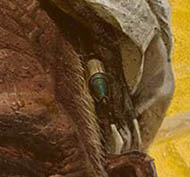
Luo Zhongli, 1980, detail © Luo Zhongli
When the works were successfully exhibited in the National Art Museum of China in Beijing in 1981, “Father”, the image of a farmer who endures the suffering and never complains, deeply moved hundreds of millions of people. The huge size and the hyperrealism of the picture were extremely fresh but tacit to those Chinese people who saw the work at the museum. Li Xianting, the editor of the official media "Fine Arts" magazine at that time, was also moved by the human compassion shown in the work. For this reason, in 1981 he used "Father" as the cover of the magazine. Only through the undisguised expression of reality can art find the truth it has lost.
Changes in social thinking after "Father"
In terms of artistic language itself, China originally had its own context of development and its own system of language. However, Chinese art since 1949 has been mainly influenced by the realistic art of the former Soviet Union, coupled with the Cultural Revolution’s censoring of the traditional Chinese context and the ban on Western contemporary art. Under the influence of this aesthetic inertia, representational realism has become the most acceptable visual narrative method for the public.
Luo Zhongli was inevitably influenced by the American photorealist Chuck Close at that time. However, instead of deliberately hiding traces of personality, emotion, and attitude to create a flat and indifferent picture as Chuck Close did, Zhongli added these feelings to his picture. "I feel that this form is most conducive to powerfully conveying all my feelings and thoughts. The arts of the East and the West have always absorbed and been influenced by each other. Forms, techniques, etc. are just the language that conveys my emotions and thoughts. If this particular language can say what I want to say, then I will learn from it.”[6] The artist seems to have used a more calm and objective approach, but made the most subjective elucidate of a farmer in the work "Father".
To the general public at that time in China, Chuck Close and modern art in Europe and America were unfamiliar and so far away. Even at the Sichuan Academy of Fine Arts, the school had bought a Japanese-published "Complete Works of the World" but it was locked in a cabinet. The students had to press their faces against the window, brush the condensation from their breath off the glass, and view the book as they would a cultural relic in a museum. Such a book would take 1-2 months to read and absorb –but only under such conditions it was possible to read about Western modern art.
For a period of time after this work, a group of artists who were contemporaries of Luo Zhongli returned to their innermost selves in pursuit of their own spirits and emotions. They became more willing to pay attention to people's daily life, and wanted to explore and express the beauty of human nature in ordinary life. The spiritual essence of their paintings was the continuation of the humanitarian sentiment.
It is precisely because of the success of “Father” that the artist was sent by the government to study at the Royal Academy of Fine Arts in Antwerp, Belgium at the end of 1983. He developed a comprehensive and deep understanding of European art and phenomena. Later, he held a personal exhibition at Harvard University in the United States, and thus gained a wide international reputation. Since then, his use of different techniques to express the language of painting has become more pioneering and expressive.
In addition to reflecting on and breaking through the constraints of the political dogma on art, Chinese artists are eager for artistic change. Art theorists have begun to introduce and translate a large number of works on the history of Western modern art, for example Herbert Read‘s: A Concise History of Modern Painting (1979), H. H. Arnason’s History of Western Modern Art (1986) and many more. In the 1980’s, influential art newspapers such as "Art" (reissued in 1976), "Art Translation Collection" (founded in1980), and "World Art" (founded in 1979) began to publish articles on a large number of Western modern art genres and artists. Faced with the influence of foreign culture as well as domestic social pressure to achieve modernization, the ruling party has adopted a more accepting attitude.
Precisely at that time, Western modern art and post-modern ideas came together and quickly merged in China. There is 1985 Art Trend[7] movement, the 89 Art Exhibition[8] etc. So far, Chinese modern art has entered the experimental stage on a large scale and has been continuously reconstructed.
However, what is significant is that the village in the Daba Mountains where the artist once lived has now lost its former prosperity. As villagers have started to go to work in cities across the country, the village has become very glum and mediocre, in sharp contrast to the prosperity of the cities. And those farmers who have moved to the city are also working hard to transform themselves into a part of the city. Farmers, who once held an important position in China's social structure, are now gradually being urbanized under the drive of the market economy, and are being marginalized in the city.
References
- Michael Sullivan, Art and artists of Twentieth-Century China, Shanghai, 2012
- Gao Minglu, Chinese Avant-Garde Art, Jiangsu Fine Arts Press, 1997
- LvPeng YiDan, The Art History of China Since 1979, Beijing, 2011
- WangYong, A History of Art Exchange between China and Abroad, Beijing, 2013
Footnotes
[1] During the Cultural Revolution, China's economy was extremely weak and faeces was the most important source of fertilizer in rural areas at that time.
[2] During the 1966-1976 Cultural Revolution, universities stopped accepting students, and the college entrance examination did not begin again until 1977. Luo Zhongli was admitted to the Sichuan Academy of Fine Arts in 1977.
[3] Deng Kaixuan was a farmer in the Daba Mountains. Luo Zhongli lived in the farmer’s home when he was in the Daba Mountains. Deng Kaixuan was also the model for the painting "Father". He has passed away now.
[4] Gao Minglu, Chinese Avant-Garde Art , ( Jiangsu Fine Arts Press,1997)P70
[5] “Fine Arts" Magazine, (Beijing,1981)Issue 9, P57
[6] "Fine Arts" Magazine, (Beijing,1981)Issue 2, Page 4
[7] The 85 Art Trend refers to an art movement towards modernism that emerged in mainland China in the mid-1980ies. The young artists at that time were dissatisfied with the line of leaning to the left of the art world at the time, and with the Soviet socialist realism art stereotypes as well as some values in traditional culture. They tried to find new blood from Western modern art, which triggered a nationwide art trend.
[8] 89 Art Exhibition, "Chinese Modern Art Exhibition" held at the National Art Museum of China in Beijing in February 1989. This is the first exhibition of concentrated Chinese avant-garde art including performance art and installation art. The artist Xiao Lu shot her installation "Dialogue" and the exhibition was forced to terminate. The shooting incident of "Dialogue" has therefore become a symbol of the 89 Art Exhibition and has an important position in the history of modern Chinese art.
published September 2020
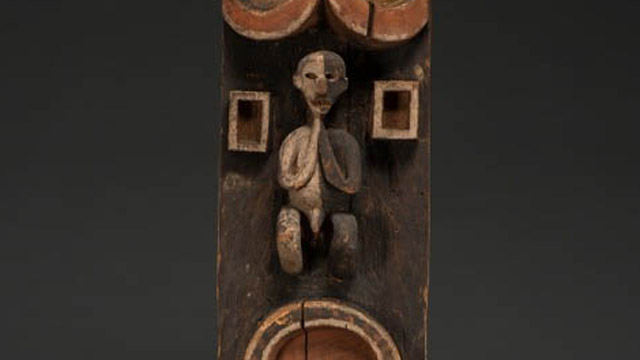
-
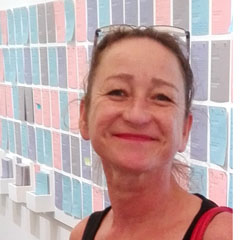 Karin Guggeis
Karin GuggeisObjects from the Global South in early collections of the Global North often lack any information about their specific local context. This is also true for this wooden sculpture made from a single block of hard wood, carved with different figures and forms on two sides and painted with natural colours in red, white and black. It was acquired in 1893 by the “Royal Ethnographic Collection” (Königlich Ethnographische Sammlung) in Munich, today the Museum Fünf Kontinente. No specific information about its geographic origin, its producers, users or use was documented in the inventory book. “Huge four-edged block, 1.80 high made of heavy wood, double-sided carved with human figures and lizards, heavily damaged by termites” is the only information recorded. The wooden block was sent from “Cameroon” (Kamerun) which is therefore documented as its region of origin. It was given to the museum as a present by Max von Stetten, a colonial officer in the German colony.
The post gained a new layer of significance through its inclusion in the almanac “The Blue Rider” (Der Blaue Reiter), one of the most famous and important publications on art in the early 20th century in the Global North. The almanac was edited in 1912 by two artists based in the environs of Munich, Franz Marc and the Russian Wassily Kandinsky. They designed the publication as a starting point for a new epoch of art, rejecting academic art and encouraging new forms of artistic expression. Thus, Kandinsky and Marc included reproductions of different non-canonical art forms, such as artworks from the Middle Ages, folk art, art made by children – and non-Western artworks, in those days called “art of the primitives” (Kunst der Primitiven), among them this sculpted block from Cameroon. In this way, the editors of the almanac aimed to break down the hierarchies between art forms from different times, regions and levels of professional skill, and to expand the canon of art in the Global North.
The editors’ fascination with non-European art had different roots: Wassily Kandinsky was a trained ethnographer and often visited ethnographic museums. Franz Marc, since his visit to the ethnographic museum in Berlin in 1911, especially admired sculptures from Cameroon. Thus Marc included a photograph of this wooden block to illustrate August Macke’s article “The Masks” (Die Masken). Marc captioned the picture simply “Cameroon” (Kamerun), its known geographic origin, and the country whose sculptures he admired.

Fig 1: Almanac "Der Blauer Reiter" (page 58-59)
In his article, the artist Macke stressed that for Africans their “idols” (Idole), as he called their sculptures, were a “visible expression of an invisible idea”, “a personification of an abstract term”. He also stressed the equality of the art forms from different times and regions. For example, Macke valued bronze works from the kingdom of Benin, in what is today Nigeria, and other ethnographic works, because they are just as expressive as a grave marker in the cathedral at Frankfurt. To demonstrate this non-hierarchical attitude to art from different regions and times, Marc and Kandinsky placed two photographs side by side on a double page in the almanac – on one side the Gothic figure of a knight, and on the other a bronze plaque showing a soldier from the kingdom of Benin, which also was in the collection of the Munich ethnological museum by then (Fig 1).
The later fame of the almanac, and of its publishers Kandinsky and Marc as artists, led to the wooden sculpture being named “The Blue Rider Post” in the narrative of the museum.
It is significant for global art history dominated by the Global North that, in contrast to our broad knowledge in respect of the European admirers of this object, very little is known about its original local context in the Global South. The state of our knowledge concerning its producer(s), its patron(s), its use, its specific place of origin, the meaning of special forms, colours, figures or gestures sculptured is poor. There are two reasons for this. First, in the Global North, there has been little interest in investigating its local context. Second, it is actually very difficult to carry out such investigations in respect of such badly documented early works in ethnological museums. To unfold these difficulties: the common method used to trace the local context of poorly recorded works is to look for stylistic similarities and ethnological background information concerning comparable objects in other collections or publications. Spending long periods doing fieldwork in the place of origin is too time- and money-consuming, as there are numerous badly recorded objects, especially in the early ethnological collections. Moreover, in the Forest region of East Cameroon, the assumed place of origin, there are numerous small ethnic communities which have been inadequately studied. Thus the poor results of previous research in the Global North are the following: The sculpted post is valued as unique in ethnological and art publications. Only single figures and their gestures show similarities with a few other objects in collections of the Global North. The current suggested origin of this carved work in view of these stylistic similarities is among the Lundu or Mbo people in the Forest region in East Cameroon. There it was probably used in a cult.
A new approach has been made possible by a provenance research project of the Museum Fünf Kontinente, funded by the German Lost Art Foundation and the Bavarian State Ministry for Science and Art. In collaboration with scholars from Cameroun and the presumed source communities, members of the project are exploring the provenance and the local context of this special Cameroonian wooden block, as well as the whole collection from the German colony of Cameroon donated by Max von Stetten to the museum between 1893 and 1896. Hopefully the blank sheet regarding the original context of this wooden block will be filled.
For comparison, also read Patrique deGraft-Yankson's analysis of this object here.
The post in the context of the the repatriation discourse: Link
References
- Eisenhofer, Stefan (2009): Kulthauspfosten (?). In: Bujok, Elke (ed.): Der Blaue Reiter und das Münchner Völkerkundemuseums. Staatliches Museum für Völkerkunde München, Hirmer, München. S. 16-18
- Erling, Katharina (2000): Der Almanach Der Blaue Reiter. In: Hopfengart, Christine (ed.): Der Blaue Reiter. Bremen, Köln. S. 188-240.
- Kecskési, Maria (1999): Skulptierter Holzblock. In: Kecskési, Maria (Hg.): Kunst aus Afrika. Museum für Völkerkunde München. Prestel, Munich, London, New York. S. 116.
- Kecskési, Maria (1982): Zwei beschnitzte Holzblöcke. In: Kecskési, Maria (ed.): Kunst aus dem Alten Afrika. Pinguin, Innsbruck. S. 238-239, 72.
- Macke, August (1912): Die Masken. In: Kandinsky, Wassily/ Marc, Franz: Der Blaue Reiter. Piper, Munich. S. S. 53-59.
- Marc, Franz and Kandinsky, Wassily (eds) (1912): Der Blaue Reiter. Piper. Munich.
published March 2020
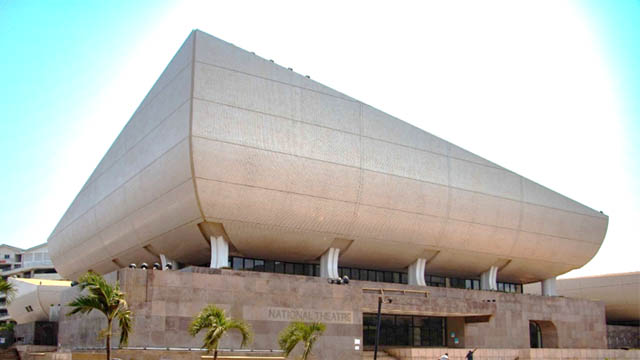
-
 Ebenezer Kwabena Acquah
Ebenezer Kwabena AcquahThis essay seeks to draw readers’ attention to the National Theatre of Ghana in order to recognize its relevance within the country’s visual cultural landscape. The National Theatre is a monumental edifice situated in the nation’s capital, Accra. It is supported by the government, and largely devoted to musical performances and stage productions, among others (Wilson, 1988). Theatrical performances in the National Theatre are part of the nation’s cultural heritage and present the people with creative thoughts and reflections on life. The establishment of the National Theatre of Ghana was, to a large extent, largely supported by the National Theatre Movement of the 1950s by cultural experts like Efua Sutherland and Professor J. H. Kwabena Nketia (Agovi, 1990).
The National Theatre was completed on December 16, 1992, commissioned and handed over by the Peoples Republic of China to the Government of Ghana on December 30, 1992 (www.nationaltheatre.gov.gh/history/ retrieved 2020, August 7). The Theatre was designed to be used by people from all walks of life and diverse age groups. Since its inception, the National Theatre has hosted a number of performances and exhibitions from both local and international communities with the intention of promoting visual culture in a heterogeneous global landscape.
Location, Structure, and Artistic Appreciation
The boat-like building is located near the junction of Liberia Road and Independence Avenue, adjacent to Efua Sutherland Children’s Park, in Accra’s central district.
Three distinct structural forms comprise The National Theatre building, with each structure housing its own performance group/company: the National Theatre Players, National Dance Company, and the National Symphony Orchestra. A closer look at the entire structure reveals three distinct parts aside from the structural forms mentioned earlier. The upper part portrays three boats joined together, supported by rectangular piers with curved outward projections, and a rectangular base with entrance and exit openings. In fact, the entrances and windows seem to be carved out of the rectangular base. All of the entrances are elevated from the ground level with a staircase, which leads up to the glass entrances and into the building (https://3rdworldarchitecture.wordpress.com/2018/02/04/national-theatre-of-ghana/ retrieved 2020, August 7). The base is designed to create a projection at the entrance that provides visitors with the necessary protection from inclement weather.

National Theatre. Aerial view over National Theatre. Photo: Cheng Taining, 1997, link: https://archnet.org/sites/1413/media_contents/15315.
Above the base, there are distinct white forms. They taper upwards from the centre and meet towards the outside of the base. The walls curve inwards and are lifted just above the solid base, with glass in between them, making the base and white forms more distinct and thereby reinforcing the differences between them. Small white tiles cover these forms, giving the building its shape and colour. A closer look at the shape of the National Theatre reveals a display of three boats/canoes or fishing vessels that meet at a central point, which takes the form of a captain's bridge. The entire structure is supported by curvy piers and rests on a rectangular base as presented in the image above.
A careful study of the architectural ‘language’ of the National Theatre reveals a combination of interior and exterior Asian architecture, symbolic Ghanaian forms and boat construction. Generally, Chinese architecture is based on the relevance of influential local cultural traditions and adherence to hierarchy (Lianto, 2020). It prioritizes spatial designs with balanced symmetrical central pivots and a reverence for nature and aesthetics. Additionally, the dominant use of red represents happiness, which is also found throughout the interior of the National Theatre.
The curvy structure of the theatre in general nods towards Asian architecture. The seating space is segmented along stepped floors and the undulating structured ceiling is reminiscent of waves with openings defined by lighting systems. In fact, the use of sculptural forms and other Ghanaian art works effectively combine with the architectural structure to convey the visual cultural landscape of the National Theatre.
Sculptures in Public Space
Sculptural forms executed by Ghanaian artists are carefully displayed outside the National Theatre. The following image shows a sculptural work that depicts a Sankofa, a traditional Ghanaian symbol.
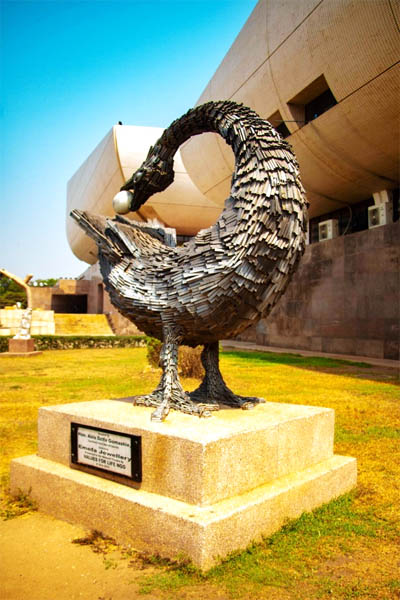
Emefa Jewellery, Sankofa, 2015, H: 11ft., Presented by Values for Life NGO to the National Theatre, Photo: Wisdom Dzigbordi.
The Sankofa represents taking the opportunity to reflect upon the past and applying significant and relevant ideas to current developments. Thus, the past has something relevant that must be considered and utilized as part of contemporary practice.
Education and Cultural Relevance
The National Theatre of Ghana is a significant cultural centre in Accra, Ghana and the entire form of this visual cultural structure provides people from diverse walks of life a place for entertainment and relaxation. The building is a visual architectural icon for the city and is an influential hub for creative art performances. It therefore serves as an important edifice to promote the arts, offering both Ghanaian and foreign artists a place to express their creativity.
In addition to providing entertainment and relaxation, the theatre seeks to educate people and stakeholders (who periodically use the place) on the responsibility of the National Theatre of Ghana as a strong cultural institution that ensures the development of culture, including the performing arts, and the need to respect cultural values. Through this education, the activities of the theatre are brought into focus, preserved, promoted and transmitted to the next generation for posterity and the promotion of visual culture across the world.
References
- Agovi, K. E. (1990). The origin of literary theatre in colonial Ghana, 1920-1957. Research Review, 6(1), 1-22.
- Frimpong, M. (2015). Towards an audience development plan for the National Theatre of Ghana. Unpublished Thesis. University of Ghana, Legon.
- Lianto, F. (2020, August 9). Building structure system of Chinese architecture, past and present. Retrieved from https://www.academia.edu/33602498/BUILDING_STRUCTURE_SYSTEM_OF_CHINESE_ARCHITECTURE_PAST_AND_PRESENT
- National Theatre of Ghana (2020). History of the National Theatre of Ghana. Retrieved on January 10, 2020 from http://www.nationaltheatre.gov.gh/history
- Wilson, E. (1988). The theatre experience (4th ed.). New York: McGraw-Hill Book Company.
- 3rdworldarchitecture.wordpress.com (2018, January 4). National Theatre of Ghana. Retrieved from https://3rdworldarchitecture.wordpress.com/2018/02/04/national-theatre-of-ghana/
published August 2020
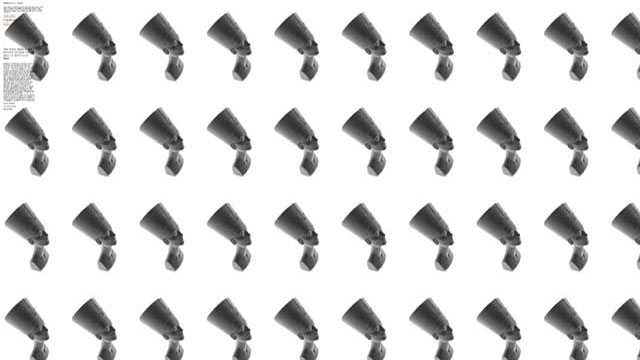
-
 Niklas Wolf
Niklas WolfIn ancient Egypt there was an elaborate system of reproduction around representative works of art. Gypsum casts of royal statues ensured that images of rulers were comparable and consistent nationwide. The formal type of a portrait bust, however, is as special as the material of Nefertiti’s representation. Stone figures, combined with a publicly effective installation, corresponded to ideas of permanence and a ruler’s longevity. The stone bust’s surface is coated with gypsum, which enabled a particularly fine design, and brightly coloured paint. The latter is preserved in its original condition (Tyldesley 2018).
Technology, material, surface and the design of the object play an important role in Nora al-Badri and Jan Nikolai Nelles’ project The Other Nefertiti (Pinther 2018). This project intentionally raises a number of questions that refer to discourses about provenance and access to both one’s own and foreign cultural assets, as well as their relocation. Moreover, it points towards a possible democratization of globally significant, mobile artefacts. What happens to a visual object when it is reduced to the essence of its digital data? How can digital processes and media be part of such discourses, and even possibly their solution? As part of an artistic intervention, the two artists penetrated the space of the museum and photographed the bust with concealed scanners, from which they were able to generate a multitude of detailed data to create a 3D print. Within the framework of a Common Creative License, this data is accessible online to the general public and provides “immaterial material” for future images as well (Nelles 2016). Anyone with access to the Internet and a 3D printer will therefore be able to print a copy that corresponds to the shape of the original, thereby democratizing the cultural asset. This gesture directly counteracts how strongly the accessibility of such assets are typically regulated – not even amateur photographs are permitted in a museum context, as the Berlin State Museums (Staatliche Museen zu Berlin) retain sovereignty over the object and its image. Both the generation of the data and the symbolic return of a Nefertiti copy and its burial in the Egyptian desert were documented on film. The project thus becomes part of a discourse critical of museal practices such as those of the Berlin State Museums: in reaction to the publication of the data, they referred to the legality of ownership, the ban on photography and the possibility of various – strictly regulated – accesses to the object and its reproductions. (SPK 2016)
Questions of accessibility and the relocation of cultural assets were also the topic of a seminar held at the Ludwig Maximilian University in 2019. A female student, who gave a lecture on the relocation of Nefertiti, contributed to the discussion by printing a Nefertiti bust using data from the Nefertiti hack. In contrast to the Berlin original and a printout based on Nelles and al-Badri’s data, this bust was greatly reduced in size and made of fluorescent material. A significantly expanded conception of art developed amidst questions of reproducibility, reproduction, aura and figurative trademarks. Unlike the officially signed copies produced by the Berlin Gipsformerei, these replicas are made at a greater distance from the original. No direct contact is necessary, the distribution is globally possible. There are several processes of translation and transformation that create new networks between bust and recipient. First, an immaterial object – the data set – is created, which gains new materiality through printing. The latter is freely scalable, a series of enlarged or downsized reproductions can be made, which would nevertheless correspond in scale to the dimensions of their source; materially, a Nefertiti created that way would never (want to) correspond to the bust of Nefertiti. Artists thus become the authors of new “truthful” objects. The story of the original begins to overlap with the narrative of its reproduction: the intriguing story of outwitting and interrogating the museum becomes an immaterial and performative work of art, which exists on an equal footing with the shapeless dataset and the multitude of printed and altered Nefertiti busts.
What can an object do as a representative? Which discursive spaces does it operate within? What kinds of questions can be asked of the original and copy? Which terminologies are capable of describing new metamorphical translation processes and aesthetics?
Critical comments on the Nefertiti project point out that simple, transportable scanners would not be able to capture images that would allow such high-resolution data sets. It is possible that Nelles and al-Badri gained access to professional scans commissioned by the Berlin State Museums or that they themselves had a replica of the bust scanned (SPK 2016). Both remarks are difficult to verify after the fact and do not affect the intention of the project.
Little is known about Nefertiti’s life; she encountered the global visual memory through a singular object, the portrait bust exhibited in Berlin, which stands for timeless glorified beauty and power in its own right. Questions about the accessibility of such images are already inscribed in the contexts in which they were created. In the ancient Egyptian tradition of exhibiting, powerful pictures worked between showing and concealing, they functioned as temporarily enlivened representatives of royal or divine power (Hornung 1971). Closely bound to constantly changing contexts of religion and rule, they had a constitutive memorial function in society, represented absent power, and were threatened by iconoclastic destruction. With the beginning of the colonization of the African continent by Western powers, Egypt’s cultural heritage was of particular archaeological and political interest to both public and private collections, as well as the art market.
(Read more on the history of the Nefertiti bust and the concept of partage...)
In contemporary terminology used to discuss ancient Egypt, terms of similarity (likeness) were summarized in discourses between original and copy: tut means (perfect) similarity; image, role and model coincide in one object and correspond to each other. Tut ankh is a living image (Tyldesley 2018) – (…) conceptual art was designed to represent the exact nature of a thing or person in the simplest way possible (…) (Tyldesley 2018). Perhaps the busts of Nefertiti – the dislocated cultural artefact in Berlin, as well as the multitude of possible reproductions from 3D printers worldwide – fall into very similar transcultural categories of representative likeness.
Delve deeper into the reception history of the bust.
References
- Hornung 1971: Hornung, Erik. Der Eine und die Vielen. Altägyptische Götterwelt, Darmstadt 1971
- Nelles 2016: Nefertiti Hack. Artist homepage: http://nefertitihack.alloversky.com (25.01.2019)
- Pinther 2018: Pinther, Kerstin; Weigand, Alexandra (Hrsg.). Flow of Forms / Forms of Flow. Design Histories between Africa and Europe, Bielefeld 2018
- SPK 2019: Stiftung Preußischer Kulturbesitz: „Nefertiti Hack” ein Schwindel?, 09.03.2016. http://www.preussischer-kulturbesitz.de/meldung/article/2016/03/09/nefertiti-hack-ein-schwindel.html (25.01.2016)
- Tyldesley 2018: Tyldesley, Joyce. Nefertitis Face. The Creation of an icon, London 2018
published February 2020
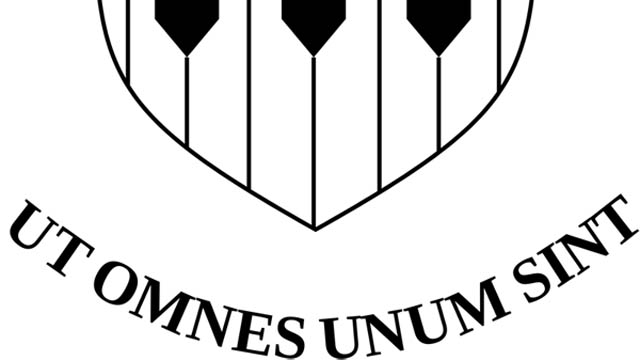
-
 Patrique deGraft-Yankson
Patrique deGraft-YanksonSchool crests, school logos or school emblems as they are variously referred to are a popular feature in the functions of all academic institutions in Ghana. They are normally designed to visually reflect the key ideologies and philosophies upon which educational institutions thrive. In determining a logo for academic institutions therefore, efforts are put in place to ensure that they serve an appreciable level of visual representativeness. By this, school logos in so many ways establish emotional connections with parents, students and other stakeholders, whose interpretations and perceptions determine their level of confidence and trust in the institutions.
This logo, by its very visual appeal, informed by the familiarity of the key compositional element and simplicity, generates a point for discussion. Moreover, the popularity and the history of Achimota College always makes it an important destination for various studies pertaining to senior high school education in Ghana. In my current interest in the study of icons and symbols therefore, the Achimota School crest comes handy, worthy and accessible.
The designer of the Achimota School crest is not really known as most of the literature on the school's history is silent on the subject. However, judging from the fact that the key concept behind the logo emanated from a popular quote from Dr Emmanuel Kwegyir Aggrey, the Old Achimota Association attributes both its origin and design to him (OAA, 1973). The creation of the Achimota School crest follows strictly the conventional crest design procedures which inform the design of several school crests in Ghana. It is composed of a classic narrow base shield, with the all-important motto of the school, ut omnes unum sint (Latin phrase meaning ‘that all may be one’), rendered in an arc form below the shield to provide a mantling and support of a sort to the design. In a rather minimalistic fashion, the key element of the design which also represents the main ideal of the school (the piano keyboard) has been rendered in amazing level of simplicity which makes it easy to perceive and reproduce by all graphic reproduction methods.
By this design process, the Achimota school logo offers a depth of meaning without being too literal in its composing elements. It has a pleasing contrast between dark and light, and connection to the existing school structures. Most importantly, the logo has sustained the semiotics and narratology which students, parent and stakeholders have always responded to since the establishment of the school.
It can be said that the logo of the Achimota college is more than a visual representation of the ideals of an educational institution. By mere consideration of the diversity in the caliber of people who masterminded its foundation, the school’s logo could indeed be described as the very foundation upon which the school was built. The logo seems to echo silently a belief that underscores the essence of peaceful coexistence of all manner of people, as exemplified in the collaboration of people of different colours from different parts of the world coming together to establish an institution of that caliber. It must be noted that the use of black and white keys of the piano to signify the harmony that comes along with peaceful co-existence of people of all races mean a lot more than anti-racial advocacy. It is obvious that Aggrey, drawing from his own experiences as a black young man who has been able to successfully attain the feats that could be equaled to what any white young man of his age could attain, was drawing the attention of the African youth to their own strength and capabilities. This is because Aggrey lived in a time when the “black man” looked up to the “white man” as an embodiment of all wisdom and custodian of all the goodies that mankind needed for their existence. The idea that he, as a black young man could attain a higher education just as the white man had not been very much considered. Aggrey making himself a case for the possibility of the black race mixing up perfectly with the white race to produce something good therefore seemed to be the underlining principle for the creation of the logo of the Achimota school.
The question of Aggrey creating this logo not for some cooperate body or a church is also an interesting factor to consider. As far back as 1924, Aggrey sought to established the efficacy of ‘education’ in the promulgation of ideals, principles and philosophies. This is deducible from the efforts he put in co-founding the Achimota College with Sir Frederick Gordon Guggisberg and Rev Alec Garden Fraser; opening up the college for both male and female; and ensuring that teachers were made up of blacks, whites, males, females. This indicates Dr Aggrey’s confidence in education as an important avenue for the promotion of peaceful co-existence and harmonious living. He believed strongly that quality education would contribute to balance and a peaceful society, and promote his conviction that ‘black keys of the piano give good sounds and the white keys give good sounds, but the combination of the two gives the best melody’. What a beautiful reason for all mankind to live as one!
Considering ongoing efforts towards the achievement of a coherent global community, as well as the premium laid on education as a single unit that can be used to achieve the sustainable development goals, it could be concluded that the relevance of the Achimota school logo is important today more than it has ever been. It therefore makes a whole world of sense to argue that the logo of the Achimota school could be considered as a strong icon for well-balanced education and a perfect advocate for education for sustainable development (ESD).
References
- Old Achimota Associstion (1973). Dr Aggrey. Retrieved August 3, 2020, from Retrieved 03 https://sites.google.com/site/oaa1973akoras/home/founders/dr-aggrey
- Wada, K. (2010). Achimota School. Retrieved August 3, 2020, from https://www.blackpast.org/global-african-history/achimota-college-achimota-school-1924/
published August 2020
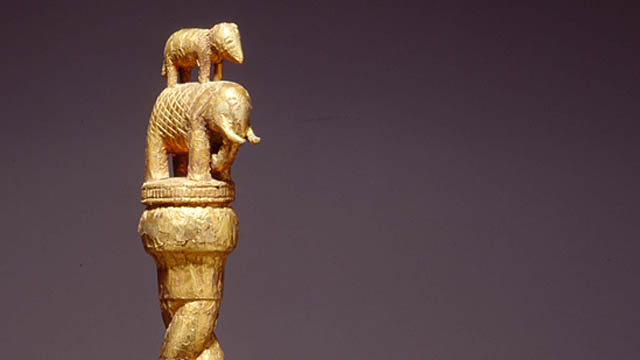
-
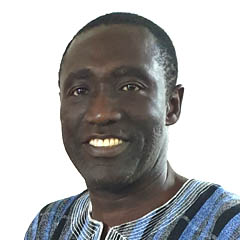 Yaw Sekyi-Baidoo
Yaw Sekyi-BaidooThe Akan linguist1 staff icon represents various aspects of the philosophy, values and symbolism of clan, town or ethnicity. The elephant icon, like other symbols of the Asante empire, is used in fabric and stool designs as well as the finial of the staff (Sarpong (1971:24), which is an important group formal identity symbol. Users of the staff include storytellers, clan linguists, and, most characteristically state linguists. Yankah has this to say about the state linguist staff:
“Every Akan chief or king has two or more staffs. The higher a chief’s status the wider the range of staffs, since and important chief deals with a greater variety of social and political situations and has to match various situations with relevant messages (1995: 33).”
The meaning and artistic significance of the finial of the linguist staff may be seen by considering the choice and artistic design of the finial, the identity of the user, and finally, the context in which the staff is used. The identity of the user, in this context, is the linguist of the King of Ashanti, a very powerful Akan monarch, whose influence and control is acknowledged over centuries and across different parts of Ghana.
The paper examines the motivations for the choice and representation of the Elephant-Calf symbol, and the overall cultural and social significance of the use of this symbol.
The Symbol in Context
Two aspects of the image might are important for our current discussion: the finial itself, and the upper shaft on which sits the base carrying the finial. The upper shaft consists of two veiny lines which with a wisdom knot in their middle. The next is the finial – Mother Elephant with its Calf Standing on it.
The choice of the elephant is based on the preeminence of the elephant as an animal. The elephant is universally used as a royal symbol of power and strength, and among the Akan of Ghana, Kwarteng (2006) reports that the paramount chiefs of Denkyira, Eguafo, Abura, Ajumako, Abeaze, Offinso, Wassa Amenfi have elephants as their royal symbol. The elephant is called ‘sono’ in Akan, and the morphological connection between the name and the Akan expression for immensity ‘so’ seems to emphasize the natural immensity of the elephant, which is also be expressed in the following:
‘Ɔson akyi nni aboa.’
(There is no animal beyond the elephant).
The leadership and protection associated with the elephant is represented in the saying:
'Wodi esono akyi a hasuo nya wo. '
(When you follow the elephant you are safe from the early morning dew of the bush)
The Akan see the immensity of the elephant from the social, political and spiritual perspective also. Socially, the flesh of the elephant is socially significant as it, unlike all other animals, provides meat for the whole community for an extended period. Politically, its parts, skin, ears and tusks are crucial aspects of the insignia of royalty. Again, spiritually, among animals, the elephant is seen to have the greatest ‘sasa’, a kind of spiritual force normally associated with humans. The ‘sasa’ is a spirit which protects its possessor through life and which assails its killers after its death. Sekyi-Baidoo (1994) reports of extensive activities for preventing the ‘sasa’ of the elephant from escaping from the carcass to assail its killer. Overall, the elephant stands for physical, spiritual and social preeminence among the Akan.
The Representation
The Upper Shaft
According some traditional consultants, the veiny lines, as seen above, represent the demands of the governance of the empire, which are controlled by the knot, symbolising the cohesion, control and direction of the Asantehene.
The Parent Elephant
The finial representation captures the side view of the elephant, showing major aspects of its immensity and power - the body, which showcases its immense size, the heavy legs, showing its matchless stability, strength and force; the trunk, with which it breathes, smells, grasps and lifts objects and produces sound; and the tusk, with which it digs, lifts, gathers, attacks and defends itself. The limbs and the trunk are presented in neutral posture: both feet firm on the ground and the trunk lowered – not picking anything nor blurting - suggesting placidity. On the other hand, the tusks, bigger than natural, are lifted, pointing to an ever-readiness - not to attack, but to defend. It is on this placid but defence-ready image of the elephant that the dependant calf is placed - for optimal comfort and security. It is explained that this image symbolizes the prosperous relationship between the Asantehene and the people over whom he rules - not intimidating them with his supreme power and authority, but ensuring their peace and security.
The Calf
Interestingly, unlike the elephant, the calf is presented panoramically - without the details of ears, tusk and trunk - its source of perception, control, nourishment and defence, for which it would depend on the mother. This is understood to symbolise the governance relationship in the Ashanti Kingdom where the subjects look to the Asantehene for intelligence, protection and support.
According to traditional informants, the elephant-calf image is sometimes interpreted as symbolizing the permanence of the supremacy of the Ashanti Empire - from 1701 to present – perhaps, unlike others powers which rise and fall.
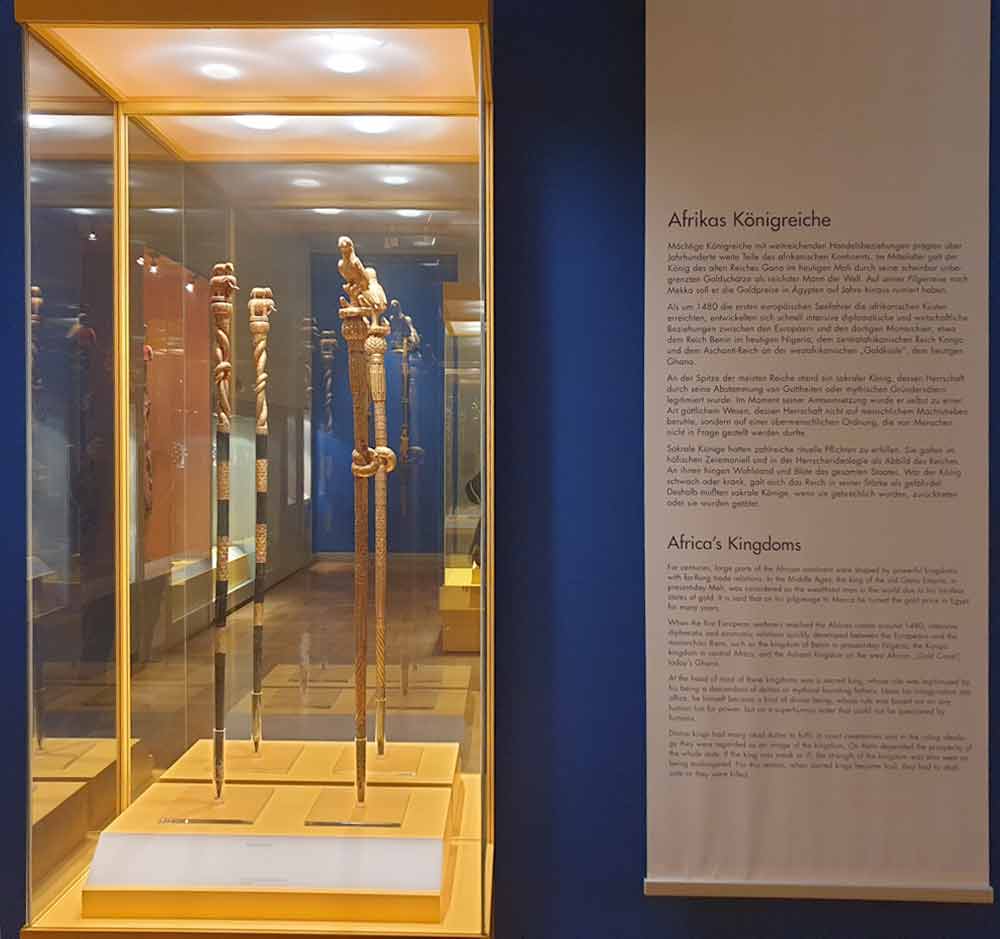
Significance
As intimated above, beyond its art and royal attraction, the elephant-calf image of the Ashanti royalty reflects ethnic and universal ideals of effective leadership, which is for cohesion and protection and, rather than for oppression. This is evident in the symbol of the wisdom knot and the image of the elephant carrying the calf. This education on the effective use of power is relevant to majority/minority and local as well as international rich/poor contexts. On the reverse, it also points to the Akan and universal idea of responsible followership - submission and trust, and is easily utilised for the education of children. The image, thus, represents an effective blend of governance, culture and education.
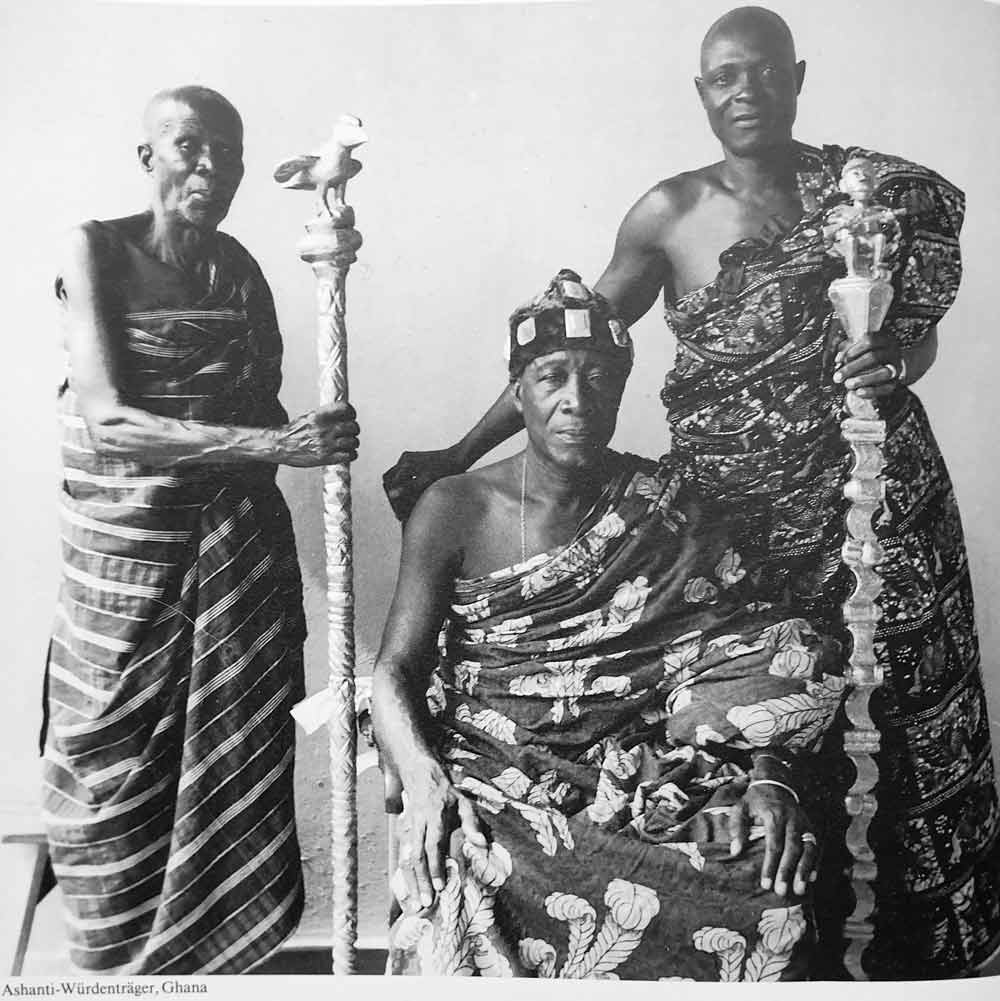
References
- Kwarteng, K. O. (2006). The elephant in pre-colonial Ghana: Cultural and economic use values. Journal of Philosophy and Culture, Vol. 3 (2) June 2006: 1 -32.
- Sarpong, P. (1971). The sacred stools of the Akan. Accra: Ghana Publishing.
- Sekyi-Baidoo, J. Y. (1994) The Aesthetic and cosmological features of the Akan hunters’ song. MPhil Dissertation, Institute of African Studies, University of Ghana, Legon
- Yankah, K. (1995). Speaking for the chief: Ȯkyeame and the politics of Akan royal oratory. Bloomington & Indianapolis: Indiana University Press.
Footnote:
1) The term „linguist“ has been adopted in Ghana for the Akan designation „Okyeame“ in an attempt to find an English equivalent for the role of the chief´s or king´s diplomacy attendant. This may have arisen out of the acknowledgement of the linguistic capabilities displayed by the attendants, whose main resource was language.
published January 2021
This article is part of a gallery: Perspectives from Ghana on Museum Objects in Germany

